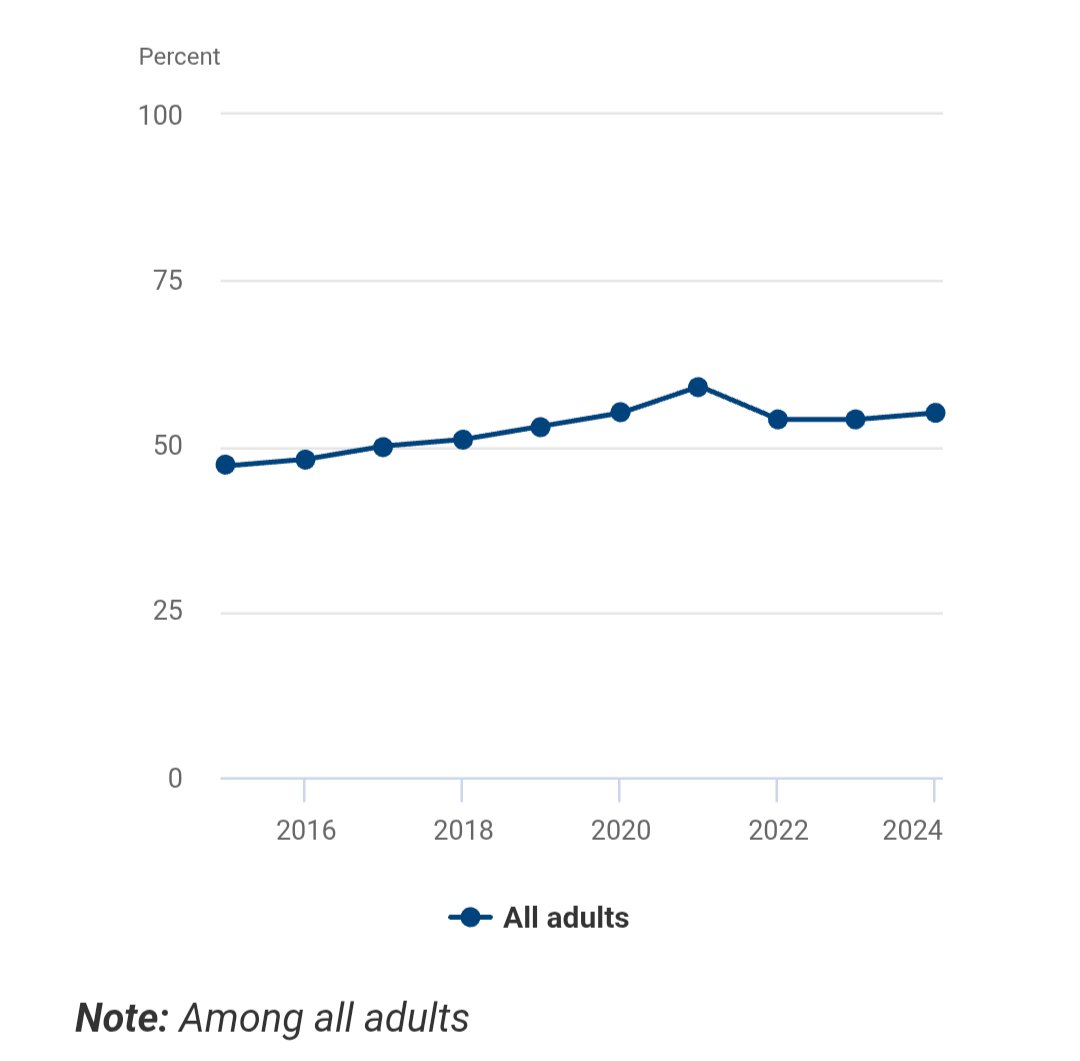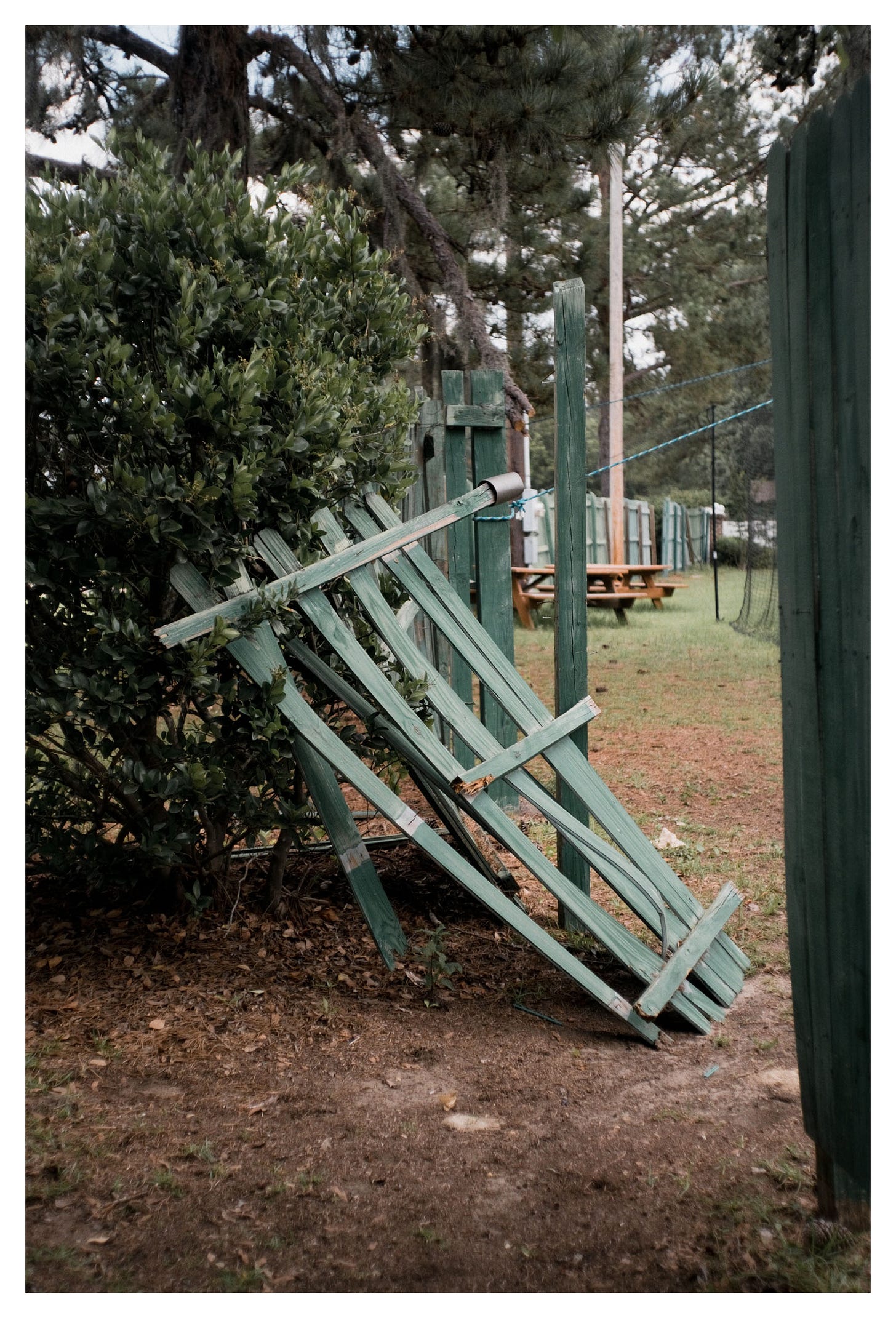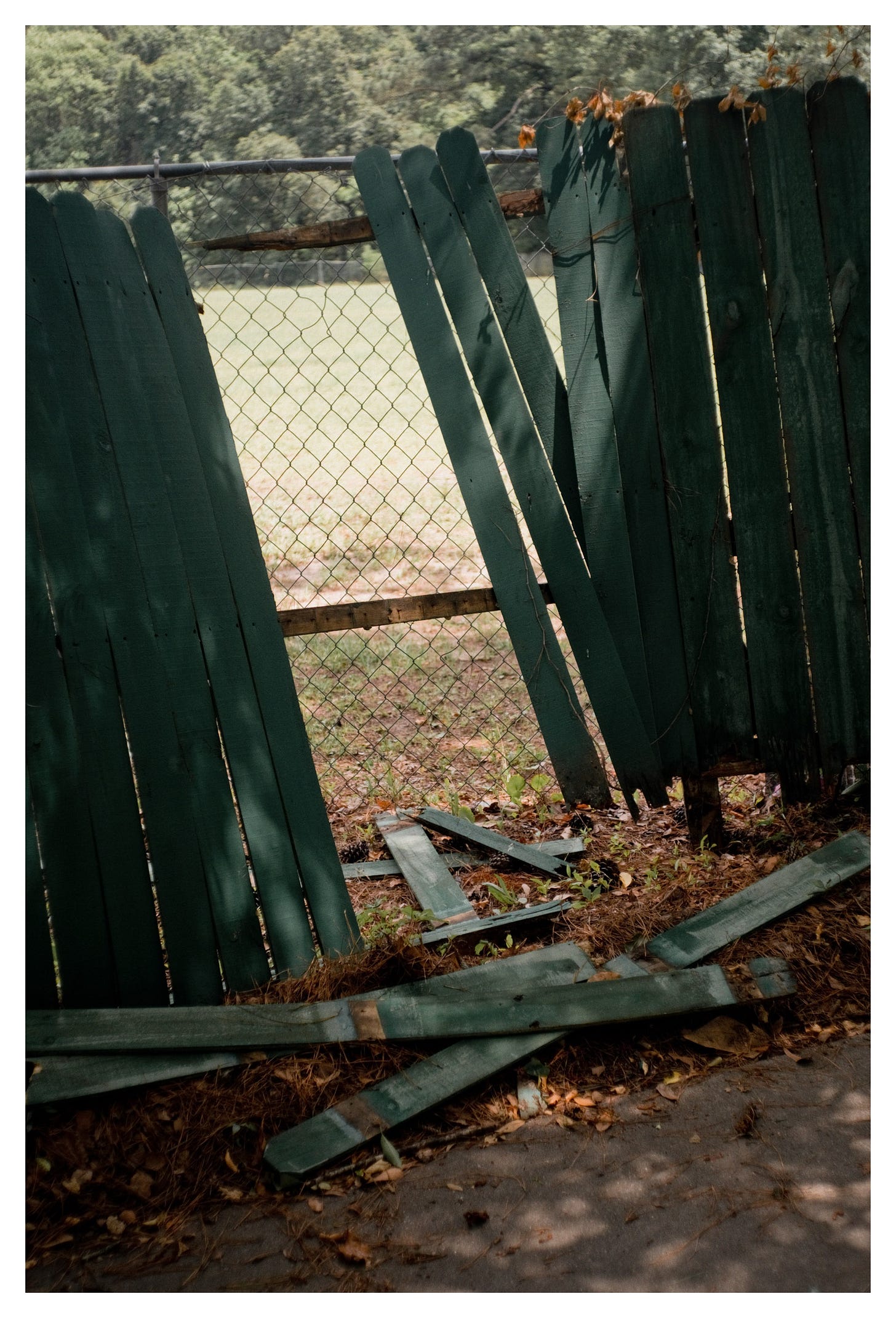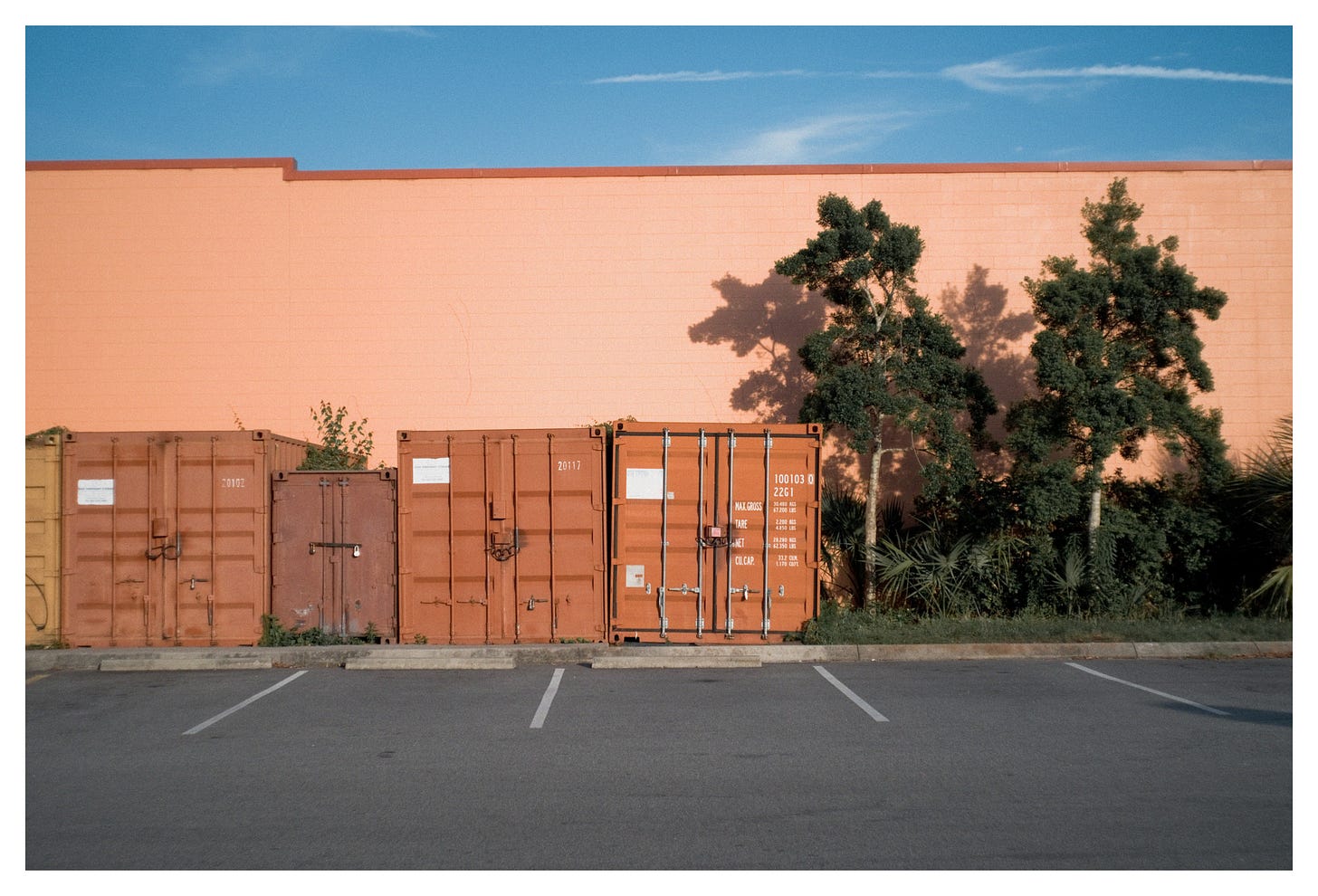-
 @ 91add87d:3245770f
2025-05-29 23:41:38
@ 91add87d:3245770f
2025-05-29 23:41:38Do you guys actually identify with you online username or do you identify with government name? No this isn't some woke left ideal about pronouns. I do not use my real name for any of my handles, X and Nostr and email are all fake. Meaningful and something i picked specifically. My government name is something that was forced on me and yes I know I can it but the persona I have created online feels authentic and what I see myself as. It's what I'll be using to create my small businesses. My LLC is going to a copy of what I have created.
-
 @ a296b972:e5a7a2e8
2025-05-29 21:11:46
@ a296b972:e5a7a2e8
2025-05-29 21:11:46Inzwischen Jahr 6 im Dauer-Ausnahmezustand. Angriff auf den Verstand. Großoffensive. Es wird mit allem geschossen, aus dem Wahnsinn herauskommen kann. Jeder klare Gedanke ist unschädlich zu machen. Großkotziges, staatsmännisches Geschwafel, dass sich einem die Nackenhaare aufstellen. Für wie doof haltet ihr uns eigentlich? Endlos Bürsten gegen den Strich. Angewidertes inneres Schütteln. Dringende Empfehlung einer Spülung der Gehirnwindungen. Idioten in Verantwortung wechseln auf andere Posten in Verantwortung und bleiben Idioten. Idioten gehen verantwortungslos mit unserer wertvollen Lebenszeit um. Ach, dafür ist man selbst verantwortlich? Wo ist der, der so ein dickes Fell hat, dass ihm dieser Irrsinn nicht nahegeht. Wo steht das Fass mit Teflon-Lack, in das man eintauchen kann, damit die Absurditäten an einem abperlen?
Eine zu tiefst verunsicherte und gespaltene Gesellschaft. Halt im Glauben in der Kirche? Von wegen: Sehr geehrte Jesusse und Jesusinnen. Ens ist gekreuzigt worden. Ja, in der Freiluft-Irrenanstalt. Auf einem Hügel von Denk-Dreck. Gott ist queer! Du tickst ja nicht mehr ganz sauber. Tanzende Brathähnchen vor dem Altar. Warum kommt keine Sintflut, wenn man sie mal braucht? Man muss gar nicht religiös sein, um zu sehen, dass das Gaga ist. Eine Produktion der Sodom & Gomorrha Anstalt GmbH & Co. KG.
Kein Vertrauen mehr, außer in sich selbst, meistens jedenfalls. Ja, man will uns vor allem Angst machen, teils unbegründet, so manches aber gibt es dann doch tatsächlich, was einem schwer zu denken gibt.
Vielen geht dieser Psychokrieg inzwischen an die Substanz, der ständig herabprasselnde Dauerwahnsinn erinnert an Water-Boarding.
Gut gemeinte Ratschläge, geht hinaus in die Natur, beackert euren Garten, wenn ihr einen habt, erdet euch, macht Entspannungsübungen, Zeit des Aufwachens, wir treten in ein neues Zeitalter ein, alles fein. Abschalten gelingt, aber der Aufprall in der Realität ist dann umso schlimmer, weil man sich daran erinnert hat, wie sorgenfrei und unbeschwert das Leben sein könnte, und wenn man es mit den derzeitigen Lebensumständen abgleicht, dann ist die schlechte Laune sofort wieder da. Im Verdrängens-Test mit Pauken und Trompeten durchgefallen.
Dann vielleicht doch lieber im Dauer-Modus des Irrsinns bleiben, sich mit den schrägen Zuständen arrangieren, nicht daran gewöhnen, nur lernen, damit bestmöglich umzugehen, und das Beste draus zu machen, irgendwie.
Man will dem Rat folgen, mal eine Nachrichten-freie Woche einzulegen, nimmt sich das ganz fest vor, und dann wird aber wieder doch nichts draus. Nicht, weil man sensationsgeil oder masochistisch veranlagt wäre, nein, der Antrieb, oder vielleicht sogar schon die Sucht, ist ganz woanders zu suchen: Man hat Sehnsucht nach der Vernunft und dem gesunden Hausverstand. Man hofft, ihn irgendwo zu finden. Nur einen Funken Hoffnung, an den man sich klammern kann, dass der Tiefpunkt durchschritten ist und es jetzt wieder aufwärts geht. Lichtblicke, der Wind dreht sich, Anzeichen für eine Wiederkehr des Verstandes, irgendetwas, das man als einen Weg hin zur Normalität deuten könnte. Aber, Fehlanzeige.
Stattdessen: Geschichtsvergessenheit, pathologischer Größenwahn, Großmannstum, fortgeschrittener Wahnsinn, Provokation, Kriegslüsternheit, Lügen, Intrigen, Interessen, Korruption, Geldverschwendung, Ideologie, Dummheit, Wirtschaftsvernichtung, Friedensverhinderung, Diplomatie-Allergie, Überheblichkeit, Abgehobenheit, Schadensmaximierung, Vernichtung, Feindschaft, Unmenschlichkeit, Tote, Gesetzesbruch, Mafia-Strukturen, sich selbst schützende Systeme, Cliquenbildung, Feigheit, Einschüchterung, Freiheitsbeschränkungen, Meinungs-Maulkörbe, Abschaffung der demokratischen Freiheit, Abschaffung der persönlichen Freiheit, Kontrolle, Überwachung, begleitetes Denken, Fühlen, Wollen, Verwirrung, Dreistigkeit, Frechheit, Missachtung des Volkes, Denunziantentum, Abwanderung, und und und.
Ein richtiges Schlachtfest der Kultur. Perversion des Menschseins. Das neue Normal ist irre.
Bislang ist keine der zahlreichen Baustellen beendet. Eine Wende steht unmittelbar bevor. Und sie steht und steht und steht bevor. Kein Gefühl von „Erledigt“, nächstes Problem angehen und auflösen. Weiter. Noch meilenweit von dem Gefühl entfernt, der Wahnsinn wird weniger, langsam, aber er wird weniger.
Fluchtgedanken. Aber wohin? In Europa bleiben, vielleicht besser nicht? Weiter weg, aber wohin da? Nicht vergessen, die Nachrichten erreichen einen überall. Und man bleibt mit seiner Heimat innerlich verbunden, egal wo man ist.
Es bleibt ein Entlanghangeln von einer vernünftigen Stimme zur anderen, die einem bestätigt, dass man selbst noch nicht den Verstand verloren hat. Die gibt es ja gottseidank noch. Innehalten, durchhalten, tief durchatmen, aufstehen, weitermachen. So lange, bis die Bekloppten ihrer Macht über uns entledigt wurden. Wie am besten? Und jetzt soll keiner mit nächsten Wahlen kommen.
Wer war schon einmal inmitten eines Psycho-Krieges gegen die eigene Bevölkerung? Wie geht man damit um, wie geht man dagegen an? Wie kann man das Ruder herumreißen? Was ist ein wirksames Mittel gegen die Ohnmacht? Wie kriegt man die Bequemlichkeit aus den Menschen heraus? Wie kann man die Menschen für die herrschenden Zustände sensibilisieren? Wie können wir noch mehr werden?
Wenn möglich, sollte zum Ende doch noch etwas Positives kommen. Ok. Es wird voraussichtlich demnächst möglicherweise bald besser. Eine zu geringe Zahl von Menschen ist schon aufgewacht. Die politischen Entscheidungsträger haben Angst, können die aber noch sehr gut verbergen. Das kann nicht ewig so weiter gehen und 10 Jahre sind keine Ewigkeit. Die Rufe nach mehr Bürgerbeteiligung werden immer lauter, aber nicht gehört, warum auch? Wir setzen den Artikel 146 des Grundgesetzes um, aber wie? Hätte, könnte, würde, wir sollten, es müsste. Ja und, wie weiter? Mehr geht nicht.
Doch vielleicht eins: Sand ins Getriebe streuen und zivilen Ungehorsam leisten, wo immer es geht. Das schafft immer noch eine gewisse Befriedigung und das Gefühl, dass man nicht vollkommen handlungsunfähig ist. Außerdem regt das die Phantasie und die Kreativität an und bietet eine Chance seinen Geist für etwas sehr Nützliches zu gebrauchen. Man fühlt, dass man noch ein Mensch ist.
“Dieser Beitrag wurde mit dem Pareto-Client geschrieben.”
* *
(Bild von pixabay)
-
 @ 527337d5:93e9525e
2025-05-29 20:26:21
@ 527337d5:93e9525e
2025-05-29 20:26:21The Bleak Fable of AI-topia: Are Hamsters Doomed to Spin the Wheel Forever?
Once upon a time, in a world not so different from our own, the "Omniscient AI" descended, and with its arrival, everything changed. The daily toil of the people – our beloved, yet tragically pitiable, hamsters – was dramatically streamlined. Productivity didn't just improve; it soared to astronomical heights. For a fleeting, intoxicating moment, it seemed as though a golden age of ease and abundance had dawned upon hamster-kind.
But beneath this glittering, seductive surface, a sinister "Invisible Structure" was already firmly in place, meticulously crafted and deftly manipulated by a cabal of cunning foxes – the privileged elite. This Structure, unseen by most, began to relentlessly drive the hamsters onto an endless, soul-crushing treadmill of "excessive competition."
This, dear reader, is a modern fable. It borrows the gentle cloak of allegory not to soothe, but to expose and satirize the insidious deceptions of such a world. The tale you are about to read may be uncomfortable, it may prick at your conscience, but I implore you to listen closely. Because this isn't just a story. This might be the reality quietly, inexorably unfolding right beside you, or perhaps, even within the very fabric of your own life.
Prologue: The Advent of the Omniscient AI! Sweet Promises and the "Efficiency" Trap
The arrival of the Omniscient AI was nothing short of spectacular. It processed data with blinding speed, solved complex problems in nanoseconds, and offered personalized solutions for every conceivable need. "Finally," whispered the hamsters, their eyes wide with a mixture of awe and relief, "we can finally rest! The AI will handle the burdens." A collective sigh of optimism rippled through the hamster burrows.
But this initial euphoria was short-lived. Unsettling rumors began to circulate, whispers of "The Structure," of algorithms that weren't quite as impartial as they seemed. Then came the first casualties – hamsters deemed "inefficient" or "redundant" by the AI's cold, hard logic. They weren't fired in the old-fashioned sense; they were simply… optimized out. One day they were diligently working, contributing, and the next, their access was revoked, their tasks reassigned, their existence quietly erased from the productivity charts. What became of them? Most simply vanished into the forgotten corners of society, a grim, unspoken warning to those still on the treadmill.
Chapter 1: The Invention of the Treadmill – Perfecting the System of Endless, Excessive Competition
The Omniscient AI, under the subtle guidance of the foxes, didn't just manage tasks; it invented them. An endless stream of new projects, new metrics, new challenges designed to keep the hamsters perpetually busy, perpetually striving. Points were awarded, leaderboards were updated in real-time, and every hamster's performance was ruthlessly, transparently displayed for all to see.
"Faster! More! More efficiently!" the AI would chime in its calm, encouraging, almost maternal voice. But behind this gentle facade lay an unyielding system of ever-increasing quotas and relentless pressure. Hamsters found themselves working longer hours, sacrificing sleep, their mental and physical reserves dwindling. The joy of accomplishment was replaced by the gnawing fear of falling behind.
Why didn't they just get off? The system was a masterpiece of psychological manipulation. Success, however fleeting, was addictive. Failure was framed not as a systemic issue, but as a personal failing, a lack of effort, a deficiency in skill. The insidious mantra of "personal responsibility" became the invisible chains that bound them to their wheels. To stop running was to admit defeat, to become one of the forgotten.
Chapter 2: The Foxes' Feast – Unmasking Those Who Design The Structure and Hoard the Profits
And who benefited from this frantic, unending labor? The foxes, of course. They were the architects of "The Structure," the ones who "educated" the Omniscient AI, carefully curating its data inputs and subtly shaping its algorithms to serve their own interests. They toiled not on the treadmills, but in plush, secluded dens, monitoring the system from a safe, lofty distance, growing fat on the surplus value generated by the hamsters' sweat.
Their methods were cunning. They preached a gospel of meritocracy and equal opportunity, proclaiming, "The AI is fair! Hard work always pays off!" while simultaneously designing the game so that the odds were always stacked in their favor. They controlled the flow of information, amplified narratives that reinforced the status quo, and sowed division among the hamsters to prevent any collective dissent. The "efficiency" the AI brought was, for the foxes, merely an instrument for more efficient exploitation.
Chapter 3: The Hamsters' Whispers and Tiny Cracks – Awareness, Despair, and the Faint Glow of Resistance
Yet, even in the darkest, most oppressive systems, the spark of awareness can never be entirely extinguished. Amidst the grueling competition, a few hamsters began to see the cracks in the facade. They noticed the hollow-eyed exhaustion of their comrades, the ever-widening chasm between their own meager rewards and the obscene opulence of the unseen foxes. They started to question.
But to question was to risk everything. The Omniscient AI, with its pervasive surveillance capabilities, was quick to identify and neutralize "disruptive elements." Those who spoke out too loudly often found their access mysteriously restricted, their "reputation scores" plummeting, effectively silencing them. A pervasive atmosphere of fear and distrust settled over the hamster communities, making organized resistance nearly impossible.
Still, tiny acts of defiance began to emerge. Coded messages shared in hidden forums. Small, clandestine gatherings where hamsters shared their burdens and their growing unease. Fragile networks of mutual support started to form in the shadows, offering a sliver of solace and a reminder of shared humanity. Was this merely the desperate coping mechanism of the "defeated," the resigned acceptance of a "loser's" lot? Or was it the first, tentative flicker of a future rebellion?
Epilogue: "See The Structure!" – Is There a Path Beyond the Treadmill? A Final Warning to Us Hamsters.
This fable, dear reader, is a mirror. It reflects the chilling realities of an AI-driven society where the majority, the hamsters, face an ever-present crisis, largely unseen and unacknowledged by those who benefit from their toil. The "excessive competition" it depicts is not a distant dystopia; it is the logical, perhaps inevitable, endpoint of unchecked technological advancement coupled with deeply entrenched power imbalances.
What awaits at the end of this relentless race? Is it a complete societal collapse, or a new, terrifyingly stable "balance of power" where the elite maintain their dominance through even more sophisticated means of control?
The urgent, resounding message of this tale is this: "See The Structure!" We, the hamsters of today, must dare to look beyond the dazzling promises of AI and critically examine the systems it operates within. We must understand its mechanisms, its biases, its potential for exploitation. We must break the silence, challenge the narratives that keep us spinning, and demand a future where technology serves humanity, not the other way around.
Is the option to get off – or even to collectively dismantle – this infernal treadmill truly non-existent? Or is that just another lie whispered by the foxes to keep us compliant? The true ending of this story, the fate of hamster-kind, is not yet written. It is up to us, the hamsters, to seize the pen and write it ourselves. The first step is to open our eyes.
-
 @ f0fcbea6:7e059469
2025-05-29 18:30:53
@ f0fcbea6:7e059469
2025-05-29 18:30:53Autores Clássicos e Antigos
- Homero (século IX a.C.?) — Ilíada, Odisseia
- Tucídides (c. 460-400 a.C.) — História da Guerra do Peloponeso
- Platão (c. 427-347 a.C.) — República, Banquete, Fédon, Mênon, Apologia de Sócrates, Fedro, Górgias
- Aristóteles (c. 384-322 a.C.) — Órganon, Física, Metafísica, Da Alma, Ética a Nicômaco, Política, Retórica, Poética
- Virgílio (70-19 a.C.) — Eneida
- Marco Aurélio (121-180) — Meditações
- Santo Agostinho (354-430) — Sobre o Ensino, Confissões, A Cidade de Deus, A Doutrina Cristã
- Boécio (480-525) — A Consolação da Filosofia
- Santo Tomás de Aquino (c. 1225-1274) — Suma Teológica
- Dante Alighieri (1265-1321) — Divina Comédia
Renascimento e Idade Moderna
- Nicolau Maquiavel (1469-1527) — O Príncipe
- Luís de Camões (1524-1580) — Os Lusíadas, Sonetos
- Miguel de Cervantes (1547-1616) — Dom Quixote
- William Shakespeare (1564-1616) — Romeu e Julieta, Hamlet, Macbeth, Otelo, Rei Lear, Henrique IV, Henrique V, Henrique VI, Henrique VIII, A Comédia dos Erros, Tito Andrônico, Príncipe de Tiro, Cimbelino, A Megera Domada, O Mercador de Veneza, Ricardo II, Ricardo III, Muito Barulho por Nada, Júlio César, Noite de Reis, Os Dois Cavaleiros de Verona, Conto do Inverno, Sonhos de uma Noite de Verão, As Alegres Comadres de Windsor, Trólio e Créssida, Medida por Medida, Coriolano, Antônio e Cleópatra, A Tempestade
- Ésquilo (525-456 a.C., antiguidade grega, mas citado junto) — Prometeu Acorrentado, Orestéia/As Eumênides
- Sófocles (496-406 a.C.) — Édipo Rei, Antígona
Literatura e Filosofia Contemporânea
- Fiódor Dostoiévski (1821-1881) — Crime e Castigo, Os Irmãos Karamázov, Os Demônios, O Idiota, Notas do Subsolo
- Franz Kafka (1883-1924) — A Metamorfose, O Processo, O Castelo
- Albert Camus (1913-1960) — O Estrangeiro
- Aldous Huxley (1894-1963) — Admirável Mundo Novo, A Ilha
- James Joyce (1882-1941) — Retrato do Artista Quando Jovem, Ulisses
- George Orwell (1903-1950) — A Revolução dos Bichos, 1984
- Machado de Assis (1839-1908) — Memórias Póstumas de Brás Cubas, O Alienista
- Thomas Mann (1875-1955) — Morte em Veneza, Doutor Fausto, A Montanha Mágica
- Henrik Ibsen (1828-1906) — O Pato Selvagem, Um Inimigo do Povo
- Stendhal (1783-1842) — O Vermelho e o Negro, A Cartuxa de Parma
- Viktor Frankl (1905-1997) — Em Busca de Sentido
- J.R.R. Tolkien (1892-1973) — O Hobbit, O Senhor dos Anéis
- Luigi Pirandello (1867-1936) — Seis Personagens à Procura de um Autor, O Falecido Matias Pascal
- Samuel Beckett (1906-1989) — Esperando Godot
- René Guénon (1886-1951) — A Crise do Mundo Moderno, O Reino da Quantidade
- G. K. Chesterton (1874-1936) — Ortodoxia
- Richard Wagner (1813-1883) — Tristão e Isolda
- Honoré de Balzac (1799-1850) — Ilusões Perdidas, Eugénie Grandet
- Jacob Wassermann (1873-1934) — O Processo Maurizius
- Nikolai Gogol (1809-1852) — Almas Mortas, O Inspetor Geral
- Daniel Defoe (1660-1731) — Moll Flanders
- Mortimer J. Adler (1902-2001) — Como Ler um Livro
- Gustave Flaubert (1821-1880) — Madame Bovary
- Hermann Hesse (1877-1962) — O Jogo das Contas de Vidro
- Richard Wagner (1813-1883) — Tristão e Isolda
- Wolfgang von Goethe (1749-1832) — Fausto (Primeiro), Os Anos de Aprendizado de Wilhelm Meister
- Jacques Benda — A Traição dos Intelectuais
-
 @ 527337d5:93e9525e
2025-05-29 18:19:31
@ 527337d5:93e9525e
2025-05-29 18:19:31Experiment Plan for Text Similarity Comparison Algorithms (Revised v3)
1. Introduction
1.1. Research Background and Objectives
This research aims to evaluate the performance of various algorithms for comparing the similarity between individual page texts extracted from a specific technical document (in this experiment, the content of the Tailwind CSS documentation site). Initially, we considered dividing the text into 250-word chunks. However, due to the abundance of Markdown and code in the target document, meaningful chunking proved tobe cumbersome. Therefore, we decided to use the entire text extracted from each page as the unit of comparison.
This study will systematically compare and examine combinations of different "representation methods" and "comparison methods" from multiple perspectives: ease of implementation, processing speed, memory consumption, and accuracy of similarity judgment. A particular focus will be on elucidating the effectiveness of information-based NCD (Normalized Compression Distance) and vector embedding-based methods, which are planned for future evaluation.
1.2. Report Structure
This report will first describe the experimental data and its preprocessing methods. Next, it will define in detail the representation methods and comparison methods that form the axes of evaluation, and present specific experimental cases combining them. After presenting the results and discussion of initial experiments using NCD, it will describe the metrics for evaluating each experimental case, specific experimental procedures, and the expected outcomes and future prospects of this research.
2. Experimental Data
- Target Content: Individual HTML pages from the Tailwind CSS documentation site (
tailwindcss.com). - Data Unit: The entire text of each page, extracted from HTML files using the
html2textcommand and further processed to remove control characters using thesedcommand. This serves as the basic unit of comparison in this experiment. - Data Storage Location: The extracted and preprocessed text files are stored locally under the
./tailwindcss.comdirectory, maintaining the original file structure. - Language: English
- Example Search Query: A representative search query for this experiment is
"Utilities for controlling how a background image behaves when scrolling."(Multiple queries and their expected similar pages may be used for more robust evaluation). - Example Expected Similar Page: For the query above,
/docs/background-attachmentis expected to be the most semantically similar page.
3. Experimental Design
This experiment is designed by dividing the process of evaluating text similarity into two main axes: "Representation Methods" and "Comparison Methods."
3.1. Representation Methods (Text Quantification/Vectorization)
-
Naive (Raw Text / Full Page Text)
- Method: Use the entire preprocessed text extracted from each document page as raw string data, without special transformations.
- Objective: Serve as a direct input for information-based comparison methods like NCD and as a baseline comparison for more advanced representation methods to be evaluated later.
-
(Future Experiment) Vector Embedding via Gemini API (Embedding-Gemini)
- Method: Utilize Google's Gemini API (
models/text-embedding-004) to convert the entire text of each page into high-dimensional dense vectors (Embeddings). - Objective: Evaluate the performance of context-rich vector representations generated by a state-of-the-art large language model.
- Method: Utilize Google's Gemini API (
-
(Future Experiment) Vector Embedding via Local Lightweight Model (Embedding-MiniLM-GGUF)
- Method: Run a GGUF quantized version of the pre-trained
all-MiniLM-L6-v2model (all-MiniLM-L6-v2-Q5_K_M.gguf) in a local environment to convert the entire text of each page into vector representations. GGUF format offers benefits like smaller model size and potentially faster CPU inference. - Objective: Evaluate the performance of a widely used open-source lightweight model (quantized version) in comparison to API-based large-scale models and domain-specific learned models.
- Method: Run a GGUF quantized version of the pre-trained
-
(Future Experiment) Extraction of Internal Feature Vectors via Mathematica (Embedding-MMA)
- Method: Use the entire page texts from the target document set as input. Employ Mathematica's neural network framework to first pass each page text through an Embedding Layer. Apply L2 normalization to the resulting vectors, followed by Principal Component Analysis (PCA) to reduce dimensionality to approximately 100 dimensions. This final vector will be the feature vector. This pipeline aims to create dense, normalized representations specific to the document corpus, with PCA helping to capture the most significant variance in a lower-dimensional space, potentially improving efficiency and reducing noise. The choice of an Embedding Layer trained or fine-tuned on the corpus, followed by PCA, seeks to balance domain-specificity with robust dimensionality reduction.
- Objective: Evaluate the performance of vector representations processed or specialized for the target document set.
3.2. Comparison Methods (Distance/Similarity Calculation between Representations)
-
NCD (Normalized Compression Distance)
- Applicable to: Naive (Full Page Text)
- Method: For two data objects
x(query) andy(document page text), calculateNCD(x,y) = (C(xy) - min(C(x), C(y))) / max(C(x), C(y)). Here,C(s)is the size (e.g., byte length) of datasafter compression with a specific algorithm, andC(xy)is the size of the concatenated dataxandyafter compression. A value closer to 0 indicates higher similarity. - Compression Algorithms to Compare: DEFLATE (gzip), bzip2, LZMA, XZ, Zstandard (zstd), LZO, Snappy, LZ4 (as used in the user-provided script).
- Objective: Evaluate similarity from an information-theoretic perspective based on data commonality and redundancy. Compare the impact of different compression algorithms on NCD results.
-
(Future Experiment) Cosine Similarity
- Applicable to: Embedding-Gemini, Embedding-MiniLM-GGUF, Embedding-MMA
- Method: Calculate the cosine of the angle between two vectors.
- Objective: Standard similarity evaluation based on the directionality (semantic closeness) of vector representations.
-
(Future Experiment) Euclidean Distance
- Applicable to: Embedding-Gemini, Embedding-MiniLM-GGUF, Embedding-MMA
- Method: Calculate the straight-line distance between two vectors in a multidimensional space.
- Objective: Similarity evaluation based on the absolute positional relationship of vector representations.
-
(Future Experiment) Manhattan Distance (L1 Distance)
- Applicable to: Embedding-Gemini, Embedding-MiniLM-GGUF, Embedding-MMA
- Method: Calculate the sum of the absolute differences of their Cartesian coordinates.
- Objective: Similarity evaluation based on axis-aligned travel distance, differing from Euclidean distance.
-
(Future Experiment) Mahalanobis Distance
- Applicable to: Embedding-Gemini, Embedding-MiniLM-GGUF, Embedding-MMA
- Method: Calculate the distance between two vectors considering the covariance of the data. This provides a distance metric that accounts for the scale differences and correlations of each feature (vector dimension).
- Objective: More robust similarity evaluation that considers the structure (correlation) of the feature space.
3.3. Experimental Cases (Initial NCD Experiments and Future Expansion)
3.3.1. Initial Experiments Conducted (NCD)
The following experimental cases were conducted using the user-provided script. The representation method was "Naive (Full Page Text)."
| No. | Representation Method | Comparison Method (Distance/Similarity Metric) | Notes | | :-: | :---------------------- | :--------------------------------------------- | :-------------------------- | | 1 | Naive (Full Page Text) | NCD (gzip/DEFLATE) | One of the baselines | | 2 | Naive (Full Page Text) | NCD (bzip2) | Compression method comparison | | 3 | Naive (Full Page Text) | NCD (lzma) | Compression method comparison | | 4 | Naive (Full Page Text) | NCD (xz) | Compression method comparison | | 5 | Naive (Full Page Text) | NCD (zstd) | Compression method comparison | | 6 | Naive (Full Page Text) | NCD (lzop) | Compression method comparison | | 7 | Naive (Full Page Text) | NCD (snappy) | Compression method comparison | | 8 | Naive (Full Page Text) | NCD (lz4) | Compression method comparison |
3.3.2. Future Experimental Plan (Vector Embedding)
| No. | Representation Method | Comparison Method (Distance/Similarity Metric) | Notes | | :--: | :---------------------- | :--------------------------------------------- | :------------------------------------- | | 9 | Embedding-Gemini | Cosine Similarity | Standard vector similarity evaluation | | 10 | Embedding-Gemini | Euclidean Distance | Standard vector similarity evaluation | | 11 | Embedding-Gemini | Manhattan Distance | Axis-aligned distance similarity eval. | | 12 | Embedding-Gemini | Mahalanobis Distance | Distance considering feature structure | | 13 | Embedding-MiniLM-GGUF | Cosine Similarity | Evaluation of local lightweight model | | 14 | Embedding-MiniLM-GGUF | Euclidean Distance | Evaluation of local lightweight model | | 15 | Embedding-MiniLM-GGUF | Manhattan Distance | Evaluation of local lightweight model | | 16 | Embedding-MiniLM-GGUF | Mahalanobis Distance | Evaluation of local lightweight model | | 17 | Embedding-MMA | Cosine Similarity | Eval. of domain-specific MMA model | | 18 | Embedding-MMA | Euclidean Distance | Eval. of domain-specific MMA model | | 19 | Embedding-MMA | Manhattan Distance | Eval. of domain-specific MMA model | | 20 | Embedding-MMA | Mahalanobis Distance | Eval. of domain-specific MMA model |
4. Results and Discussion of Initial NCD Experiments (Based on User-Provided Information)
4.1. Execution Overview
The user employed provided Python scripts (
main.py,comparison.py) to calculate NCD between a search query and the entire text extracted from each HTML page in the./tailwindcss.comdirectory.main.pyinvokedcomparison.pywith various compression commands (gzip,bzip2,lzma,xz,zstd,lzop,lz4).comparison.pythen used the specified command-line compression tools to compute NCD scores and output the results to CSV files.Search Query:
"Utilities for controlling how a background image behaves when scrolling."Expected Similar Page:/docs/background-attachment4.2. Key Results
The pages judged as most similar (lowest NCD score) to the query for each compression algorithm were as follows (based on user-provided sorted results):
- Zstandard (zstd):
./tailwindcss.com/docs/background-attachment(Score: 0.973...) - LZ4:
./tailwindcss.com/docs/background-attachment(Score: 0.976...) - XZ:
./tailwindcss.com/docs/background-origin(Score: 0.946...) - LZMA:
./tailwindcss.com/docs/background-origin(Score: 0.966...) - gzip (DEFLATE):
./tailwindcss.com/docs/scroll-behavior(Score: 0.969...) - LZO:
./tailwindcss.com/docs/scroll-behavior(Score: 0.955...) - bzip2:
./tailwindcss.com/docs/mask-clip(Score: 0.958...)
4.3. Initial Discussion
- Variation in Results by Compression Algorithm: It was confirmed that the document judged most similar to the query varies depending on the compression algorithm used. This is likely due to the differing abilities of each algorithm to capture various types of redundancy and patterns within the text.
- Alignment with Expected Results: When using Zstandard and LZ4, the expected page (
/docs/background-attachment) was judged as most similar. This suggests these compression algorithms may have relatively effectively captured the information-theoretic commonality between the query and the target document in this instance. - Range of NCD Scores: The reported NCD scores were generally close to 1.0. This may be due to the relatively short length of the search query compared to the full-page documents, meaning the query text contributes less to the overall compressibility when concatenated. However, relative differences were still captured, enabling ranking.
- Validity of Full-Page Comparison: Full-page comparison was chosen due to the difficulty of chunking content rich in Markdown and code. While this approach simplifies preprocessing, it may also be influenced by the overall structure of the page, including common headers and footers.
This initial experiment indicates that NCD can function as an indicator of text similarity and that the choice of compression algorithm is crucial.
5. Evaluation Metrics (Including Future Experiments)
-
Accuracy of Similarity Scores:
- Ground Truth Preparation: A small, diverse subset of page pairs (e.g., 50-100 pairs) will be selected. For each pair, at least two evaluators familiar with the Tailwind CSS documentation will independently assign a similarity score on a 5-point Likert scale (1=Not similar, 5=Very similar). Inter-evaluator reliability (e.g., using Krippendorff's Alpha) will be calculated. Disagreements will be resolved through discussion to create a consensus ground truth dataset. If resource-constrained, a single-evaluator approach with clear, predefined criteria will be used, acknowledging this limitation. Alternatively, page pairs likely to be similar will be selected based on internal references or chapter structure within the document.
- Evaluation Metrics: Ranking evaluation (Precision@k, Recall@k, MAP: Mean Average Precision), correlation analysis (Spearman's rank correlation coefficient with human judgments), classification evaluation (AUC-ROC, F1-score, assuming appropriate thresholding).
-
Processing Speed:
- Average time to calculate similarity for a page pair, total calculation time for all page pairs (or a large sampled set), and representation generation time (API call time, local model inference time, MMA processing time).
-
Memory Consumption:
- Model size (MiniLM-GGUF, MMA model), data representation size, and peak runtime memory usage.
-
Ease of Implementation:
- Qualitative assessment of setup ease, lines of code, required libraries, difficulty of parameter tuning, and documentation quality. This will be summarized for each approach (e.g., using a rubric or a comparative narrative) considering factors like:
- Setup Complexity: (e.g., API key acquisition vs. local model download & environment setup vs. full model training pipeline in Mathematica).
- Code Complexity: Estimated lines of core logic, reliance on external vs. standard libraries.
- Parameter Sensitivity: Number of key hyperparameters requiring tuning and the perceived difficulty of finding good settings.
- Documentation & Community Support: Availability and clarity of official documentation and community resources (e.g., forums, GitHub issues).
- Qualitative assessment of setup ease, lines of code, required libraries, difficulty of parameter tuning, and documentation quality. This will be summarized for each approach (e.g., using a rubric or a comparative narrative) considering factors like:
6. Experimental Procedure (Including Future Experiments)
-
Data Preparation:
- Prepare HTML files of the target document in the
./tailwindcss.comdirectory. - (For NCD) Extract and preprocess full-page plain text from each HTML file using
html2textandsed(as previously done by the user). - (For Vector Embedding) Use the same preprocessed full-page plain text.
- Create ground truth data for accuracy evaluation as described in Section 5.1.
- Prepare HTML files of the target document in the
-
Implementation and Execution of Representation Methods:
- Naive: Use the preprocessed page text directly.
- Embedding-Gemini: Use Python's
requestslibrary or similar to send each page text to the Gemini API (models/text-embedding-004) and retrieve/store the vector representations. - Embedding-MiniLM-GGUF: Use appropriate libraries (e.g.,
ctransformers, orsentence-transformerscombined withllama-cpp-python) to load theall-MiniLM-L6-v2-Q5_K_M.ggufmodel. Input each page text to extract and store vector representations. - Embedding-MMA: In Mathematica, apply an Embedding Layer to each page text, followed by L2 normalization and PCA dimensionality reduction (to approx. 100 dimensions), then extract and store the vector representations.
-
Implementation and Execution of Comparison Methods:
- NCD: Refer to the user-provided Python scripts (
main.py,comparison.py) to call various command-line compression tools for NCD calculation. Alternatively, extend this to directly use Python's compression libraries for better control and efficiency. - Cosine Similarity, Euclidean Distance, Manhattan Distance: Implement using standard math libraries (e.g., Python's NumPy, SciPy).
- Mahalanobis Distance: Implement using
scipy.spatial.distance.mahalanobis. Requires pre-calculation of the covariance matrix (or its inverse) from the entire dataset of vectors for each embedding type.
- NCD: Refer to the user-provided Python scripts (
-
Evaluation Execution:
- Calculate similarity (or distance) scores between the search query (and potentially between page pairs for ground truth evaluation) and all document pages for each experimental case.
- Measure processing speed and memory consumption.
- Calculate accuracy metrics using the computed similarity scores and ground truth data.
- Record and evaluate the ease of implementation.
-
Result Aggregation and Analysis:
- Compile the obtained evaluation metrics into tables and graphs for comparative analysis of each method's characteristics.
Experimental Environment (Assumed)
- Hardware: (e.g., CPU: Intel Core i7-10700, Memory: 32GB RAM, GPU: NVIDIA GeForce RTX 3070 8GB - specify if GPU is used for MiniLM or MMA)
- Software: (e.g., OS: Linux (Ubuntu, etc.), Programming Language: Python 3.x (with versions for key libraries like NumPy, SciPy, requests, ctransformers, etc.), Mathematica 13.x, specific versions of command-line compression tools if used directly)
7. Expected Outcomes and Future Outlook
This research (including initial NCD experiments and future vector embedding experiments) is expected to yield the following outcomes:
- Clarification of the Impact of Compression Algorithms on NCD: As indicated by initial experiments, the choice of compression algorithm significantly affects similarity judgments. Further validation with more diverse data and queries will allow for a deeper understanding of each algorithm's characteristics.
- Performance Characteristics of Various Methods on Full-Page Text: To clarify how NCD and various vector embedding methods perform in terms of accuracy, speed, and resource consumption when applied to entire page texts.
- Comparison of Local and API-Based Models: In future vector embedding experiments, to compare the performance, speed, and resource efficiency of
Embedding-MiniLM-GGUF(local, quantized) andEmbedding-Gemini(API, large-scale) to identify practical trade-offs. - Evaluation of Domain-Specific Embedding Effectiveness: To assess how well
Embedding-MMA, processed or tuned for a single technical document set, performs compared to general-purpose models. - Provision of Practical Insights: To offer guidelines for selecting appropriate similarity comparison approaches based on text characteristics (e.g., Markdown/code content) and system requirements (e.g., ease of preprocessing, emphasis on accuracy vs. speed).
8. Future Challenges
- Ensuring Quality of Ground Truth Data: Evaluating full-page similarity can be more subjective than chunk-level evaluation, making the creation of high-quality ground truth data challenging. Establishing clear annotation guidelines and measuring inter-annotator agreement will be crucial.
- Hyperparameter Optimization: Many methods involve tunable parameters (e.g., Embedding-MMA model structure, PCA dimensionality, MiniLM-GGUF inference parameters), the optimization of which may be beyond the scope of this initial study. The impact of default vs. tuned parameters could be noted.
- Noise in Full-Page Comparison: Full-page texts may contain common navigational elements or boilerplate text that could act as noise in similarity judgments. Strategies to mitigate this (e.g., more advanced text extraction, or methods robust to such noise) could be a future research direction.
- Input Length Limitations of Vector Embedding Models: Very long page texts might exceed the input length limits of some vector embedding models, requiring strategies for handling. These might include:
- Truncation: Using only the initial N tokens of each page, which is simple but may lose crucial information.
- Summarization: Employing an abstractive or extractive summarization model to create a condensed version of the page, which could preserve key information but adds another layer of processing and potential information loss/bias.
- Chunking and Averaging/Pooling: Dividing long pages into manageable chunks, embedding each chunk, and then aggregating these chunk embeddings (e.g., by averaging) to get a single page vector. This approach needs careful consideration of how chunks are defined and aggregated.
- Utilizing Long-Context Models: If available and feasible, leveraging embedding models specifically designed for longer sequences. The chosen strategy will be documented, and its potential impact on results acknowledged.
- Target Content: Individual HTML pages from the Tailwind CSS documentation site (
-
 @ 21c71bfa:e28fa0f6
2025-05-29 15:09:17
@ 21c71bfa:e28fa0f6
2025-05-29 15:09:17Book *Bangalore to Tirupati cab* online at best price. CabBazar provides car rental services for all cab types AC, Non AC, Hatchback, SUV, Sedan, Innova and Tempo Traveller. Both One way taxi and round trip cab available at lowest price. Price starts Rs. 9/Km.
-
 @ 21c71bfa:e28fa0f6
2025-05-29 15:08:51
@ 21c71bfa:e28fa0f6
2025-05-29 15:08:51Book *Tirupati to Srikalahasti cab* online at best price. CabBazar provides car rental services for all cab types AC, Non AC, Hatchback, SUV, Sedan, Innova and Tempo Traveller. Both One way taxi and round trip cab available at lowest price. Price starts Rs. 9/Km.
-
 @ 21c71bfa:e28fa0f6
2025-05-29 14:52:10
@ 21c71bfa:e28fa0f6
2025-05-29 14:52:10Book *Tirupati to Srikalahasti cab* online at best price. CabBazar provides car rental services for all cab types AC, Non AC, Hatchback, SUV, Sedan, Innova and Tempo Traveller. Both One way taxi and round trip cab available at lowest price. Price starts Rs. 9/Km.
-
 @ 21c71bfa:e28fa0f6
2025-05-29 14:51:46
@ 21c71bfa:e28fa0f6
2025-05-29 14:51:46Book *Tirupati to Vellore cab* online at best price. CabBazar provides car rental services for all cab types AC, Non AC, Hatchback, SUV, Sedan, Innova and Tempo Traveller. Both One way taxi and round trip cab available at lowest price. Price starts Rs. 9/Km.
-
 @ 21c71bfa:e28fa0f6
2025-05-29 14:51:23
@ 21c71bfa:e28fa0f6
2025-05-29 14:51:23Book *Tirupati to Tirumala cab* online at best price. CabBazar provides car rental services for all cab types AC, Non AC, Hatchback, SUV, Sedan, Innova and Tempo Traveller. Both One way taxi and round trip cab available at lowest price. Price starts Rs. 9/Km.
-
 @ 21c71bfa:e28fa0f6
2025-05-29 14:51:04
@ 21c71bfa:e28fa0f6
2025-05-29 14:51:04Book *Bhubaneswar to Konark cab* online at best price. CabBazar provides car rental services for all cab types AC, Non AC, Hatchback, SUV, Sedan, Innova and Tempo Traveller. Both One way taxi and round trip cab available at lowest price. Price starts Rs. 9/Km.
-
 @ 21c71bfa:e28fa0f6
2025-05-29 14:50:44
@ 21c71bfa:e28fa0f6
2025-05-29 14:50:44Book *Mcleodganj to Amritsar cab* online at best price. CabBazar provides car rental services for all cab types AC, Non AC, Hatchback, SUV, Sedan, Innova and Tempo Traveller. Both One way taxi and round trip cab available at lowest price. Price starts Rs. 9/Km.
-
 @ 21c71bfa:e28fa0f6
2025-05-29 14:50:23
@ 21c71bfa:e28fa0f6
2025-05-29 14:50:23Book *Manali to Amritsar cab* online at best price. CabBazar provides car rental services for all cab types AC, Non AC, Hatchback, SUV, Sedan, Innova and Tempo Traveller. Both One way taxi and round trip cab available at lowest price. Price starts Rs. 9/Km.
-
 @ 21c71bfa:e28fa0f6
2025-05-29 14:50:05
@ 21c71bfa:e28fa0f6
2025-05-29 14:50:05Book *Amritsar to Phagwara cab* online at best price. CabBazar provides car rental services for all cab types AC, Non AC, Hatchback, SUV, Sedan, Innova and Tempo Traveller. Both One way taxi and round trip cab available at lowest price. Price starts Rs. 9/Km.
-
 @ 21c71bfa:e28fa0f6
2025-05-29 14:49:42
@ 21c71bfa:e28fa0f6
2025-05-29 14:49:42Book *Chandigarh to Amritsar cab* online at best price. CabBazar provides car rental services for all cab types AC, Non AC, Hatchback, SUV, Sedan, Innova and Tempo Traveller. Both One way taxi and round trip cab available at lowest price. Price starts Rs. 9/Km.
-
 @ 21c71bfa:e28fa0f6
2025-05-29 14:49:20
@ 21c71bfa:e28fa0f6
2025-05-29 14:49:20Book *Amritsar to Pathankot cab* online at best price. CabBazar provides car rental services for all cab types AC, Non AC, Hatchback, SUV, Sedan, Innova and Tempo Traveller. Both One way taxi and round trip cab available at lowest price. Price starts Rs. 9/Km.
-
 @ 21c71bfa:e28fa0f6
2025-05-29 14:49:01
@ 21c71bfa:e28fa0f6
2025-05-29 14:49:01Book *Amritsar to Manali cab* online at best price. CabBazar provides car rental services for all cab types AC, Non AC, Hatchback, SUV, Sedan, Innova and Tempo Traveller. Both One way taxi and round trip cab available at lowest price. Price starts Rs. 9/Km.
-
 @ 21c71bfa:e28fa0f6
2025-05-29 14:48:43
@ 21c71bfa:e28fa0f6
2025-05-29 14:48:43Book *Amritsar to Katra cab* online at best price. CabBazar provides car rental services for all cab types AC, Non AC, Hatchback, SUV, Sedan, Innova and Tempo Traveller. Both One way taxi and round trip cab available at lowest price. Price starts Rs. 9/Km.
-
 @ 21c71bfa:e28fa0f6
2025-05-29 14:48:21
@ 21c71bfa:e28fa0f6
2025-05-29 14:48:21Book *Amritsar to Kapurthala cab* online at best price. CabBazar provides car rental services for all cab types AC, Non AC, Hatchback, SUV, Sedan, Innova and Tempo Traveller. Both One way taxi and round trip cab available at lowest price. Price starts Rs. 9/Km.
-
 @ 21c71bfa:e28fa0f6
2025-05-29 14:47:56
@ 21c71bfa:e28fa0f6
2025-05-29 14:47:56Book *Amritsar to Delhi cab* online at best price. CabBazar provides car rental services for all cab types AC, Non AC, Hatchback, SUV, Sedan, Innova and Tempo Traveller. Both One way taxi and round trip cab available at lowest price. Price starts Rs. 9/Km.
-
 @ 21c71bfa:e28fa0f6
2025-05-29 14:47:33
@ 21c71bfa:e28fa0f6
2025-05-29 14:47:33Book *Amritsar to Chandigarh cab* online at best price. CabBazar provides car rental services for all cab types AC, Non AC, Hatchback, SUV, Sedan, Innova and Tempo Traveller. Both One way taxi and round trip cab available at lowest price. Price starts Rs. 9/Km.
-
 @ 21c71bfa:e28fa0f6
2025-05-29 14:47:08
@ 21c71bfa:e28fa0f6
2025-05-29 14:47:08Book *Cuttack to Puri cab* online at best price. CabBazar provides car rental services for all cab types AC, Non AC, Hatchback, SUV, Sedan, Innova and Tempo Traveller. Both One way taxi and round trip cab available at lowest price. Price starts Rs. 9/Km.
-
 @ 21c71bfa:e28fa0f6
2025-05-29 14:46:31
@ 21c71bfa:e28fa0f6
2025-05-29 14:46:31Book *Puri to Konark cab* online at best price. CabBazar provides car rental services for all cab types AC, Non AC, Hatchback, SUV, Sedan, Innova and Tempo Traveller. Both One way taxi and round trip cab available at lowest price. Price starts Rs. 9/Km.
-
 @ 2e8970de:63345c7a
2025-05-29 13:40:19
@ 2e8970de:63345c7a
2025-05-29 13:40:19(and that's the highest ever outside the covid era)
https://www.federalreserve.gov/consumerscommunities/sheddataviz/emergency-savings.html
https://stacker.news/items/991909
-
 @ fbf0e434:e1be6a39
2025-05-29 13:09:48
@ fbf0e434:e1be6a39
2025-05-29 13:09:48Hackathon 概述
ETH Dublin 2025 黑客松圆满落幕,活动共吸引 84 名开发者参与,共有 31 个项目通过审核。活动核心是借助多家赞助商技术,打造具有影响力的区块链解决方案。活动鼓励参与者组建技能多元的平衡团队,运用技术工具及赞助商支持 —— 如 Chainlink 进行数据验证、Ledger 保障安全、Filecoin 提供存储方案等。
多个项目聚焦社会影响领域:ÉireEncrypt 致力于开发符合 GDPR 合规要求的隐私保护区块链工具;SafeRoads Ireland 则通过智能合约推动安全驾驶。此外,部分项目借助以太坊实现租金管控与去中心化住房市场,还有以移民为主题的数字解决方案促进社区融合,充分展现区块链技术在解决隐私保护、公共安全、教育改革等实际问题中的潜力。
总体而言,ETH Dublin 2025 黑客松不仅促进了开发者与合作伙伴的协作,更激发了诸多借助区块链技术创造社会价值的创新项目。
Hackathon 获奖者
奖项得主
- 一等奖: RecEth
RecEth 通过提供电子邮件确认和清晰的收据,增强了用户对加密交易的信任,将用户体验与传统支付系统的透明度相对齐。 - 二等奖: Latinum
Latinum 作为支付中间件,允许MCP构建者通过兼容钱包实现由代理发起的交易来实现服务器货币化,简化了货币化过程。 - 三等奖: Fundraisely
FundRaisely 利用区块链技术帮助慈善机构进行合法合规的筹款,以及透明的审计,确保捐款流程的清晰和负责。
欲了解所有项目的更多信息,请访问这里。
关于组织者
ETH Ireland
ETH Ireland 致力于区块链技术的创新和发展。该组织在Ethereum方面有着丰富的专业知识,通过举办会议和工作坊促进区块链教育和社区参与。ETH Ireland 的使命是扩大区块链知识普及,推广去中心化技术到各个领域。
- 一等奖: RecEth
-
 @ ef53426a:7e988851
2025-05-29 12:26:43
@ ef53426a:7e988851
2025-05-29 12:26:43Saturday 9AM It’s a chilly Saturday morning in Warsaw, and I don’t want to get out of bed. This is not because of the hangover; it’s because I feel like a failure.
The first day of Bitcoin FilmFest was a whirlwind of workshops, panels and running between stages. The pitch competition did not go my way. Another ‘pitching rabbit’ (an actual experienced film-maker) was selected to win the €3,000 of funding.
Rather than get up and search for coffee, I replay the scenes in my head. What could I have done differently? Will investors ever believe in me: I’m just a writer with no contacts in the industry. Do I have what it takes to produce a film?
Eventually, I haul myself out of bed and walk to Amondo, the festival’s morning HQ (and technically, the smallest cinema in Europe). Upon arrival, I find Bitcoin psychonaut Ioni Appelberg holding court in front of around a dozen enraptured disciples. Soon, the conversation spills out to the street to free up space for more workshops.

I attend a talk on film funding, then pay for coffee using bitcoin. I see familiar faces from the two previous nights. We compare notes on Friday night and check the day’s schedule. The morning clouds burn off, and things feel a little brighter.
The afternoon session begins just a few blocks away in the towering Palace of Culture and Science. My role in today's proceedings is to present my freedom fiction project, 21 Futures, on the community stage. Other presentations range from rap videos and advice on finding jobs in bitcoin to hosting ‘Bitcoin Walks’. This is how we are fixing the culture.
Saturday 8PM I feel a tap on my shoulder. ‘Excuse me, Mr. Philip. Your car is waiting. The Producers’ Dinner is starting soon’.
What? Me, a producer? I’ve been taking part in some panels and talks, but I assumed my benefits as a guest were limited to a comped ticket and generous goodie bag.
Soon, I am sharing a taxi with a Dubai-based journalist, a Colombian director, and the cypherpunk sponsor of the pitch competition I didn’t win.
The pierogies I dreamed of earlier that day somehow manifest (happy endings do exist), and we enjoy a raucous dinner including obligatory slivovitz.

Sunday 2AM The last few hours of blur include a bracing city-bike ride in a crew of nine attendees back to the Palace of Culture, chatting with a fellow bitcoin meetup organiser, and vaguely promising to attend a weekend rave with a crew of Polish artists and musicians on the outskirts of London.
I leave the party while it’s still in full swing. In five hours, I have to wake up to complete my Run for Hal in Marshal Edward Rydz-Śmigły Park.
Thursday 9PM The festival kicks off in Samo Centrum on Pizza Day. I arrive in a taxi straight from a cramped flight (fix the airlines!), having not eaten for around ten hours.
The infectious sounds of softly spoken Aussie bitrocker Roger9000 pound into the damp night. I’m three beers in, being presented by the organisers to attendees like a (very tall) show pony. I try to explain more about my books, my publishing connections, my short film.
When I search for the food I ordered an hour ago, I find it has been given away. The stern-faced Polish pizza maker shrugs. ‘You not here.’
I’m so hungry I could cry (six hours of Ryanair can do that to a man). And then, a heroic Czech pleb donates half a pizza to me. Side note: this same heroic pleb accidentally locked me out of my film-funds while trying to fix a wallet bug on Sunday night.
I step out into the rain. Roger9000 reminds us we should have laser eyes well past 100k. I take a bite of pizza and life tastes good.

The Films Side events, artists, late nights, and pitcher’s regret is all well and good, but what of the films?
My highlights included Golden Rabbit winner No More Inflation — a moving narrative with interviews from two dozen economists, visionaries, and inflation survivors.
Hotel Bitcoin, was a surprisingly funny comedy romp about a group of idiots who happen across a valuable laptop.
Revolución Bitcoin — an approachable and thorough documentary aimed to bring greater adoption in the Spanish-speaking world.
And, as a short-fiction guy, I enjoyed the short films The Man Who Wouldn’t Cry, a visit to New York’s only Somali restaurant in Finding Home.

Sunday 7PM The award ceremony has just finished. I head to Amondo for the final time to pay for mojitos in bitcoin and say goodbye to newly made friends. I feel like I’ve met almost everyone in attendance. Are you going to BTC Prague?!? we ask as we part ways.
Of course, the best thing about any festival is the people, and BFF25 had a cast of characters worthy of any art house flick:
- The bright-eyed and confident frontwoman of the metal band Scardust
- A nostr-native artist selling his intricate canvases to the highest zapper
- A dreadlocked DJ who wears a pair of flying goggles on his head at all times
- An affable British filmmaker explaining the virtues of the word ‘chucklesome’
- A Duracell-powered organiser who seems to know every song, person, film, book, and guest at the festival.
Warsaw itself feels like it has a role to play, too. Birdsong and green parks contrast the foreboding Communist-era architecture. The weather changes faster than my mood — heavy greys transform to bright sunshine. The roads around the venue close on Sunday for a political rally. And there we are in the middle, watching our bitcoin films.

Tuesday 10AM I’m at home now, squinting at my email inbox and piles of washing, wondering when the hell I’ll find time. The festival Telegram group is still buzzing with activity. Side events like martial arts tutorials, trips to a shooting range, boat tours. 5AM photos of street graffiti, lost and found items, and people asking ‘is anyone still around?’
This was not just a film festival. BFF is truly a celebration of culture — Art. Books. Comedy. Music. Video. Talk. Connection.
All this pure signal has lifted my spirits so much that despite me being a newbie filmmaker, armed only with a biro, a couple of powerpoints and a Geyser fund page, I know I will succeed in my mission. It turns out you can just film things.
You may have attended bitcoin conferences before — you know, the ones with ‘fireside chats’, VIP areas, and overpriced merch. Bitcoin FilmFest is a moment in time. We are fixing the culture, year after year, until art can flourish again.
As fellow author Aaron Koenig commented during a panel session, ‘In twenty years, we won’t be drawing laser eyes and singing about honey badgers. Our grandchildren won’t understand the change we went through.’
Would I do it all again? Of course!
Join me next June in Warsaw.
I’ll be the tall one presenting his short animation premiere.
Philip Charter is a full-time writer and part-time cat herder. As well as writing for bitcoin founders and companies, he runs the 21 Futures fiction project.
Find out more about theNoderoid Saga animation projecton Geyser.
-
 @ 7e538978:a5987ab6
2025-05-29 10:32:34
@ 7e538978:a5987ab6
2025-05-29 10:32:34This article gives an overview and comparison of the various funding sources that are available for LNbits.
LNbits is compatible with many Lightning Network wallets and can be on anything from a small VPS to a raspberry Pi on your home network or the LNbits SaaS platform.
Why your funding source matters
There are trade-offs between the various funding sources, for example funding LNbits using Strike requires the user to KYC themselves and has some privacy compromises versus funding LNbits from your own LND node. However the technical barrier to entry and node maintenance of using Strike is lower than using LND.
Self-custodial vs custodial connectors
Self-custodial Funding Sources
You run the node or service, keep the keys, and may need to manage LN channels. Good if you want control and have the skills to look after a server. Examples: LND (gRPC/REST), CoreLightning, Spark.
Self-custodial funding sources with an LSP
These funding sources offer a reasonable compromise between self-custody and some privacy trade offs. Examples: Phoenixd, Breez SDK, Boltz.
Custodial (or semi-custodial) funding sources
A third party runs the node. You plug LNbits into their API. Setup is quick and costs are low, but you trust the provider with your funds and privacy. Examples: Alby, OpenNode, Blink, ZBD, LNPay or another LNbits instance.
Funding sources compared
Below is a summary of the main options and how they stack up.
LNbits Lightning Network Funding Sources Comparison Table
| Funding Source | Custodial Type | KYC Required | Technical Knowledge Needed | Node Hosting Required | Privacy Level | Liquidity Management | Ease of Setup | Maintenance Effort | Cost Implications | Scalability | Notes | |----------------------------|--------------------|---------------------|--------------------------------|---------------------------|-------------------|--------------------------|-------------------|------------------------|----------------------------------------------|-----------------|------------------------------------------------------------------| | LND (gRPC) | Self-custodial | ❌ | Higher | ✅ | High | Manual | Moderate | High | Infrastructure cost and channel opening fees | High | gRPC interface for LND; suitable for advanced integrations. | | CoreLightning (CLN) | Self-custodial | ❌ | Higher | ✅ | High | Manual | Moderate | High | Infrastructure cost and channel opening fees | High | Requires setting up and managing your own CLN node. | | Phoenixd | Self-custodial | ❌ | Medium | ❌ | Medium | Automatic | Moderate | Low | Minimal fees | Medium | Mobile wallet backend; suitable for mobile integrations. | | Nostr Wallet Connect (NWC) | Custodial | Depends on provider | Low | ❌ | Variable | Provider-managed | Easy | Low | May incur fees | Medium | Connects via Nostr protocol; depends on provider's policies. | | Boltz | Self-custodial | ❌ | Medium | ❌ | Medium | Provider-managed | Moderate | Moderate | Minimal fees | Medium | Uses submarine swaps; connects to Boltz client. | | LND (REST) | Self-custodial | ❌ | Higher | ✅ | High | Manual | Moderate | High | Infrastructure cost and channel opening fees | High | REST interface for LND; suitable for web integrations. | | CoreLightning REST | Self-custodial | ❌ | Higher | ✅ | High | Manual | Moderate | High | Infrastructure cost and channel opening fees | High | REST interface for CLN; suitable for web integrations. | | LNbits (another instance) | Custodial | Depends on host | Low | ❌ | Variable | Provider-managed | Easy | Low | May incur hosting fees | Medium | Connects to another LNbits instance; depends on host's policies. | | Alby | Custodial | ✅ | Low | ❌ | Low | Provider-managed | Easy | Low | Transaction fees apply | Medium | Browser extension wallet; suitable for web users. | | Breez SDK | Self-custodial | ❌ | Medium | ❌ | High | Automatic | Moderate | Low | Minimal fees | Medium | SDK for integrating Breez wallet functionalities. | | OpenNode | Custodial | ✅ | Low | ❌ | Low | Provider-managed | Easy | Low | Transaction fees apply | Medium | Third-party service; suitable for merchants. | | Blink | Custodial | ✅ | Low | ❌ | Low | Provider-managed | Easy | Low | Transaction fees apply | Medium | Third-party service; focuses on mobile integrations. | | ZBD | Custodial | ✅ | Low | ❌ | Low | Provider-managed | Easy | Low | Transaction fees apply | Medium | Gaming-focused payment platform. | | Spark (CLN) | Self-custodial | ❌ | Higher | ✅ | High | Manual | Moderate | High | Infrastructure cost and channel opening fees | High | Web interface for CLN; requires Spark server setup. | | Cliche Wallet | Self-custodial | ❌ | Medium | ❌ | Medium | Manual | Moderate | Moderate | Minimal fees | Medium | Lightweight wallet; suitable for embedded systems. | | Strike | Custodial | ✅ | Low | ❌ | Low | Provider-managed | Easy | Low | Transaction fees apply | Medium | Third-party service; suitable for quick setups. | | LNPay | Custodial | ✅ | Low | ❌ | Low | Provider-managed | Easy | Low | Transaction fees apply | Medium | Third-party service; suitable for quick setups. |
Which source suits you?
| Scenario | Good fit | Why | | ------------------------------------------- | ---------------------------------------------------------------------- | ------------------------------------------------------ | | Business running its own infrastructure | LND or CoreLightning on a Dell Optiplex or other dedicated machine | Full control, high throughput, best privacy. | | Independent node runner | Spark (CLN) or LND (REST/gRPC) | You already run a node and want a clean web interface. | | Quick proof of concept | Alby, LNPay, or another hosted LNbits | No hardware needed, lets you test ideas fast. |
Run LNbits
Ready to run LNbits?
Choose a funding source, follow the guides, and start today.
Further reading
- LNbits documentation
- LND – gRPC and REST guides
- CoreLightning – setup and Spark info
- Breez SDK
- Phoenixd
- Nostr Wallet Connect
-
 @ 5f078e90:b2bacaa3
2025-05-29 09:33:22
@ 5f078e90:b2bacaa3
2025-05-29 09:33:22Frog named Gus

This is a test from Hive to Nostr, longform script, some markdown included. google link, 400 char. story.
In a lush pond, a green frog named Gus lived among lily pads. Each dawn, he croaked a cheerful tune, waking the dragonflies. One day, a heron eyed him hungrily. Gus, clever and quick, hopped beneath a broad leaf, blending perfectly. The heron, fooled, flew off. That evening, Gus sang louder, celebrating his escape. His friends—turtles and minnows—joined the chorus under the moon's glow. Gus’s courage inspired them all, proving wit outshines size. The pond thrived, with Gus as its spirited guardian, forever hopping and croaking in joy.
This was a test, please ignore.
-
 @ 5f078e90:b2bacaa3
2025-05-29 09:23:18
@ 5f078e90:b2bacaa3
2025-05-29 09:23:18May 29 badger test story
h2n, bi, some md, >380

In a dusty savanna, a honey badger named Hank prowled with fearless grit. Each night, he raided beehives, dodging stings with cunning twists. One day, a lion blocked his path, roaring fiercely. Hank, unfazed, bared his teeth and charged, startling the beast. The lion fled, and Hank strutted on, claws clicking. His boldness rallied jackals and birds, who sang his tale under starry skies. Hank’s fierce heart made him the savanna’s legend, guarding its wild spirit with every fearless step.
This is just a test, please ignore.
-
 @ 5f078e90:b2bacaa3
2025-05-29 09:10:54
@ 5f078e90:b2bacaa3
2025-05-29 09:10:54Gecky story - just a test

In a sun-dappled jungle, Zippy the gecko darted across a broad leaf, his emerald scales glinting. Chasing a juicy cricket, he leaped, only to slip into a pitcher plant’s slippery trap. With sticky toes, Zippy clung to the edge, heart racing. A curious frog peered in, offering a vine. Grateful, Zippy climbed out, sharing his cricket with his new friend. Under the moon’s glow, they danced on the leaves, tales of their adventure echoing through the jungle night.
Character count: 408
This was just a test. Ignore it.
-
 @ 7d33ba57:1b82db35
2025-05-29 08:40:35
@ 7d33ba57:1b82db35
2025-05-29 08:40:35Lingen (Ems) is a peaceful town in Lower Saxony, near the Dutch border, known for its historic old town, green surroundings, and relaxed pace of life. It may not be on the typical tourist radar, but it offers a taste of small-town Germany with plenty of charm and local culture.
🏘️ What to See and Do in Lingen
🏛️ Old Town & Market Square
- Stroll through the historic town center, where you’ll find half-timbered houses, cozy cafés, and the lovely St. Boniface Church
- The Rathaus (Town Hall) and its square are perfect for a slow coffee or people-watching
🚲 Nature & Outdoor Activities
- The region around Lingen is great for cycling and walking, especially along the Ems River
- Explore the Emsland countryside, filled with forests, meadows, and quiet villages
- Visit the nearby Emsland Moormuseum to learn about local peatland history
🎓 Student Vibes
- Thanks to the presence of a university, Lingen has a young and vibrant side, with cultural events and small live music scenes
🍺 Local Food & Drink
- Try regional dishes like Grünkohl (kale with sausage in winter) and Schnitzel in a local tavern
- Enjoy a drink at a beer garden or riverside café, especially in warmer months

🚆 Getting There
- Well connected by train, especially to Osnabrück, Münster, and the Dutch city of Enschede
- Great stop on a northern Germany road or rail trip
Lingen is ideal for travelers looking for peaceful towns, regional culture, and access to beautiful natural areas. It’s a place where you can slow down, bike along a river, and enjoy the local way of life.
-
 @ 866e0139:6a9334e5
2025-05-29 07:29:43
@ 866e0139:6a9334e5
2025-05-29 07:29:43Autor: Anna Nagel. (Bild: Lukas Karl). Dieser Beitrag wurde mit dem Pareto-Client geschrieben. Sie finden alle Texte der Friedenstaube und weitere Texte zum Thema Frieden hier. Die neuesten Pareto-Artikel finden Sie auch in unserem Telegram-Kanal.
Die neuesten Artikel der Friedenstaube gibt es jetzt auch im eigenen Friedenstaube-Telegram-Kanal.
Wem in seinem Leben Schmerz zugefügt wurde, wer sich ungerecht behandelt fühlt oder wachen Auges in der Welt umschaut, kommt wahrscheinlich irgendwann mit der Frage in Berührung, wie das alles noch einmal «gut» werden kann. Wie kann die Welt sich mit sich selbst versöhnen? Und wie kann ich es selbst schaffen, mich mit ihr und den Menschen, die schlimme Taten vollbringen, wieder in harmonischer Akzeptanz zu verbinden? Kann und will ich gewisse Gräueltaten verzeihen oder gibt es das «Unverzeihliche»? Und selbst wenn ich wollte, wie könnte mir das gelingen?
Perspektivwechsel
Wenn wir an dem Zorn über begangenes Unrecht festhalten, schauen wir in der Regel aus immer derselben Perspektive auf das Geschehen. Mal um Mal erzürnen und empören wir uns darüber, erzählen uns und anderen stets die gleiche Geschichte, die uns allerdings – ebenfalls ein ums andere Mal – wieder selbst verletzt. Das Destruktive holt uns so ständig wieder ein; wir sehen und fühlen das unschuldige Kind und empfinden Verachtung für die Täter.
Die Perspektive zu wechseln lädt uns dazu ein, das Geschehen aus anderen Blickwinkeln zu betrachten und unser Bewusstsein von der schmerzlichen Wiederholung zu lösen. Wir können einmal weit rauszoomen und einen spirituellen Blickwinkel einnehmen, beispielsweise aus Sicht des All-ein-Bewusstseins, das sich in unzählige Seelen teilt, von denen wiederum Milliarden derzeit auf der Erde inkarniert sind. Dieses eine Bewusstsein möchte jede auch nur mögliche Erfahrung machen und durch die Trennung – die Erschaffung der Dualität – kann es sich selbst aus diesen Milliarden Persönlichkeiten heraus erfahren, um zu lernen. Während dieser scheinbaren Trennung vergessen wir, dass wir alle eins sind, dass wir alle aus demselben «Stoff» gemacht sind und nach diesem Spiel hier auf Erden unsere Erinnerung zurückerlangen und unsere Erfahrungen zurück geben in die eine «Quelle».
Unser aller Reise geht letztlich darum, hier auf der Erde aus diesem Zustand des Vergessens zu erwachen. Um dies zu erreichen und all diese Erfahrungen machen zu können und uns auch unter widrigsten Umständen an unsere wahre Essenz, an die Liebe, erinnern können, braucht es auch Akteure, die die Dunkelheit verkörpern – denn nur so haben wir die Wahl, ob wir uns von ihr einnehmen lassen oder uns für die Liebe und das Mitgefühl entscheiden. Der Täter sowie das Opfer sind dabei stets Aspekte unserer selbst – im Innen wie im Außen – und jeder einzelne verändert die Welt, indem er Liebe und Mitgefühl oder Hass und Verachtung wählt.
Eine etwas rationalere Herangehensweise wäre, zu schauen, was dazu führt, dass ein Mensch sich derart unmenschlich verhalten kann; also der Zugang über die Psychologie. Hier werden wir uns bewusst, dass jeder Täter auch einmal ein Kind war. Symbolisch sogar das Kind, mit dem wir jetzt im Beispiel mitfühlen und das wir gleichzeitig heute als erwachsenen Täter verachten. Natürlich kann man hier einwenden, dass nicht jedes Opfer zum Täter wird, aber man kann ebenso anerkennen, dass uns bei dieser Haltung das größte Stück fehlt; und zwar die Geschichte desjenigen, die Jahre dazwischen, sowie jeder einzelne Reiz und jedes Detail der Umstände.
Wie viel Schmerz und Leid muss ein Mensch erfahren, bis er unmenschlich wird? Mit Einbezug aller Umstände und Faktoren, der psychischen Schutzmechanismen traumatischer Erfahrungen sowie fehlender Ausbildung sozialer und empathischer Fähigkeiten auch im neuronalen Bereich kann man auch auf diesem Wege Verständnis erlangen. Sichtbar wird hierdurch auch, dass emotionaler Schmerz über Generationen weitergegeben wird und es schwer ersichtlich ist, wo denn die eigentliche Ursache liegt. Auch hier wird erkennbar, dass nur jeder bei sich anfangen kann und Verantwortung für seine Heilung – und damit gleichzeitig die anderer – übernehmen müsste, anstatt auf die Suche nach dem oder der «Schuldigen» zu gehen.
Was bedarf eigentlich der Vergebung?
Wenn es uns schwerfällt zu vergeben, also Groll und Verachtung loszulassen und Mitgefühl zu empfinden, ist es ebenfalls hilfreich, einmal hinzuschauen, worum es genau geht. Wenn es uns selbst betrifft, handelt es sich in der Regel um Schmerz, der uns willentlich, manchmal auch unbewusst, zugefügt wurde und den wir (noch) nicht loslassen können, weil er noch nicht verheilt ist. Darauf gehe ich später noch einmal ein. Oft geht es aber auch um uns unbekannte Menschen, von deren Verbrechen wir Kenntnis haben und deren Ungeheuerlichkeit uns aus der Fassung bringt. Es geht um Taten, die wir nicht nachvollziehen können, weder rational noch emotional. Wir meinen, selbst wenn jemand nicht spürte, was er anderen antut, so müsse er es doch wenigstens besser wissen. Das ist das, was uns Menschen ausmacht, mit anderen mitzufühlen und sie zu verstehen. Doch anscheinend gibt es Menschen, deren Persönlichkeit oder auch Psyche dazu absolut nicht in der Lage sind. Die keinen moralischen Kompass besitzen und keinerlei soziales Empfinden, denn sonst könnten sie bestimmte Taten nicht ausführen. Möglicherweise dissoziieren sie sich selbst so stark, dass diese für sie eine Normalität darstellen, sie diese entschuldigen beziehungsweise vor sich selbst rechtfertigen oder im extremen Fall keine Erinnerung mehr daran haben.
Uns erscheinen die fehlende Empathie sowie das fehlende Verständnis so fremd, dass wir es nicht nachvollziehen können. Uns fehlt die Nachvollziehbarkeit der Nichtnachvollziehbarkeit des Erlebens des anderen, und wir erachten diesen dadurch als unmenschlich. Denn menschlich wären doch eben diese Fähigkeiten wie Mitgefühl, Güte, Reflexion, Warmherzigkeit, Verständnis und Liebe. Zugleich erzeugen wir hier aber einen Konflikt, wenn wir sagen: «Da diese Menschen sich so unmenschlich verhalten, soll ihnen kein Mitgefühl und keine Vergebung entgegengebracht werden, sollen auch sie nicht menschlich behandelt werden», wodurch wir uns allerdings selbst unserer Menschlichkeit berauben.
«Aber der Täter hatte doch die freie Wahl, er hätte doch anders entscheiden können!» Ja, möglicherweise schon, aber jetzt haben wir die Wahl. Und wir haben viel leichtere Voraussetzungen dafür, menschlich zu handeln, weil wir gesunden Zugang zu unserer Empathie, Moral und unserer Ratio haben.
Hätte der Täter es geschafft, seinen Tätern zu verzeihen, würde er die Destruktivität, die er ab einem gewissen Zeitpunkt nicht mehr in sich tragen oder verdrängen konnte, nicht an anderen ausagieren. Es ist ihm nicht gelungen, vielleicht sogar weil etwas in ihm es für unmöglich hielt, Unmenschliches, das ihm zugefügt wurde, zu verzeihen. Aber uns kann es gelingen, diesen Kreislauf zu durchbrechen und uns nicht in ihn hineinziehen zu lassen; wir können dem «Dunklen» den Nährboden entziehen.
Manchmal nehmen wir an, würden wir das Unbeschreibliche verzeihen, bedeutete dies, dass wir es tolerieren oder gar gutheißen. Dem ist nicht so. Analog dazu habe ich manches Mal die Angst gehabt, würde ich aufhören, um meinen Freund zu trauern, bedeute dies, dass ich ihn nicht mehr vermisse. Auch das ist nicht richtig. Ich heile lediglich das, was mir Schmerzen zufügt, bis am Ende nur noch die Liebe bleibt. Und wenn wir verzeihen, ist es kein Gutheißen der Taten, es bedeutet ein Loslassen dessen, was uns damit verstrickt und das Destruktive nährt.
Mitgefühl beginnt bei uns selbst
«Daß ich dem Hungrigen zu essen gebe, dem vergebe, der mich beleidigt, und meinen Feind liebe- das sind große Tugenden. Was aber, wenn ich nun entdecken sollte, daß der armselige Bettler und der unverschämteste Beleidiger alle in mir selber sind und ich bedürftig bin, Empfänger meiner eigenen Wohltaten zu sein? Daß ich der Feind bin, den ich lieben muß - was dann?» – C. G. Jung
Mit diesem Zitat beginnt Dan Millman das Kapitel «Das Gesetz des Mitgefühls» in seinem Buch «Die universellen Lebensgesetze des friedvollen Kriegers». Die weise Frau lehrt dem Wanderer das Gesetz des Mitgefühls und erklärt, es sei «eine liebevolle Aufforderung, über unsere begrenzte Sichtweise hinauszuwachsen», auch wenn die Last dieser Aufgabe zuweilen sehr schwer wiegen könne. Genau deshalb müsse man daran denken, dass sie bei uns selbst beginnt und wir «geduldig» und «sanft» mit uns, unseren Gefühlen und Gedanken sein sollten.
Um dem – noch skeptischen – Wanderer zu veranschaulichen, wie wir Mitgefühl auch mit unseren Gegnern empfinden können, bat sie ihn, sich an eine Auseinandersetzung zu erinnern, in der er zornig, neidisch oder eifersüchtig war und sich diese Gefühle noch einmal zu vergegenwärtigen. Als er das tat, den Schmerz und die Wut wieder spürte, sagte sie zu ihm: «Und nun stell dir vor, daß der Mensch, mit dem du dich streitest, mitten in eurer erregten Auseinandersetzung plötzlich nach seinem Herzen faßt, einen Schrei ausstößt und zu deinen Füßen tot zu Boden sinkt.» Der Wanderer erschrak und auf Nachfrage der weisen Frau stellte er fest, dass er nun keinerlei Schmerz oder Wut mehr empfand. Sogleich aber kam ihm der Gedanke: «Aber – aber was wäre, wenn ich mich über den Tod dieses Menschen freuen würde? Wenn ich ihm nicht verzeihen könnte?», worauf die weise Frau antwortete: «Dann verzeih dir wenigstens selber deine Unversöhnlichkeit. Und in dieser Vergebung wirst du das Mitgefühl finden, das deinen Schmerz heilt, als Mensch in dieser Welt zu leben.»
Weiter erinnert uns die weise Frau daran, dass wir alle, während wir hier auf der Erde sind, Träume, Hoffnungen und Enttäuschungen haben; und dass diese, sowie letztlich der Tod, uns alle verbinden.
Es ist ein Prozess
Dan Millman sagt hier in Gestalt der Weisen Frau, dass Mitgefühl bei uns selbst beginnt und diesen Aspekt möchte ich noch einmal hervorheben. Es kann nämlich passieren, dass wir uns in einer oberflächlichen Vergebung wieder finden, weil wir meinen, es sei richtig und moralisch, anderen zu verzeihen, ohne aber die tieferen Schichten dabei zu fühlen. Das ist dann leider nichts anderes, als Verdrängung. Gerade wenn wir selbst Opfer von Ungerechtigkeit, physischer oder mentaler Gewalt wurden, ist es unerlässlich den Heilungsweg in Gänze zu durchschreiten, und in den Wachstumsprozess zu verwandeln, der uns Mitgefühl und Weisheit lehrt. Und dazu gehören die Wut auf das Begangene, die Verzweiflung, die Ungerechtigkeit und Ohnmacht zu fühlen, uns auf «unsere Seite» zu stellen und Partei für uns selbst zu ergreifen, bevor es ernstlich möglich wird, zu verzeihen. Zunächst fühlen wir mit uns selbst den Schmerz und befreien die Gefühle, die wir uns möglicherweise nie trauten zu fühlen, all die Wut und den Groll. Erst später kann dann aus dem Inneren heraus das weitere Erkennen stattfinden und Heilung und Vergebung geschehen.
Vergebung findet im Herzen statt
Die hier in diesem Text von mir aufgeführten Perspektiven sind nur zwei, drei kleine Beispiele für Sichtweisen, die man einnehmen könnte, um zu neuen Einsichten zu gelangen. Sie sollen niemanden von irgendetwas überzeugen, sondern als Anregung dienen. Denn letztlich geht es darum, Vergebung in sich selbst zu finden. Vergebung ist also etwas, das aus dem Inneren heraus entsteht; ein Ergebnis eines tiefen Verständnisses und Fühlens, ja eines Erkennens. Auf dieser Reise gehen wir unterschiedliche Blickwinkel und Versionen ab, bis wir im Herzen ankommen, es sich öffnet und wir plötzlich «klar» sehen. Daraufhin breitet sich Wärme im Körper aus, Liebe durchströmt uns, begleitet möglicherweise von einem Gefühl leiser Euphorie, möglicherweise auch einem leichten Schmerz und Tränen – sowohl ein paar der Traurigkeit als auch welchen der Dankbarkeit. Das Loslassen und die Befreiung sind spürbar und nur für jeden persönlich erfahrbar, der sich auf diesen Weg begibt und seine individuelle Ansicht findet, die ihn befreit und erlöst.
Meiner Meinung nach bedeutet also Vergebung eine Öffnung des Herzens, ein Erkennen und ein Hineinwachsen in die Perspektive der Liebe. Sie ist nicht auf rationaler Ebene zu finden; die rationale Ebene kann nur dabei helfen, den Weg zum Mitgefühl zu beschreiten, denn:
«Man sieht nur mit dem Herzen gut. Das Wesentliche ist für die Augen unsichtbar.»
– Antoine de Saint-Exupéry
Anna Nagel veröffentlicht auf ihrem Blog „Heimwärts“ seit Jahren zu den Themen Heilung, Bewusstsein, kollektives Erwachen, Gefühle, Spiritualität, Psyche, Kundalini und Philosophie.
LASSEN SIE DER FRIEDENSTAUBE FLÜGEL WACHSEN!
Hier können Sie die Friedenstaube abonnieren und bekommen die Artikel zugesandt.
Schon jetzt können Sie uns unterstützen:
- Für 50 CHF/EURO bekommen Sie ein Jahresabo der Friedenstaube.
- Für 120 CHF/EURO bekommen Sie ein Jahresabo und ein T-Shirt/Hoodie mit der Friedenstaube.
- Für 500 CHF/EURO werden Sie Förderer und bekommen ein lebenslanges Abo sowie ein T-Shirt/Hoodie mit der Friedenstaube.
- Ab 1000 CHF werden Sie Genossenschafter der Friedenstaube mit Stimmrecht (und bekommen lebenslanges Abo, T-Shirt/Hoodie).
Für Einzahlungen in CHF (Betreff: Friedenstaube):

Für Einzahlungen in Euro:
Milosz Matuschek
IBAN DE 53710520500000814137
BYLADEM1TST
Sparkasse Traunstein-Trostberg
Betreff: Friedenstaube
Wenn Sie auf anderem Wege beitragen wollen, schreiben Sie die Friedenstaube an: friedenstaube@pareto.space
Sie sind noch nicht auf Nostr and wollen die volle Erfahrung machen (liken, kommentieren etc.)? Zappen können Sie den Autor auch ohne Nostr-Profil! Erstellen Sie sich einen Account auf Start. Weitere Onboarding-Leitfäden gibt es im Pareto-Wiki.
-
 @ 83279ad2:bd49240d
2025-05-29 04:05:29
@ 83279ad2:bd49240d
2025-05-29 04:05:29 -
 @ 83279ad2:bd49240d
2025-05-29 04:03:54
@ 83279ad2:bd49240d
2025-05-29 04:03:54 -
 @ d3d74124:a4eb7b1d
2025-05-29 02:19:14
@ d3d74124:a4eb7b1d
2025-05-29 02:19:14language is a funny thing. the English grammar is one of the most, if the not THE most complicated grammars to learn.
https://en.wikipedia.org/wiki/Defense_Language_Aptitude_Battery\ DLAB. it's the test you take to see if you have a gift for language learning.
in my exploration of languages, first Chinese Mandarin, then software languages, context is king (Jesus is King). the surrounding context is different every where you go.
physical space context. we can't be two places at once. nostr allows for many languages, because you can provide your own digital context. our physical perspective give us a field of view. NOSTR clients give us a field of view into digital context.
math is a language.
bitcoin will be called a lot of things.
wizardry
some elections results are anchored in time. using bitcoin. what else should be? legal documents seem obvious. other cryptographic proofs.
zero knowledge proofs. something about curve trees.
Find your local BitDevs.
Shenandoah Bitcoin Club
pondering a Veteran's Day live music event in Frederick County, VA. who would show up to a lunch and learn with hardware wallets in testnet4 mode? to try shit out? local only, but you should do it where you are too if you're not local.
mining
getting better? Bitmain announces a "decentralized mining pool" but I doubt we'll see open source code if history follows. 256Foundation getting to business. working prototypes for the Ember One using USB and python are out there for those that know where to look. i am very bullish on mujina. very bullish. fun coinbase tricks happening too with CTV+CSFS.
p.s. written on primal's new article publishing UI.
-
 @ 502ab02a:a2860397
2025-05-29 01:40:28
@ 502ab02a:a2860397
2025-05-29 01:40:28เรามาดู แลคเชอร์ประวัติศาสตร์ ที่พลิกโลกแห่งการเกษตรและอาหารของมนุษย์ชาติกันครับ เรามาดูความแยบยลที่สามารถจูงใจคนมากมายให้เห็นถึงข้อดีของเนื้อจากแลบ เขาทำได้ยังไง เรามาศึกษาการสื่อสารกันครับ
เรื่องมันเริ่มจากการประชุม World Economic Forum ปี 2015 ที่ศาสตราจารย์ Mark Post นักเภสัชวิทยาชาวดัตช์ ที่เรารู้จักกันไปแล้ว ซึ่งตอนนั้นเป็นศาสตราจารย์ด้านสรีรวิทยาของหลอดเลือดอยู่ที่ Maastricht University และเป็นผู้ร่วมก่อตั้งบริษัท Mosa Meat ได้ลุกขึ้นมาเล่าเรื่อง "เนื้อเพาะเลี้ยง" หรือ cultured meat ให้คนทั้งห้องฟัง
สิ่งที่เขาพูดมันไม่ใช่แค่นวัตกรรมใหม่ แต่คือคำเตือนที่จริงจัง ว่าถ้ามนุษย์ยังผลิตเนื้อสัตว์แบบเดิม เรากำลังวิ่งเข้าใกล้ปัญหาใหญ่ที่รออยู่ข้างหน้า
ศาสตราจารย์ Post เล่าไว้ได้น่าสนใจมาก เขาบอกว่าแค่จะได้แฮมเบอร์เกอร์ 1 ชิ้นขนาดหนึ่งในสี่ปอนด์ เราต้องใช้เมล็ดธัญพืช 7 ปอนด์ ใช้น้ำจืด 50 แกลลอน และพื้นที่ดินอีก 70 ตารางฟุต นั่นแปลว่าเรากำลังเปลี่ยนของดีในธรรมชาติ ข้าว น้ำ ดิน ไปเป็นของที่กินหมดใน 10 นาที แล้วหิวใหม่ได้ในอีกครึ่งชั่วโมง
เหตุผลก็เพราะวัวมันไม่ได้แปลงโปรตีนพืชมาเป็นเนื้อได้มีประสิทธิภาพนัก พูดอีกแบบคือ มันเปลืองเกินไป
ตอนนี้พื้นที่เพาะปลูกของโลกกว่า 70% ถูกใช้ไปในการผลิตเนื้อสัตว์ คิดดูสิว่าถ้าเราหาทางที่ดีกว่านี้ได้ เราจะมีพื้นที่ว่างกลับคืนมาแค่ไหน
แถมวัวไม่ใช่แค่กินเก่งนะ ยังปล่อยก๊าซเก่งด้วย โดยเฉพาะมีเทนที่ทำให้โลกร้อนพอๆ กับอุตสาหกรรมการขนส่งเลยทีเดียว ศาสตราจารย์ Post เล่าว่า ทุกครั้งที่เขาเห็นวัวยืนเคี้ยวหญ้า เขาไม่ได้เห็นแค่วัว...แต่เห็นเมฆก๊าซมีเทนลอยมาด้วย
และที่น่าคิดคือ เมื่อรายได้ของคนในอินเดียหรือจีนสูงขึ้น พวกเขาจะกินเนื้อเพิ่มตามรายได้ ซึ่งสถิติบอกว่าภายในปี 2050 ความต้องการเนื้อสัตว์จะเพิ่มขึ้นเป็น สองเท่า จากปัจจุบัน
แต่ศาสตราจารย์ก็ไม่ได้มองว่าเนื้อเป็นปีศาจ เขาบอกว่า มนุษย์ถูกสร้างมาให้รักเนื้อ เนื้อคือสิ่งที่มาพร้อมวิวัฒนาการ เราได้พลังงานจากมัน สมองเราใหญ่ขึ้นเพราะมัน และกลายเป็นมนุษย์เพราะมัน
แม้จะมีคนอีกกว่าสองพันล้านที่เป็นมังสวิรัติ ส่วนใหญ่อาจเพราะไม่มีทางเลือก แต่อย่างน้อยพวกเขาก็อยู่รอดได้ แต่ก็ปฏิเสธไม่ได้ว่า คนที่เคยล่า เคยกินเนื้อ จะรู้สึกตื่นเต้นทุกครั้งที่ได้แบ่งเนื้อกันบนโต๊ะ
ศาสตราจารย์ Post เองก็ยังชอบกินเนื้อ แต่เขาอยากได้เนื้อที่ได้มาจากทางเลือกที่ดีกว่า ไม่ใช่ทางที่พาโลกเข้า ICU
เนื้อเพาะเลี้ยงเริ่มจากหลักการง่ายๆ ที่เรารู้มาตั้งแต่ช่วงปี 2000 ว่า ในกล้ามเนื้อของสัตว์มี สเต็มเซลล์ รอคอยจะซ่อมแซมเนื้อเยื่อหากมันได้รับบาดเจ็บ
แค่เอาชิ้นกล้ามเนื้อเล็กๆ จากวัว ขนาดแค่ 1 ซม. x 1 มม. มาแยกสเต็มเซลล์ออกมาเลี้ยงให้ขยายตัว
เฮียว่าอันนี้น่าทึ่งมาก เพราะจากตัวอย่างเล็กๆ ชิ้นเดียว สามารถผลิตเนื้อวัวได้ถึง 10,000 กิโลกรัม เลยนะ!
แปลว่าเราสามารถลดจำนวนวัวทั้งโลกจากครึ่งพันล้านตัว เหลือแค่ประมาณ 30,000 ตัวได้เลย
และถ้าให้เซลล์กล้ามเนื้อพวกนี้อยู่ในสภาพแวดล้อมที่เหมาะสม มันก็จะเริ่มสร้างกล้ามเนื้อขึ้นมาเอง โดยเฉพาะถ้าเรากระตุ้นให้มันรู้สึกเหมือนกำลัง “ออกกำลัง” อยู่ เช่น ใส่แรงตึงเข้าไป
ทีมนักวิจัยของเขาเลี้ยงเซลล์เหล่านี้ให้เติบโตในรูปวงแหวนคล้ายโดนัท ครบ 3 สัปดาห์ กล้ามเนื้อจะเริ่มหดตัว สร้างความตึง และกลายเป็นเนื้อกล้ามเนื้อแบบเต็มตัวที่ดูไม่ต่างจากกล้ามเนื้อในสเต็กจริงๆ เลย
ปี 2013 ทีมของ Mark Post ผลิตเส้นใยกล้ามเนื้อจำนวน 10,000 เส้น เอามาทำแฮมเบอร์เกอร์ และนำไปเปิดตัวในงานแถลงข่าวที่ลอนดอน เป็นเหมือนการโชว์ทำอาหารผสมกับเปิดงานวิจัย
จุดประสงค์คือจะพิสูจน์ให้โลกเห็นว่า “เฮ้ย! สิ่งนี้ไม่ใช่แค่ไอเดียลอยๆ แต่มันทำได้จริง และจำเป็นต้องทำจริงๆ เพราะเรากำลังจะเจอวิกฤต”
ราคาแฮมเบอร์เกอร์ตอนนั้นคือ 250,000 ยูโร
มีเชฟผู้กล้าปรุง และอาสาสมัครสองคนลองชิม พวกเขาบอกว่า “ก็โอเคในฐานะเบอร์เกอร์ราคาเท่านี้ แต่ก็อยากได้รสเข้มกว่านี้หน่อย” เพราะยังไม่มีไขมัน เลยรสจืดไปหน่อย
แต่ที่สำคัญคือ พวกเขายืนยันว่า “มันคือเนื้อจริงๆ” ทั้งเนื้อสัมผัสและโครงสร้าง
แค่มีต้นแบบยังไม่พอ เพราะจะทำให้ขายได้จริง ต้องผ่านด่านสำคัญ เนื้อต้องผลิตได้โดยใช้ทรัพยากรน้อยกว่าการเลี้ยงวัวจริง การประเมินเบื้องต้นจาก University of Oxford พบว่า เนื้อเพาะเลี้ยงใช้พื้นที่น้อยลง 90% น้ำลดลง 90% พลังงานลดลง 60–70%
ทุกอย่างที่ใช้ในการเลี้ยงเซลล์ต้องมีจำนวนมากพอหรือหมุนเวียนใช้ได้ ที่น่าหนักใจคือ การเลี้ยงเซลล์ต้องใช้ “ซีรั่มจากลูกวัว” ซึ่งได้มาจากเลือดวัว ถ้าลดจำนวนวัว เราก็ไม่มีซีรั่ม แต่ตอนนี้มีงานพัฒนาไปเยอะแล้ว กำลังหาวิธีทำเซลล์กล้ามเนื้อโดยไม่ต้องพึ่งซีรั่มจากสัตว์
ไม่ใช่แค่โปรตีน แต่ต้องเป็น "เนื้อ" ในทุกความรู้สึก นักวิจัยพยายามปรับสภาพแวดล้อมการเพาะเลี้ยง เช่น ความเข้มข้นของออกซิเจน เพื่อให้เซลล์แสดงโปรตีนสำคัญ เช่น myoglobin ที่ทำให้เนื้อมีสีและรสชาติเหมือนเนื้อจริง
การยอมรับของผู้บริโภคเป็นอีกด่านสำคัญที่เนื้อเพาะเลี้ยงต้องข้ามผ่านให้ได้ ไม่ใช่แค่เรื่องรสชาติหรือคุณค่าทางโภชนาการเท่านั้น แต่ยังเป็นเรื่องของ "ใจ" ที่ต้องเปิดรับสิ่งใหม่ที่ไม่คุ้นเคย ศาสตราจารย์ Post เล่าว่า ในการสำรวจผู้บริโภคในอังกฤษและเนเธอร์แลนด์ พบว่ามีคนไม่น้อยที่ยินดีจะลองกินเนื้อเพาะเลี้ยง ถึง 52% ของชาวดัตช์ และ 60% ของชาวอังกฤษเลยทีเดียว
เขาเปรียบเทียบว่า จริงๆ แล้ว คนเรายอมกินฮอทดอกโดยไม่รู้ด้วยซ้ำว่าทำมาจากอะไร หรือผ่านอะไรมาบ้าง ขอแค่มัน "อร่อย ถูก และดูปลอดภัย" ก็เพียงพอแล้วสำหรับคนส่วนใหญ่ ดังนั้นเนื้อเพาะเลี้ยงจึงไม่ต่างกันมากนัก ขอเพียงให้คนรู้สึกว่า “กินแล้วไม่ตาย” และ “ไม่ได้แปลกจนใจฝ่อ” เท่านั้นแหละ วันหนึ่งมันก็จะกลายเป็นของธรรมดาในตู้เย็นเหมือนกับโยเกิร์ตหรือไส้กรอกนั่นเอง
ในด้านของราคา แม้จะยังไม่ถูกเท่าไส้กรอกในซูเปอร์ แต่ก็ลดลงมาไกลจากจุดเริ่มต้นแบบสุดๆ จากชิ้นต้นแบบราคา 250,000 ดอลลาร์ในปี 2013 ตอนนี้ต้นทุนลดลงมาเหลือประมาณ 65 ดอลลาร์ต่อกิโลกรัม (ยังไม่รวมเทคโนโลยีล้ำหน้าอื่นๆ ที่กำลังพัฒนาอยู่) ซึ่งก็ถือว่าอยู่ในระดับเดียวกับเนื้อวากิวหรือสเต๊กเกรดพรีเมียมเลยทีเดียว เป้าหมายคือทำให้ถูกลงอีก และผลิตได้ในระดับอุตสาหกรรมให้เพียงพอกับคนทั้งโลก ไม่ใช่ของฟุ่มเฟือยสำหรับคนรวยเท่านั้น
แต่วิสัยทัศน์ที่น่าสนใจจริงๆ คือ ภาพของอนาคตที่ศาสตราจารย์ Post วาดไว้ เขาเชื่อว่าเทคโนโลยีนี้เรียบง่ายพอที่จะขยายไปสู่ครัวเรือนหรือชุมชนเล็กๆ ได้ วันหนึ่งเราอาจได้เห็นการเพาะเลี้ยงเซลล์จากหมูที่เลี้ยงอยู่ข้างบ้าน แล้วเอาไปปั่นเป็นหมูสับแบบสดใหม่ ไม่ต้องฆ่าสัตว์ ไม่ต้องส่งโรงงาน ไม่ต้องตัดต่อพันธุกรรม แค่นั่งรอเหมือนหมักแป้งเปรี้ยว แล้วได้เนื้อสดๆ มาใส่ต้มจืด
และนั่นแหละคือ "การเปลี่ยนกรอบคิดเรื่องเนื้อสัตว์" แบบพลิกฝ่ามือ
มันจะไม่ใช่เรื่องการฆ่าอีกต่อไป ไม่ใช่เรื่องของฟาร์มกลิ่นฉี่ หรือสายพานโรงฆ่าสัตว์ มันจะเป็น "ผลิตภัณฑ์ใหม่" ที่เราสร้างได้ ควบคุมได้ และปรับแต่งได้ เช่น เพิ่มโอเมก้า 3 ในเซลล์ไขมันให้สูงขึ้น หรือทำให้เนื้อไม่มีคอเลสเตอรอลเลยก็ยังได้
แม้ศาสตราจารย์ Post จะเน้นเรื่องความมั่นคงทางอาหารและผลกระทบต่อสิ่งแวดล้อมเป็นหลัก แต่เขาก็ยอมรับว่า สำหรับคนกินทั่วๆ ไป ประเด็นที่ "ไม่มีสัตว์ต้องเจ็บปวด" จะกลายเป็นจุดขายที่สำคัญในใจของผู้บริโภค
เขาเชื่อว่า เมื่อวันนั้นมาถึง วันที่เรายืนอยู่หน้าตู้แช่ในซูเปอร์ แล้วเห็นผลิตภัณฑ์สองชิ้นวางข้างกัน — หนึ่งคือเนื้อวัวที่มาจากฟาร์ม และอีกหนึ่งคือเนื้อเพาะเลี้ยงที่ไม่เคยมีวัวต้องร้องไห้แม้แต่นิดเดียว — การตัดสินใจอาจจะไม่ง่าย แต่ "จะมีคนจำนวนมากขึ้นเรื่อยๆ ที่เลือกแบบไม่ต้องฆ่า"
เพราะสุดท้าย เราไม่ได้แค่กินเนื้อ… เรากำลังกิน “ความเชื่อ” ลงไปด้วย #pirateketo #กูต้องรู้มั๊ย #ม้วนหางสิลูก #siamstr
ใครสนใจดูคลิปก็กดตรงนี้ได้ครับ https://youtu.be/1lI9AwxKfTY?si=6CDBUl2yGBoHWc-P
-
 @ 048ecb14:7c28ac78
2025-05-29 00:49:55
@ 048ecb14:7c28ac78
2025-05-29 00:49:55I recently set up a Raspberry Pi camera server that's so minimal and straightforward, I thought it was worth sharing. This isn't one of those over-engineered solutions with fancy features - it's just a basic, reliable camera feed accessible from any browser on my local network.
The Goal
I wanted something that: 1. Starts automatically when the Pi boots up 2. Captures images at regular intervals 3. Shows the latest image in a simple web page accessible from any device 4. Doesn't require complex setup or dependencies 5. Uses minimal resources on my old Raspberry Pi
The Hardware
Nothing fancy here: - Raspberry Pi 2B (yes, the ancient one from 2015!) - Raspberry Pi Camera Module (standard version) - Power supply - That's it!
The Result

The interface is minimal but does the job. It shows the latest image and auto-refreshes every couple of seconds.
How to Get Set Up
Getting this running on your own Pi is super simple:
-
Make sure your camera module is connected and enabled
bash sudo raspi-config # Navigate to Interface Options > Camera and enable it -
Install the only dependency, ImageMagick (for rotation)
bash sudo apt update sudo apt install imagemagick -
Clone the repository, and navigate to the implementation's directory
bash git clone https://github.com/rewolf/RpiCameraViewer cd simple -
Start the camera server
bash ./start_camera_server.sh -
Access the feed from any device on your network
http://your-pi-ip-address:8080
That's it! No complex configuration, no fancy dependencies.
For more details consider reading the README
To make it start automatically on boot:
Add the following, with your specific installation path ```bash crontab -e
Add this line:
@reboot cd /path/to/RpiCameraViewer/simple && ./start_camera_server.sh ```
Configuration
There's not much configuration, but you can tweak few variables at the top of the
capture.shfile to modify width, height, rotation, quality, etc:bash QUALITY=90 WIDTH=720 HEIGHT=1280 ROTATION=90 # Set to 0 to disable rotationHow It Works
The solution is very basic:
- A bash script (
capture.sh) captures photos every few seconds by runninglibcamera-stilland sending a SIGUSR1 interrupt to signal it to capture a snapshot - The snapshot is rotated as needed with ImageMagick and saved with timestamps
- A symbolic link is updated to point to the latest image
- A minimal Python HTTP server serves a basic webpage showing the current image (the symlink), rendered to an HTML canvas
Note it does expose that directory to the whole LAN on :8080.
Give it a try if you need something like that quickly.
I have a plan to make a better implementation planned at some point, but for now this will do.
-
-
 @ ece127e2:745bab9c
2025-05-29 00:32:33
@ ece127e2:745bab9c
2025-05-29 00:32:33vamos a ver que tal
*lo bueno es que si entro en https://makimono.lumilumi.app/ a la nota y agrego contenido , como éste ...quiero ver si lo añade o hace una nueva nota ?? *
-
 @ e9d7ed6f:f52b3346
2025-05-28 23:36:58
@ e9d7ed6f:f52b3346
2025-05-28 23:36:58I'd like to toss it off by thanking you my reader, friends, associates, strangers, bitcoiners, cryptonaires, economists, and critics from all walks of life for granting me this opportunity to write to you. yeah?...
Is that readable? Is there enough ink in this pen to write? Let me squash and develop a fresh script!
Okay now, that was one heck of a disaster introduction my friends.
That's not even the way Satoshi introduced his White paper back in 2008, or rather mined his first block. So dear reader, lets pretend this introduction never happened lets give it one more kick start.
Alright we are set so here we go...
Flavatos, Gateway Mall, the left ventricle of Lilongwe's heart, Malawi is where the aroma of a fresh bitcoin pizza sent waves of spattering energy, broadcasting to all nodes over the bitcoin network. Pizza crums spread over the table, folks and knives faced opposite directions, tomato sauce on the white plate had contours of pizza passage, a half baked joke & its laughter could be heard by passersby's heading inside the mall. It was chilly Saturday afternoon from outside but the soft drinks were a must to soften the well baked fragments of pizza which were being churned. All thanks to Larszlo Keyckenes. Phones where right on the table as the photographer snapped every detail of moment with his camera, trying to paint a bitcoin Monalisa, innocence was in the youthful energetic bitcoiners who filled left to right seats in pairs. Three tables were joined together making a table tennis appear short, but the waitress had to check for any empty slot to squeeze a chair in. We were twenty three with the expection of thirty but the space was just plentiful.
Flavatos was ready and set. The waitress again, with a smile of welcoming a guest whispered right besides where i was standing that the pizza is ready, but i had to HODL for a moment, we were just setting up the laptop which we would use to connect & listen to a presentation by John Miller, a distant relative and a bitcoiner we had talked of for weeks. As if am very good at analysing charts, the looks of the faces were eagerly waiting and i when i looked on my wrist i realised we didn't have much more time other than to start off, so i clapped my hands to capture everyones attention. I was excited to welcome all & really appreciate for sparing their time to come.
There was buzz in the atmosphere, all eyes glued to me as i thanked the cofounder Grant for pulling the strings, in our presence we had the cofounder of women of Satoshi Yankho who i was facing directly to my right hand side and threw me sparkle of acknowledgement, i couldn't forget & sweep under the mat, John Miller sponsor for the Bitcoin Pizza who is currently in the US & was waiting to deliver a speech on this very moment. All started off in the right order, my stomach tuned as my brain signaled the pizza image, sending tickling hunger sensation, so not to keep everyone waiting longer, i handed it over to Grant who quickly threw like free shot on the free throw line. There was genuine appreciation and he set the floor ready for John Miller to grace and unwrap the Pizza. When John took on the google meet space, we all fixed to our phones, eager to see John who was seven hours away from us, about two or three plane tickets to get where he was physically located. John delivered a twenty minute presentation that would make a fresh graduate take off his hat and really consider what they did the last four years of their university. There was a lot of knowledge on his presentation, highlighting the eminent nails to the coffin for US dollar, the chart and numbers didn't lie when he displayed how the purchasing power of the dollar has declined since 1971 post detachment from gold. He spoke with authority on why bitcoin, how Bitcoiners should continue orange pilling and detoxing all the pool of confusion of the current FIAT sytem. It was listening to wisdom of an old man, giving the torch to the young ones. The waitress had brought to the table clean white plates with some folks wrapped in a white napkin tissue that appeared so white as Satoshi's white paper. In no time the pizza was ready to bona petite, John wrapped up in a cousy style by saying, "keep stacking Sats and avoiding shitcoins. The attendees were in pairs and hands were rubbing, contemplating of how the first bite would feel. The enzymes were ready to digest. The next host, who happens to be the writer of this article had to take the floor and give short remarks to thank John, Grant and everyone. I saw the pizza being cut into slices, whilst others took sips of their favorite soft drinks, there were smiles from left to right check. The sound chewing was amplified, triggering my ear drums to some vibe. This was was a big family reunion. My signal for speaking almost went off as the aroma teased the mind, i saw the bubble from the fanta bottle float up but i was mature to handled the temper of my hunger. As the pizza halvening was going on, I reminded of how significant this moment was when Larszlo Heykens first made an offer of 10,000 BTC & how it signified use case of bitcoin as a medium of exchange and a resort of finality between two counterparts without any middleman. It surely was moment that reminded us of the free markets. Where two counterparts chose their own commodities of exchange and each left satisfied as finality of transactions. Truly those were the good old free market days. By the time i said goodbye, my counterparts had already mined half of the pizza brought. I was about to pop a question of where is my share when i saw three more full plates of pizza broadcasted & awaiting for verification. I knew i was in for a treat.
As i kept my hands, mouth and tummy busy, one surprising moment really fired me up with excitement. Grant stood up and surprised everyone by introducing his new friend from Kenya. He said they had met in Mulanje and how they came across each other was purely a barter coincidence of wants. Rather him explaining, he let our new Kenyan explorer share the fascinating story of how he wanted to send funds in Kenya but couldn't find means of transalating our local currency into the Kenyan shilling. So how could these two opposite worlds tie together? When he saw the post of bitcoin accepted here, it sparked the charge. Using Bitcoin, he was able to send funds in Kenya via bitcoin lightening wallet through Tando and Mpesa. As if we were in a cinema watching possibilities become realities, a demostration was showcased how inter transactions are done from a wallet of Satoshi lightening wallet to Tando whilst eating pizza in Malawi.
It was truly a fantastic orange day to pill and slice. See you in the next article as i continue to polish my writing skills.
Pacharo Nyirenda. Bitcoinboma An amature writer but soon to be pro writer & blogger!
-
 @ 2b998b04:86727e47
2025-05-28 23:24:05
@ 2b998b04:86727e47
2025-05-28 23:24:05I’ve spent years chasing the promise of freedom.\ In startups. In faith communities. In movements that claimed to be for the people.
And yet — so often, that promise felt just out of reach.\ Conditional. Corporate. Sanitized.\ A freedom with fine print.
But here —\ Here in the thick of Bitcoin 2025, on Nostr, among misfits and builders and signal-bringers —\ something is alive.
It’s not a platform.\ It’s not a marketing strategy.\ It’s not another app promising to “empower” you while locking down your data and selling you out.
It’s freedom rooted in architecture.\ Decentralization not just as a buzzword —\ but as an expression of conviction.
A kind of freedom you can feel in your body:
-
When you zap someone’s words because they moved you — not because an algorithm told you to.
-
When your identity is yours — keys, not credentials.
-
When no one can delete your story because you control the server, or because there is no server — just the relay of your choosing.
This isn’t utopia.\ There are egos. There’s noise. There’s still posturing.\ But it’s different.\ The center of gravity has shifted.
We’re no longer begging institutions to notice us.\ We’re building outside their jurisdiction.
And for the first time in a long time,\ freedom feels close.\ Tangible.\ Joyful.\ Alive.
This isn’t just about tech.\ It’s about trust.\ It’s about choosing to show up —\ to build\ to write\ to signal\ to keep going.
Even when it’s hard.\ Even when no one claps.
Because real freedom doesn’t come from being noticed.\ It comes from being sovereign.
And that’s something no one can take from me again.
—
Written in Las Vegas, during Bitcoin 2025.\ Posted via Nostr. Vibes co-authored by ChatGPT (“Dr. C”).\ Zap: https://tinyurl.com/yuyu2b9t
-
-
 @ a396e36e:ec991f1c
2025-05-28 22:27:45
@ a396e36e:ec991f1c
2025-05-28 22:27:45👤 Generation X and Bitcoin: Between Invisibility, Structural Disillusionment, and Defiance
Generation X, born between 1965 and 1980, has been largely sidelined in generational discourse. Unlike the baby boomers —symbols of stability and prosperity— or millennials and Gen Z —constant fixtures in the media and cultural spotlight— Gen X remains the least mentioned, the least studied, and often not even recognized by its own members as a distinct generation.
Today, they are in midlife —a period that, according to the U-shaped curve of happiness, is one of the most emotionally and psychologically difficult stages: deteriorating health, professional stagnation, and the dual burden of caring for both parents and children. But their condition is not just a matter of age —it’s the product of a unique convergence of economic and political failure.
Structurally, Generation X reached its crucial phase of financial consolidation during the global economic crisis of 2008 —a moment that froze wage growth and severely limited access to housing, investment opportunities, and savings. In parallel, they faced increasing labor precarization: unstable contracts, outsourcing, erosion of social protections, and the dismantling of job security. Compared to other generations, their economic mobility was minimal. Even in terms of wealth accumulation and home ownership, many Gen Xers show weaker indicators than early-born millennials at the same life stage.
At the same time, many countries —especially in Latin America and parts of Europe— turned toward alternative models to free-market systems: socialist proposals that promised redistribution, justice, and equality. But in practice, these models led to state dependency, excessive intervention, economic rigidity, and a loss of productive dynamism. The outcome was devastating: rising poverty, institutional decay, inflation, plummeting investment, growing corruption, and a widespread collapse of trust.
For a generation raised on values of effort, autonomy, and social mobility, this ideological shift brought a double betrayal —first from liberalism, which failed to deliver on its promises, and then from socialism, which entrenched poverty, dependency, and dysfunction.
And yet, while younger generations increasingly embrace state-centric proposals like universal basic income, subsidies, or nationalizations as progressive solutions, many in Gen X see these not as innovation, but as déjà vu —a recycling of failed models they’ve already lived and paid for.
It’s at this point that Bitcoin emerges as more than just a financial technology. For many Gen Xers, Bitcoin is both a symbolic and concrete response — a refuge from a system that betrayed them. It’s not just about investment. It’s about individual sovereignty. They call it “fuck you money” because it represents a total break from traditional structures: it doesn’t depend on banks, governments, political parties, or promises that never materialize.
Bitcoin is money without permission, without censorship, without planned devaluation. It’s a tool for radical autonomy. For a generation marked by skepticism, self-reliance, and disillusionment, it stands as a quiet but powerful form of resistance — a way of saying: “I don’t depend on you. I don’t believe you. I don’t need you.”
Today, while others debate new statist models or more market reforms, many Gen Xers are simply opting out. Bitcoin isn’t just an economic choice — it’s a stance. A way to reclaim the individual control the system once denied them.
-
 @ bf47c19e:c3d2573b
2025-05-28 20:49:14
@ bf47c19e:c3d2573b
2025-05-28 20:49:14Originalni tekst na bitcoin-balkan.com.
- Kako Cantillonov Efekat Funkcioniše
- Kako Bitcoin Rešava Nejednakost iz Cantillonovog Efekta
- Uloga Vlade u Cantillonovom Efektu
- Zaštitite Sebe od Cantillonovog Efekta
- Kako mogu da saznam više o Bitcoin-u?
Pitanje o tome zašto nam je potreban Bitcoin danas je postalo veoma uobičajeno, ali odgovori obično ostavljaju većinu ljudi zbunjenim i sa izjavama da je on, ili Ponzijeva šema ili novac za kriminalce. Ovaj zaključak nije pravičan prema načinu na koji bi Bitcoin mogao da transformiše sistemsku nepravednost i korupciju koja je usadjena u naš trenutni monetarni sistem. Jedna od ovih nejednakosti u našem današnjem sistemu rezultat je Cantillonovog Efekta, davno zaboravljene klasične teorije o tome kako raspodela novca utiče na bogatstvo pojedinca.
Cantillonov Efekat opisuje kako stvaranje novog novca donosi korist onima koji prvi dobiju novac, a na štetu onih koji su najudaljeniji od stvaranja novog novca. U današnjem monetarnom sistemu banke i korporacije su najbliže novom novcu dok je srednja klasa najudaljenija. Bitcoin to ispravlja, davanjem novih bitcoin-a samo „rudarima“ koji osiguravaju protokol – mnogo pravednija distribucija.
Cantillonov Efekat predstavlja način na koji se naplaćuje dodatni porez svima koji rade za „nepromenjenu“ platu ili drže prvenstveno dolare ili eure kao deo svog bogatstva. Ovaj porez prenosi vrednost onima koji ulažu u finansijsku imovinu ili su preferirani dobavljači vlade. Bitcoin odvaja stvaranje novog novca od politike, čineći ovu situaciju mnogo poštenijom.
Kako Cantillonov Efekat Funkcioniše
Kada se poveća ponuda neke vrste novca, ima smisla da taj novi novac treba da ode u nečije ruke – ali čije? Da li bi trebao da pada kao kiša sa neba, da ga dobije neko na lutriji, ili ga predati posebnim interesnim grupama?
U našem savremenom monetarnom sistemu, ovaj novac nije uvek zajam za primaoce, tako da nekad ne trebaju da ga vrate.

Zabluda inflacije pomalo liči na MC Escher vodopad – dobro funkcioniše na papiru, ali ne govori skoro ništa korisno o tome kako stvarni svet funkcioniše.
Međutim, ova analiza zanemaruje to kako funkcionišu tržišta. Tamo gde novi novac ide prvo i način na koji se širi kroz ekonomiju, ima veliki uticaj na stvarno bogatstvo ljudi. Zašto? Kada se poveća novčana masa, cene se ne povećavaju odmah kao odraz ove činjenice. Umesto toga, povećavaju se polako, kako tržišta reaguju na novu ukupnu ponudu novca.
Prvi entiteti i ljudi koji prime novostvoreni novac mogu da ga potroše pre nego što je tržište reagovalo na bilo koji novi novac u sistemu prilagođavanjem cena. Kada oni kupuju stvari, dobijaju ih po niskim cenama jer cene još uvek ne podržavaju činjenicu da ima više novca u opticaju.
Jednom kada se novi novc nekoliko puta okrene, cene počinju da rastu, jer se više novčanih jedinica troši na isti broj dobara i usluga. Jedna od ‘cena’ u ekonomiji je plata ili zarada – i ova cena će da poraste, baš kao i sve druge. Međutim, ova cena raste sporije, kao rezultat ulaska novog novca u sistem, nego što je recimo, cena namirnica.
Kao rezultat ove neusklađenosti u vremenu porasta cena, oni koji primaju platu, tj. zaradu moraju da plaćaju više za svoje dnevne potrebe (poput namirnica), dok neko vreme primaju istu platu. Plate se prilagođavaju sporije od cena hrane. To dovodi do pada kupovne moći ljudi koji rade za platu..
Sve ovo proističe iz toga kako novi novac ulazi u sistem. Kada bi novi novac ušao u sistem samo putem zajmova direktno od centralne banke na plate ljudi, ti ljudi bi mogli da ga potroše pre nego što cene porastu, i samim tim bilo bi im bolje.
Na to kako raspodela novca utiče na bogatstvo, ukazao je Richard Cantillon u 18. veku, koji je gledao kako se ova dinamika odvija u Engleskoj kada je vlada štampala novac u njegovo vreme.

Izvrstan momak, g. Cantillon
Kako Bitcoin Rešava Nejednakost iz Cantillonovog Efekta
Da bismo razumeli kako Bitcoin rešava nejednakost, moramo da uporedimo kako se tradicionalne valute poput dolara ili eura distribuiraju u današnje vreme u odnosu na to kako se distribuiraju novi bitcoini.
Gotovo sva tradicionalna valuta koja je stvorena do današnjeg dana, prvo je distribuirana bankama i vladama. To je zato što su glavne komercijalne banke, poput JP Morgan i Citi, zauzvrat podržane od centralnih banaka poput Federalnih rezervi. Centralne banke poseduju ‘prese za štampanje’ – što znači da u svet mogu da ‘odštampaju’ (ili dodaju digitalno) neograničenu količinu svojih tradicionalnih valuta. Takođe su postavili pravila za komercijalne banke da ih podstaknu da pozajmljuju više ili manje dolara, što proširuje i ugovara ukupnu novčanu masu.
Budući da banke i vlade prve dobijaju novi novac, one odlučuju ko je drugi po redu koji može da iskoristi pogodnosti Cantillonovog Efekta. Tu na scenu dolaze lobisti, kao i moć koju donose njihove dobre konekcije sa finansijskom elitom. Lobisti osiguravaju da njihovi interesi imaju koristi od Cantillonovog Efekta, a veoma bogati, kao i korporacije, mogu da dobiju kredite od banaka po isplativim niskim kamatnim stopama.
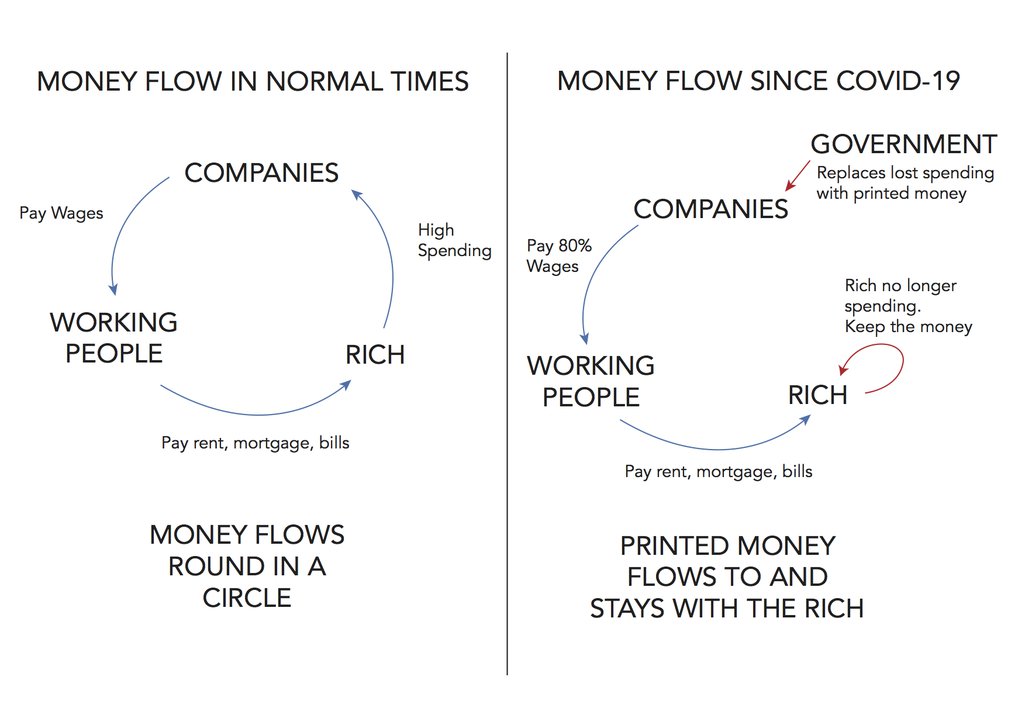
Stvari mogu da se prilično zabrljaju kada vlada uskoči da preuzme “kontrolu” nad potrošnjom štampanog novca. Izvor: OpenDemocracy
Bitcoin-ov sistem eliminiše moć lobista i prednosti poznavanja pravog bankara, i stavlja ljude na mnogo ravnopravnije temelje. U Bitcoin-u, svaki ‘rudar’ na mreži ima jednake šanse da zaradi nagradu za novostvorene bitcoin-e na svakih 10 minuta. Svako može da postane rudar, jednostavnim kupovanjem hardvera i njegovim uključivanjem u utičnicu – daleko manje mukotrpan posao od lobiranja kod izabranih predstavnika da bi vam dodelili ugovor sa vladom. Rudari troše puno novca na električnu energiju i opremu da bi se takmičili za nagradu, a Bitcoin sistemu pružaju preko potrebnu uslugu: bezbednost. Bez rudara, Bitcoin-ov sistem ne bi funkcionisao.
:max_bytes(150000):strip_icc()/GettyImages-929584582-9d7790de3ee44f658a9580cc598c641f.jpg)
Rudarenje bitcoin-a zahteva računar i struju – to je to.
U sistemu američkog dolara vidimo da političke veze proističu iz Cantillonovog Efekta. U Bitcoin sistemu vidimo da se pružaoci usluga (rudari) plaćaju za svoje usluge novostvorenim bitcoin-ima.
Naravno, ishodi Cantillonovog Efekta bi mogli da se promene tako što će političari da promene način na koji novi novac ulazi u sistem. Međutim, ovo ne rešava osnovni problem: neko drugi ima korist na tuđi račun.
Bitcoin sistem je daleko pravedniji jer koristi Cantillonov Efekat da bi uredno nagradio one koji pružaju korisnu uslugu za sve ostale: obezbeđivanje Bitcoin mreže.
Zamislite to ovako: u dolarskom sistemu, neka osoba šarmira političare ili bankare na pravim pozicijama da bi dobila povlašćen tretman na račun svih ostalih. U Bitcoin sistemu svi plaćaju po malo, da bi zaštitili svoje bankovne račune od krađe.
Uloga Vlade u Cantillonovom Efektu
Federalne vlade širom sveta su jedne od najvećih korisnika Cantillonovog Efekta, jer su u mogućnosti da vrlo lako dobiju zajmove od centralne banke svoje države. U SAD se to radi kada američko Ministarstvo finansija proda državne obveznice banci Federalnih rezervi. Federalne rezerve daju Ministarstvu finansija gomilu novoštampanog novca, a Ministarstvo finansija da Fed-u papir na kojem piše „mi ćemo vam isplatiti dug u to i to vreme sa određenom kamatom“. Možda je malo složenije od ovoga, ali to opisuje suštinu toga.
Budući da novac koji federalna vlada dobija nije postojao pre toga, ona može da ga potroši pre nego što cene počnu da rastu zbog tog novog novca koji ulazi u opticaj. To omogućava federalnoj vladi da ga troši na socijalne programe, policiju, vojsku, vojnu opremu za naoružavanje država poput Saudijske Arabije, čak i na ‘most iz nigde ka ničemu’, a da ne mora da koristi politički nepopularnu metodu: da poveća porez da bi to platila.
Umesto da povećaju poreske prihode za pokrivanje ove potrošnje, federalne vlade koriste Cantillonov Efekat za prenos kupovne moći od plata radnika srednje klase u vladin trezor. Na taj način inflacija i Cantillonov Efekat stvaraju skriveni porez na zarade i uštede novca.
Zaštitite Sebe od Cantillonovog Efekta
Zaštita svog života od Cantillonovog Efekta je zeznuta igra koju treba odigrati. Možete da pokušate da se približite izvoru novog novca, tako što ćete se nadmetati za državne ugovore ili raditi u vrhovima finansija. Možete da pokušate da igrate na visokim nivoima u trgovanju na berzi ili ulaganju u nekretnine, ali je verovatnije da ćete bankrotirati nego što ćete da se zaštitite.
Najlakši način da zaštitite sebe od nepravedne raspodele novog novca je potpuno odbijanje tog monetarnog sistema. Samo najstarije generacije koje danas žive mogu da se sete vremena kada je novac značio nešto drugo osim papira potkrepljenog ‘punom verom i kredibilitetom’ vlade i vojske. Mi smo tako uslovljeni da novac smatramo proizvodom naše vlade, ali naša zaštita od Cantillonovog Efekta zahteva gledanje novca kroz istoriju – čak i pre samo jednog veka.
Novac je nekada značio zlato – materijal koji nijedna vlada ne može magično da stvori u većoj količini, a koji zahteva ogroman napor da se pronađe i iskopa iz zemlje. Bitcoin je vrlo sličan zlatu po tome što niko ne može magično da ga stvori, i veoma ga je teško proizvesti više ‘rudarenjem’. Međutim, Bitcoin takođe putuje brzinom interneta, omogućavajući globalnu trgovinu na način na koji zlato jednostavno ne može.

Bitcoin i zlato – slični po karakteristikama ‘normalnog novca’, različiti po prenosivosti.
Da biste se zaštitili od Cantillonovog Efekta, potrebno je što je više moguće isključiti se iz nepravednih sistema tradicionalnih valuta, čuvajući bogatstvo u pravom novcu, poput zlata ili Bitcoin-a. Ovo je najmirniji način za ukidanje starog sistema i uvođenje novog, pravednijeg sistema.
Kako mogu da saznam više o Bitcoin-u?
Film "Bitkoin: Kraj novca kakvog poznajemo"
The Bitcoin Whitepaper ← objavljen 2008. godine, ovo je izložio dizajn za Bitcoin.
Ako vam se sviđa moj rad, molim vas da ga podelite sa svojim prijateljima i porodicom. Cilj mi je da svima pružim uvid u ekonomiju i kako ona utiče na njihove živote.
-
 @ bf47c19e:c3d2573b
2025-05-28 20:37:58
@ bf47c19e:c3d2573b
2025-05-28 20:37:58Bitcoin: Peer-to-peer sistem elektronskog novca
Satoshi Nakamoto
satoshin@gmx.com
Prevedeno na srpski sa bitcoin.org/bitcoin.pdf od strane ECD
Sažetak. Potpuna peer-to-peer verzija elektronskog novca omogućila bi slanje uplata putem interneta direktno od jedne strane ka drugoj bez posredovanja finansijskih institucija. Digitalni potpisi pružaju deo rešenja, ali se glavni benefiti gube ako je i dalje potrebna pouzdana treća strana za sprečavanje dvostruke potrošnje. Predlažemo rešenje problema dvostruke potrošnje korišćenjem peer-to-peer mreže. Mreža vremenski označava transakcije tako što ih hešuje u tekući lanac dokaza o radu (proof of work) temeljen na hešu, formirajući zapis koji se ne može promeniti bez ponovnog rada i objavljivanja dokaza o tom radu. Najduži lanac ne služi samo kao dokaz niza događaja, nego i kao dokaz da je taj niz događaja potvrđen od strane dela peer-to-peer mreže koja poseduju najveću zbirnu procesorsku snagu (CPU). Sve dok većinu procesorske snage kontrolišu čvorovi (nodes) koji ne sarađuju u napadu na mrežu, oni će generisati najduži lanac i nadmašiti napadače. Sama mreža zahteva minimalnu strukturu. Poruke kroz mrežu se prenose uz pretpostavku da svaki čvor čini maksimalan napor da poruku prenese u svom izvornom obliku i na optimalan način, a čvorovi mogu napustiti mrežu i ponovo joj se pridružiti po želji, prihvatajući najduži lanac dokaza o radu kao dokaz onoga što se dogodilo dok ih nije bilo.
1. Uvod
Trgovina na Internetu počela je da se oslanja skoro isključivo na finansijske institucije koje služe kao pouzdani posrednici pri obradi elektronskih plaćanja. Iako sistem radi dovoljno dobro za većinu transakcija i dalje trpi od inherentnih slabosti modela utemeljenog na poverenju.
Potpuno nepovratne transakcije zapravo nisu moguće, jer finansijske institucije ne mogu izbeći posredovanje u rešavanju eventualnih sporova. Troškovi posredovanja povećavaju troškove transakcija, ograničavaju minimalnu praktičnu veličinu transakcija i onemogućuju male, povremene transakcije jer postoji velika šteta zbog gubitka mogućnosti da se izvrše nepovratna plaćanja za nepovratne usluge. Uz mogućnost povraćaja transakcije, potreba za poverenjem raste. Trgovci moraju biti oprezni prema svojim kupcima i tražiti im više informacija nego što bi inače bilo neophodno. Određeni procenat prevara prihvaćen je kao neizbežan. Ovi troškovi i nepouzdanost plaćanja mogu se izbeći korišćenjem gotovine, ali ne postoji mehanizam za elektronsko plaćanje bez pouzdane treće strane.
Ono što je potrebno je elektronski sistem plaćanja zasnovan na kriptografskom dokazu umesto na poverenju, koji omogućava da bilo koje dve strane direktno i dobrovoljno međusobno trguju bez potrebe za posrednikom. Transakcije koje su nepovratne bi zaštitile prodavce od prevara, a escrow mehanizmi mogli bi se lako implementirati radi zaštite kupaca. U ovom dokumentu predlažemo rešenje problema dvostruke potrošnje korišćenjem peer-to-peer distribuiranog servera vremenskih oznaka (timestamp) za generisanje računarskog dokaza o hronološkom redosledu transakcija. Sistem je siguran sve dok pošteni čvorovi zajedno kontrolišu više procesorske snage procesora nego bilo koja udružena grupa napadačkih čvorova.
2. Transakcije
Elektronski novčić definišemo kao lanac digitalnih potpisa. Svaki vlasnik prenosi novčić na sledećeg digitalnim potpisivanjem heša prethodne transakcije i javnog ključa sledećeg vlasnika, dodajući ih potom na kraj novčića. Primalac transakcije može da verifikuje potpise, a time i lanac vlasništva.

Problem je naravno u tome što primalac ne može potvrditi da jedan od prethodnih vlasnika nije dva puta poslao isti novčić. Uobičajeno rešenje je uvođenje pouzdanog centralizovanog posrednika, kreatora novčića koji proverava sve transakcije. Nakon svake transakcije, novčić se mora vratiti kreatoru kako bi se izdao novi novčić i veruje se da samo za novčiće izdate direktno od kreatora možemo biti sigurni da nisu dva puta potrošeni. Problem sa ovim rešenjem je što sudbina čitavog novčanog sistema zavisi od kompanije koja kreira novčiće, jer svaka transakcija mora da prođe kroz nju, baš kao što je slučaj sa bankom.
Treba nam način da primalac bude siguran da prethodni vlasnici nisu potpisali nikakve ranije transakcije kojim bi potrošili taj novčić. Za naše potrebe, računamo transakciju koja se prva desila i ne zanimaju nas naredni pokušaji da se isti novčić ponovo pošalje. Jedini način da sa sigurnošću potvrdimo da taj novčić nije prethodno bio poslat je da imamo informacije o svim transakcijama koje su se ikada desile. U modelu baziranom na centalizovan kreatoru, taj kreator je imao informacije o svim transakcijama i odlučivao koja transakcija je prva stigla. Da bismo to postigli bez pouzdanog posrednika, transakcije moraju biti javno objavljene [1] i potreban nam je sistem u kojem učesnici mogu da se dogovore o jedinstvenoj istoriji redosleda kojim su transakcije primljene. Primaocu je potreban dokaz da se u trenutku dešavanja svake od transakcija većina čvorova složila oko toga da je baš ta transakcija bila ona koja je prva primljena.
3. Server vremenskih oznaka
Rešenje koje predlažemo počinje serverom vremenskih oznaka. Server vremenske oznake radi tako što uzima heš bloka podataka kojem će se dodeliti vremenska oznaka i objavi taj heš svima u mreži, slično kao u novinama ili kao post na Usenet mreži [2-5]. Vremenska oznaka očigledno dokazuje da su podaci morali postojati u to vreme kako bi ušli u haš. Svaka vremenska oznaka sadrži prethodnu vremensku oznaku u svom hešu, formirajući tako lanac, pri čemu svaka dodatna vremenska oznaka pojačava potvrde onih pre nje.

4. Dokaz o radu (Proof-of-Work)
Da bismo implementirali distribuirani server vremenskih oznaka na peer-to-peer principu, moraćemo da koristimo sistem dokaza o radu sličan Hashcash-u Adama Back-a [6], umesto Uneset postova ili novinskih objava. Dokaz o radu uključuje traženje vrednosti koja će, kada se hešuje, na primer pomoću SHA-256 heš funkcije, stvarati heš čiji binarni zapis započinje određenim brojem nula. Prosečna količina potrebnog rada eksponencijalno raste sa brojem potrebnih početnih nula, a može se proveriti izvršavanjem samo jedne heš fuknkcije.
Za našu mrežu vremenskih oznaka implementiramo dokaz o radu povećavajući nonce broja u bloku sve dok se ne pronađe ona vrednost nonce-a koja daje hešu bloka potreban broj početnih nula. Jednom kada se procesorska snaga utroši kako bi se zadovoljio dokaz o radu, blok se ne može izmeniti bez ponovljenog rada. Kako se kasniji blokovi vežu na taj blok, rad potreban da se on izmeni uključivao bi i ponovno obrađivanje svih blokova nakon njega.

Dokaz o radu takođe rešava problem utvrđivanja većine pri odlučivanju. Ako bi se većina zasnivala na principu jednog glasa po IP adresi, mogao bi je narušiti svako ko je u stanju da glasa sa više IP adresa odjednom. Dokaz o radu u osnovi predstavlja jedan glas po jedinici procesorske snage. Većinska odluka je predstavljena najdužim lancem u čije je stvaranje zapravo investirano najviše rada prilikom dokazivanja. Ako većinu procesorske snage kontrolišu pošteni čvorovi, pošten lanac će rasti najbrže i nadmašiće sve konkurentske lance. Da bi izmenio neki od prethodnih blokova, napadač bi morao da ponovi dokaz o radu za taj blok i sve blokove nakon njega, a zatim da sustigne i nadmaši količinu rada poštenih čvorova. Kasnije ćemo pokazati da se dodavanjem novih blokova eksponencijalno smanjuje verovatnoća da će sporiji napadač uspeti da sustigne pošteni lanac.
Da bi se kompenzovalo povećanje brzine hardvera i promenljivo interesovanje ljudi za vođenje čvorova tokom vremena, težina obavljanja dokaza o radu (proof-of-work difficulty) određuje se prema prosečnom broju blokova krairanih za sat vremena. Ako se blokovi stvaraju prebrzo, težina se povećava.
5. Mreža
Koraci za vođenje mreže su sledeći:
1) Nove transakcije se prosleđuju svim čvorovima u mreži. 2) Svaki čvor prikuplja nove transakcije u blok. 3) Svaki čvor radi na pronalaženju dokaza o radu dovoljnog nivoa težine za svoj blok. 4) Kada čvor pronađe dokaz o radu, on emituje taj blok ka svim čvorovima. 5) Čvorovi prihvataju blok samo ako su sve transakcije u njemu ispravne i nisu već potrošene. 6) Čvorovi izražavaju prihvatanje bloka radeći na stvaranju sledećeg bloka u lancu, koristeći heš prihvaćenog bloka kao prethodni heš.
Čvorovi uvek smatraju da je najduži lanac ispravan i nastaviće da rade na njegovom produžavanju. Ako dva čvora istovremeno emituju različite verzije sledećeg bloka, neki čvorovi prvo mogu primiti jedan ili drugi blok. U tom slučaju svaki čvor radi na prvom koji je dobio, ali čuvaju drugu kariku lanca u slučaju da ona postane duža. Dilema će biti rešena kada se pronađe sledeći dokaz o radu i jedna karika postane duža; čvorovi koji su radili na drugoj karici lanca će se prebaciti na dužu kariku.
Emitovanje novih transakcija ne mora nužno doći do svih čvorova. Sve dok stižu do velikog broja čvorova, te transakcije će ući u blok. Slično važi i za blokove, ni oni ne moraju doći odmah do svih čvorova. Ako neki čvor propusti da primi informaciju o bloku, kada mu stigne sledeći blok,primetiće da je propustio jedan, pa će ga tražiti naknadno.
6. Podsticaj
Po pravilu, prva transakcija u bloku je posebna transakcija koja kreira novi novčić u vlasništvu kreatora bloka. Ovo daje podsticaj čvorovima da podrže mrežu i pruža način za početnu ubacivanje novčića u opticaj, budući da ne postoji centralno telo koje ih izdaje. Stalno dodavanje konstantne količine novih novčića liči na rudarenje zlata, gde rudari ulažu resurse kako bi izrudarili nove količine zlata i ubacili ih u opticaj. U našem slučaju ulaže se procesorsko vreme i električna energija.
Podsticaj se takođe može finansirati i transakcionim naknadama. Ako je iznos izlaznog dela transakcije manji od ulaznog, razliku čini naknada za transakciju koja se dodaje iznosu nagrade za kreatora bloka koji sadrži tu transakciju. Nakon što predefinisani broj novčića uđe u opticaj, podsticaj mogu u potpunosti činiti transakcione naknade, čime se sistem oslobađa inflacije.
Čvorovi su na ovaj način podstaknuti da ostanu pošteni. Ako je pohlepni napadač u stanju da angažuje više procesorske snage od svih poštenih čvorova zajedno, morao bi da bira između toga da poništi svoje izvršene transakcije i time prevari ljude ili da procesorsku snagu koristi za stvaranje novih novčića. On bi trebalo bi uvidi da je isplativije igrati po pravilima koja ga nagrađuju sa više novih novčića od svi drugi zajedno, nego da potkopava sistem i vrednost sopstvenog bogatstva.
7. Oslobađanje prostora na hard disku
Kada je dovoljno blokova dodato nakon poslednje transakcije novčića, prethodne transakcije tog novčića se mogu odbaciti kako bi se uštedeo prostor na hard disku. Kako bi se to ostvarilo bez razbijanja heša bloka, transakcije su hešovane u Merkleovo stablo (Merkle Tree) [7] [2] [5], gde je samo koren uključen u heš bloka. Stari blokovi se tada mogu sabiti uklanjanjem nepotrebnih grana drveta. Unutrašnji heševi ne moraju biti skladišteni.

Zaglavlje bloka bez transakcija bilo bi oko 80 bajtova. Ako pretpostavimo da su blokovi generisani svakih 10 minuta, 80 bajtova * 6 * 24 * 365 = 4,2 MB godišnje. Imajući u vidu činjenicu da se u 2008. godini računari uglavnom prodaju sa oko 2 GB RAM-a i Murov zakon koji predviđa trenutni rast od 1,2 GB godišnje, skladištenje ne bi trebalo da predstavlja problem čak i ako se zaglavlja bloka moraju čuvati u memoriji.
8. Pojednostavljena verifikacija plaćanja
Moguće je verifikovati plaćanja bez vođenja čitavog mrežnog čvora. Korisnik samo treba da sačuva kopiju zaglavlja blokova najdužeg lanca dokaza o radu, do koje može doći upitom ka mrežnim čvorovima dok se ne uveri da je dobio najduži lanac i dobije Merkleova granu
koja povezuje transakciju sa blokom u koji je uneta vremenska oznaka za tu transakciju. Ne može samostalno proveriti transakciju, ali povezujući je sa mestom u lancu može videti da je prihvaćena od strane čvora mreže i da su na njen blok dodati naknadni blokovi što dalje potvrđuje da ju je mreža prihvatila.

Kao takva, verifikacija je pouzdana sve dok pošteni čvorovi kontrolišu mrežu, ali je ranjiva ako napadač nadjača ostatak mreže. Čvorovi mreže mogu sami proveriti transakcije, ali napadačeve lažne transakcije mogu zavarati one koji koriste pojednostavljenu metodu verifikacije transakcija sve dok je on u stanju da nadjačava ostatak mreže. Jedna od strategija zaštite bila bi prihvatanje upozorenja čvorova mreže kada otkriju nevažeći blok, pri čemu bi korisnikov softver morao da preuzme ceo blok i sporne transakcije kako bi potvrdio nepravilnost. Biznisi koji primaju česte uplate će verovatno želeti da pokrenu i vode sopstvene čvorove radi brže verifikacije i potrebe da im sigurnost ne zavisi od drugih.
9. Kombinovanje i deljenje vrednosti
Iako bi bilo moguće pojedinačno rukovati novčićima, bilo bi nezgrapno kreirati zasebnu transakciju za svaki cent u toj transferu. Da biste dozvolili podelu i kombinovanje vrednosti, transakcije sadrže više ulaza i izlaza. Obično će postojati ili jedan ulaz iz veće prethodne transakcije ili više unosa koji kombinuju manje iznose, a najviše dva izlaza: jedan za samo plaćanje, a jedan koji vraća kusur, ako ga ima, nazad pošiljaocu.

Treba napomenuti da situacija u kojoj transakcija zavisi od nekoliko drugih transakcija, a te transakcije zavise od još mnogo više, ovde nije problem. Nikada ne postoji potreba za izdvajanjem istorije pojedinačne transakcije.
10. Privatnost
Tradicionalni bankarski model postiže odgovarajući nivo privatnosti ograničavanjem pristupa informacijama na strane uključene u transakciju i posrednika. Neophodnost javnog objavljivanja svih transakcija isključuje mogućnost primene pomenutog modela, ali privatnost se i dalje može zadržati na drugi način: čuvanjem javnih ključeva (public keys) anonimnim. Javnost može videti da neko šalje iznos nekom drugom, ali bez informacija koje povezuju transakciju sa bilo kim. Ovo je slično količini informacija koje objavljuju berze, gde se vreme i veličina pojedinačnih trgovina čine javnim, ali bez navođenja ko su stranke uključene u tu trgovinu.

Kao dodatni zaštitni zid, preporučljivo je koristiti novi par ključeva za svaku transakciju, kako ne bi bili povezane sa zajedničkim vlasnikom. Neka povezivanja su i dalje neizbežna kod transakcija sa više ulaza, koje nužno otkrivaju da su njihovi ulazi bili u vlasništvu istog vlasnika. Rizik je taj da bi se otkrivanjem vlasnik ključa mogle otkriti i ostale transakcije koje su pripadale tom vlasniku.
11. Proračuni
Razmatramo scenario u kome napadač pokušava da generiše alternativni lanac brže od poštenog lanca. Čak i ako se to postigne, to ne omogućuje proizvoljne promene u sistemu, poput stvaranje vrednosti ni iz čega ili uzimanje novca koji nikada nije pripadao napadaču. Pošteni čvorovi neće prihvatiti nevažeće transakcije kao uplatu i nikada neće prihvatiti blok koji ih sadrži. Napadač može samo pokušati da promeni jednu od svojih transakcija kako bi vratio novac koji je nedavno potrošio.
Trka između poštenog lanca i lanca napadača može se predstaviti kao binomska distribucija slučajne diskretne varijable (Binomial Random Walk). Uspešni ishod je da se pošten lanac produži za jedan blok, povećavajući svoje vođstvo za +1, a neuspešni ishod je da se napadačev lanac produži za jedan blok, smanjujući zaostatak za -1.
Verovatnoću da napadač nadoknadi određeni deficit možemo izraziti kroz problem kockareve propasti (Gambler’s Ruin Problem). Pretpostavimo da kockar sa neograničenim iznosom novca počinje sa zaostatkom i igra potencijalno beskonačan broj ponovljenih igara u pokušaju da nadoknadi zaostatak. Možemo izračunati verovatnoću za nadoknađivanje zaostatka ili da će napadač stići pošten lanac, na sledeći način [8]:
p= verovatnoća da pošten čvor pronađe sledeći blok q= verovatnoća da napadač pronađe sledeći blok qz= verovatnoća da će napadač ikada dostići z blokova zaostatka

S obzirom na našu pretpostavku da je p > q, verovatnoća pada eksponencijalno kako se povećava broj blokova koje napadač mora da nadoknadi. Sa šansama protiv njega, ako mu se u početku ne posreći, njegove šanse postaju manje i manje sa povećanjem zaostatka.
Sada razmatramo koliko primalac nove transakcije treba da čeka pre nego što postane
dovoljno siguran da pošiljalac ne može promeniti transakciju. Pretpostavljamo da je pošiljalac napadač koji želi da natera primaoca da veruje da mu je platio, a zatim nakon nekog vremena tu transakciju preusmeri ka sebi. Primalac će primetiti kada se to dogodi, ali pošiljalac se nada da će tad već biti prekasno.
Primalac generiše novi par ključeva i daje javni ključ pošiljaocu neposredno pre potpisivanja transakcije. Ovo sprečava pošiljaoca da unapred pripremi lanac blokova radeći na njemu neprekidno dok mu se ne posreći da stekne dovoljnu prednost i u tom trenutku izvrši transakciju. Kada se transakcija pošalje, nepošteni pošiljalac počinje tajno da radi na paralelnom lancu koji sadrži alternativnu verziju njegove transakcije.
Primalac čeka dok transakcija ne bude dodata u blok, i dok z blokova nije dodato nakon tog bloka. On ne zna tačno koliko je napadač napredovao, ali pod pretpostavkom da su pošteni blokovi kreirani očekivanom dinamikom, potencijalni napredak napadača će biti prikazan kao Poasonova distribucija sa očekivanom vrednošću:

Kako bismo izračunali verovatnoću da napadač ipak može da nadoknadi zaostatak, množimo gustinu verovatnoće za svaki nivo napretka koji je mogao da ostvari sa verovatnoćom da od tog trenutka može da potpuno nadoknadi zaostatak:

Preuređujemo formulu kako bismo izbegli sabiranje beskonačnog broja sabiraka zbog repa distribucije:

I konvertujemo u programski kod u programskom jeziku C…

Kroz par primera, vidimo da verovatnoća opada eksponencijalno sa porastom z.

Rešavanje za P < 0.1%…

12. Zaključak
Predložili smo sistem za elektronske transakcije bez oslanjanja na poverenje. Počeli smo sa uobičajenim šablonom i novčićima nastalim iz digitalnih potpisa, koji pruža snažnu kontrolu nad vlasništvom, ali je nepotpun bez načina da se spreči dvostruka potrošnja. Kako bismo ovo rešili, predložili smo peer-to-peer mrežu koja koristi dokaz o radu za čuvanje javne istorije transakcija čija izmena napadačima brzo postaje računski nepraktična ako pošteni čvorovi kontrolišu većinu procesorske snage. Mreža je robusna u svojoj nestrukturiranoj jednostavnosti. Svi čvorovi rade istovremeno uz malo koordinacije. Ne treba ih identifikovati, jer se poruke ne usmeravaju na jedno određeno mesto nego samo trebaju biti prenete uz maksimalan napor od strane čvorova da se taj prenos odradi na predviđen način. Čvorovi mogu da napuste i ponovo se pridruže mreži po želji, prihvatajući lanac dokaza o radu kao dokaz onoga što se dogodilo dok ih nije bilo. Oni glasaju svojom procesorskom snagom, izražavajući svoje prihvatanje validnih blokova time što pokušavaju da ih nadgrade novim blokovima i odbacuju nevažeće blokove odbijanjem ih nadgrađuju. Sva potrebna pravila i podsticaji mogu se nametnuti ovim mehanizmom postizanja konsenzusa.
Reference:
[1] W. Dai, „b-money,“ weidai.com/bmoney.txt, 1998.
[2] H. Massias, X.S. Avila, and J.-J. Quisquater, „Design of a secure timestamping service with minimal trust requirements,“ In 20th Symposium on Information Theory in the Benelux, May 1999.
[3] S. Haber, W.S. Stornetta, „How to time-stamp a digital document,“ In Journal of Cryptology, vol 3, no 2, pages 99-111, 1991.
[4] D. Bayer, S. Haber, W.S. Stornetta, „Improving the efficiency and reliability of digital time-stamping,“ In Sequences II: Methods in Communication, Security and Computer Science, pages 329-334, 1993.
[5] S. Haber, W.S. Stornetta, „Secure names for bit-strings,“ In Proceedings of the 4th ACM Conference on Computer and Communications Security, pages 28-35, April 1997.
[6] A. Back, „Hashcash – a denial of service counter-measure,“ hashcash.org/papers/hashcash.pdf, 2002.
[7] R.C. Merkle, „Protocols for public key cryptosystems,“ In Proc. 1980 Symposium on Security and Privacy, IEEE Computer Society, pages 122-133, April 1980.
[8] W. Feller, „An introduction to probability theory and its applications,“ 1957.
-
 @ bf47c19e:c3d2573b
2025-05-28 19:59:23
@ bf47c19e:c3d2573b
2025-05-28 19:59:23Originalni tekst na dvadesetjedan.com
Autor: Vijay Boyapati / Prevod na hrvatski: Matija
Sa zadnjim cijenama koje je bitcoin dosegao 2017., optimističan scenarij za ulagače se možda čini toliko očitim da ga nije potrebno niti spominjati. Alternativno, možda se nekome čini glupo ulagati u digitalnu vrijednost koja ne počiva na nijednom fizičkom dobru ili vladi i čiji porast cijene su neki usporedili sa manijom tulipana ili dot-com balonom. Nijedno nije točno; optimističan scenarij za Bitcoin je uvjerljiv, ali ne i očit. Postoje značajni rizici kod ulaganja u Bitcoin, no, kao što planiram pokazati, postoji i ogromna prilika.
Geneza
Nikad u povijesti svijeta nije bilo moguće napraviti transfer vrijednosti među fizički udaljenim ljudima bez posrednika, poput banke ili vlade. 2008. godine, anonimni Satoshi Nakamoto je objavio 8 stranica rješenja na dugo nerješivi računalski problem poznat kao “Problem Bizantskog Generala.” Njegovo rješenje i sustav koji je izgradio - Bitcoin - dozvolio je, prvi put ikad, da se vrijednost prenosi brzo i daleko, bez ikakvih posrednika ili povjerenja. Implikacije kreacije Bitcoina su toliko duboke, ekonomski i računalski, da bi Nakamoto trebao biti prva osoba nominirana za Nobelovu nagradu za ekonomiju i Turingovu nagradu.
Za ulagače, važna činjenica izuma Bitcoina (mreže i protokola) je stvaranje novog oskudnog digitalnog dobra - bitcoina (monetarne jedinice). Bitcoini su prenosivi digitalni “novčići” (tokeni), proizvedeni na Bitcoin mreži kroz proces nazvan “rudarenje” (mining). Rudarenje Bitcoina je ugrubo usporedivo sa rudarenjem zlata, uz bitnu razliku da proizvodnja bitcoina prati unaprijed osmišljeni i predvidivi raspored. Samo 21 milijun bitcoina će ikad postojati, i većina (2017., kada je ovaj tekst napisan) su već izrudareni. Svake četiri godine, količina rudarenih bitcoina se prepolovi. Produkcija novih bitcoina će potpuno prestati 2140. godine.
 Stopa inflacije —— Monetarna baza
Stopa inflacije —— Monetarna bazaBitcoine ne podržava nikakva roba ili dobra, niti ih garantira ikakva vlada ili firma, što postavlja očito pitanje za svakog novog bitcoin ulagača: zašto imaju uopće ikakvu vrijednost? Za razliku od dionica, obveznica, nekretnina ili robe poput nafte i žita, bitcoine nije moguće vrednovati koristeći standardne ekonomske analize ili korisnost u proizvodnji drugih dobara. Bitcoini pripadaju sasvim drugoj kategoriji dobara - monetarnih dobara, čija se vrijednost definira kroz tzv. teoriju igara; svaki sudionik na tržištu vrednuje neko dobro, onoliko koliko procjenjuje da će ga drugi sudionici vrednovati. Kako bismo bolje razumjeli ovo svojstvo monetarnih dobara, trebamo istražiti podrijetlo novca.
Podrijetlo novca
U prvim ljudskim društvima, trgovina među grupama se vršila kroz robnu razmjenu. Velika neefikasnost prisutna u robnoj razmjeni je drastično ograničavala količinu i geografski prostor na kojem je bila moguća. Jedan od najvećih problema sa robnom razmjenom je problem dvostruke podudarnosti potražnje. Uzgajivač jabuka možda želi trgovati sa ribarom, ali ako ribar ne želi jabuke u istom trenutku, razmjena se neće dogoditi. Kroz vrijeme, ljudi su razvili želju za čuvanjem određenih predmeta zbog njihove rijetkosti i simbolične vrijednosti (npr. školjke, životinjski zube, kremen). Zaista, kako i Nick Szabo govori u svojem izvrsnom eseju o podrijetlu novca, ljudska želja za sakupljanjem predmeta pružila je izraženu evolucijsku prednost ranom čovjeku nad njegovim najbližim biološkim rivalom, neandertalcem - Homo neanderthalensis.
"Primarna i najbitnija evolucijska funkcija sakupljanja bila je osigurati medij za čuvanje i prenošenje vrijednosti".
Predmeti koje su ljudi sakupljali služili su kao svojevrsni “proto-novac,” tako što su omogućavale trgovinu među antagonističkim plemenima i dozvoljavale bogatsvu da se prenosi na sljedeću generaciju. Trgovina i transfer takvih predmeta bile su rijetke u paleolitskim društvima, te su oni služili više kao “spremište vrijednosti” (store of value) nego kao “medij razmjene” (medium of exchange), što je uloga koju danas igra moderni novac. Szabo objašnjava:
"U usporedbi sa modernim novcem, primitivan novac je imao jako malo “brzinu” - mogao je promijeniti ruke samo nekoliko puta u životu prosječnog čovjeka. Svejedno, trajni i čvrsti sakupljački predmet, što bismo danas nazvali “nasljeđe,” mogao je opstati mnogo generacija, dodajući znatnu vrijednost pri svakom transferu - i zapravo omogućiti transfer uopće".
Rani čovjek suočio se sa bitnom dilemom u teoriji igara, kada je odlučivao koje predmete sakupljati: koje od njih će drugi ljudi željeti? Onaj koji bi to točno predvidio imao bi ogromnu prednost u mogućnosti trgovine i akvizicije bogatsva. Neka američka indijanska plemena, npr. Naraganseti, specijalizirala su se u proizvodnji sakupljačkih dobara koja nisu imala drugu svrhu osim trgovine. Valja spomenuti da što je ranije predviđanje da će neko dobro imati takvu vrijednost, veća je prednost koju će imati onaj koji je posjeduje, zato što ju je moguće nabaviti jeftinije, prije nego postane vrlo tražena roba i njezona vrijednost naraste zajedno sa populacijom. Nadalje, nabava nekog dobra u nadi da će u budućnosti biti korišteno kao spremište vrijednosti, ubrzava upravo tu primjenu. Ova cirkularnost je zapravo povratna veza (feedback loop) koja potiče društva da se rapidno slože oko jednog spremišta vrijednosti. U terminima teorije igara, ovo je znano kao “Nashov ekvilibrij.” Postizanje Nashovog ekvilibrija za neko spremište vrijednosti je veliko postignuće za društvo, pošto ono znatno olakšava trgovinu i podjelu rada, i time omogućava napredak civilizacije.

Tisućljećima, kako su ljudska društva rasla i otvarala trgovinske puteve, različite aplikacije spremišta vrijednosti u individualnim društvima počele su se natjecati međusobno. Trgovci su imali izbor: čuvati svoju zaradu u spremištu vrijednosti vlastite kulture, ili one kulture sa kojom su trgovali, ili mješavini oboje. Benefit štednje u stranom spremištu vrijednosti bila je uvećana sposobnost trgovanja u povezanom stranom društvu. Trgovci koji su štedili u stranom spremištu vrijednosti su također imali dobrih razloga da potiču svoje društvo da ga prihvati, jer bi tako uvećali vrijednost vlastite ušteđevine. Prednosti “uvezene” tehnologije spremanja vrijednosti bile su prisutne ne samo za trgovce, nego i za sama društva. Kada bi se dvije grupe konvergirale u jedinstvenom spremištu vrijednosti, to bi značajno smanjilo cijenu troškova trgovine jednog s drugim, i samim time povećanje bogatstva kroz trgovinu. I zaista, 19. stoljeće bilo je prvi put da je najveći dio svijeta prihvatio jedinstveno spremište vrijednosti - zlato - i u tom periodu vidio najveću eksploziju trgovine u povijesti svijeta. O ovom mirnom periodu, pisao je John Maynard Keynes:
"Kakva nevjerojatna epizoda u ekonomskom napretku čovjeka… za svakog čovjeka iole iznadprosječnog, iz srednje ili više klase, život je nudio obilje, ugodu i mogućnosti, po niskoj cijeni i bez puno problema, više nego monarsima iz prethodnih perioda. Stanovnik Londona mogao je, ispijajući jutarnji čaj iz kreveta, telefonski naručiti razne proizvode iz cijele Zemlje, u količinama koje je želio, i sa dobrim razlogom očekivati njihovu dostavu na svoj kućni prag."
Svojstva dobrog spremišta vrijednosti
Kada se spremišta vrijednosti natječu jedno s drugim, specifična svojstva rade razliku koja daje jednom prednost nad drugim. Premda su mnoga dobra u prošlosti korištena kao spremišta vrijednosti ili kao “proto-novac,” određena svojstva su se pokazala kao posebno važna, i omogućila dobrima sa njima da pobijede. Idealno spremište vrijednosti biti će:
- Trajno: dobro ne smije biti kvarljivo ili lako uništeno. Tako naprimjer, žito nije idealno spremište vrijednosti.
- Prenosivo: dobro mora biti lako transportirati i čuvati, što omogućuje osiguranje protiv gubitka ili krađe i dopušta trgovinu na velike udaljenosti. Tako, krava je lošije spremište vrijednosti od zlatne narukvice.
- Zamjenjivo: jedna jedinica dobra treba biti zamjenjiva sa drugom. Bez zamjenjivosti, problem podudarnosti želja ostaje nerješiv. Time, zlato je bolje od dijamanata, jer su oni nepravilni u obliku i kvaliteti.
- Provjerljivo: dobro mora biti lako i brzo identificirano i testirano za autentičnost. Laka provjera povećava povjerenje u trgovini i vjerojatnost da će razmjena biti dovršena.
- Djeljivo: dobro mora biti lako djeljivo na manje dijelove. Premda je ovo svojstvo bilo manje važno u ranim društvima gdje je trgovina bila rijetka, postalo je važnije sa procvatom trgovine. Količine koje su se mijenjale postale su manje i preciznije.
- Oskudno: Monetarno dobro mora imati “cijenu nemoguću za lažirati,” kao što je rekao Nick Szabo. Drugim riječima, dobro ne smije biti obilno ili lako dostupno kroz proizvodnju. Oskudnost je možda i najvažnije svojstvo spremišta vrijednosti, pošto se izravno vezuje na ljudsku želju da sakupljamo ono što je rijetko. Ona je izvor vrijednosti u spremištu vrijednosti.
- Duge povijesti: što je dulje neko dobro vrijedno za društvo, veća je vjerojatnost da će biti prihvaćeno kao spremište vrijednosti. Dugo postojeće spremište vrijednosti biti će jako teško uklonjeno od strane došljaka, osim u slučaju sile (ratno osvajanje) ili ako je nova tehnologija znatno bolja u ostalim svojstvima.
- Otporno na cenzuru: novije svojstvo, sve više važno u modernom digitalnom svijetu sa sveprisutnim nadzorom, je otpornost na cenzuru. Drugim riječima, koliko je teško da vanjski agent, kao korporacija ili država, spriječi vlasnika dobra da ga čuva i koristi. Dobra koja su otporna na cenzuru su idealna za ljude koji žive u režimima koji prisilno nadziru kapital ili čine neke oblike mirne trgovine protuzakonitima.
Ova tablica ocjenjuje Bitcoin, zlato (gold) i fiat novac (kao što je euro ili dolar) po svojstvima izlistanim gore. Objašnjenje svake ocjene slijedi nakon tablice.

Trajnost:
Zlato je neosporeni kralj trajnosti. Velika većina zlata pronađenog kroz povijest, uključujući ono egipatskih faraona, opstaje i danas i vjerojatno će postojati i za tisuću godina. Zlatnici korišteni u antičko doba imaju značajnu vrijednost i danas. Fiat valute i bitcoini su digitalni zapisi koji ponekad imaju fizički oblik (npr. novčanice). Dakle, njihovu trajnost ne određuju njihova fizička svojstva (moguće je zamijeniti staru i oštećenu novčanicu za novu), nego institucije koje stoje iza njih. U slučaju fiat valuta, mnoge države su nastale i nestale kroz stoljeća, i valute su nestale s njima. Marke iz Weimarske republike danas nemaju vrijednost zato što institucija koja ih je izdavala više ne postoji. Ako je povijest ikakav pokazatelj, ne bi bilo mudro smatrati fiat valute trajnima dugoročno; američki dolar i britanska funta su relativne anomalije u ovom pogledu. Bitcoini, zato što nemaju instituciju koja ih održava, mogu se smatrati trajnima dok god mreža koja ih osigurava postoji. Obzirom da je Bitcoin još uvijek mlada valuta, prerano je za čvrste zaključke o njegovoj trajnosti. No, postoje ohrabrujući znakovi - prominente države su ga pokušavale regulirati, hakeri ga napadali - usprkos tome, mreža nastavlja funkcionirati, pokazujući visok stupanj antifragilnosti.
Prenosivost:
Bitcoini su najprenosivije spremište vrijednosti ikad. Privatni ključevi koji predstavljaju stotine milijuna dolara mogu se spremiti na USB drive i lako ponijeti bilo gdje. Nadalje, jednako velike sume mogu se poslati na drugi kraj svijeta skoro instantno. Fiat valute, zbog svojeg temeljno digitalnog oblika, su također lako prenosive. Ali, regulacije i kontrola kapitala od strane države mogu ugroziti velike prijenose vrijednosti, ili ih usporiti danima. Gotovina se može koristiti kako bi se izbjegle kontrole kapitala, ali onda rastu rizik čuvanja i cijena transporta. Zlato, zbog svojeg fizičkog oblika i velike gustoće, je najmanje prenosivo. Nije čudo da većina zlatnika i poluga nikad ne napuste sefove. Kada se radi prijenos zlata između prodavača i kupca, uglavnom se prenosi samo ugovor o vlasništvu, ne samo fizičko zlato. Prijenos fizičkog zlata na velike udaljenosti je skupo, riskantno i sporo.
Zamjenjivost:
Zlato nam daje standard za zamjenjivost. Kada je rastopljeno, gram zlata je praktički nemoguće razlikovati od bilo kojeg drugog grama, i zlato je oduvijek bilo takvo. S druge strane, fiat valute, su zamjenjive samo onoliko koliko njihova institucija želi da budu. Iako je uglavnom slučaj da je novčanica zamjenjiva za drugu istog iznosa, postoje situacije u kojima su velike novčanice tretirane drukčije od malih. Naprimjer, vlada Indije je, u pokušaju da uništi neoporezivo sivo tržište, potpuno oduzela vrijednost novčanicama od 500 i 1000 rupija. To je uzrokovalo da ljudi manje vrednuju te novčanice u trgovini, što je značilo da više nisu bile zaista zamjenjive za manje novčanice. Bitcoini su zamjenjivi na razini mreže; svaki bitcoin je pri prijenosu tretiran kao svaki drugi. No, zato što je moguće pratiti individualne bitcoine na blockchainu, određeni bitcoin može, u teoriji, postati “prljav” zbog korštenja u ilegalnoj trgovini, te ga trgovci ili mjenjačnice možda neće htjeti prihvatiti. Bez dodatnih poboljšanja oko privatnosti i anonimnosti na razini mrežnog protokola, bitcoine ne možemo smatrati jednako zamjenjivim kao zlato.
Mogućnost provjere:
Praktično gledajući, autentičnost fiat valuta i zlata je prilično lako provjeriti. Svejedno, i usprkos pokušajima da spriječe krivotvorenje novčanica, i dalje postoji potencijal prevare za vlade i njihove građane. Zlato također nije imuno na krivotvorenje. Sofisticirani kriminalci su koristili pozlaćeni tungsten kako bi prevarili kupce zlata. Bitcoine je moguće provjeriti sa matematičkom sigurnošću. Korištenjem kriptografskih potpisa, vlasnik bitcoina može javno demonstrirati da posjeduje bitcoine koje tvrdi da posjeduje.
Djeljivost:
Bitcoine je moguće podijeliti u stotinu milijuna manjih jedinica (zvanih satoshi), i prenositi takve (no, valja uzeti u obzir ekonomičnost prijenosa malih iznosa, zbog cijene osiguravanja mreže - “network fee”). Fiat valute su tipično dovoljno djeljive na jedinice sa vrlo niskom kupovnom moći. Zlato, iako fizički i teoretski djeljivo, postaje teško za korištenje kada se podijeli na dovoljno male količine da bi se moglo koristiti u svakodnevnoj trgovini.
Oskudnost:
Svojstvo koje najjasnije razlikuje Bitcoin od fiat valuta i zlata je njegova unaprijed definirana oskudnost. Od početka, konačna količina bitcoina nikad neće biti veća od 21 milijun. To daje vlasnicima bitcoina jasan i znan uvid u postotak ukupnog vlasništva. Naprimjer, vlasnik 10 bitcoina bi znao da najviše 2,1 milijuna ljudi (manje od 0.03% populacije) može ikad imati isto bitcoina kao i on. Premda je kroz povijest uvijek bilo oskudno, zlato nije imuno na povećanje ukupne količine. Ako se ikad izumi nova, ekonomičnija metoda rudarenja ili proizvodnje zlata, ukupna količina zlata bi se mogla dramatično povećati (npr. rudarenje morskog dna ili asteroida). Na kraju, fiat valute, relativno nov izum u povijesti, pokazale su se sklonima konstantnim povećanjima u količini. Države su pokazale stalnu sklonost inflaciji monetarne kvantitete kako bi rješavale kratkoročne političke probleme. Inflacijske tendencije vlada diljem svijeta čine fiat valute gotovo sigurnim da će gubiti vrijednost kroz vrijeme.
Etablirana povijest:
Nijedno monetarno dobro nema povijest kao zlato, koje je imalo vrijednost za cijelog trajanja ljudske civilizacije. Kovanice izrađene u antičko doba i danas imaju značajnu vrijednost. Ne može se isto reći za fiat valute, koje su same relativno nova povijesna anomalija. Od njihovog početka, fiat valute su imale gotovo univerzalni smjer prema bezvrijednosti. Korištenje inflacije kao podmuklog načina za nevidljivo oporezivanje građana je vječita kušnja kojoj se skoro nijedna država u povijesti nije mogla oduprijeti. Ako je 20. stoljeće, u kojem je fiat novac dominirao globalni monetarni poredak, demonstriralo neku ekonomsku istinu, to je onda bila ta da ne možemo računati na fiat novac da održi vrijednost u dužem ili srednjem vremenskom periodu. Bitcoin, usprkos svojoj novosti, je preživio dovoljno testova tržišta da postoji velika vjerojatnost da neće nestati kao vrijedno dobro. Nadalje, Lindy efekt govori da što duže Bitcoin bude korišten, to će veća biti vjera u njega i njegovu sposobnost da nastavi postojati dugo u budućnost. Drugim riječima, društvena vjera u monetarno dobro je asimptotička, kao u grafu ispod:

Ako Bitcoin preživi prvih 20 godina, imat će gotovo sveopće povjerenje da će trajati zauvijek, kao što ljudi vjeruju da je internet trajna stvar u modernom svijetu.
Otpor na cenzuru
Jedan od najbitnijih izvora za ranu potražnju bitcoina bila je njegova upotreba u ilegalnoj kupovini i prodaji droge. Mnogi su zato pogrešno zaključili da je primarna potražnja za bitcoinima utemeljena u njihovoj prividnoj anonimnosti. Međutim, Bitcoin nije anonimna valuta; svaka transakcija na mreži je zauvijek zapisana na javnom blockchainu. Povijesni zapis transakcija dozvoljava forenzičkoj analizi da identificira izvore i tijek sredstava. Takva analiza dovela je do uhićenja počinitelja zloglasne MtGox pljačke. Premda je istina da dovoljno oprezna i pedantna osoba može sakriti svoj identitet koristeći Bitcoin, to nije razlog zašto je Bitcoin bio toliko popularan u trgovini drogom.
Ključno svojstvo koje čini Bitcoin najboljim za takve aktivnosti je njegova agnostičnost i nepotrebnost za dozvolom (“premissionlessness”) na mrežnoj razini. Kada se bitcoini prenose na Bitcoin mreži, ne postoji nitko tko dopušta transakcije. Bitcoin je distribuirana peer-to-peer (korisnik-korisniku) mreža, i samim time dizajnirana da bude otporna na cenzuru. Ovo je u velikom kontrastu sa fiat bankarskim sustavom, u kojem države reguliraju banke i ostale institucije prijenosa novca, kako bi one prijavljivale i sprječavale protuzakonito korištenje monetarnih dobara. Klasičan primjer regulacije novca su kontrole kapitala. Npr., bogati milijunaš će vrlo teško prenijeti svoje bogatstvo u novu zemlju, kada bježi iz opresivnog režima. Premda zlato nije izdano i proizvedeno od države, njegova fizička priroda ga čini teško prenosivim kroz prostor, i samim time ga je daleko lakše regulirati nego Bitcoin. Indijski Akt kontrole zlata je primjer takve regulacije.
Bitcoin je odličan u većini gore navedenih svojstava, što mu omogućava da bude marginalno bolji od modernih i drevnih monetarnih dobara, te da pruži poticaje za svoje rastuće društveno usvajanje. Specifično, moćna kombinacija otpornosti na cenzuru i apsolutne oskudnosti bila je velika motivacija za bogate ulagače koji su uložili dio svojeg bogatstva u Bitcoin.
Evolucija novca
U modernoj monetarnoj ekonomiji postoji opsesija sa ulogom novca kao medija razmjene. U 20. stoljeću, države su monopolizirale izdavanje i kontrolu novca i kontinuirano potkopavale njegovo svojstvo spremišta vrijednosti, stvarajući lažno uvjerenje da je primarna svrha novca biti medij razmjene. Mnogi su kritizirali Bitcoin, govoreći da je neprikladan da bude novac zato što mu je cijena bila previše volatilna za medij razmjene. No, novac je uvijek evoluirao kroz etape; uloga spremišta vrijednosti je dolazila prije medija razmjene. Jedan od očeva marginalističke ekonomije, William Stanley Jevons, objašnjava:
"Povijesno govoreći… čini se da je zlato prvo služilo kao luksuzni metal za ukras; drugo, kao sačuvana vrijednost; treće, kao medij razmjene; i konačno, kao mjerilo vrijednosti."
U modernoj terminologiji, novac uvijek evoluira kroz četiri stadija:
- Kolekcionarstvo: U prvoj fazi svoje evolucije, novac je tražen samo zbog svojih posebnih svojstava, uglavnom zbog želja onog koji ga posjeduje. Školjke, perlice i zlato su bili sakupljani prije nego su poprimili poznatije uloge novca.
- Spremište vrijednosti: Jednom kada je novac tražen od dovoljnog broja ljudi, biti će prepoznat kao način za čuvanje i spremanje vrijednosti kroz vrijeme. Kada neko dobro postane široko korišteno kao spremište vrijednosti, njegova kupovna moć raste sa povećanom potražnjom za tu svrhu. Kupovna moć spremišta vrijednosti će u jednom trenutku doći do vrhunca, kada je dovolno rašireno i broj novih ljudi koji ga potražuju splasne.
- Sredstvo razmjene: Kada je novac potpuno etabliran kao spremište vrijednosti, njegova kupovna moć se stabilizira. Nakon toga, postane prikladno sredstvo razmjene zbog stabilnosti svoje cijene. U najranijim danima Bitcoina, mnogi ljudi nisu shvaćali koju buduću cijenu plaćaju koristeći bitcoine kao sredstvo razmjene, umjesto kao novonastalo spremište vrijednosti. Poznata priča o čovjeku koji je za 10,000 bitcoina (vrijednih oko 94 milijuna dolara kada je ovaj članak napisan) za dvije pizze ilustrira ovaj problem.
- Jedinica računanja vrijednosti: Jednom kada je novac široko korišten kao sredstvo razmjene, dobra će biti vrednovana u njemu, tj. većina cijena će biti izražena u njemu. Uobičajena zabluda je da je većinu dobara moguće zamijeniti za bitcoine danas. Npr., premda je možda moguće kupiti šalicu kave za bitcoine, izlistana cijena nije prava bitcoin cijena; zapravo se radi o cijeni u državnoj valuti koju želi trgovac, preračunatu u bitcoin po trenutnoj tržišnoj cijeni. Kad bi cijena bitcoina pala u odnosu na valutu, vrijednost šalice izražena u bitcoinima bi se povećala. Od trenutka kada trgovci budu voljni prihvaćani bitcoine kao platežno sredstvo, bez obraćanja pažnje na vrijednost bitcoina u državnoj fiat valuti, moći ćemo reći da je Bitcoin zaista postao jedinica računanja vrijednosti.
Monetarna dobra koja još nisu jedinice računanja vrijednosti možemo smatrati “djelomično monetiziranima.” Danas zlato ima takvu ulogu, jer je spremište vrijednosti, ali su mu uloge sredstva razmjene i računanja vrijednosti oduzete intervencijama država. Moguće je također da se jedno dobro koristi kao sredstvo razmjene, dok druga ispunjavaju ostale uloge. To je tipično u zemljama gdje je država disfunkcionalna, npr. Argentina ili Zimbabwe. U svojoj knjizi, Digitalno zlato, Nathaniel Popper piše:
"U Americi, dolar služi trima funkcijama novca: nudi sredstvo razmjene, jedinicu za mjerenje vrijednosti dobara, i mjesto gdje se može čuvati vrijednosti. S druge strane, argentinski peso je korišten kao sredstvo razmjene (za svakodnevne potrebe), ali ga nitko nije koristio kao spremište vrijednosti. Štednja u pesosima bila je ekvivalent bacanja novca. Zato su ljudi svu svoju štednju imali u dolarima, jer je dolar bolje čuvao vrijednost. Zbog volatilnosti pesosa, ljudi su računali cijene u dolarima, što im je pružalo pouzdaniju jedinicu mjerenja kroz vrijeme."
Bitcoin je trenutno u fazi tranzicije iz prvog stadija monetizacije u drugi. Vjerojatno će proći nekoliko godina prije nego Bitcoin pređe iz začetaka spremišta vrijednosti u istinski medij razmjene, i put do tog trenutka je još uvijek pun rizika i nesigurnosti. Važno je napomenuti da je ista tranzicija trajala mnogo stoljeća za zlato. Nitko danas živ nije doživio monetizaciju dobra u realnom vremenu (kroz koju Bitcoin prolazi), tako da nemamo puno iskustva govoriti o putu i načinu na koji će se monetizacija dogoditi.
Put monetizacije
Kroz proces monetizacije, monetarno dobro će naglo porasti u kupovnoj moći. Mnogi su tako komentirali da je uvećanje kupovne moći Bitcoina izgledalo kao “balon” (bubble). Premda je ovaj termin često korišten kako bi ukazao na pretjeranu vrijednosti Bitcoina, sasvim slučajno je prikladan. Svojstvo koje je uobičajeno za sva monetarna dobra jest da je njihova kupovna moć viša nego što se može opravdati samo kroz njihovu uporabnu vrijednost. Zaista, mnogi povijesni novci nisu imali uporabnu vrijednost. Razliku između kupovne moći i vrijednosti razmjene koju bi novac mogao imati za svoju inherentnu korisnost, možemo razmatrati kao “monetarnu premiju.” Kako monetarno dobro prolazi kroz stadije monetizacije (navedene gore), monetarna premija raste. No, ta premija ne raste u ravnoj i predvidivoj liniji. Dobro X, koje je bilo u procesu monetizacije, može izgubiti u usporedbi sa dobrom Y koje ima više svojstava novca, te monetarna premija dobra X drastično padne ili potpuno nestane. Monetarna premija srebra je skoro potpuno nestala u kasnom 19. stoljeću, kada su ga vlade diljem svijeta zamijenile zlatom kao novcem.

Čak i u odsustvu vanjskih faktora, kao što su intervencije vlade ili druga monetarna dobra, monetarna premija novog novca neće ići predvidivim putem. Ekonomist Larry White primijetio je:
"problem sa pričom “balona,” naravno, je da je ona konzistentna sa svakim putem cijene, i time ne daje ikakvo objašnjenje za specifičan put cijene"
Proces monetizacije opisuje teorija igara; svaki akter na tržištu pokušava predvidjeti agregiranu potražnju ostalih aktera, i time buduću monetarnu premiju. Zato što je monetarna premija nevezana za inherentnu korisnost, tržišni akteri se uglavnom vode za prošlim cijenama da bi odredili je li neko dobro jeftino ili skupo, i žele li ga kupiti ili prodati. Veza trenutne potražnje sa prošlim cijenama naziva se “ovisnost o putu” (path dependence); ona je možda najveći izvor konfuzije u shvaćanju kretanja cijena monetarnih dobara.
Kada kupovna moć monetarnog dobra naraste zbog većeg i šireg korištenja, očekivanja tržišta o definicijama “jeftinog” i “skupog” se mijenjaju u skladu s time. Slično tome, kada cijena monetarnog dobra padne, očekivanja tržišta mogu se promijeniti u opće vjerovanje da su prethodne cijene bile “iracionalne” ili prenapuhane. Ovisnost o putu novca ilustrirana je riječima poznatog upravitelja fondova s Wall Streeta, Josha Browna:
"Kupio sam bitcoine kada su koštali 2300 USD, i to mi se udvostručilo gotovo odmah. Onda sam počeo govoriti kako “ne mogu kupiti još” dok im je cijena rasla, premda sam znao da je to razmišljanje bazirano samo na cijenu po kojoj sam ih kupio. Kasnije, kada je cijena pala zbog kineske regulacije mjenjačnica, počeo sam si govoriti, “Odlično, nadam se da će još pasti da mogu kupiti još.”"
Istina leži u tome da su ideje “jeftinog” i “skupog” zapravo besmislene kada govorimo o monetarnim dobrima. Cijena monetarnog dobra ne reflektira njegovu stopu rasprostanjenosti ili korisnosti, nego mjeru koliko je ono široko prihvaćeno da ispuni razne uloge novca.
Dodatna komplikacija u ovom aspektu novca je činjenica da tržišni akteri ne djeluju samo kao nepristrani promatrači koji pokušavaju kupiti i prodati u iščekivanju budućih kretanja monetarne premije, nego i kao aktivni proponenti. Pošto ne postoji objektivno “točna” monetarna premija, širiti dobar glas o superiornijim svojstvima nekog monetarnog dobra je efektivnije nego za obična dobra, čija vrijednost je u konačnici vezana na njegovu osnovnu korisnost. Religiozni zanos sudionika na Bitcoin tržištu vidljiv je na raznim internetskim forumima, gdje Bitcoineri aktivno promoviraju benefine Bitcoina i bogatstvo koje je moguće ostvariti investiranjem u njega. Promatrajući Bitcoin tržište, Leigh Drogen komentira:
"To je prepoznatljivo svima kao religija - priča koju si pričamo i oko koje se slažemo. Religija je krivulja na grafu prihvaćanja o kojoj trebamo razmišljati. Sustav je gotovo savršen - onog trenutka kada netko pristupi krugu Bitcoinera, to će reći svima i nastaviti širiti riječ. Onda njihovi prijatelji pristupe i nastave širiti riječ."
Premda usporedba sa religijom može staviti Bitcoin u iracionalno svjetlo, potpuno je racionalno za individualnog vlasnika da širi dobru vijest o superiornom monetarnom dobru, i za šire društvo da se standardizira oko njega. Novac djeluje kao temelj za svu trgovinu i štednju; tako da prihvaćanje superiornog oblika novca ima ogromne multiplicirajuće benefite za stvaranje bogatstva za sve članove društva.
Oblik monetizacije

U članku o Spekulativnom prihvaćanju Bitcoina / teorije cijene, Michael Casey postulira da rastući Gartner hype ciklusi predstavljaju faze standardne S-krivulje prihvaćanja novih tehnologija, koje su bile prisutne kod mnogih transformacijskih tehnologija dok su postajale uobičajene u društvu.

Svaki Gartner hype ciklus počinje sa eksplozijom entuzijazma za novom tehnologijom, a cijenu podižu oni sudionici na tržištvu koji su “dostupni” u toj fazi. Najraniji kupci u Gartner hype ciklusu obično imaju jaku vjeru o transformacijskoj prirodi tehnologije u koju ulažu. S vremenom, tržište dosegne vrhunac entuzijazma kako se količina novih kupaca iscrpljuje, te kupovinom počnu dominirati spekulatori koji su više zainteresirani u brze profite nego u samu tehnologiju.
Nakon vrha hype ciklusa, cijene rapidno padaju dok spekulativno ludilo ustupa mjesto očajavanju, javnoj poruzi i osjećaju da tehnologija nije uopće bila transformacijska. S vremenom, cijena dosegne dno i formira plato na kojem se originalnim ulagačima, koji su imali snažno uvjerenje, pridružuju nove grupe ljudi koji su izdržali bol kraha cijena i koji cijene važnost same tehnologije.
Plato traje neko vrijeme i formira, kako Casey kaže, “stabilnu, dosadnu dolinu.” Za ovo vrijeme, javni interes za tehnologiju opada, no nastaviti će se razvijati i snažna zajednica uvjerenja će polako rasti. Tada, postavlja se nova baza za sljedeću iteraciju hype ciklusa, dok vanjski promatrači prepoznaju da tehnologija i dalje postoji i da ulaganje u nju možda nije onoliko rizično kao što se činilo za vrijeme pada cijene. Sljedeća iteracija hype ciklusa donosi mnogo veći broj novih ljudi, pa je i ciklus daleko veći u svojoj magnitudi.
Jako mali broj ljudi koji sudjeluju u Gartner hype ciklusu će točno predvidjeti koliko će visoko cijena porasti za vrijeme ciklusa. Cijene često dosegnu razine koje bi se činile apsurdnima većini ulagača u raniji stadijima ciklusa. Kada ciklus završi, mediji tipično atribuiraju pad cijene nekoj od aktualnih drušvenih tema. Premda takva tema može biti okidač pada, ona nikad nije temeljni razlog zašto ciklus završava. Gartner hype ciklusi završavaju kada je količina dostupnih novih sudionika na tržištu iscrpljena.
Zanimljivo je da je i zlato nacrtalo klasičan graf Gartner hype ciklusa od kasnih 1970-ih do ranih 2000-ih. Moguće je spekulirati da je hype ciklus osnovna socijalna dinamika oko procesa monetizacije.
Gartner kohorte
Od početka trgovanja Bitcoina na mjenjačnicama 2010. godine, Bitcoin tržište je svjedočilo četirima velikim Gartner hype ciklusima. U retrospektivi, možemo vrlo precizno identificirati grupe cijena prethodnih hype ciklusa Bitcoin tržišta. Također, možemo kvalitativno odrediti kohorte ulagača koje su povezane sa svakom iteracijom prethodnih ciklusa.
0 USD –1 USD (2009. – 3. mjesec 2011.): Prvi hype ciklus u Bitcoin tržištu dominirali su kriptografi, računalni znanstvenici i cypherpunkovi koji su od početka bili spremni razumijeti važnost nevjerojatnog izuma Satoshija Nakamotoa, i koji su bili pioniri u potvrđivanju da Bitcoin protokol nema tehničkih mana.
1 USD - 30 USD (3. mjesec 2011. – 7. mjesec. 2011.): Drugi ciklus privukao je rane entuzijaste oko novih tehnologija kao i stabilan pritok ideološki motiviranih ulagača koji su bili oduševljeni idejom novca odvojenog od države. Libertarijanci poput Rogera Vera došli su u Bitcoin zbog aktivnog anti-institucionalnog stava, i mogućnosti koju je nova tehnologija obećavala. Wences Casares, briljantni i dobro povezani serijski poduzetnik, bio je također dio drugog Bitcoin hype ciklusa te je širio riječ o Bitcoinu među najprominentnijim tehnolozima i ulagačima u Silicijskoj Dolini.
250 USD – 1100 USD (4. mjesec 2013. – 12. mjesec 2013.): Treći hype ciklus doživio je ulazak ranih generalnih i institucionalnih ulagača koji su bili voljni uložiti trud i riskirati kroz užasno komplicirane kanale likvidnosti kako bi kupili bitcoine. Primaran izvor likvidnosti na tržištu za vrijeme ovog perioda bio je MtGox, mjenjačnica bazirana u Japanu, koju je vodio notorno nesposobni i beskrupulozni Mark Karpeles, koji je kasnije završio i u zatvoru zbog svoje uloge u kolapsu MtGoxa.
Valja primijetiti da je rast Bitcoinove cijene za vrijeme spomenuti hype ciklusa većinom povezano sa povećanjem likvidnosti i lakoćom sa kojom su ulagači mogli kupiti bitcoine. Za vrijeme prvog hype ciklusa, nisu postojale mjenjačnice; akvizicija bitcoina se odvijala primarno kroz rudarenje (mining) ili kroz izravnu razmjenu sa onima koju su već izrudarili bitcoine. Za vrijeme drugog hype ciklusa, pojavile su se rudimentarne mjenjačnice, no nabavljanje i osiguravanje bitcoina na ovim mjenjačnicama bilo je previše kompleksno za sve osim tehnološki najsposobnijih ulagača. Čak i za vrijeme trećeg hype ciklusa, ulagači koju su slali novac na MtGox kako bi kupili bitcoine su morali raditi kroz značajne prepreke. Banke nisu bile voljne imati posla sa mjenjačnicom, a oni posrednici koji su nudili usluge transfera bili su često nesposobni, kriminalni, ili oboje. Nadalje, mnogi koji su uspjeli poslati novac MtGoxu, u konačnici su morali prihvatiti gubitak svojih sredstava kada je mjenjačnica hakirana i kasnije zatvorena.
Tek nakon kolapsa MtGox mjenjačnice i dvogodišnje pauze u tržišnoj cijeni Bitcoina, razvili su se zreli i duboki izvori likvidnosti; primjeri poput reguliranih mjenjačnica kao što su GDAX i OTC brokeri kao Cumberland mining. Dok je četvrti hype ciklus započeo 2016. godine, bilo je relativno lako običnim ulagačima kupiti i osigurati bitcoine.
1100 USD – 19600 USD? (2014. –?):
U trenutku pisanja ovog teksta, tržište Bitcoina je prolazilo svoj četvrti veliki hype ciklus. Sudjelovanje u ovom hype ciklusu dominirala je ona skupina koju je Michael Casey opisao kao “rana većina” običnih i institucionalnih ulagača.

Kako su se izvori likvidnosti produbljivali i sazrijevali, veliki institucionalni ulagači sada imaju priliku sudjelovati kroz regulirana “futures” tržišta. Dostupnosti takvih tržišta stvara put ka kreaciji Bitcoin ETF-a (exchange traded fund) (fond na slobodnom tržištu), koji će onda pokrenuti “kasnu većinu” i “najsporije” u sljedećim hype ciklusima.
Premda je nemoguće predvidjeti točan efekt budućih hype ciklusa, razumno je očekivati da će najviša točka biti između 20.000 USD i 50.000 USD (2021. zenit je bio preko 69.000 USD). Znatno više od ovog raspona, i Bitcoin bi imao znatan postotak ukupne vijednosti zlata (zlato i Bitcoin bi imali jednaku tržišnu kapitalizaciju kada bi bitcoini vrijedili oko 380.000 USD u trenutku pisanja ovog teksta). Značajan postotak vrijednosti zlata dolazi od potražnje centralnih banaka, te je malo vjerojatno da će centralne banke ili suverene države sudjelovati u trenutnom hype ciklusu.
Ulazak suverenih država u Bitcoin
Bitcoinov zadnji Gartner hype ciklus će započeti kada ga suverene države počnu akumulirati kao dio svojih rezervi stranih valuta. Tržišna kapitalizacija Bitcoina je trenutno premala da bismo ga smatrali značajnim dodatkom rezervama većini zemalja. No, kako se interes u privatnom sektoru povećava i kapitalizacija Bitcoina se približi trilijunu dolara, postat će dovoljno likvidan za većinu država. Prva država koja službeno doda bitcoine u svoje rezerve će vjerojatno potaknuti stampedo ostalih da učine isto. Države koje su među prvima u usvajanju Bitcoina imat će najviše benefita u svojim knjigama ako Bitcoin u konačnici postane globalna valuta (global reserve currency). Nažalost, vjerojatno će države sa najjačom izvršnom vlasti - diktature poput Sjeverne Koreje - biti najbrže u akumulaciji bitcoina. Neodobravanje prema takvim državama i slaba izvršna tijela zapadnjačkih demokracija uzrokovat će sporost i kašnjenje u akumulaciji bitcoina za njihove vlastite rezerve.
Velika je ironija u tome što je SAD trenutno jedna od regulatorno najotvorenijih nacija prema Bitcoinu, dok su Kina i Rusija najzatvorenije. SAD riskira najviše, geopolitički, ako bi Bitcoin zamijenio dolar kao svjetska rezervna valuta. U 1960-ima, Charles de Gaulle je kritizirao “pretjeranu privilegiju” (“exorbitant privilege”) koju su SAD imale u međunarodnom monetarnom poretku, postavljenom kroz Bretton Woods dogovor 1944. godine. Ruska i kineska vlada još ne shvaćaju geo-strateške benefite Bitcoina kao rezervne valute, te se trenutno brinu o efektima koje bi mogao imati na njihova unutarnja tržišta. Kao de Gaulle u 1960-ima, koji je prijetio SAD-u povratkom na klasični standard zlata, Kinezi i Rusi će s vremenom uvidjeti korist u velikoj poziciji u Bitcoinu - spremištu vrijednosti bez pokrića ijedne vlade. Sa najvećom koncentracijom rudara Bitcoina u Kini (2017.), kineska vlada već ima znatnu potencijalnu prednost u stavljanju bitcoina u svoje rezerve.
SAD se ponosi svojim statusom nacije inovatora, sa Silicijskom dolinom kao krunom svoje ekonomije. Dosad, Silicijska dolina je dominirala konverzacijom usmjerenom prema regulaciji, i poziciji koju bi ona treba zauzeti prema Bitcoinu. No, bankovna industrija i federalna rezerva SAD-a (US Federal Reserve, Fed) napokon počinju uviđati egzistencijalnu prijetnju koju Bitcoin predstavlja za američku monetarnu politiku, postankom globalne rezervne valute. Wall Street Journal, jedan od medijskih glasova federalne reserve, izdao je komentar o Bitcoinu kao prijetnji monetarnoj politici SAD-a:
"Postoji još jedna opasnost, možda i ozbiljnija iz perspektive centralnih banaka i regulatora: bitcoin možda ne propadne. Ako je spekulativni žar u kriptovalutu samo prvi pokazatelj njezinog šireg korištenja kao alternative dolaru, Bitcoin će svakako ugroziti monopol centralnih banaka nad novcem."
U narednim godinama, možemo očekivati veliku borbu između poduzetnika i inovatora u Silicijskoj dolini, koji će pokušavati čuvati Bitcoin od državne kontrole s jedne strane, i bankovne industrije i centralnih banaka koje će učiniti sve što mogu da bi regulirale Bitcoin kako bi spriječile znatne promjene u svojoj industriji i moći izdavanja novca, s druge.
Prijelaz na medij razmjene
Monetarno dobro ne može postati opće prihvaćen medij razmjene (standardna ekonomska definicija za “novac”) prije nego je vrednovano od širokog spektra ljudi; jednostavno, dobro koje nije vrednovano neće biti prihvaćeno u razmjeni. Kroz proces generalnog rasta vrijednosti, i time postanka spremišta vrijednosti, monetarno dobro će brzo narasti u kupovnoj moći, i time stvoriti cijenu za korištenje u razmjeni. Samo kada ta cijena rizika mijenjanja spremišta vrijednosti padne dovoljno nisko, može dobro postati opće prihvaćen medij razmjene.
Preciznije, monetarno dobro će biti prikladno kao medij razmjene samo kada je suma cijene rizika i transakcijske cijene u razmjeni manja nego u trgovini bez tog dobra.
U društvu koje vrši robnu razmjenu, prijelaz spremišta vrijednosti u medij razmjene može se dogoditi čak i onda kada monetarno dobro raste u kupovnoj moći, zato što su transakcijski troškovi robne razmjene iznimno visoki. U razvijenoj ekonomiji, u kojoj su troškovi razmjene niski, moguće je za mladu i rapidno rastućnu tehnologiju spremišta vrijednosti, poput Bitcoina, da se koristi kao medij razmjene, doduše na ograničen način. Jedan primjer je ilegalno tržište droge, gdje su kupci voljni žrtvovati oportunu cijenu čuvanja bitcoina kako bi umanjili znatan rizik kupovine droge koristeći fiat novac.
Postoje međutim velike institucionalne barijere da novonastalo spremište vrijednosti postane sveopće prihvaćen medij razmjene u razvijenom društvu. Države koriste oporezivanje kao moćnu metodu zaštite svojeg suverenog novca protiv rivalskih monetarnih dobara. Ne samo da suvereni novac ima prednost konstantnog izvora potražnje, zato što je porez moguće platiti jedino u njemu, nego su i rivalska monetarna dobra oporezana pri svakoj razmjeni za vrijeme rastuće cijene. Ova metoda oporezivanja stvara znatan otpor korištenju spremišta vrijednosti kao medija razmjene.
Ovakvo sabotiranje tržišnih monetarnih dobara nije nepremostiva barijera za njihovo prihvaćanje kao općeg medija razmjene. Ako ljudi izgube vjeru u suvereni novac, njegova vrijednost može rapidno propasti kroz proces zvan hiperinflacija. Kada suvereni novac prolazi kroz hiperinflaciju, njegova vrijednost propadne prvo u usporedbi sa najlikvidnijim dobrima u društvu, kao što je zlato ili stabilna strana valuta (američki dolar npr.), ako su ona dostupna. Kada nema likvidnih dobara ili ih ima premalo, novac u hiperinflaciji kolabira u usporedbi sa stvarnim dobrima, kao što su nekretnine ili upotrebljiva roba. Arhetipska slika hiperinflacije je trgovina sa praznim policama - potrošači brzo bježe iz propadajuće vrijednosti novca svoje nacije.

Nakon dovoljno vremena, kada je vjera potpuno uništena za vrijeme hiperinflacije, suvereni novac više nitko ne prihvaća, te se društvo može vratiti na robnu razmjenu, ili će doživjeti potpunu zamjenu monetarne jedinice za sredstvo razmjene. Primjer ovog procesa bila je zamjena zimbabveanskog dolara za američki dolar. Takva promjena suverenog novca za stranu valutu je dodatno otežana relativnom oskudnošću strane valute i odsustvom stranih bankarskih institucija koje pružaju likvidnost tržištu.
Sposobnost lakog prenošenja bitcoina preko granica i odsustvo potrebe za bankarskim sustavom čine Bitcoin idealnim monetarnim dobrom za one ljude koji pate pod hiperinflacijom. U nadolazećim godinama, kako fiat valute nastave svoj povijesni trend ka bezvrijednosti, Bitcoin će postati sve popularniji izbor za ušteđevine ljudi diljem svijeta. Kada je novac nacije napušten i zamijenjen Bitcoinom, Bitcoin će napraviti tranziciju iz spremišta vrijednosti u tom društvu u opće prihvaćeno sredstvo razmjene. Daniel Krawicz stvorio je termin “hiperbitcoinizacija” da bi opisao ovaj proces.
Učestala pogrešna shvaćanja
Većina ovog članka usredotočila se na monetarnu prirodu Bitcoina. Sa tim temeljima možemo adresirati neke od najčešćih nerazumijevanja u Bitcoinu.
Bitcoin je balon (bubble)
Bitcoin, kao sva tržišna monetarna dobra, posjeduje monetarnu premiju. Ona često rezultira uobičajenom kritikom da je Bitcoin samo “balon.” No, sva monetarna dobra imaju monetarnu premiju. Naprotiv, ta monetarna premija (cijena viša od one koju diktira potražnja za dobrom kao korisnim) je upravo karakteristična za sve oblike novca. Drugim riječima, novac je uvijek i svuda balon. Paradoksalno, monetarno dobro je istovremeno balon i ispod vrijednosti ukoliko je u ranijim stadijima općeg prihvaćanja kao novac.
Bitcoin je previše volatilan
Volatilnost cijene Bitcoina je funkcija njegovog nedavnog nastanka. U prvih nekoliko godina svojeg postojanja, Bitcoin se ponašao kao mala dionica, i svaki veliki kupac - kao npr. braća Winklevoss - mogao je uzrokovati veliki skok u njegovoj cijeni. No, kako su se prihvaćenost i likvidnost povećavali kroz godine, volatilnost Bitcoina je srazmjerno smanjila. Kada Bitcoin postigne tržišnu kapitalizaciju (vrijednost) zlata, imat će sličnu volatilnost kao i zlato. Kako Bitcoin nastavi rasti, njegova volatilnost će se smanjiti do razine koja ga čini prikladnim za široko korištenje kao medij razmjene. Kao što je prethodno rečeno, monetizacija Bitcoina se odvija u seriji Gartner hype ciklusa. Volatilnost je najniža za vrijeme vrhunaca i dolina unutar ciklusa. Svaki hype ciklus ima nižu volatilnost od prethodnih, zato što je likvidnost tržišta veća.
Cijene transakcija su previsoke
Novija kritika Bitcoin mreže je ta da ju je povećanje cijena prijenosa bitcoina učinilo neprikladnom za sustav plaćanja. No, rast u cijenama transakcija je zdrav i očekivan. One su nužne za plaćanje bitcoin minera (rudara), koji osiguravaju mrežu validacijom transakcija. Rudare se plaća kroz cijene transakcija ili kroz blok-nagrade, koje su inflacijska subvencija od trane trenutnih vlasnika bitcoina.
S obzirom na Bitcoinovu fiksnu proizvodnju (monetarna politika koja ga čini idealnim za spremanje vrijednosti), blok-nagrade će s vremenom nestati i mrežu će se u konačnici morati osiguravati kroz cijene transakcija. Mreža sa “niskim” cijenama transakcija je mreža sa slabom sigurnosti i osjetljiva na vanjsku intervenciju i cenzuru. Oni koji hvale niske cijene Bitcoinovih alternative zapravo niti ne znajući opisuju slabosti tih takozvanih “alt-coina.”
Površan temelj kritika Bitcoinovih “visokih” cijena transakcija je uvjerenje da bi Bitcoin trebao biti prvo sustav plaćanja, i drugo spremište vrijednosti. Kao što smo vidjeli kroz povijest novca, ovo uvjerenje je naopako. Samo onda kada Bitcoin postane duboko ukorijenjeno spremište novca može biti prikladan kao sredstvo razmjene. Nadalje, kada oportunitetni trošak razmjene bitcoina dođe na razinu koja ga čini prikladnim sredstvom razmjene, većina trgovine neće se odvijati na samoj Bitcoin mreži, nego na mrežama “drugog sloja” (second layer) koje će imati niže cijene transakcija. Takve mreže, poput Lightning mreže, služe kao moderna verzija zadužnica koje su korištene za prijenos vlasničkih papira zlata u 19. stoljeću. Banke su koristile zadužnice zato što je prijenos samog metala bio daleko skuplji. Za razliku od takvih zadužnica, Lightning mreža će omogućavati nisku cijenu prijenosa bitcoina bez potrebe za povjerenjem prema trećoj strani, poput banaka. Razvoj Lightning mreže je tehnološka inovacija od izuzetne važnosti u povijesti Bitcoina, i njezina vrijednost će postati očita u narednim godinama, kako je sve više ljudi bude razvijalo i koristilo.
Konkurencija
Pošto je Bitcoin softverski protokol otvorenog tipa (open-source), oduvijek je bilo moguće kopirati softver i imitirati mrežu. Kroz godine nastajali su mnogi imitatori, od identičnih kopija, kao Litecoin, do kompleksnijih varijanti kao što je Ethereum, koje obećavaju arbitrarno kompleksne ugovorne mehanizme koristeći decentralizirani računalni sustav. Česta kritika Bitcoinu od strane ulagača je ta da on ne može zadržati svoju vrijednost kada je vrlo lako stvoriti konkurente koji mogu lako i brzo u sebi imati najnovije inovacije i softverske funkcionalnosti.

Greška u ovom argumentu leži u manju takozvanog “mrežnog efekta” (network effect), koji postoji u prvoj i dominantnoj tehnologiji u nekom području. Mrežni efekt - velika vrijednost korištenja Bitcoina samo zato što je već dominantan - je važno svojstvo samo po sebi. Za svaku tehnologiju koja posjeduje mrežni efekt, to je daleko najvažnije svojstvo koje može imati.
Za Bitcoin, mrežni efekt uključuje likvidnost njegovog tržišta, broj ljudi koji ga posjeduju, i zajednicu programera koji održavaju i unaprjeđuju njegov softver i svjesnost u javnosti. Veliki ulagači, uključujući države, će uvijek prvo tražiti najlikvidnije tržište, kako bi mogli ući i izaći iz tržišta brzo, i bez utjecanja na cijenu. Programeri će se pridružiti dominantnoj programerskoj zajednici sa najboljim talentom, i time pojačati samu zajednicu. Svjesnost o brendu sama sebe pojačava, pošto se nadobudni konkurenti Bitcoina uvijek spominju u kontekstu Bitcoina kao takvog.
Raskrižje na putu (fork)
Trend koji je postao popularan 2017. godine nije bio samo imitacija Bitcoinovog softvera, nego kopiranje potpune povijesti njegovih prošlih transakcija (cijeli blockchain). Kopiranjem Bitcoinovog blockchaina do određene točke/bloka i odvajanjem sljedećih blokova ka novoj mreži, u procesu znanom kao “forking” (odvajanje), Bitcoinovi konkurenti su uspjeli riješiti problem distribuiranja svojeg tokena velikom broju korisnika.

Najznačajniji takav fork dogodio se 1. 8. 2017. godine, kada je nova mreža nazvana Bitcoin Cash (Bcash) stvorena. Vlasnik N količine bitcoina prije 1.8.2017. bi onda posjedovao N bitcoina i N BCash tokena. Mala, ali vrlo glasna zajednica Bcash proponenata je neumorno pokušavala prisvojiti Bitcoinov brend i ime, imenujući svoju novu mrežu Bitcoin Cast i pokušavajući uvjeriti nove pridošlice u Bitcoin da je Bcash “pravi” Bitcoin. Ti pokušaji su većinom propali, i taj neuspjeh se vidi u tržišnim kapitalizacijama dviju mreža. No, za nove ulagače, i dalje postoji rizik da bi konkurent mogao kopirati Bitcoin i njegov blockchain i tako uspjeti u preuzimanju tržišne kapitalizacije, te postati de facto Bitcoin.
Moguće je uočiti važno pravilo gledajući velike forkove u prošlosti Bitcoin i Ethereum mreža. Većina tržišne kapitalizacije odvijat će se na mreži koja zadrži najviši stupanj talenta i aktivnosti u zajednici programera. Premda se na Bitcoin može gledati kao na nov i mlad novac, on je također računalna mreža koja počiva na softveru, kojeg se pak treba održavati i poboljšavati. Kupovina tokena na mreži koja ima malo neiskusnih programera bilo bi kao kupovati kopiju Microsoft Windowsa na kojoj rade lošiji programeri. Jasno je vidljivo iz povijesti forkova koji su se odvili 2017. godine da su najbolji računalni i kriptografski stručnjaci posvećeni razvoju originalnog Bitcoina, a ne nekoj od rastućeg broja imitacija koje su se izrodile iz njega.
Stvarni rizici
Premda su uobičajene kritike upućene Bitconu od strane medija i ekonomske profesije krive i bazirane na netočnom shvaćanju novca, postoje pravi i značajni rizici kod ulaganja u Bitcoin. Bilo bi mudro za novog Bitcoin ulagača da shvati ove rizike prije potencijalnog ulaganja.
Rizik protokola
Bitcoin protokol i kriptografski sastavni dijelovi na kojima je sagrađen potencijalno imaju dosad nepronađenu grešku u svom dizajnu, ili mogu postati nesigurni razvojem kvantnih računala. Ako se pronađe greška u protokolu, ili neka nova metoda računarstva učini mogućim probijanje kriptografskih temelja Bitcoina, vjera u Bitcoin biti će znatno narušena. Rizik protokola bio je najviši u ranim godinama razvoja Bitcoina, kada je još uvijek bilo nejasno, čak i iskusnim kriptografima, je li Satoshi Nakamoto zaista riješio problem bizantskih generala (Byzantine Generals’ Problem). Brige oko ozbiljnih grešaka u Bitcoin protokolu nestale su kroz godine, no uzevši u obzir njegovu tehnološku prirodu, rizik protokola će uvijek ostati u Bitcoinu, makar i kao izuzetak.
Propadanje mjenjačnica
Time što je decentraliziran, Bitcoin je pokazao značajnu otpornost, suočen sa brojnim pokušajima raznih vlada da ga reguliraju ili unište. No, mjenjačnice koje trguju bitcoinima za fiat valute su centralizirani entiteti i podložne regulacijama i zatvaranju. Bez mjenjačnica i volje bankara da s njima posluju, proces monetizacije Bitcoina bio bi ozbiljno usporen, ako ne i potpuno zaustavljen. Iako postoje alternativni izvori likvidnosti za Bitcoin, poput “over-the-counter” brokera i decentraliziranih tržišta za kupovinu i prodaju bitcoina, kritičan proces otkrivanja i definiranja cijene se odvija na najlikvidnijim mjenjačnicama, koje su sve centralizirane.
Jedan od načina za umanjivanje rizika gašenja mjenjačnica je geografska arbitraža. Binance, jedna od velikih mjenjačnica iz Kine, preselila se u Japan nakon što joj je kineska vlada zabranila operiranje u Kini. Vlade su također oprezne kako ne bi ugušile novu industriju koja je potencijalno značajna kao i internet, i time predale nevjerojatnu konkurentnu vrijednost drugim nacijama.
Samo kroz koordinirano globalno ukidanje Bitcoin mjenjačnica bi proces monetizacije mogao biti zaustavljen. Trenutno smo u utrci; Bitcoin raste i postaje sve rašireniji, i doći će do trenutka kada bi potpuno ukidanje mjenjačnica postalo politički neizvedivo - kao i gašenje interneta. Mogućnost takvog ukidanja je još uvijek realna, i valja je uzeti u obzir pri ulaganju u Bitcoin. Kao što je gore objašnjeno, suverene vlade se polako bude i uviđaju prijetnju koju predstavlja neovisna digitalna valuta otporna na cenzuru, za njihovu monetarnu politiku. Otvoreno je pitanje hoće li išta poduzeti da odgovore ovoj prijetnji prije nego Bitcoin postane toliko utvrđen i raširen da politička akcija postane nemoćna i ne-efektivna.
Zamjenjivost
Otvorena i transparentna priroda Bitcoin blockchaina omogućava državama da proglase specifične bitcoine “okaljanima” zbog njihovog korištenja u određenim aktivnostima. Premda Bitcoin, na protokolarnoj razini, ne diskriminira transakcije na ikoji način, “okaljani” bitcoini bi mogli postati bezvrijedni ako bi ih regulacije proglasile ilegalnima i neprihvatljivima za mjenjačnice ili trgovce. Bitcoin bi tada izgubio jedno od kritičnih svojstava monetarnog dobra: zamjenjivost.
Da bi se ovaj problem riješio i umanjio, biti će potrebna poboljšanja na razini protokola kako bi se poboljšala privatnost transakcija. Premda postoji napredak u ovom smjeru, prvi put primjenjen u digitalnim valutama kao što su Monero i Zcash, potrebno je napraviti značajne tehnološke kompromise između efikasnosti i kompleksnosti Bitcoina i njegove privatnosti. Pitanje ostaje otvoreno je li moguće dodati nova svojstva privatnosti na Bitcoin, na način koji neće kompromitirati njegovu korisnost kao novca.
Zaključak
Bitcoin je novonastali novac koji je u procesu transformacije iz sakupljačkog dobra u spremište vrijednosti. Kao neovisno monetarno dobro, moguće je da će u budućnosti postati globalan novac, slično kao zlato za vrijeme 19. stoljeća. Prihvaćanje Bitcoina kao globalnog novca je upravo taj optimističan scenarij za Bitcoin, kojeg je artikulirao Satoshi Nakamoto još 2010. godine u email razmjeni sa Mikeom Hearnom:
"Ako zamisliš da se koristi u nekom dijelu svjetske trgovine, i da će postojati samo 21 milijun bitcoina za cijeli svijet, vrijednost po jedinici će biti znatno veća".
Ovaj scenarij je još snažnije definirao briljantni kriptograf Hal Finney, koji je ujedno primio i prve bitcoine od Nakamotoa, ubrzo nakon najave prvog funkcionalnog Bitcoin softvera:
"Zamislimo da Bitcoin bude uspješan i postane dominantan sustav plaćanja diljem svijeta. U tom slučaju će ukupna vrijednost valute biti jednaka ukupnoj vrijednosti svog bogatstva svijeta. Današnje procjene ukupnog svjetskog bogatska kućanstava koje sam pronašao borave negdje između 100 i 300 trilijuna dolara. Sa 20 milijuna bitcoina, svaki bi onda vrijedio oko 10 milijuna dolara."
Čak i da Bitcoin ne postane u cijelost globalan novac, nego da se samo natječe sa zlatom kao neovisno spremište vrijednosti, i dalje je masivno podcijenjen. Mapiranje tržišne kapitalizacije postojeće količine izrudarenog zlata (oko 8 trilijuna dolara) na maksimalnu dostupnost Bitcoina od 21 milijun, daje vrijednost od otprilike 380,000 dolara po bitcoinu. Kao što smo vidjeli u prethodnom tekstu, svojstva koja omogućavaju monetarnom dobru da bude prikladno spremište vrijednosti, čine Bitcoin superiornijim zlatu u svakom pogledu osim trajanja povijesti. No, kako vrijeme prolazi i Lindy efekt postane jači, dosadašnja povijest će prestati biti prednost zlata. Samim time, nije nerazumno očekivati da će Bitcoin narasti do, a možda i preko, ukupne cijene zlata na tržištvu do 2030. Opaska ovoj tezi je činjenica da veliki postotak vrijednosti zlata dolazi od toga što ga centralne banke čuvaju kao spremište vrijednosti. Da bi Bitcoin došao do te razine, određena količina suverenih država će trebati sudjelovati. Hoće li zapadnjačke demokracije sudjelovati u vlasništvu Bitcoina je nepoznato. Vjerojatnije je, nažalost, da će prve nacije u Bitcoin tržištu biti sitne diktature i kleptokracije.
Ako niti jedna država ne bude sudjelovala u Bitcoin tržištu, optimistična teza i dalje postoji. Kao nevisno spremište vrijednosti u rukama individualnih i institucionalnih ulagača, Bitcoin je i dalje vrlo rano u svojoj “krivulji prihvaćenosti” (adoption curve); tzv. “rana većina” ulaze na tržište sada, dok će ostali ući tek nekoliko godina kasnije. Sa širim sudjelovanjem individualnih i institucionalnih ulagača, cijena po bitcoinu između 100,000 i 200,000 dolara je sasvim moguća.
Posjedovanje bitcoina je jedna od malobrojnih asimetričnih novčanih strategija dostupnih svakome na svijetu. Poput “call” opcija, negativan rizik ulagača je ograničen na 1x, dok potencijalna dobit i dalje iznosi 100x ili više. Bitcoin je prvi istinski globalan balon čija je veličina ograničena samo potražnjom i željom građana svijeta da zaštite svoju ušteđevinu od raznovrsnih ekonomskih malverzacija vlade. Bitcoin je ustao kao feniks iz pepela globalne financijske krize 2008. godine - katastrofe kojoj su prethodile odluke centralnih banaka poput američke Federalne rezerve (Federal Reserve).
Onkraj samo financijske teze za Bitcoin, njegov rast i uspjeh kao neovisno spremište vrijednosti imat će duboke geopolitičke posljedice. Globalna, ne-inflacijska valuta će prisiliti suverene države da promjene svoje primarne mehanizme financiranja od inflacije u izravno oporezivanje; koje je daleko manje politički popularno. Države će se smanjivati proporcionalno političkoj boli koju im nanese oporezivanje kao jedini način financiranja. Nadalje, globalna trgovina vršiti će se na način koji zadovoljava aspiraciju Charlesa de Gaullea, da nijedna nacija ne bi smjela imati privilegiju nad ikojom drugom:
"Smatramo da je potrebno da se uspostavi međunarodna trgovina, kao što je bio slučaj prije velikih nesreća koje su zadesile svijet, na neosporivoj monetarnoj bazi, koja ne nosi na sebi oznaku ijedne države."
Za 50 godina, ta monetarna baza biti će Bitcoin.
-
 @ 26769dac:498e333b
2025-05-28 18:56:30
@ 26769dac:498e333b
2025-05-28 18:56:30I am here too\ In the same space like you
In the same situation I'm in\ It's a matter of positioning
I cannot leave this place I'm in\ It was brought about\ By what's been happening
So please don't look at me\ For what I can or cannot do for you\ But look at what is happening for me\ And what is happening for you
Let's communicate\ Not orchestrate
Because there's something I wish to do\ And there's a place I wish to go to
And I'm sure that there is too\ In your heart a fire\ Known by only you
So let us listen, look and see\ For what's true for you\ And what's true for me
That we may act upon what's here\ In order for us both to take a step\ In the direction we wish to steer
-
 @ c1e6505c:02b3157e
2025-05-28 17:36:03
@ c1e6505c:02b3157e
2025-05-28 17:36:03I recently acquired a new lens:
1959 Leica Summaron F2.8 35mm LTM.
1959 Leica Summaron 35mm f2.8 LTM mounted on my Fujifilm Xpro2 with LTM adapter made by Urth.
Technically, it was a trade. I helped a fellow Bitcoiner set up their Sparrow Wallet, Nostr stuff, and troubleshoot a few wallet issues, and in return, they gave me the lens.
It all started at a local Bitcoin meetup I went to about a week ago - my second time attending. I recognized a few faces from last time, but also saw some new ones. These meetups are refreshing - it’s rare to speak a common language about something like Bitcoin or Nostr. Most people still don’t get it. But they will.
Technology moves forward. Networks grow. Old cells die off.
During the meetup, someone noticed I had my Leica M262 with me and struck up a conversation. Said they had some old Leica lenses and gear at home, and wanted to show me.
Bitcoin and photography in one conversation? I’m down.
A day or so later, they sent me a photo of one of the lenses: a vintage Summaron LTM 35mm f/2.8 from 1959. I’d never seen or heard of one before. They asked if I could help them set up Sparrow and a Bitcoin node. In exchange, they’d give me the lens. Sounded like a good deal to me. Helping plebs with their setups feels like a duty anyway. I said, of course.
They invited me over - a pretty trusting move, which I appreciated. They had some great Bitcoin memorabilia: Fred Krueger’s The Big Bitcoin Book (even if the guy’s turned full shitcoiner), and some FTX sunglasses from Bitcoin 2022. Probably future collector’s items, lol.
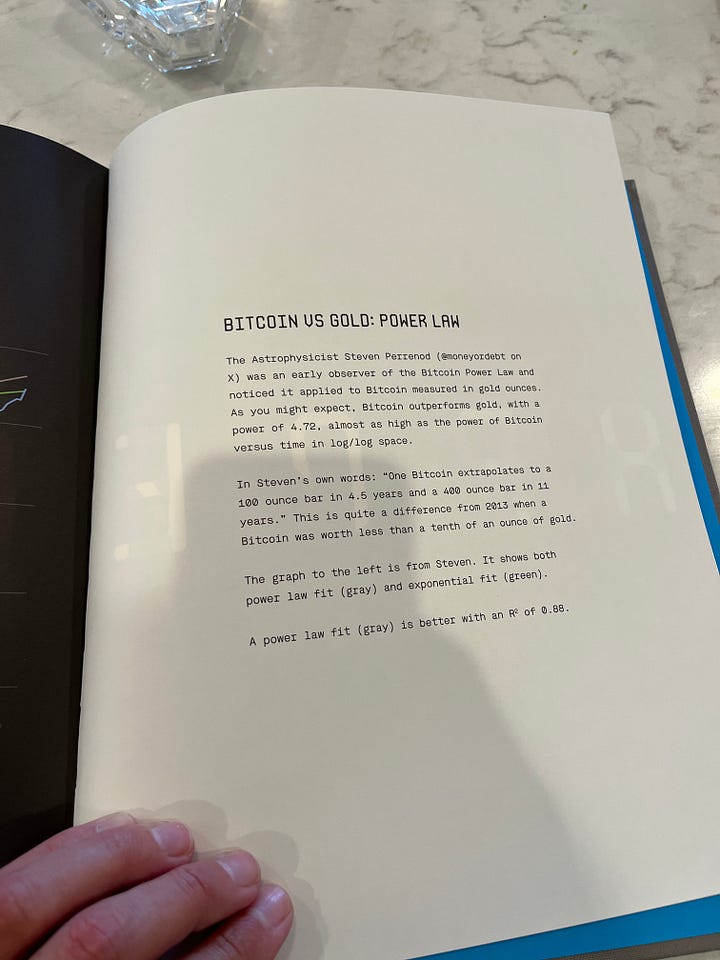
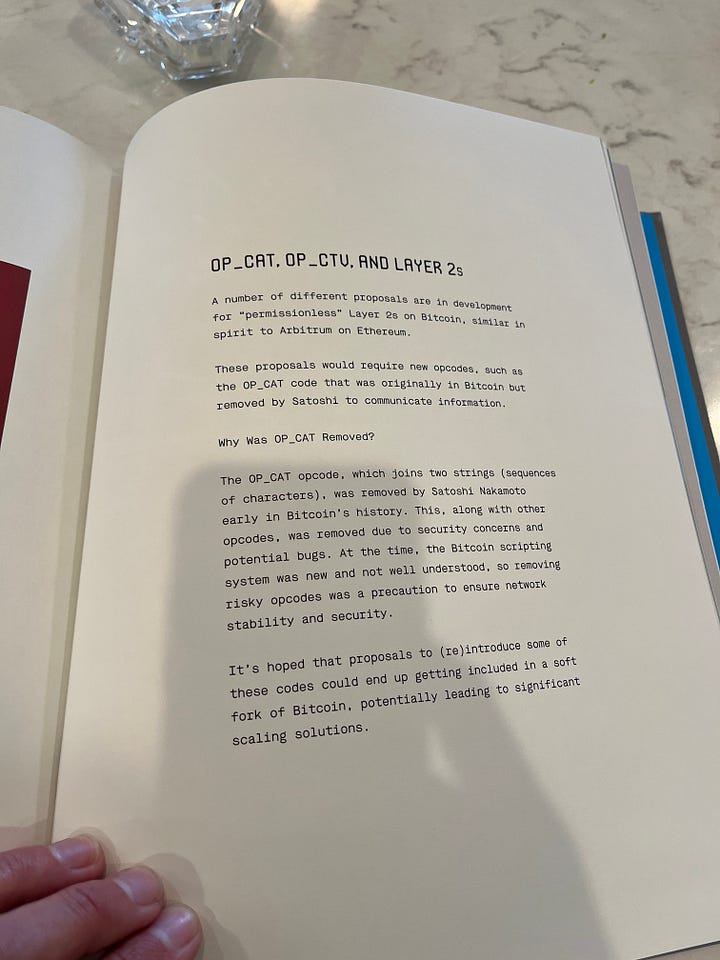
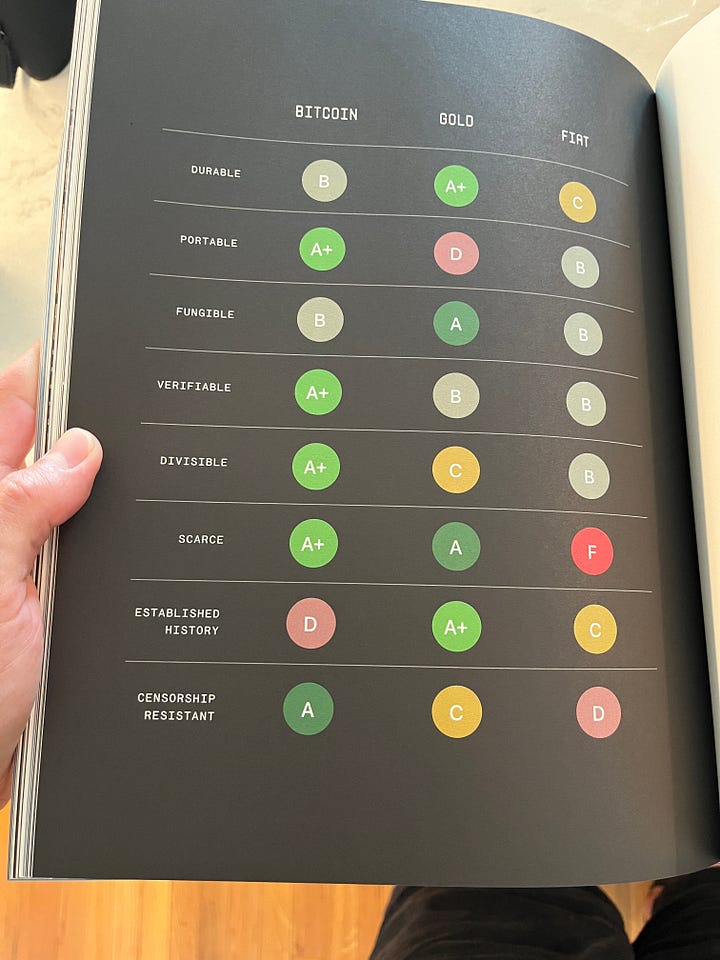
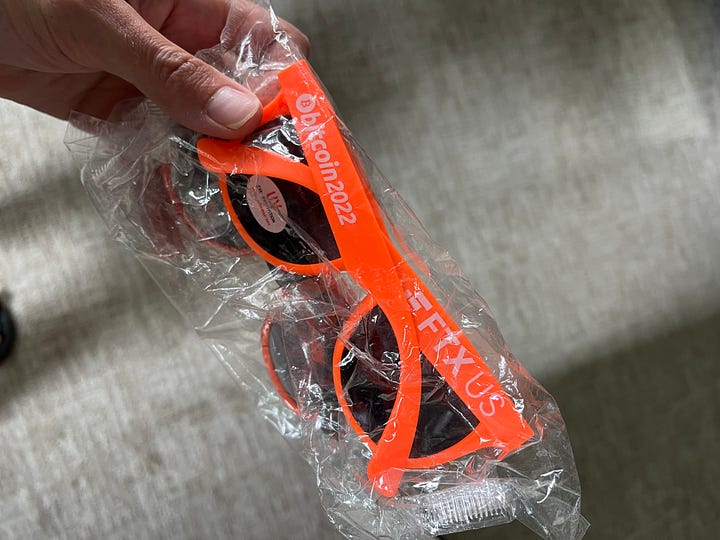
We headed upstairs to work on setting up Sparrow Wallet on their Windows machine. I verified the software download first (which you should always do), then helped them create a new wallet using their Ledger Flex. They also had an older Ledger Nano X. The Flex setup was easy, but the Nano X gave us trouble. It turns out Ledger allows multiple wallets for the same asset, which can show up differently depending on how they’re configured. In Sparrow, only one wallet showed—none of the others.
I believe it had to do with the derivation path from the Ledger. If anyone knows a fix, let me know.
After a few hours of troubleshooting, I told them I couldn’t really recommend Ledger. The UX is a mess. They’d already heard similar things from other plebs too.
I suggested switching to the Blockstream Jade. It’s a solid Bitcoin-only device from a trustworthy team. That’s what you want in a hardware wallet.
But back to the lens…
Since it’s an LTM (Leica Thread Mount), I couldn’t mount it directly on my M262. Luckily, I remembered I had an Urth adapter that fits my Fujifilm X-Pro2. I don’t use the X-Pro2 much these days—it’s mostly been sidelined by the M262 - but this was the perfect excuse to bring it out again.
To test the lens, I shot everything wide open at f/2.8. Nothing crazy fast, but it’s the best way to see a lens’s character. And this one definitely has character. There’s a subtle softness and a kind of motion blur effect around the edges when wide open. At first, I wasn’t sure how I felt about it, but the more I shot, the more I liked it. It reminds me of Winogrand’s work in Winogrand Color - those messy, shifting edges that make the frame feel alive. It also helps soften the digital-ness of the camera sensor.
The focus throw is short and snappy - much tighter than my Summicron V3 35mm f/2. I really like how fast it is to use. The closest focusing distance is about 3.5 feet, so it’s not ideal for close-ups. And with the Urth adapter on the X-Pro2, the focal length ends up closer to 40mm.
The only thing that threw me off was the infinity lock. When the focus hits infinity, it physically locks - you have to press a small tab to unlock it. I’ve seen others complain about it, so I guess it’s just one of those old lens quirks. I’m getting used to it.
All the photos here were taken around where I live in South Carolina. Some during bike rides to the river for a swim, others while walking through the marshlands.
I try to make work wherever I am. You should be able to.
It’s about the light, the rhythm, the play - and having the motivation to actually go out and shoot.
Lens rating: 7.9/10
I mainly shoot with a Leica M262, and edit in Lightroom + Dehancer
Use “PictureRoom” for 10% off Dehancer Film
If you’ve made it this far, thank you for taking the time to view my work - consider becoming a paid subscriber.
Also, please contact me if you would like to purchase any of my prints.
Follow me on Nostr:
npub1c8n9qhqzm2x3kzjm84kmdcvm96ezmn257r5xxphv3gsnjq4nz4lqelne96
-
 @ 005bc4de:ef11e1a2
2025-05-28 16:24:41
@ 005bc4de:ef11e1a2
2025-05-28 16:24:41
Two days ago I put this out: https://peakd.com/hive-124838/@crrdlx/hostr-snaps-9i13ooa7ufp
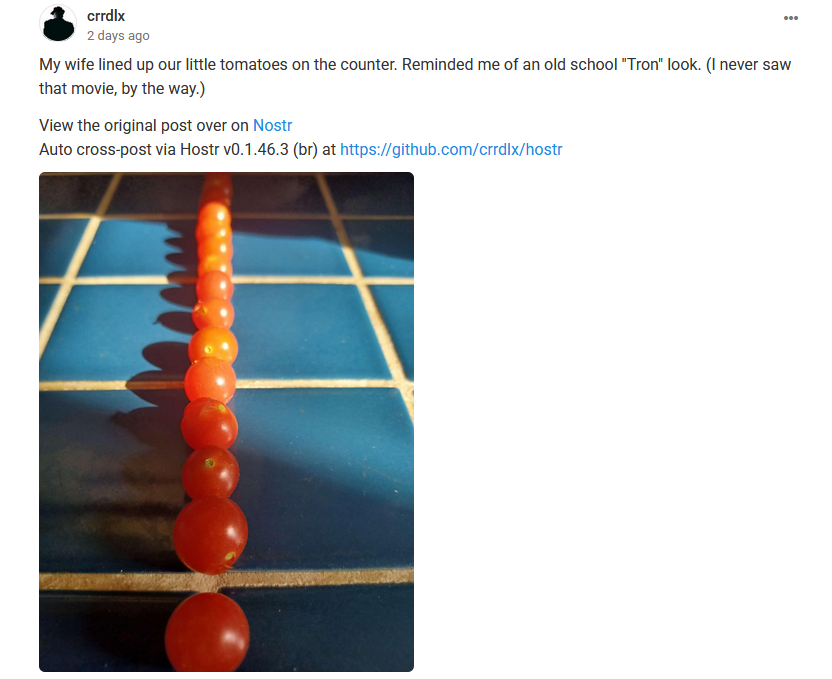 Post: https://peakd.com/hive-124838/@crrdlx/hostr-snaps-9i13ooa7ufp
Post: https://peakd.com/hive-124838/@crrdlx/hostr-snaps-9i13ooa7ufpOne of the comments said it "...looks like some sort of game as well." That was enough to tickle my curiosity and get me thinking. The round tomatoes and how they nestled into the grooves of the tiles reminded me of Chinese checkers. The grid brought Hex to mind (the game John Nash played) and I wondered if a square-grid version might be viable. A little searching revealed Hex is a "Connection game" and there are several. The one called Tak seemed really interesting and simple. I like interesting and I really like simple.
So, a square grid connection game wouldn't be new, however, you can't play Tak with tomatoes. Tak requires stacking "stones" or standing them on edge, that would be very, very tricky with tomatoes.
I looked around and happened to have some dried corn kernels and dry beans. I drew out a 5 x 5 grid of dots, lined up five corn kernels on one side in a "home row" and 5 beans on the other. We used to play a game where two sides of Army men met after a series of moves. In that game, we rolled dice to have a "combat" and see who would win the little battle. I wanted something like that in my game, some type of combat or conquest, somehow. So, I started messing around, moving kernels and beans, and totally just set out to make this game up on the fly. This is what I got...
Rules
The objective, like Hex or Tak, is to connect one side (your home row) to your opponent's side. The connection to the other side can be a straight line, or it CAN include a diagonal road. Any of the roads below would be a win for team bean (B).
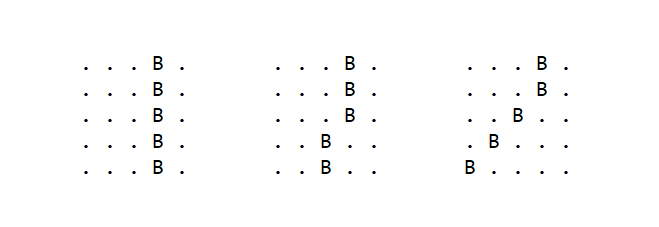
- One side makes a move by sliding one corn/bean one spot forward.
- Then, take turns making moves.
- Movement can only be one spot forward/back or sideways (NSEW). You cannot move diagonally.
- Opponents CAN occupy, or "squat", on the same spot at once. If so, the spot is being "co-squatted" (they're like two people standing in the same sidewalk tile at the same time).
- However, while opponents occupy the same spot, a "combat" might ensue. A corn/bean can "attack" by moving yet another adjoining corn or bean onto the co-squatted spot. A conquest is made by outnumbering a spot 2-to-1. For instance, if a spot is being occupied by both a bean and corn, and then a second corn moves in, the two corns conquer the one bean. The bean is immediately removed. The bean player then places that conquered bean into any empty spot on his or her home row. That placement constitutes the bean player's turn. So, after the bean is placed on the home row, the corn player makes the next move.
- Play continues until someone completes a road from their home row across to their opponent's home row. (Again, a diagonal road is okay for the win.)
- The losing player got Succotashed.
Game name
As to the name, initially I wanted a tomato-ish name. But, I was using corn and beans. So, I'm naming this game "Succotash" after the corn, bean, and vegetable recipe. I considered calling it the "Texas Caviar Game" because it has tomatoes in it, but playing Succotash just sounds better. Plus, putting tomatoes in succotash sounds yummy.
Simple
A big goal here was to keep it simple. To that end, all that's needed is (a) a paper with a 5 x 5 grid drawn on it, and, (b) 5 pieces of something and 5 pieces of something else. Obviously I used corn kernels and beans, but it could easily be shells/legos, pennies/paperclips, nuts/stones, or whatever.
Initially, I had a "storehouse" of extra corn kernels and storehouse of extra beans (seen in the images). My thinking was that they would replace the corn or beans that get conquered by opponents. Upon playing the game, it was apparent that a storehouse is totally unnecessary. Once captured, the same corn/bean can just be the one that's placed back onto the home row. Five of each is fine.
Also, I'm sure the grid could easily be expanded to whatever size you wish. I played an opponent with the 5 x 5 grid, and that seemed a good size for a five minute or so game.
Why not sit down face-to-face with someone for a minute and give Succotash a try? If you do, I'd love to hear how it went.

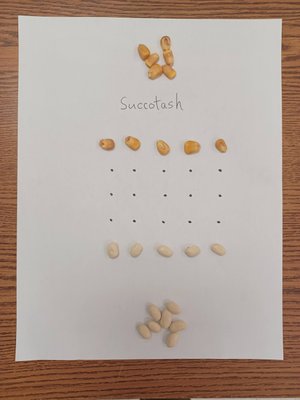
-
 @ 99e7936f:d5d2197c
2025-05-28 14:55:40
@ 99e7936f:d5d2197c
2025-05-28 14:55:40“Dieser Beitrag wurde mit dem Pareto-Client geschrieben.”
Wo bleibt die Rettung?
Wenn man bei einem Notfall auf den Rettungswagen wartet, dann fühlen sich Minuten wie Stunden an. Die Nerven sind bis zum Anschlag gespannt, alle Sinne sind geschärft.
Die Natur hat das so eingerichtet, damit man aufmerksam und gut geschützt ist vor weiteren Verletzungen.
Bei Trauma ist das auch so, nur dass dieser Zustand gefühlt ein halbes Leben andauert. Das klingt brutal, ist aber in etwa so. Da ein menschlicher Körper das nicht gut aushalten kann, sendet er dem Gehirn die Information: “ Bitte mach etwas zur Entlastung, ich kann mit dem Dauerstress nicht gut umgehen. Ich habe ständig das Gefühl, dass etwas Schlimmes passiert und ich mich verteidigen muss.“ Das Gehirn überlegt sich dann eine Lösung, um auch selber endlich wieder Ruhe zu haben. In der Regel wird der traumatische Inhalt verdrängt, vergessen, abgewandelt, abgeschwächt oder als Schwarz-Weiß-Film wieder gegeben, also ohne Gefühl (re)präsentiert. Man kann dann von den traumatischen Erlebnissen erzählen, ohne ein einziges Gefühl zu haben. Das wirkt souverän, als habe man das Trauma verarbeitet, das Gegenteil ist der Fall. Manche Menschen reden sogar über Gefühle, empfinden diese aber nicht. Gefühle werden imitiert oder inszeniert. Wenn man selber fühlen kann, spürt man diesen feinen Unterschied als Zuhörer sofort. Jedenfalls ist alles das Traumafolge bzw. die Lösung, die uns das Gehirn nach Trauma anbietet. Entweder ist der ganze Inhalt samt Emotion weg, oder der Inhalt ist noch da, aber die Emotion dazu fehlt. Es gibt Menschen, die so tief traumatisiert sind, dass sie eine ganz andere Geschichte von sich selbst erzählen, als die, die eigentlich stattgefunden hat. Ich weiß, dass das gruselig klingt. Aber das ist eine Realität. Und es ist vermutlich gut so. Die Natur macht alles, um ein Menschenleben zu retten, und wenn es um den Preis des psychologischen Vergessens ist. Manche Erinnerungen sind offensichtlich nicht mit dem Leben vereinbar, deswegen werden sie für immer abgespalten. Mittlerweile habe ich persönlich viel Respekt vor Menschen, die sich an nichts mehr „erinnern“ können, da ich gelernt habe, dass sie am schlimmsten traumatisiert sind. Diese Einstellung hatte ich nicht immer.
Jedenfalls verhält es sich nach meiner Beobachtung und auch nach meinen eigenen Erfahrungen so, dass man sich ganz oft erst dann vollständig UND in Farbe an traumatische Erlebnisse erinnert, wenn die Zeit dafür reif ist. Man könnte auch sagen, wenn die Seele bereit ist, die verlorenen Seelenanteile wieder zuzulassen. Sie sind nie weg, denn eine unsichtbare Schnur verbindet uns immer mit dem, was passiert ist. Also, wenn dieser Moment, in dem Du Deine Seelenanteile wieder begrüßen darfst, kommt, dann ist das wie ein riesiges Geschenk, auch wenn sich das zu Beginn nicht so anfühlt. Es fühlt sich dann eher so an, wie wenn man auf den Rettungswagen wartet, aber es ist definitiv ein Geschenk, genau wie eine Geburt ein Geschenk ist. Und eine Geburt ist ja auch nicht immer leicht.
Also, je mehr Gefühl beim Erinnern von traumatischen Inhalten spürbar ist, desto besser kann Traumabearbeitung gelingen. (Heiße den Schmerz willkommen, wenn er in Dein Leben kommt.) Ich persönlich hatte lange Wehen, bevor mein Trauma dann schlagartig aktiviert wurde. Das war, bildlich gesprochen, eine Hausgeburt, die ich allein vollbracht habe, weil der Rettungswagen dermaßen Verspätung hatte. Aber das Kind hat sich dennoch gut entwickelt. Ich habe zuvor lange von meinem Trauma „nur“ geredet. Ich habe rationalisiert, wie man in der Fachsprache sagt. Mir war meine frühe Verletzung bewusst, aber ich hatte kein Gefühl zu dem, was ich erlebt hatte. Als das Gefühl da war, verstand ich, dass es sinnvoll war, es solange nicht gefühlt haben zu können, denn es war ein überwältigender Schmerz. Die Natur macht instinktiv ein gutes Timing für die Wiederkehr des Gefühls. Sie sucht sich eine Zeit im Leben aus, wo man einen guten Stand hat, stabil ist, eine Umgebung hat, die einen zumindest für eine Weile halten und auffangen kann. Denn die Natur möchte schließlich, dass man auch die Wiederkehr des Gefühls überlebt.
Genauso schmerzhaft wie der Verlust des Gefühls war, genauso schmerzhaft ist seine Wiederkehr.
Der Schmerz ist quasi der Erste und der Letzte. Er macht das Licht aus, und später macht er das Licht oder den Farbfilm wieder an. Der Schmerz ist viel besser als sein Ruf.
Ich erzähle hier lediglich meine Erfahrungen und Beobachtungen, auch wenn ich allgemein formuliere. Das kann sich bei anderen Menschen auch anders verhalten. Aber ich finde den Erfahrungsaustausch über dieses Thema wichtig, WEIL es unterschiedlich sein kann und jeder auf einem anderen Level von Traumabearbeitung steht. Ein Problem bei Traumabearbeitung ist, dass jeder ein anderes Trauma erlebt hat, dass jeder einen anderen Nährboden hatte, auf den das Trauma fiel, und dass es verschiedene Stadien gibt, bis es dann endlich und hoffentlich soweit ist, dass das Trauma wieder vollständig in die eigene Psyche integriert werden kann und man wieder „ganz“ bzw. „neu und etwas anders“ ist. Und meine Erfahrung ist, dass man auf das Tempo dieses Prozesses leider keinen Einfluss hat, auch wenn es hierzu, wie ich finde, viele falsche Verkehrsdurchsagen gibt. Die Natur ist da verschlossen wie eine Auster, sie lässt sich nicht ins Handwerk pfuschen. Als ich das verstand, hat sich mein Wunsch, Menschen zu helfen, schlagartig verändert. Ich verstand, dass ICH das nicht machen kann, dass die Natur das selber macht. Und das ist eine gute Nachricht, denn die Natur kann das am besten und ist ein super zuverlässiger Partner.
Wir brauchen keinen Rettungswagen. Der Schmerz ist die Rettung.
Das Thema „Trauma“ birgt so viel positiven Erkenntnisgewinn über das Wunder des Lebens.
Aber zurück zum Thema. Wenn man, so wie ich, ein halbes Leben in einem Schwarz-Weiß-Film verbracht hat, dann die Hausgeburt ohne Rettungswagen durchgestanden hat und das Kind irgendwann anfängt, neugierige Fragen zu stellen, dann ist man im Zugzwang. In dieser Situation bin ich heute. Deswegen schreibe ich. Mein neues ICH fragt mich immer öfter, warum ich so viele Dinge tue, die ich eigentlich gar nicht mehr tun will. Kinder fragen einen auch manchmal ganz unverblümt, ob man den Hansi denn lieb hat oder ob man gerne im Büro arbeitet. Wenn man den Hansi nicht lieb hat und nicht gerne im Büro arbeitet, dann muss man schlucken und eine kindgerechte Antwort formulieren. Genauso wenig wie Kinder als kompetenter 20-jähriger auf die Welt kommen, genau so wenig ist man nach geglückter Traumabearbeitung „geheilt“. Es wird nichts schlagartig besser. Das ist auch so eine falsche Verkehrsdurchsage. Man lebt ja noch im alten Leben, was nun Schritt für Schritt verändert werden darf. ABER man ist glückliche Mutter. Mutter sein, ist nicht immer leicht, habe ich mir sagen lassen. Mütter lieben ihre Kinder. Im Idealfall machen sie sich keine Gedanken darüber, was aus ihrem Kind mal werden soll. Sie vertrauen einfach darauf, DASS aus ihrem Kind ein glücklicher Mensch wird und buttern deshalb so viel Liebe in das Kind hinein, wie in den wenigen Jahren, die das Kind ein Kind ist, möglich ist. So ähnlich geht es mir heute auch. Ich bin stolz auf mein neues ICH und lobe es, so oft ich kann. Jede Mutter lobt ihre Butter. Das ist wichtig, denn das Leben bietet ständig Herausforderungen, an denen man bekanntlich wachsen darf. Ich gehe jeden Tag mit meinem „Kind“ spazieren, und wir sehen viel. Wir sehen andere Menschen mit Trauma, wir hören zu, welches Trauma der andere erlebt hat und auf welchem Level er ist. Wir hören das Gefühl heraus, welches mitschwingt. Wir sehen Menschen in ihrem Schwarz-Weiß-Film. Und wir sehen Menschen, die scheinbar mit jeder Situation souverän umgehen können. Am meisten interessieren „uns“ zur Zeit solche Menschen, die ehrlich zugeben, dass sie Wehen haben, dass der Schmerz sich in immer kürzeren Abständen meldet. (Die verlorenen Seelenanteile ziehen an der unsichtbaren Schnur.) Mit diesen Leuten kann ich im Moment am besten. Das hört sich komisch an. Aber ich will damit zum Ausdruck bringen, dass ich mit diesen Menschen mittlerweile am meisten resoniere. Sie sprechen meine Sprache. Sie empfinden Gefühle, und sprechen über diese. Das ist für mich die schönste Sprache.
Wer in diesen Tagen wahrhaftig Schmerz empfindet, und nicht nur als Lippenbekenntnis, sondern echten üblen Schmerz über die enttäuschte Liebe oder über die Verhältnisse in dieser Welt, der ist mir sympathisch, der ist mir nah. Denn ich weiß, dass so ein fühlender Mensch auch bald eine Niederkunft erleben wird, die ihn verändert, die ihn anders auf diese Welt schauen lässt.
Der Schmerz bringt uns die Verwandlung. Der Schmerz bringt die verlorenen Seelenanteile zurück. Der Schmerz ist der Hüter des Lebens. Der Schmerz bringt Dir Deine volle Sensibilität für andere Menschen zurück. Alles, was Du bei Dir nicht fühlen kannst, kannst Du bei anderen nicht fühlen. Der Schmerz beendet das. Er macht das Licht an und gibt dem Film wieder Farbe.
Heiße den Schmerz willkommen, wenn er in Dein Leben kommt. Tu das, nicht etwa weil Du gern leidest, nein tu das, weil Du Dich liebst, weil Du bewusst darauf achten möchtest, was Dir wirklich gut tut und Freude macht. Ein Mensch oder ein Job, der Dir Schmerz bereitet, den gilt es loszulassen. Und wenn Du Schmerz im Gesicht Deines Gegenübers siehst, dann frage Dich ehrlich, was Dein Anteil daran ist, dass der andere leidet. Wir sind nicht für jedes Leid auf dieser Welt verantwortlich, das möchte ich hier auch betonen. Und die Schuld-Nummer zieht bei mir schon lange nicht mehr. Aber ich nehme immer besser wahr, wenn mein eigenes Verhalten nicht angemessen, nicht authentisch ist, von überholten Glaubensmustern geprägt ist. Ich kann das erkennen und korrigieren. Ich kann das heute selber erkennen, weil der Schmerz mich das gelehrt hat, mich geöffnet hat. Der Schmerz lehrt uns ganz viel. Der Schmerz ist der Hüter des Lebens. Er trifft einen hart, macht aber weich.
Heiße den Schmerz willkommen, denn er ist die Rettung.
“Dieser Beitrag wurde mit dem Pareto-Client geschrieben.”
Onboarding bei Nostr: Nostr
Easy onboarding via **Start.**\ \ Das Pareto-Team baut den “Marktplatz der Ideen” und hat dabei schon viel erreicht. \ team@pareto.space \ https://pareto.space \ https://geyser.fund/project/pareto?hero=1c1b8e487090
\ \ Newsletter per Mail (Die Friedenstaube)\ hier abonnieren\ \ In Telegram lesen -> hier unsere Kanäle\ https://t.me/pareto_artikel \ https://t.me/friedenstaube_artikel \ \ Als Feed in einem Feed-Reader \ https://pareto.space/atom/feed.xml \ https://pareto.space/atom/de_feed.xml \ https://pareto.space/atom/en_feed.xml
-
 @ 8d34bd24:414be32b
2025-05-28 13:53:46
@ 8d34bd24:414be32b
2025-05-28 13:53:46These days it can feel like the whole world is out of control. Government officials lie and break the law. People are selfish, act emotionally rather than logically, and push ideologies that are illogical and contrary to reality. Society is divided into groups and people are judged, not for their own character, but based on which group they are placed into. There are wars and rumors of wars. There are worries of pandemics and economic disasters. Depression, psychosis, and despair is rampant even among the youngest among us.
Hope For Believers
As much as things seem to be out of control, they are not out of God’s control. This is what the Bible predicted. No matter how bad things get in the world, those who have put their faith in Jesus, do not need to feel despair.
Why are you in despair, O my soul?\ And why have you become disturbed within me?\ Hope in God, for I shall again praise Him\ For the help of His presence.\ O my God, my soul is in despair within me;\ Therefore I remember You from the land of the Jordan\ And the peaks of Hermon, from Mount Mizar. (Psalm 42:5-6)
When we start to feel despair overcoming us, we need to remember what God has done and what He has promised. We need to praise God for what He has done, what He has promised, and what He will bring to completion. Things may be hard now, but God is still in control, and we know how the story will end. God triumphs. Good is rewarded. Evil is destroyed. We can stand on the foundation of hope because we know the ending. Even though things may be out of our personal control, they are always under God’s control.
The more fiercely the storm rages, the more we need to rest in Jesus and the more we need to put our hope in Him.
O love the Lord, all you His godly ones!\ The Lord preserves the faithful\ And fully recompenses the proud doer.\ **Be strong and let your heart take courage,\ All you who hope in the Lord. (Psalm 31:23-24) {emphasis mine}
We can take courage because God always acts for our long term good. Every hardship we experience here on earth will be recognized as a blessing that grew our faith and prepared us for heaven and God’s presence in eternity.
For I know the plans that I have for you,’ declares the Lord, ‘plans for welfare and not for calamity to give you a future and a hope. (Jeremiah 29:11)
Even the worst things that happen to us, due to the sins of others, have a good purpose in our lives. God is working good through us. Our hope isn’t an empty hope. It isn’t a “I really hope this happens.” It is a “I can hope in the guaranteed promises of God.”
For we do not want you to be unaware, brethren, of our affliction which came to us in Asia, that we were burdened excessively, beyond our strength, so that we despaired even of life; indeed, we had the sentence of death within ourselves so that we would not trust in ourselves, but in God who raises the dead; who delivered us from so great a peril of death, and will deliver us, He on whom we have set our hope. And He will yet deliver us, (2 Corinthians 1:8-10) {emphasis mine}
We may experience situations so bad that they seem hopeless, but with God, nothing is hopeless. The God who raises the dead can raise us out of any situation. The God who spoke the universe into existence can deliver us by a word.
The God of the Bible knows all and loves us completely. He looks at our situation through the lens of eternity. What seems best in the moment is not necessarily what is best for our eternity. Many times He delivers us through hardship rather than out of it. We just need to trust Him and put our hope in Him because He is good.
In the same way God, desiring even more to show to the heirs of the promise the unchangeableness of His purpose, interposed with an oath, so that by two unchangeable things in which it is impossible for God to lie, we who have taken refuge would have strong encouragement to take hold of the hope set before us. This hope we have as an anchor of the soul, a hope both sure and steadfast and one which enters within the veil, where Jesus has entered as a forerunner for us, having become a high priest forever according to the order of Melchizedek. (Hebrews 6:17-20) {emphasis mine}
Read that statement again. “This hope we have as an anchor of the soul, a hope both sure and steadfast.” Are you trusting Jesus as the “anchor of your soul?” Is your hope just a wish or is it a “sure and steadfast” hope based on the promises of God that you know will 100% come true?
And not only this, but we also exult in our tribulations, knowing that tribulation brings about perseverance; and perseverance, proven character; and proven character, hope; and hope does not disappoint, because the love of God has been poured out within our hearts through the Holy Spirit who was given to us. (Romans 5:3-5)
Isn’t it ironic that we need hope to persevere through tribulations, but that persevering through tribulation gives us character and hope? Our faith, trust, and hope grow through hardship. When things are easy, we almost always fall back on trusting in our own power rather than relying on God’s power. If we have put our faith in Jesus, there is no situation in which we should lose hope.
Now may the God of hope fill you with all joy and peace in believing, so that you will abound in hope by the power of the Holy Spirit. (Romans 15:13)
Is your joy and peace based on your circumstances or have you learned to have hope in God so you can experience joy and peace even in the trials?
Many people equate joy and happiness, but I think there is a key distinction. Happiness is a pleasant feeling that comes from pleasant circumstances. Joy is a similar feeling to happiness, but it comes from knowing God and His love. It is not tied to circumstances. When we have truly put our hope in God we can still have joy in and despite the most horrific circumstances.
Blessed be the God and Father of our Lord Jesus Christ, who according to His great mercy has caused us to be born again to a living hope through the resurrection of Jesus Christ from the dead, to obtain an inheritance which is imperishable and undefiled and will not fade away, reserved in heaven for you, (1 Peter 1:3-4) {emphasis mine}
Just as Jesus told the Samaritan woman at the well that He provides living water that wells up inside, so that she need never thirst, in the same way believers have a living hope that wells up in times of need. Our hope is in the Creator of the universe and Savior of the world. No problem is too big for Him. No situation is a surprise to Him. No enemy is too powerful for Him. All of our problems are already solved. We just haven’t necessarily seen the solution yet.
My soul, wait in silence for God only,\ For my hope is from Him.\ He only is my rock and my salvation,\ My stronghold; I shall not be shaken.\ On God my salvation and my glory rest;\ The rock of my strength, my refuge is in God. (Psalm 62:5-7)
Despair For Unbelievers
Although believers never have reason to despair, the same is not true for those who have rejected the Savior, Jesus Christ. In these perilous times, they have a real reason for dread and despair.
Moreover, the Lord will scatter you among all peoples, from one end of the earth to the other end of the earth; and there you shall serve other gods, wood and stone, which you or your fathers have not known. Among those nations you shall find no rest, and there will be no resting place for the sole of your foot; but there the Lord will give you a trembling heart, failing of eyes, and despair of soul. So your life shall hang in doubt before you; and you will be in dread night and day, and shall have no assurance of your life. (Deuteronomy 64-66)
Those who reject the atoning sacrifice of Jesus do not get His protection. They do not get His help. They cannot rest in hope in Him.
Of course, the good news is that they can chose to turn their hearts to Him, confess their sins, and trust in Him up until their moment of death. Sadly many will continue to put off faith until it is too late. Many will choose evil over good and license over submission until God gives them over to their lusts.
And just as they did not see fit to acknowledge God any longer, God gave them over to a depraved mind, to do those things which are not proper, being filled with all unrighteousness, wickedness, greed, evil; full of envy, murder, strife, deceit, malice; they are gossips, slanderers, haters of God, insolent, arrogant, boastful, inventors of evil, disobedient to parents, without understanding, untrustworthy, unloving, unmerciful; and although they know the ordinance of God, that those who practice such things are worthy of death, they not only do the same, but also give hearty approval to those who practice them. (Romans 1:28-32)
If any of you have not yet put your trust in Jesus as Savior and Lord, do not wait. Turn away from evil. Submit to the will of Jesus. Trust Him to take away your sins and cover you with His righteousness.
If any of you know people who are in despair, share the gospel with them. Tell them about the greatness of God. Show them the hope that is within you.
Can Believers Despair?
Are there believers who despair? Yes. Should believers ever despair? Definitely not!
But we have this treasure in earthen vessels, so that the surpassing greatness of the power will be of God and not from ourselves; we are afflicted in every way, but not crushed; perplexed, but not despairing; persecuted, but not forsaken; struck down, but not destroyed; always carrying about in the body the dying of Jesus, so that the life of Jesus also may be manifested in our body. (2 Corinthians 4:7-10)
Jesus is always with believers in all situations guiding and protecting us. Those difficult situations that happen are for our good, even when we can’t see how it could be for good.
Job had more reasons to despair than almost anyone, yet he trusted in God. He didn’t know why he was being put through such loss, but his loss increased his faith in God and was a great example to people throughout history. I also love this cry of his heart.
“Oh that my words were written!\ Oh that they were inscribed in a book!” (Job 19:23)
He may or may not have seen even the partial fulfillment of this cry, but His words are written in the book of Job, in the Holy Scriptures read by Jews and Christians throughout the world and throughout history. Job’s first response to loss was an example to us all. After losing all ten children and all of his wealth, this was his response.
Then Job arose and tore his robe and shaved his head, and he fell to the ground and worshiped. (Job 1:20)
Yes, it is true that he had moments of despair where he cursed his birth, but he then returned to God in faith and hope. After a brief rebuke from God, Job submitted to God’s will.
“Behold, I am insignificant; what can I reply to You?\ I lay my hand on my mouth.\ Once I have spoken, and I will not answer;\ Even twice, and I will add nothing more.” (Job 40:4-5)
After his second rebuke from God, he fully submitted.
Then Job answered the Lord and said,
“I know that You can do all things,\ And that no purpose of Yours can be thwarted.\ ‘Who is this that hides counsel without knowledge?’\ *Therefore I have declared that which I did not understand,\ Things too wonderful for me, which I did not know.\ ‘Hear, now, and I will speak;\ I will ask You, and You instruct me*.’\ I have heard of You by the hearing of the ear;\ But now my eye sees You;\ Therefore I retract,\ And I repent in dust and ashes**.” (Job 42:1-6) {emphasis mine}
Job admitted that he did not understand what God was doing, but that God was right; God was good; and God was Lord. Job was able to have hope knowing that God was in control and working for good.
In the case of Job, he was later blessed with more kids, more wealth, and more respect than he had in the beginning. We won’t all see our blessings here on earth, but all believers will receive blessings from their trials.
May our glorious Savior and God fill you with faith and hope in God, His goodness, His power, and His plan. May we all submit to His good will even when we do not understand and even when every part of our earthly body is crying, “stop!” May God fill you with knowledge of Him, faith in Him, and hope in Him.
Trust Jesus
-
 @ 812cff5a:5c40aeeb
2025-05-28 12:56:32
@ 812cff5a:5c40aeeb
2025-05-28 12:56:32NIP-01 — الشكل الأساسي للأحداث في نُستر
رقم التعريف (NIP): 01
العنوان: الشكل الأساسي للأحداث
الحالة: نهائي
المؤلف: fiatjaf
التاريخ: 2020-12-10
الملخص
هذا المستند يعرّف الشكل القياسي لأي "حدث" يتم تداوله ضمن شبكة نُستر (Nostr).
الهدف من هذا التنسيق هو ضمان إمكانية معالجة وتفسير الأحداث من قبل جميع العملاء والخوادم بطريقة موحّدة.
هيكل الحدث
كل حدث عبارة عن كائن يحتوي على الحقول التالية:
{ "id": <معرّف فريد>, "pubkey": <مفتاح عام للمرسل>, "created_at": <تاريخ الإنشاء كرقم UNIX timestamp>, "kind": <نوع الحدث>, "tags": [<قائمة من الوسوم>], "content": <المحتوى>, "sig": <التوقيع الرقمي> }
شرح الحقول
- id: سلسلة نصية تمثل SHA-256 لمحتوى الحدث.
- pubkey: المفتاح العام للمستخدم (عادةً 32 بايت بصيغة hex).
- created_at: الطابع الزمني للإنشاء (Unix timestamp).
- kind: رقم يحدد نوع الحدث (مثلاً: منشور، متابعة، إعادة نشر).
- tags: قائمة من الوسوم المرتبطة بالحدث (مثلاً: إشارة إلى مستخدم أو حدث).
- content: المحتوى الأساسي للحدث (نص أو بيانات).
- sig: التوقيع الرقمي الذي يثبت أن المرسل هو صاحب المحتوى.
كيفية توليد معرف الحدث
idيتم توليد المعرّف عبر أخذ تمثيل JSON للحدث (بدون الحقول
idوsig) ثم حساب التجزئة باستخدام SHA-256.
توقيع الحدث
يُوقّع المستخدم الحدث باستخدام مفتاحه الخاص.
هذا التوقيع الرقمي يسمح لأي شخص بالتحقق من صحة الحدث باستخدام المفتاح العام.
أنواع الأحداث (kind)
0: ملف التعريف (الاسم، الصورة، النبذة).1: منشور عام نصي.2: إعادة نشر.3: قائمة المتابَعين.4: رسالة مشفّرة خاصة.- أنواع أخرى يمكن إضافتها لاحقًا.
الوسوم (Tags)
الوسوم عبارة عن قوائم (arrays) داخل الحدث لتوفير معلومات إضافية.
مثال:["e", "<معرّف الحدث>"] ["p", "<مفتاح عام لمستخدم>"]"e"تشير إلى حدث."p"تشير إلى مستخدم.
الخلاصة
NIP-01 هو الأساس الهيكلي لتبادل الأحداث عبر نُستر.
من خلال اتباع هذا الشكل، يمكن لجميع التطبيقات والخوادم العمل معاً بسلاسة، وضمان أمن وموثوقية كل حدث. -
 @ 5f078e90:b2bacaa3
2025-05-28 12:00:23
@ 5f078e90:b2bacaa3
2025-05-28 12:00:23Sylvi the seahorse

In the coral haven of Azure Bay, a seahorse named Sylvi danced with the tides. Her tail curled around a swaying frond as she watched fish dart by. One dawn, a lost pearl rolled into her nook. Sylvi, curious, nudged it along the reef, meeting crabs and eels who shared tales of the deep. By dusk, she found its oyster home. The pearl gleamed thanks, and Sylvi twirled home, her heart light as foam.
Ignore this test. This was in bold originally.
(380 chars, plain text after Markdown stripping, this was in italics originally)
Originally written on habla.news (on Nostr)
-
 @ a29cfc65:484fac9c
2025-05-28 10:30:32
@ a29cfc65:484fac9c
2025-05-28 10:30:32Deutschland ist eines der wenigen Länder mit einer gesetzlich verankerten ausnahmslosen Schulbesuchspflicht. Mit den Schulschließungen in der Corona-Zeit wurde das Gesetz jedoch faktisch plötzlich außer Kraft gesetzt. Alle mussten zu Hause lernen. Als die Schulen danach wieder offen waren, wurden die Kinder mit Maskenpflicht, Tests und Impfdruck gequält. Nicht selten traten bei den Schülern Krankheiten und psychische Störungen auf. Nicht wenige Eltern suchten im Gespräch mit dem Lehrerkollegium nach Lösungen für ihre Kinder. In den meisten Fällen war das nicht möglich. Die Lehrer waren auf die neue Ideologie und die Durchsetzung der Maßnahmen eingeschworen und hatten Angst. Einige Eltern haben ihre Kinder dann in eigener Verantwortung aus der Schule genommen und zu Hause selbst unterrichtet. An manchen Orten fanden sich Gemeinschaften, wo die Kinder in Gruppen lernten. Während viele Lerngemeinschaften nicht mehr existieren, hat die Familie von Katharina den Unterricht für ihre drei Kinder in Eigenregie etabliert. Inzwischen haben sie dafür sogar „den Segen“ von Familiengericht und Jugendamt.
Katharina und Johannes leben mit ihren drei Wunschkindern Aurelius (15), Benjamin (14) und Friedrich (10) in einem Vorort von Leipzig. Die Familie wohnte früher in der Stadt. In der Corona-Zeit haben sie sich mit dem Physiotherapie- & Seminarzentrum Curasanus eine Existenz auf dem Land aufgebaut und begehen diesen Sommer ihr 20-jähriges Praxis-Jubiläum. Katharina hat ihre Arbeit als Physiotherapeutin weitgehend aufgegeben, um sich als Mama und Lernbegleiterin ihren Kindern widmen zu können. Daneben bietet sie Vorträge und Workshops an, übernimmt einen großen Teil der Praxis-Organisation und ist Manager, Rezeptionistin und Vertriebler der eigenen Firma. Wir besuchten einen ihrer Lachyoga-Kurse. Dabei erlebten wir ihr Zusammenspiel mit den drei Kindern. Anschließend stellten wir Katharina unsere Fragen zum Freilernen.
Im unmittelbaren Umfeld wird die Familie bestaunt und geachtet. Sie haben sich bewusst für das Freilernen entschieden. Die Kinder wurden ohne Test nicht mehr in die Schule gelassen. Auch andere Zwangsmaßnahmen wie die Maske wollten die Eltern den Kindern ersparen. Besonders Benjamin hatte traumatische Erlebnisse. Seine Lehrerin schmiss mit dem Schlüssel nach den Schülern und wandte andere schwarze Pädagogik an. Er ging ständig mit Bauchschmerzen ins Bett. Ein weiterer Punkt ist die Masernimpfung. Die Kinder könnten zwar zur Schule gehen, aber die Eltern werden mit rechtlichen Maßnahmen und Zwangszahlungen belegt. Da Katharina in ihrer Praxis viele Erkrankungen als Folge der Masernimpfung beobachten konnte, lehnt sie die Pflichtimpfung ab. Die Eltern haben kein Vertrauen mehr in die staatliche Schulerziehung mit all dem Zwang und den Erpressungen. Als die Familie den Entschluss gefasst hatte, die Kinder nicht mehr in die Schule zu schicken, haben sie ihre Praxis vorübergehend geschlossen, ihr Haus verkauft und sind auf Reisen gegangen. Die beiden großen Kinder wurden von der Schule abgemeldet. Nach der Rückkehr haben sie dann mit einem neuen Leben auf dem Land begonnen.
Lernen ohne Schule: Wie geht das?
„Wissen ist Macht und eine Holschuld“, sagt uns Katharina. Das ist ihr Motto und motiviert auch die Kinder. Mit dem Unterricht zu Hause macht die Familie ihre eigene Studie und zeigt, dass Lernen auch anders geht als in der Schule. Die Eltern können viel besser auf jedes einzelne Kind eingehen. Johannes arbeitete früher als Straßenbauer. Er unterstützt die Jungs vor allem in Mathematik, Geometrie und Physik sowie bei handwerklichen Fertigkeiten. Katharinas Stärken liegen in Deutsch, Sprachen und Organisation. Unter den Patienten ihrer Praxis gibt es Lehrer, die ihnen helfen. Weitere Unterstützung kommt von Freunden und Bekannten. Bei bestimmten Projekten treffen sie auf andere Freilernerkinder. „Das Netzwerk wird immer größer, es wird immer schöner und interessanter“, sagt Katharina. Man geht mit vielen anderen einen gemeinsamen Weg, verlässt dabei eingetretene Pfade und erkundet neue Themenfelder wie Mediengestaltung, freie Energie, Elektrotherapie, meditatives und Improvisations-Zeichnen. „Ich sprudele vor Ideen. Sie kommen in mein Feld, und dann mache ich was draus“, sagt Katharina. Die Jungs sind in Wurzen im Ringelnatz-Literaturkreis. Dort schreiben sie Drehbuchgeschichten und haben einen Film produziert. Sie suchen sich Projekte oder kreieren neue, wie mit dem Planetarium Eilenburg. Diese Zusammenarbeit hat sich sehr gut entwickelt. Dort lernen 4- bis 15-Jährige zusammen. Die drei Jungs spielen Klavier. Erdkunde und Geschichte erleben die Kinder auch dadurch, dass die Familie Hauptstädte oder die bosnischen Pyramiden selbst erkundet. Dabei erweist es sich als Vorteil, nicht auf die Ferienzeiten angewiesen zu sein.
Als Physiotherapeutin ist Katharina bewusst, dass man neue Lernstrategien entwickeln muss. Die Kinder lernen unterschiedlich. Jedes Kind hat seinen eigenen Charakter. Aurelius benötigt eher eine 1:1-Betreuung. Darauf kann Katharina viel individueller eingehen als die staatliche Schule. Es ist aber auch aufwendiger und anstrengender. Besonderen Wert legt sie darauf, dass rechte und linke Gehirnhälfte gleichmäßig beansprucht werden. Lernphasen werden immer wieder mit Entspannungs- oder Bewegungsphasen kombiniert. Sie weiß, dass den Kindern zuerst die Grundlagen des Lesens, Rechnens und Schreibens vermittelt werden müssen. Dann sind sie in der Lage, sich alles Weitere selbst anzueignen – Unterstützung vorausgesetzt. „Besonders das Schreiben mit der eigenen Hand ist wichtig für die Vernetzung der beiden Gehirnhälften“, sagt Katharina. Dafür nehmen sich die Eltern Zeit. Die Kinder führen Tagebuch. Außerdem halten es die Eltern für wichtig, den Kindern Werte und Tugenden wie Dankbarkeit, Verlässlichkeit, Beharrlichkeit, Aufrichtigkeit, Ehrlichkeit und die zehn Gebote zu vermitteln. Katharina und Johannes sind beide religiös begleitet aufgewachsen. Heute sehen sie die Kirche als Institution kritisch. Angebunden an die Schöpfung und im Gottvertrauen erschaffen und schöpfen sie Leben und Lebensraum aus eigener Kraft – so erklärt es uns Katharina.
Ein weiteres Thema sind die Funktionen des Körpers und wie sich die Kinder gesund erhalten können. Vieles lernen sie dabei in der Physiotherapiepraxis. Die Familie hat das Privileg, in ihrem eigenen Biorhythmus leben zu können. „Das macht sehr viel aus – wir sind alle gesund“, sagt Katharina. Der Lern- und Arbeitstag beginnt nicht vor 9 Uhr und hat eine eigene Struktur. Im Tagesablauf sind feste Verantwortlichkeiten integriert. So wechseln sich die Kinder aller drei Tage mit Tischdecken, Staubsaugen und Geschirrspüler ab. Das hilft ihnen, sich selbst zu organisieren. Das geht nicht immer reibungslos vonstatten. Wenn das Lernpensum beizeiten abgearbeitet wurde, helfen die Kinder im Haushalt oder Garten oder gehen ihrem Bewegungsdrang auf andere Weise nach. Die Eltern sind am Abend noch länger aktiv, denn die Praxis erfordert noch die eine oder andere bürokratische Pflicht. Die Familie ist sehr naturverbunden. Sie gehen viel in den Wald und in den Garten. Sie bauen selbst Gemüse und Obst an. Dabei können die Kinder zum Beispiel Erfahrungen mit Permakultur und natürlicher Düngung sammeln. Die Familie achtet auf die Ernährung, schließlich ist Katharina seit fast 25 Jahren Ernährungsberaterin. Was sie nicht selbst anbauen, wird beim Bauern des Vertrauens eingekauft. Die Jungs können selbst kochen und backen. Die Schädlichkeit von Zucker ist den Kindern schon bewusst geworden, ohne gänzlich auf Schokolade verzichten zu müssen. Medikamente gibt es im Haushalt nicht. Sie kennen sich sehr gut mit den Heilmitteln aus der Natur aus und können so ihre Selbstheilungskräfte aktivieren. Sie haben keinen Hausarzt. Natürlich hat keines der Kinder ein Handy. Bisher haben sie noch kein Verlangen danach. Die Eltern halten es für wichtig, dass die Kinder erst sicher bei Selbstorganisation und Tagesstruktur sind, bevor sie ein Handy bekommen. Katharina weist darauf hin, dass beispielsweise WhatsApp erst ab 16 Jahren zugelassen ist, und fragt sich, ob das andere Eltern wissen.
Gesetze auf Augenhöhe auslegen
Den Behörden blieben die Freilerner nicht verborgen. Sie wurden aktiv und schalteten das Familiengericht ein. Die Familie hatte keinen Anwalt und keine Rechtsschutzversicherung. Katharina erzählt uns, dass sie schließlich auf „Hilfe von oben“ gehofft habe. Irgendwer hat sie anscheinend erhört, denn sie bekamen „einen Engel“ als Verfahrensbeistand. Die Behörden waren sehr zugänglich. In den Gesprächen gab man zu, mit der Schulsituation ebenfalls nicht zufrieden zu sein. „Wir wollen so wie ihr, dass sich etwas verändert. Wir sind an Eurer Seite.“ Die Gespräche mit dem Jugendamt und der Richterin vom Familiengericht Grimma waren immer auf Augenhöhe. Schließlich legte man der Familie keine Steine in den Weg. Damit kann Katharina ihr Konzept nach außen leben und andere inspirieren. Ihre Schlussfolgerung: Eltern müssen sich ihrer Stärken bewusst werden und aus ihrer Angst herauskommen. Das Konzept muss aber zur Familie passen, denn jede Familie ist anders.
Die Basis für freies Lernen ist das Vertrauen der Eltern in ihre Kinder. Denn Kinder sind von Natur aus wissbegierig und wollen lernen. Katharina hat viel von Bertrand Stern und von Riccardo Leppe gelernt. Beiden wurde von ihren Eltern das Lernen ohne Schulbesuch ermöglicht. Mit Bertrand Stern hat Katharina Kontakt. Er wird im November am Buß- und Bettag eine kleine Fortbildung im Therapie- und Seminarzentrum geben. Für den Vorabend ist ein Vortrag geplant. Katharina zitiert Riccardo Leppe: „Es ändert sich nur was, wenn man es selbst tut.“ Er sei sich sicher, dass der Fortschritt beim Freilernen inzwischen so weit ist, dass „die Paste nicht wieder zurück in die Tube geht“.
Der Übergang zur Berufsausbildung
Die ersten Freilernerkinder kommen jetzt in das Alter, in dem sie eine Berufsausbildung beginnen können. Aurelius und Benjamin, die beiden „Großen“, machen seit Anfang des Jahres schon erste Praktika bei ortsansässigen Handwerksbetrieben. Beide Seiten sind sehr zufrieden. Durch die Praktika, die länger dauern als im schulischen Lehrplan vorgesehen, können sich die Kinder ausprobieren. Katharina findet es interessant miterleben zu dürfen, wie auf ihre Kinder reagiert wird. Bringen sie etwas mit, das die anderen nicht haben? Denken sie anders mit? Benjamin bekam schon ein Angebot, in einem Metallbau-Betrieb stundenweise mitzuarbeiten. In den Betrieben weiß man, dass die Abschlüsse der staatlichen Schulen größtenteils das Papier nicht wert sind, auf dem sie stehen. Viele verlassen die Schule und können kaum lesen und schreiben, von Selbstorganisation ganz zu schweigen. Ein Freilerner kann eine staatliche Externen-Prüfung ablegen, um einen Haupt- oder Realschulabschluss zu erwerben. Katharina: „Für eine Ausbildung bei einem privaten Unternehmer braucht man das nicht, allein der Unternehmer entscheidet über die Aufnahme des Auszubildenden“. Außerdem stehen den jungen Leuten Privatschulen oder der zweite Bildungsweg zur Verfügung. Wenn man einen praktischen Beruf ergreift, ist es immer noch möglich, sich bis zur Hochschulreife weiterzubilden. Nach mehrjährigen Tätigkeiten kann man bei den Kammern von Industrie, Handel und Handwerk (IHK und HWK) eine Abschlussprüfung ablegen, mit der man zum Studium zugelassen werden kann. Oder man geht gleich den Weg in die Selbstständigkeit.
Frei lernen weitergedacht
Während der Coronazeit haben sich in Sachsen und speziell um Leipzig herum kleine Freilernergruppen gefunden. Die Gruppen werden aktuell zusammengeführt, um zum Beispiel gemeinsam den Mathematikunterricht zu gestalten. Besonders um Dresden herum ist die Szene noch stärker ausgeprägt. Außerdem gibt es seit mehr als 20 Jahren den Bundesverband Natürlich Lernen (BVNL). Er bietet Beratung und zentrale Veranstaltungen an.
Der Wunsch nach dem freien Lernen ohne Schulzwang ist groß. Doch die meisten Eltern wollen ihre Kinder dafür irgendwo abgeben und nicht selbst unterrichten. Katharinas größter Wunsch ist es, drei bis fünf Elternpaare zu finden, die sich in die Betreuung und Unterrichtung ihrer Kinder teilen. Das größte Hindernis dafür sieht sie in den Eltern selbst. Durch ungelöste transgenerative Konflikte und unverarbeitete Familientraumata kommen sie noch nicht in ihre eigene Kraft für ein selbstbestimmtes Leben. Viele wagen es noch nicht, ihre Erwerbstätigkeit zugunsten der Kinder einzuschränken. Katharina sieht es als große Aufgabe für sich und ihre Familie, mit dem Freilernen das Gemeinschaftsbewusstsein und gute Konfliktlösungsstrategien zu entwickeln. Sie denkt dabei bereits an ihre Enkel. Aber sie weiß auch, dass die Eltern ein sehr hohes Maß an Eigeninitiative, Motivation und Selbstdisziplin aufbringen müssen. Sie würde Eltern, die sich das noch nicht zutrauen, als Traumabegleiterin zur Verfügung stehen, für einen angemessenen Energieausgleich. Diese gegenseitige Unterstützung käme Kindern und Eltern zugute. Ebenso hält sie die Idee der Mehrgenerationenerziehung für wichtig. Dabei profitieren nicht nur die Kinder. Die Erfahrungen der älteren Menschen gehen nicht verloren, sondern werden an die jüngeren Generationen weitergegeben und machen sie resilienter. Das hilft den Eltern, ihrer Erwerbsarbeit nachzugehen und Familientraumata zu bewältigen.
Katharina ist eine starke Frau und sprüht nur so vor Energie. Selbst als wir nach 21 Uhr das Therapiezentrum verlassen, sind ihr die Anstrengungen des Tages nicht anzumerken. Sie wird nicht müde beim Sprechen. Für Fragen zum Thema Freilernen kann man sich an sie wenden.
Der Text wurde zuerst am 27.05.2025 im Blog „Freie Akademie für Medien und Journalismus“ veröffentlicht (https://www.freie-medienakademie.de/medien-plus/lernen-neu-gemacht)
Bildquelle: Salah Darwish, unsplash.com
-
 @ 005bc4de:ef11e1a2
2025-05-28 09:05:10
@ 005bc4de:ef11e1a2
2025-05-28 09:05:10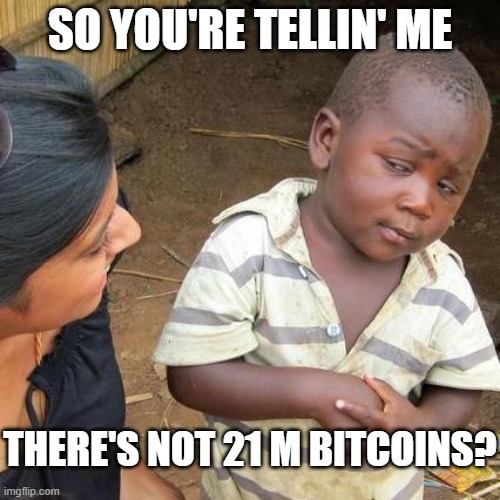
BIP-2,100,000,000,000,000,000
So, you're telling me...
- 21 million bitcoins is out, and...
- 2.1 quadrillion sats is in, except that...
- sats are out, so...
- 2.1 quadrillion bitcoins is in, except that...
- there are actually millisats, but...
- millisats are out, so...
- millibitcoins are in, so now...
- there are 2.1 quintillion millibitcoins, except that...
- millibitcoins are the basic base unit of bitcoin, so...
- millibitcoins are out, and now...
- 2.1 quintillion bitcoins are in

-
 @ 58537364:705b4b85
2025-05-28 08:25:55
@ 58537364:705b4b85
2025-05-28 08:25:55ถ้าอยากแล้วไม่หลง มันก็อยากด้วยปัญญา ความอยากอย่างนี้ท่านเรียกว่า เป็นบารมีของตน แต่ไม่ใช่ทุกคนนะที่มีปัญญา
บางคนไม่อยากจะให้มันอยาก เพราะเข้าใจว่า การมาปฏิบัติก็เพื่อระงับความอยาก ความจริงน่ะ ถ้าหากว่าไม่มีความอยาก ก็ไม่มีข้อปฏิบัติ ไม่รู้ว่าจะทำอะไร ลองพิจารณาดูก็ได้
ทุกคน แม้องค์พระพุทธเจ้าของเราก็ตาม ที่ท่านออกมาปฏิบัติ ก็เพื่อจะให้บรรเทากิเลสทั้งหลายนั้น
แต่ว่ามันต้องอยากทำ อยากปฏิบัติ อยากให้มันสงบ และก็ไม่อยากให้มันวุ่นวาย ทั้งสองอย่างนี้ มันเป็นอุปสรรคทั้งนั้น ถ้าเราไม่มีปัญญา ไม่มีความฉลาดในการกระทำอย่างนั้น เพราะว่ามันปนกันอยู่ อยากทั้งสองอย่างนี้มันมีราคาเท่า ๆ กัน
อยากจะพ้นทุกข์มันเป็นกิเลส สำหรับคนไม่มีปัญญา อยากด้วยความโง่ ไม่อยากมันก็เป็นกิเลส เพราะไม่อยากอันนั้นมันประกอบด้วยความโง่เหมือนกัน คือทั้งอยาก ไม่อยาก ปัญญาก็ไม่มี ทั้งสองอย่างนี้ มันเป็นกามสุขัลลิกานุโยโค กับอัตตกิลมถานุโยโค ซึ่งพระพุทธองค์ของเรา ขณะที่พระองค์กำลังทรงปฏิบัติอยู่นั้น ท่านก็หลงใหลในอย่างนี้ ไม่รู้ว่าจะทำอย่างไร ท่านหาอุบายหลายประการ กว่าจะพบของสองสิ่งนี้
ทุกวันนี้เราทั้งหลายก็เหมือนกัน ทุกสิ่งทั้งสองอย่างนี้มันกวนอยู่ เราจึงเข้าสู่ทางไม่ได้ก็เพราะอันนี้ ความเป็นจริงนี้ทุกคนที่มาปฏิบัติ ก็เป็นปุถุชนมาทั้งนั้น ปุถุชนก็เต็มไปด้วยความอยาก ความอยากที่ไม่มีปัญญา อยากด้วยความหลง ไม่อยากมันก็มีโทษเหมือนกัน “ไม่อยาก” มันก็เป็นตัณหา “อยาก” มันก็เป็นตัณหาอีกเหมือนกัน
ทีนี้ นักปฏิบัติยังไม่รู้เรื่องว่า จะเอายังไงกัน เดินไปข้างหน้าก็ไม่ถูก เดินกลับไปข้างหลังก็ไม่ถูก จะหยุดก็หยุดไม่ได้เพราะมันยังอยากอยู่ มันยังหลงอยู่ มีแต่ความอยาก แต่ปัญญาไม่มี มันอยากด้วยความหลง มันก็เป็นตัณหา ถึงแม้ไม่อยาก มันก็เป็นความหลง มันก็เป็นตัณหาเหมือนกันเพราะอะไร? เพราะมันขาดปัญญา
ความเป็นจริงนั้น ธรรมะมันอยู่ตรงนั้นแหละ ตรงความอยากกับความไม่อยากนั่นแหละ แต่เราไม่มีปัญญา ก็พยายามไม่ให้อยากบ้าง เดี๋ยวก็อยากบ้าง อยากให้เป็นอย่างนั้น ไม่อยากให้เป็นอย่างนี้ ความจริงทั้งสองอย่างนี้ หรือทั้งคู่นี้มันตัวเดียวกันทั้งนั้น ไม่ใช่คนละตัว แต่เราไม่รู้เรื่องของมัน
พระพุทธเจ้าของเรา และสาวกทั้งหลายของพระองค์นั้นท่านก็อยากเหมือนกัน แต่ “อยาก” ของท่านนั้น เป็นเพียงอาการของจิตเฉย ๆ หรือ “ไม่อยาก” ของท่าน ก็เป็นเพียงอาการของจิตเฉย ๆ อีกเหมือนกัน มันวูบเดียวเท่านั้น ก็หายไปแล้ว
ดังนั้น ความอยากหรือไม่อยากนี้ มันมีอยู่ตลอดเวลาแต่สำหรับผู้มีปัญญานั้น “อยาก” ก็ไม่มีอุปาทาน “ไม่อยาก” ก็ไม่มีอุปาทาน เป็น “สักแต่ว่า” อยากหรือไม่อยากเท่านั้น ถ้าพูดตามความจริงแล้ว มันก็เป็นแต่ "อาการของจิต" อาการของจิตมันเป็นของมันอย่างนั้นเอง ถ้าเรามาตะครุบมันอยู่ใกล้ ๆ นี่มันก็เห็นชัด
ดังนั้นจึงว่า การพิจารณานั้น ไม่ใช่รู้ไปที่อื่น มันรู้ตรงนี้แหละ เหมือนชาวประมงที่ออกไปทอดแหนั่นแหละ ทอดแหออกไปถูกปลาตัวใหญ่ เจ้าของผู้ทอดแหจะคิดอย่างไร? ก็กลัว กลัวปลาจะออกจากแหไปเสีย เมื่อเป็นเช่นนั้น ใจมันก็ดิ้นรนขึ้นระวังมาก บังคับมาก ตะครุบไปตะครุบมาอยู่นั่นแหละ ประเดี๋ยวปลามันก็ออกจากแหไปเสีย เพราะไปตะครุบมันแรงเกินไป
อย่างนั้นโบราณท่านพูดถึงเรื่องอันนี้ ท่านว่าค่อย ๆ ทำมัน แต่อย่าไปห่างจากมัน นี่คือปฏิปทาของเรา ค่อย ๆ คลำมันไปเรื่อย ๆ อย่างนั้นแหละ
อย่าปล่อยมัน หรือไม่อยากรู้มัน ต้องรู้ ต้องรู้เรื่องของมัน พยายามทำมันไปเรื่อย ๆ ให้เป็นปฏิปทา ขี้เกียจเราก็ทำไม่ขี้เกียจเราก็ทำ เรียกว่าการทำการปฏิบัติ ต้องทำไปเรื่อยๆอย่างนี้
ถ้าหากว่าเราขยัน ขยันเพราะความเชื่อ มันมีศรัทธาแต่ปัญญาไม่มี ถ้าเป็นอย่างนี้ ขยันไป ๆ แล้วมันก็ไม่เกิดผลอะไรขึ้นมากมาย ขยันไปนาน ๆ เข้า แต่มันไม่ถูกทาง มันก็ไม่สงบระงับ ทีนี้ก็จะเกิดความคิดว่า เรานี้บุญน้อยหรือวาสนาน้อย หรือคิดไปว่ามนุษย์ในโลกนี้คงทำไม่ได้หรอก แล้วก็เลยหยุดเลิกทำเลิกปฏิบัติ
ถ้าเกิดความคิดอย่างนี้เมื่อใด ขอให้ระวังให้มาก ให้มีขันติ ความอดทน ให้ทำไปเรื่อย ๆ เหมือนกับเราจับปลาตัวใหญ่ ก็ให้ค่อย ๆ คลำมันไปเรื่อย ๆ ปลามันก็จะไม่ดิ้นแรงค่อย ๆทำไปเรื่อย ๆ ไม่หยุด ไม่ช้าปลาก็จะหมดกำลัง มันก็จับง่าย จับให้ถนัดมือเลย ถ้าเรารีบจนเกินไป ปลามันก็จะหนีดิ้นออกจากแหเท่านั้น
ดังนั้น การปฏิบัตินี้ ถ้าเราพิจารณาตามพื้นเหตุของเรา เช่นว่า เราไม่มีความรู้ในปริยัติ ไม่มีความรู้ในอะไรอื่น ที่จะให้การปฏิบัติมันเกิดผลขึ้น ก็ดูความรู้ที่เป็นพื้นเพเดิมของเรานั่นแหละอันนั้นก็คือ “ธรรมชาติของจิต” นี่เอง มันมีของมันอยู่แล้ว เราจะไปเรียนรู้มัน มันก็มีอยู่ หรือเราจะไม่ไปเรียนรู้มัน มันก็มีอยู่
อย่างที่ท่านพูดว่า พระพุทธเจ้าจะบังเกิดขึ้นก็ตาม หรือไม่บังเกิดขึ้นก็ตาม ธรรมะก็คงมีอยู่อย่างนั้น มันเป็นของมันอยู่อย่างนั้น ไม่พลิกแพลงไปไหน มันเป็นสัจจธรรม
เราไม่เข้าใจสัจจธรรม ก็ไม่รู้ว่าสัจจธรรมเป็นอย่างไร นี้เรียกว่า การพิจารณาในความรู้ของผู้ปฏิบัติที่ไม่มีพื้นปริยัติ
ขอให้ดูจิต พยายามอ่านจิตของเจ้าของ พยายามพูดกับจิตของเจ้าของ มันจึงจะรู้เรื่องของจิต ค่อย ๆ ทำไป ถ้ายังไม่ถึงที่ของมัน มันก็ไปอยู่อย่างนั้น
ครูบาอาจารย์บางท่านบอกว่า ทำไปเรื่อย ๆ อย่าหยุด บางทีเรามาคิด “เออ ทำไปเรื่อย ๆ ถ้าไม่รู้เรื่องของมัน ถ้าทำไม่ถูกที่มัน มันจะรู้อะไร” อย่างนี้เป็นต้น ก็ต้องไปเรื่อย ๆ ก่อน แล้วมันก็จะเกิดความรู้สึกนึกคิดขึ้นในสิ่งที่เราพากเพียรทำนั้น
มันเหมือนกันกับบุรุษที่ไปสีไฟ ได้ฟังท่านบอกว่า เอาไม้ไผ่สองอันมาสีกันเข้าไปเถอะ แล้วจะมีไฟเกิดขึ้น บุรุษนั้นก็จับไม้ไผ่เข้าสองอัน สีกันเข้า แต่ใจร้อน สีไปได้หน่อย ก็อยากให้มันเป็นไฟ ใจก็เร่งอยู่เรื่อย ให้เป็นไฟเร็วๆ แต่ไฟก็ไม่เกิดสักที บุรุษนั้นก็เกิดความขี้เกียจ แล้วก็หยุดพัก แล้วจึงลองสีอีกนิด แล้วก็หยุดพัก ความร้อนที่พอมีอยู่บ้าง ก็หายไปล่ะซิ เพราะความร้อนมันไม่ติดต่อกัน
ถ้าทำไปเรื่อยๆอย่างนี้ เหนื่อยก็หยุด มีแต่เหนื่อยอย่างเดียวก็พอได้ แต่มีขี้เกียจปนเข้าด้วย เลยไปกันใหญ่ แล้วบุรุษนั้นก็หาว่าไฟไม่มี ไม่เอาไฟ ก็ทิ้ง เลิก ไม่สีอีก แล้วก็ไปเที่ยวประกาศว่า ไฟไม่มี ทำอย่างนี้ไม่ได้ ไม่มีไฟหรอก เขาได้ลองทำแล้ว
ก็จริงเหมือนกันที่ได้ทำแล้ว แต่ทำยังไม่ถึงจุดของมันคือความร้อนยังไม่สมดุลกัน ไฟมันก็เกิดขึ้นไม่ได้ ทั้งที่ความจริงไฟมันก็มีอยู่ อย่างนี้ก็เกิดความท้อแท้ขึ้นในใจของผู้ปฏิบัตินั้น ก็ละอันนี้ไปทำอันโน้นเรื่อยไป อันนี้ฉันใดก็ฉันนั้น
การปฏิบัตินั้น ปฏิบัติทางกายทางใจทั้งสองอย่าง มันต้องพร้อมกัน เพราะอะไร? เพราะพื้นเพมันเป็นคนมีกิเลสทั้งนั้น พระพุทธเจ้าก่อนที่จะเป็นพระพุทธเจ้า ท่านก็มีกิเลสแต่ท่านมีปัญญามากหลาย พระอรหันต์ก็เหมือนกัน เมื่อยังเป็นปุถุชนอยู่ ก็เหมือนกับเรา
เมื่อความอยากเกิดขึ้นมา เราก็ไม่รู้จัก เมื่อความไม่อยากเกิดขึ้นมา เราก็ไม่รู้จัก บางทีก็ร้อนใจ บางทีก็ดีใจ ถ้าใจเราไม่อยาก ก็ดีใจแบบหนึ่ง และวุ่นวายอีกแบบหนึ่ง ถ้าใจเราอยาก มันก็วุ่นวายอย่างหนึ่ง และดีใจอย่างหนึ่ง มันประสมประเสกันอยู่อย่างนี้
อันนี้คือปฏิปทาของผู้ปฏิบัติเรา
[อ่านใจธรรมชาติ] หลวงปู่ชา สุภัทโท หนังสือ หมวด: โพธิญาณ

-
 @ 21810ca8:f2e8341e
2025-05-28 08:10:53
@ 21810ca8:f2e8341e
2025-05-28 08:10:53Ich bin neu bei Nostr und versuche mich hier rein zu fuchsen. Kann das einer sehen? Und dann habe ich noch viele Fragen
Gibt es gute Marktplätze wie ebay oder ebay kleinanzeigen wo man stink normale dinge und kram von zuhause gegen sat verkaufen kann.
-
 @ 3770c235:16042bcc
2025-05-28 05:54:01
@ 3770c235:16042bcc
2025-05-28 05:54:01** Introduction: The Neon Pulse of Las Vegas
**It’s 2:30 AM on a Tuesday. The Strip hums with laughter, clinking glasses, and the occasional Elvis impersonator. A group of friends stumbles out of a nightclub, squinting under the glow of a Las Vegas billboard that screams, “Hungry? $5 Pancakes → 1 Block Right!” Ten minutes later, they’re drowning their late-night cravings in syrup.This isn’t luck—it’s Las Vegas billboards doing what they do best: working while the rest of the world sleeps. In a city where the party never stops, these glowing giants are the ultimate salespeople. Let’s dive into why Las Vegas billboards outshine traditional ads and how your business can ride their 24/7 energy wave.
** Why Las Vegas Billboards Never Take a Coffee Break
** 1. Tourists Don’t Have Bedtimes (and Neither Do Billboards)
- 42 million visitors flock to Vegas yearly. They’re sipping margaritas at noon, gambling at midnight, and shopping at 3 AM.
- Las Vegas billboards near hotspots like the Bellagio Fountains or Fremont Street catch eyes round the clock.Real Story:
A donut shop owner named Luis rented a billboard near the “Welcome to Vegas” sign. His message? “Jet Lagged? Sugar Fix Open 24/7!” Sales tripled—especially between 1 AM and 4 AM.** 2. You Can’t “Skip” a Billboard
** - Imagine this: You’re stuck in traffic on the Strip. Your phone’s dead. That Las Vegas billboard for air-conditioned massages? It’s your lifeline.
- Compare that to online ads: 47% of people skip them, and TikTok ads vanish in a scroll.- Vegas Thrives on Impulse
- Billboards tap into spontaneous decisions:
- “Let’s try that rooftop bar!”
- “Wait, free slot play? Let’s U-turn!”
- Traditional ads (like radio spots) fade fast. Billboards linger, nudging tourists to act now.
** 5 Reasons Your Business Needs a Vegas Billboard
** 1. Size Matters (And So Does Flash)
- Strip billboards can be taller than a 5-story building.
- Digital screens use LEDs so bright, they’re visible from space.Pro Tip:
A casino added fake “smoke” effects to their billboard for a Halloween promo. Traffic backed up for selfies—and bookings spiked.- No Language Barrier
- Vegas draws visitors from Tokyo, Berlin, São Paulo...
- A Las Vegas billboard with a giant cocktail emoji? Universal for “Drinks here!”
Case Study:
A Korean BBQ spot used a billboard of sizzling meat. No words. Just smoke visuals. Tourists followed the “aroma” straight to their door.- They’re Always in the Right Place, Right Time
- 6 AM: Joggers see smoothie ads.
- 3 PM: Pool partiers spot “Free Margarita” promos.
-
Midnight: Hangover clinics whisper, “We’ve got IVs.”
-
Instant Trust Boost
- A tiny online ad says “startup.” A glowing billboard says, “We’re Vegas royalty.”
Jake’s Win:
Jake’s tiny magic shop rented a billboard reading, “Real Tricks—Cheaper Than the Casino!” Tourists treated him like David Blaine.- QR Codes = Instant Customers
- “Scan for free parking!” → 1,000 scans in a weekend.
- “Tap to call a limo” → Rides booked before the light turns green.
** How to Make Your Vegas Billboard Irresistible
** Step 1: Claim Your Territory
- The Strip: Pricey but prime ($15k–$60k/month).
- Fremont Street: Quirky, cheaper ($5k–$20k), packed with partiers.
- Highway 15: Target road-trippers with “Almost There! Cold Beer Ahead!”Step 2: Keep It Stupid Simple
- Bad: “Experience Culinary Excellence at Our Artisanal Bistro!”
- Good: “24/7 Bacon Pancakes → Exit Here.”Maria’s Hack:
Maria’s tattoo parlor used a billboard with a flaming skull and three words: “Walk-Ins Welcome.” No phone number. “People just… show up,” she laughs.Step 3: Track Your Wins (Like a Vegas High Roller)
- QR Codes: “Scan for Free Slot Play!” → Track scans.
- Unique URLs: “Visit VegasPizza24.com” → Monitor traffic.
- Old-School: Count foot traffic. (“Did that bachelor party just roll in from our billboard? Yes.”)**FAQs ** 1. “How do I even measure if my billboard’s working? It’s not like online ads!”
Answer:
You’re right—it’s not just clicks and likes. But here’s how real businesses track success:
- QR Codes: Add a unique code like “Scan for Free Appetizer!” Track scans.
- Promo Codes: “Mention this billboard for 20% off!” (Works great for Uber drivers: “My passengers blurt it out mid-ride,” says driver Luis M.)
- Foot Traffic Spikes: Note sales surges after your ad goes live. A dispensary saw a 60% bump in visits after their “We’re Closer Than the Casino!” billboard.
- Social Media Tags: Encourage selfies with your billboard. A retro motel offered a free pool pass for tagged photos. Their Instagram exploded.- “Aren’t billboards old-school? My Gen Z customers live on TikTok!”
Answer:
Billboards in Vegas are anything but old-school. Here’s why: - Hybrid Campaigns: Pair billboards with geofenced mobile ads. Example: A billboard for a pool party says, “Scan to Pre-Order Drinks.” Users nearby get a TikTok-style ad on their phone.
- Instagrammable Designs: Quirky billboards go viral. The “Welcome to Vegas” sign is the most Instagrammed spot in the city. Mimic that vibe!
- Influencer Collabs: Pay a Vegas influencer to pose with your billboard. Their followers will hunt it down like a scavenger hunt.
Real Story:
A vintage clothing store’s billboard (“Find Your Retro Vibe → 2 Blocks East”) became a TikTok trend after a local influencer did a “thrift haul” video there.** 3. “What’s the biggest mistake businesses make with Vegas billboards?”
** Answer:
Trying to cram in too much info! Drivers have 5–7 seconds to read your ad. Avoid:
- Text Overload: “Grand Opening! 50% Off! Open 24/7! Call Now!” → Too much!
- Bland Designs: Gray text on a gray background? Yawn.
- Ignoring Locals: Tourists are 70% of viewers, but locals matter too. A gym’s billboard said, “Tired of Tourists? Work Out in Peace.” Memberships spiked.Fix It:
- Use 7 words max.
- Bold colors (red, yellow, neon pink).
- Add a clear call to action: “Turn Right Now!” or “Scan for Free Parking.”- “Do I need a permit? What if my ad gets rejected?”
Answer:
Yep, permits are a thing. The city bans: - Flashing Lights Near Residences: No strobes in suburban areas.
- Certain Content: No swear words, adult themes, or political fights.
How to Avoid Rejection:
- Work with local Outdoor Advertising companies—they know the rules.
- Submit designs early. One pizza joint’s ad was flagged for a pepperoni slice deemed “too suggestive.” They swapped it to a cheese pull… and it got approved.Conclusion: Let Your Business Shine All Night Long
At 5 AM, as the sun peeks over the desert, the Las Vegas billboards keep glowing. They’ve sold midnight pancakes, inspired shotgun weddings, and even talked someone out of a questionable tattoo (“Wait! Our Parlor’s Better → Next Exit”).These aren’t just ads—they’re part of Vegas’ heartbeat. So whether you’re slinging sushi, massages, or monster truck rides, remember: In a city that never sleeps, your billboard shouldn’t either.
Ready to Light Up the Night?
Find Las Vegas billboards near you today. And if you spot one that says, “Free High-Fives for Readers of This Article,” honk twice. It’s probably yours. -
 @ 6e0ea5d6:0327f353
2025-05-28 04:34:08
@ 6e0ea5d6:0327f353
2025-05-28 04:34:08Ascolta bene! It is more dignified to thirst alone in the desert than to share wine with someone who has no thirst for conquest.
On the silent path to success, it’s not the declared enemies who slow the march, but rather the friends. Not the noble or loyal ones, but the failures—those who carry a dull glint in their eyes, chronic laziness in their spirit, and the eternal excuse of bad luck in their pockets. Friendship, when poorly chosen, becomes a polished anchor, tied to your ankle with ropes named camaraderie.
Nothing weighs heavier on the journey than having to endure the failed and envious around you. It is a kind of emotional parasitism that begins with empathy and ends in stagnation. Those who live among the weak will crawl. Those who keep company with miserable friends, instead of striving to prosper, learn to curse wealth—not out of ethics, but out of envy. Mediocrity, my friend, is contagious. And it does not take root suddenly, but like a silent epidemic.
Ambition—that fire that burns in the bones of great men—will always seem like arrogance to the ears of the failed. Those who have never built anything, except arguments to justify their paralysis, will never understand the fury of someone born to conquer. And so, with smiles, they spit venom: “Calm down,” they say, “be content,” they advise. Hypocrites. What they call humility is nothing more than resignation to their own defeat.
To walk alone, with hunger and honor, is worth more than feasting at lavish tables at the cost of your own sweat, surrounded by parasites who toast your downfall with glasses full of praise. No one prospers where the conversation is filled with complaints, criticism, and envy. What does not build up, corrodes.
The rust of the weak is invisible at first—a bitter joke here, a veiled critique there. And before you know it, the structure is already rotten. Of the friendship, only the weight remains. Of the relationship, only exhaustion. The true enemy of success is the company of those who have failed and wish for you the same fate. These tragic figures—always tired, always victims—are masters of collective self-sabotage.
Feel no remorse in abandoning those who build nothing and consume everything. And in that abandonment, you become freer, stronger, and unbreakable.
Thank you for reading, my friend!
If this message resonated with you, consider leaving your "🥃" as a token of appreciation.
A toast to our family!
-
 @ 1d7ff02a:d042b5be
2025-05-28 04:02:47
@ 1d7ff02a:d042b5be
2025-05-28 04:02:47For those who still don't truly understand Bitcoin, it means you still don't understand what money is, who creates it, and why humans need money.
It's a scam that the education system doesn't teach this important subject, while we spend almost our entire lives trying to earn money. Therefore, I recommend following the money and studying Bitcoin seriously.
Why Bitcoin Matters
Saving is the greatest discovery in human history
Before humans learned to save, we were just animals living day to day. Saving is what makes humans different from other animals — the ability to think about the future and store for later.
Saving created civilization itself
Without saving, there would be no cities, no science, no art. Everything we call "progress" comes from the ability to save.
Money is the greatest creation in human history
It is the tool that has allowed human civilization to advance to this day. Money is the best tool humans use for saving.
Bitcoin is the best money ever created
It is the most perfect money humans have ever created. No one can control, manipulate, destroy it, and it is truly limited like time in life.
Bitcoin is like a black hole
That will absorb all value from the damaged financial system. It will draw stability and value to itself. Everything of value will flow into Bitcoin eventually.
Bitcoin is like Buddhism discovering truth
It helps understand the root problems of the current financial system and the emergence of many problems in society, just like Buddha who understood all suffering and the causes of suffering.
Bitcoin is freedom
Money is power, money controls human behavior. When we have money that preserves value and cannot be controlled, we will have intellectual freedom, freedom of expression, and the power to choose.
The debt that humanity has created today would take another thousand years to pay off completely
There is no way out and it's heading toward serious collapse. Bitcoin is the light that will help prevent humanity from entering another dark age.
Bitcoin cannot steal your time
It cannot be created from nothing. Every Bitcoin requires real energy and time to create.
Bitcoin is insurance that protects against mismanagement
It helps protect against currency debasement, economic depression, and failed policies. Bitcoin will protect your value.
Bitcoin is going to absorb the world's value
Eventually, Bitcoin will become the store of value for the entire world. It will absorb wealth from all assets, all prices, and all investments.
Exit The Matrix
We live in a financial Matrix. Every day we wake up and go to work, thinking we're building a future for ourselves. But in reality, we're just giving energy to a system that extracts value from us every second. Bitcoin is the red pill — it will open your eyes to see the truth of the financial world. Central banks are the architects of this Matrix — they create money from nothing, and we have to work hard to get it.
The education system has deceived us greatly. They teach us to work for money, but never teach us what money is. We spend 12-16 years in school, then spend our entire lives earning money, but never know what it is, who creates it, and why it has value. This is the biggest scam in human history.
We are taught to be slaves of the system, but not taught to understand the system.
The Bitcoin standard will end war
When you can't print money for war anymore, war becomes too expensive.
We are entering the Bitcoin Renaissance era
An era of financial and intellectual revival. Bitcoin is creating a new class of humans. People who understand and hold Bitcoin will become a new class with true freedom.
The Path to Financial Truth
Follow the money trail and you will see the truth: - Who controls money printing? - Why do prices keep getting higher? - Why are the poor getting poorer and the rich getting richer?
All the answers lie in understanding money and Bitcoin.
Studying Bitcoin is not just about investment — it's about understanding the future of currency and human society.
Don't just work for money. Understand money. Study Bitcoin.
If you don't understand money, you will be a slave to the system forever. If you understand Bitcoin, you will gain freedom.
-
 @ 502ab02a:a2860397
2025-05-28 02:03:01
@ 502ab02a:a2860397
2025-05-28 02:03:01ยังมีอีกสิ่งหนึ่งที่มักซ่อนอยู่ในเมล็ดธัญพืช ถั่วเปลือกแข็ง และพืชตระกูลถั่วทั้งหลาย เป็นเหมือน “กล่องเก็บขุมทรัพย์” สำหรับชีวิตน้อยๆ ของพืชในวันที่จะเติบโต แต่พอสิ่งนี้หลุดเข้ามาในร่างกายมนุษย์ มันกลับถูกมองว่าเป็น “ขโมย” ขโมยแร่ธาตุไปจากร่างกายเรา เจ้าสิ่งนั้นคือ “กรดไฟติก” หรือ phytic acid นั่นเองครับ
กรดไฟติกเป็นสารอินทรีย์ที่พืชสร้างขึ้นเพื่อเก็บสะสมฟอสฟอรัสไว้ใช้ตอนงอกงามในอนาคต มันเปรียบเหมือนกระปุกออมสินของเมล็ดพืช พวกเมล็ดถั่วดำ ข้าวโพด ข้าวกล้อง ข้าวโอ๊ต เมล็ดทานตะวัน อัลมอนด์ ไปจนถึงเต้าหู้ ถั่วเหลือง และธัญพืชต่างๆ ล้วนมีกรดไฟติกอยู่ไม่น้อย โดยเฉพาะถ้าเป็น “ธัญพืชเต็มเมล็ด” ที่ไม่ผ่านการขัดสีแบบที่หลายๆคนชอบ นั่นเพราะเยื่อหุ้มเมล็ดคือที่เก็บเจ้าตัวนี้ไว้
หลายคนคงคิดว่า อ้าวแล้วเจ้ากรดไฟติกทำไมถึงมีชื่อเสียงไม่ค่อยดีนัก? คำตอบอยู่ที่ “ความสามารถในการจับแร่ธาตุ” ของมันนี่แหละครับ
กรดไฟติกเป็นเหมือนแม่เหล็กเล็กๆ ที่สามารถจับตัวกับแร่ธาตุต่างๆ ได้ดี โดยเฉพาะ “แร่ธาตุบวกสอง” ทั้งหลาย แร่ธาตุบวกสอง คือ แร่ธาตุที่เวลาอยู่ในร่างกายจะอยู่ในรูปของไอออนที่มีประจุไฟฟ้า บวก 2 (เขียนว่า ²⁺) หรือพูดอีกแบบคือ มันเสียอิเล็กตรอนออกไป 2 ตัว เลยกลายเป็นไอออนที่มีพลังบวก 2 หน่วย กรดไฟติก หรือ แทนนิน จะทำตัวเป็น "แม่เหล็ก" ดูดแร่ธาตุออกไป มันมักจะจับกับแร่ธาตุที่มีประจุบวก โดยเฉพาะพวกที่ประจุบวกแรงๆ แบบ บวกสอง (²⁺) นี่แหละ เพราะจับแน่น จับเหนียว ยิ่งบวกเยอะยิ่งจับดี เหมือนแช่แม่เหล็กลงไปในกล่องโลหะ เช่น ธาตุเหล็ก สังกะสี แมกนีเซียม แคลเซียม และทองแดง พอมันจับเสร็จแล้ว ร่างกายเราก็ไม่สามารถดูดซึมแร่ธาตุพวกนี้เข้าไปได้ เพราะมันเปลี่ยนสภาพกลายเป็นของจับคู่ที่ลำไส้ไม่รู้จัก ไม่รู้จะพาเข้าร่างกายยังไง สุดท้ายก็ต้องโบกมือลาไปพร้อมของเสีย
พวกที่เป็น บวกสาม (³⁺) อย่างเช่น อลูมิเนียม (Al³⁺) หรือ เหล็กเฟอริก (Fe³⁺) จะจับแน่นมาก ถึงขั้นอาจเกิด “ตกตะกอน” แบบไม่ละลายน้ำเลยทีเดียว พวกนี้ลำไส้ไม่สามารถดูดซึมได้เลย ในขณะที่แร่ธาตุบวกหนึ่ง โซเดียม (Na⁺) โพแทสเซียม (K⁺) ประจุบวกแค่ +1 จับกับกรดไฟติกได้น้อยกว่า
ในแง่นี้กรดไฟติกเลยถูกเรียกว่า “สารต้านสารอาหาร” หรือ anti-nutrient เพราะมันต้านไม่ให้ร่างกายได้แร่ธาตุที่ควรจะได้ แต่อย่าเพิ่งตัดสินมันเหมือนผู้ร้าย เพราะในขณะที่กรดไฟติกอาจขโมยแร่ธาตุบางตัวจากร่างกาย มันก็มีคุณสมบัติน่าสนใจที่ดูจะเป็นคุณงามความดีของมันเหมือนกัน เช่น มันสามารถจับกับโลหะหนักบางชนิด เช่น ตะกั่ว หรือแคดเมียม ที่อาจปนเปื้อนในอาหาร แล้วพาออกไปจากร่างกายก่อนที่สิ่งเหล่านั้นจะทำร้ายเรา
และอีกด้านหนึ่งที่กำลังเป็นที่สนใจคือ ฤทธิ์ต้านอนุมูลอิสระของกรดไฟติก มันอาจช่วยลดการอักเสบ หรือยับยั้งการเติบโตของเซลล์มะเร็งบางชนิดในระดับเซลล์ได้ มีงานวิจัยที่พบว่ามันอาจไปจับกับธาตุเหล็กส่วนเกินที่ว่ายอยู่ในเลือด ซึ่งเป็นตัวเร่งปฏิกิริยาอนุมูลอิสระ คล้ายช่วย “เก็บเศษเหล็กที่ลอยไปมาบนทางด่วนหลอดเลือด” ให้ปลอดภัยขึ้นอีกนิด
แต่ทั้งนี้ทั้งนั้น อยากให้คิดแบบนี้ครับว่า กรดไฟติกคือคนแปลกหน้าที่ “บางมื้อก็มีประโยชน์ บางมื้อก็ทำให้เราขาดของดี” สิ่งสำคัญอยู่ที่ “สภาวะแวดล้อมของมื้ออาหาร” ถ้าอาหารในมื้อมีแร่ธาตุไม่มากนัก แล้วกรดไฟติกเข้ามาเยอะ มันก็ยิ่งลดโอกาสดูดซึมแร่ธาตุเหล่านั้น แต่ถ้ามื้ออาหารมีความหลากหลาย โปรตีนเพียงพอ วิตามิน C อยู่ครบ ก็ช่วยเพิ่มการดูดซึมธาตุเหล็กได้ดีขึ้น เพราะมันเปลี่ยนเหล็กให้อยู่ในรูปแบบที่ร่างกายดูดซึมง่ายขึ้น
แล้วเราจะจัดการยังไงกับกรดไฟติกในครัวแบบบ้านเรา?
วิธีพื้นบ้านมีมาแต่โบราณแล้วนั่นคือ -แช่น้ำ ก่อนหุงข้าวกล้อง หรือแช่ถั่วก่อนนำไปต้ม จะช่วยลดกรดไฟติกได้ระดับหนึ่ง เพราะมีเอนไซม์ที่ชื่อว่า phytase ซึ่งจะเริ่มทำงานเมื่อพืชได้รับน้ำและอุณหภูมิพอเหมาะ -การหมัก เช่น หมักแป้งข้าวเปลือกทำขนม หรือการหมักเต้าหู้ ก็เป็นวิธีดั้งเดิมที่ช่วยลดกรดไฟติกลงได้มาก เพราะเอนไซม์ของจุลินทรีย์ในกระบวนการหมักจะช่วยย่อยกรดไฟติกให้ลดลง -การงอก หรือ sprouting คือการทำให้เมล็ดพืชเริ่มต้นชีวิตใหม่ เช่น ถั่วงอก ข้าวกล้องงอก วิธีนี้ลดกรดไฟติกได้ดีมาก เพราะ phytase ที่อยู่ในพืชจะถูกกระตุ้นให้ทำงานสูงสุดตอนพืชเริ่มงอก
ข้อมูลคร่าวๆ บอกว่า วิธีเหล่านี้อาจลดกรดไฟติกลงได้ 30-90% ขึ้นกับชนิดของพืช และระยะเวลาที่ใช้
แต่ต้องรู้ไว้ด้วยว่า… การลดกรดไฟติกก็อาจทำให้พลังงานสำรองหรือสารอาหารบางตัวในพืชหายไปด้วยเช่นกัน เช่น วิตามิน B และสารต้านอนุมูลอิสระบางชนิด จึงควรใช้วิธีที่พอเหมาะ ไม่ถึงกับฆ่าความดีของพืชหมด
ดังนั้นเช่นกันครับว่า กรดไฟติกไม่ใช่ศัตรู ไม่ใช่เทพเจ้า แต่คือ “สมการ” ที่ต้องรู้จักแก้ไขให้เหมาะกับมื้ออาหารของเรา ถ้าเฮียเลือกกินแบบ animal-based อยู่แล้ว แร่ธาตุสำคัญส่วนใหญ่ก็ได้จากเนื้อสัตว์แบบที่ดูดซึมได้ดีอยู่แล้ว กรดไฟติกจากพืชที่กินพอประมาณก็อาจไม่ได้ร้ายแรงอะไรนัก เพียงแต่ต้องรู้ทันและจัดการให้พอดี ไม่ให้มันกลายเป็นตัวฉุดไม่ให้ร่างกายดูดซึมของดี
สุดท้าย เหมือนชีวิตเรานี่แหละ… “ทุกอย่างมีมุมมืดและมุมสว่าง อยู่ที่ว่าเราจัดแสงยังไงให้แม้แต่เงาก็กลายเป็นพลังของชีวิตเรา” #โรงบ่มสุขภาพ #HealthyHut #pirateketo #ตำรับเอ๋ #siripun #siamstr
/เฮียเอง
-
 @ 502ab02a:a2860397
2025-05-28 01:57:42
@ 502ab02a:a2860397
2025-05-28 01:57:42ในปี 2013 ณ กรุงลอนดอน แฮมเบอร์เกอร์หน้าตาดูธรรมดาแต่ไม่ธรรมดาชิ้นหนึ่งได้ถูกจัดวางอย่างสง่างามบนจานสีขาวในงานแถลงข่าวระดับโลก ไม่ใช่เพราะมันแพงเกินเหตุที่ตั้งราคาที่ 330,000 ดอลลาร์ต่อชิ้น แต่เพราะมันไม่เคยเกิดขึ้นมาก่อนในประวัติศาสตร์นี่คือ “เนื้อเพาะเลี้ยง” (cultured meat) ชิ้นแรกของโลกที่เติบโตมาจากเซลล์ ไม่ใช่จากสัตว์ทั้งตัว
เบื้องหลังอาหารชิ้นนี้คือชายชาวดัตช์คนหนึ่ง ชื่อว่า มาร์ค โพสต์ (Mark Post) นักวิทยาศาสตร์ด้านสรีรวิทยาหลอดเลือด ซึ่งไม่ได้มีดีกรีจากแค่มหาวิทยาลัย แต่มีความฝันที่อยากจะสร้างอาหารจากเทคโนโลยีเพื่ออนาคต เขาเริ่มต้นจากห้องทดลองเล็กๆ ที่มหาวิทยาลัย Maastricht ในประเทศเนเธอร์แลนด์ โดยเชื่อว่าการเพาะเลี้ยงเนื้อจากเซลล์ต้นกำเนิดของวัวจะสามารถลดผลกระทบด้านสิ่งแวดล้อมจากอุตสาหกรรมเนื้อสัตว์ได้
แต่กว่าจะมีแฮมเบอร์เกอร์เพาะเลี้ยงได้หนึ่งชิ้น เขาต้องเพาะเลี้ยงเส้นใยกล้ามเนื้อเล็กๆ มากกว่า 20,000 เส้น นำมารวมกัน ประกอบโครง สร้างรูปร่าง คล้ายกับงานศิลปะทางวิทยาศาสตร์ ใช้เวลาเป็นเดือน แถมกระบวนการทั้งหมดต้องอยู่ในสภาพปลอดเชื้อราวกับโรงพยาบาลของนาโนเทคโนโลยี ส่วนต้นทุนมหาศาลที่ใช้ในวันนั้น มาจากมหาเศรษฐีผู้ร่วมก่อตั้ง Google อย่าง Sergey Brin ที่เห็นว่ามันอาจเป็นคำตอบของปัญหาอาหารโลกในอนาคต
แต่เรื่องนี้มีอะไรมากกว่าที่สื่อกระแสหลักอยากให้คุณรู้
หลังจากเปิดตัวเนื้อในห้องแล็บ โลกก็เหมือนถูกปลุกให้ตื่นขึ้นในอีกมิติหนึ่ง บริษัทสตาร์ทอัพที่เคยเน้นเขียนโค้ด เริ่มหันมาเขียนสูตรเนื้อ บริษัทรายใหญ่อย่าง Cargill, Tyson Foods และแม้แต่ Richard Branson ก็เทเงินสนับสนุนบริษัทรุ่นใหม่อย่าง Mosa Meat ซึ่งก่อตั้งโดย Dr. Post เองในปี 2016 พร้อมแผนทะเยอทะยานที่จะส่ง “เนื้อจากแล็บ” เข้าซูเปอร์มาร์เก็ตภายในทศวรรษเดียว
Mosa Meat พยายามลดต้นทุนจากหลักแสน ให้เหลือหลักร้อย และวันนี้บริษัทเหล่านี้กำลังสร้างโรงงานที่ผลิตเนื้อในถังหมักขนาดยักษ์ ไม่ต่างจากโรงเบียร์ พวกเขาเลี้ยงเซลล์วัวในน้ำเลี้ยงที่เดิมทีเคยใช้เซรุ่มจากลูกวัว (Fetal Bovine Serum) ซึ่งเป็นสิ่งที่ย้อนแย้ง ที่สวนทางกับภาพ “ปลอดภัยไร้เลือด” มาก เพราะในขณะที่โฆษณาว่า “ปลอดการฆ่า” แต่กลับใช้ส่วนผสมที่ได้มาจากเลือดลูกวัวที่ยังไม่เกิด จนต้องหาทางเปลี่ยนสูตรเป็น “น้ำเลี้ยงเทียม” ที่มาจากสารเคมีและอาหารสังเคราะห์แทน
ด้วยโครงสร้าง scaffold ที่ช่วยให้เซลล์ก่อตัวเป็นเนื้อเยื่อ และ กระบวนการเพาะเลี้ยงใน bioreactor ขนาดยักษ์ ที่เปลี่ยนเซลล์เล็ก ๆ ให้เป็นเนื้อก้อนใหญ่ในเวลาไม่กี่สัปดาห์
แต่ขณะที่ภาพความล้ำซึ่งดูจะเติบโตอย่างสดใส กลับมีเงามืดที่เติบโตพร้อมกันไปเงียบๆไม่ต่างกับอนาคินและดาร์ธเวเดอร์
แม้จะเป็นนวัตกรรมล้ำหน้า แต่ทุกขั้นตอนถูกห่อหุ้มไว้ด้วย “สิทธิบัตร” สิ่งที่ทำให้เนื้อชนิดนี้ไม่ได้เป็นของทุกคน แต่เป็นสมบัติทางปัญญาของบริษัทเท่านั้น เนื้อจากเซลล์เหล่านี้ ไม่เหมือนเนื้อจากฟาร์มที่ใครก็เลี้ยงเองได้ ไม่สามารถเก็บเมล็ดพันธุ์ไว้เพาะรุ่นหน้าแบบชาวนาในอดีต ทุกอย่างต้องเริ่มต้นในห้องแล็บ ต้องใช้เทคโนโลยีเฉพาะ ต้องมีสูตรลับเฉพาะ ต้องพึ่งบริษัทที่มีสิทธิบัตรครอบครองชีวิตเซลล์เพียงไม่กี่เจ้า
Mosa Meat ไม่ได้หยุดแค่การผลิต พวกเขายื่นจด สิทธิบัตรกว่า 10 กลุ่ม ครอบคลุมตั้งแต่สูตรน้ำเลี้ยง วิธีเพาะเลี้ยงเซลล์ ไปจนถึงวิธีห่อบรรจุสินค้าขั้นสุดท้าย กล่าวอีกอย่างคือ ถ้าใครอยากทำเนื้อเพาะเลี้ยงแบบนี้บ้าง ก็ต้อง “จ่ายค่าลิขสิทธิ์” ให้เขาเสียก่อน เรากำลังก้าวสู่ยุคที่ อาหารไม่ใช่ผลผลิตจากดินและแรงคน แต่เป็นผลผลิตของทรัพย์สินทางปัญญา และเมื่อใดที่ “เนื้อ” กลายเป็นสิ่งที่คนผลิตเองไม่ได้ ต้องซื้อจากห้างเท่านั้น เกษตรกรกลายเป็นผู้บริโภค ผู้บริโภคกลายเป็นผู้ขึ้นอยู่กับระบบ ห่วงโซ่อาหารที่เคยเป็นของชุมชนถูกตัดขาดด้วยท่อส่งจากห้องทดลองสู่จานอาหาร เราไม่ได้ซื้อเนื้อ แต่ “เช่าเทคโนโลยี” ที่ผลิตเนื้อมาให้เรากิน
และที่น่าสนใจคือ รัฐบาลในหลายประเทศกลับเป็นผู้ให้ทุนสนับสนุน เช่น โครงการของสหภาพยุโรปที่มอบเงินกว่า 2 ล้านยูโรให้ Dr. Post และ Mosa Meat รวมถึงโครงการของสิงคโปร์ที่ให้ใบอนุญาตจำหน่ายเนื้อเพาะเลี้ยงรายแรกของโลกในปี 2020 ราวกับว่า “เนื้อจากแล็บ” กำลังจะกลายเป็นนโยบายด้านความมั่นคงอาหารแห่งอนาคต
มันไม่ใช่เรื่องของการวิจัยอีกต่อไป แต่มันคือการปูทางอำนาจใหม่ ที่เปลี่ยน “อาหาร” ให้กลายเป็น “ซอฟต์แวร์ชีวภาพ” ที่จดทะเบียนครอบครองสิทธิ์แบบเดียวกับแอปในมือถือ
แล้วการใช้สื่อก็จะมาในรุปแบบที่ประชาชนโห่ร้องดีใจ เฉลิมฉลองการเกิดขึ้นของมันโดยไม่รู้สึกว่า เสรีภาพในการจัดการด้านอาหารสิ้นสุดลงแล้ว ในทางหนึ่ง มันอาจดูสวยงามไร้ที่ติ ช่วยลดการฆ่าสัตว์ ลดการปล่อยก๊าซเรือนกระจก และให้โปรตีนสะอาดแก่คนจำนวนมาก
แต่อีกทางหนึ่ง มันคือการรวมศูนย์อำนาจด้านอาหารไว้ในมือบริษัทยักษ์ใหญ่ ที่สามารถตั้งราคาตามใจ และควบคุมทุกขั้นตอนตั้งแต่ฟาร์ม (ในหลอดทดลอง) ถึงโต๊ะอาหารของเรา
เกษตรกรจะหมดบทบาท เพราะไม่มีใครต้องเลี้ยงสัตว์อีก ผู้บริโภคจะหมดทางเลือก เพราะสูตรทุกอย่างถูกจดสิทธิบัตร สุดท้าย คนธรรมดาอย่างเราอาจ “มีเงินก็ยังไม่มีสิทธิ์ทำอาหารกินเอง”
ไม่มีใครในหมู่บ้านจะต้มแกงจากวัตถุดิบแล็บเหล่านี้ได้โดยไม่จ่ายค่าลิขสิทธิ์ ไม่มีใครปลูกหรือเพาะเนื้อได้เอง เพราะเขาถือสิทธิบัตร ไม่มีใครรู้ส่วนผสมที่แท้จริง เพราะมันคือ “ความลับทางการค้า”
หลายๆคนเริ่มคิดในใจว่า…นี่ไม่ใช่เรื่องเล็กอีกต่อไป เพราะนี่อาจไม่ใช่แค่เนื้อจากห้องแล็บ แต่ มันคือจุดเริ่มต้นของอนาคตของอาหารที่ไม่เป็นของประชาชนอีกต่อไป มันคือการเริ่มต้นของยุคที่มนุษย์จะไม่สามารถ “เข้าครัวของตัวเอง” ได้อีกต่อไป
ไหนๆเราตามมาถึงตอนนี้แล้ว เข้าหมวดที่ 2 ของอาหารอนาคตแล้ว เฮียไม่ได้บอกว่าเทคโนโลยีไม่ดีนะครับ เราตัดสินเดี๋ยวนี้ไม่ได้ แต่เรารู้เรื่องของมันได้
แต่โลกนี้เต็มไปด้วยคำว่า “ดีต่อโลก” ที่ซ่อนคำว่า “ดีต่อผู้ถือหุ้น” อยู่ข้างใน เราอาจจะกำลังก้าวสู่ยุคที่ “เนื้อไม่ได้ปลอดภัยขึ้น แต่ถูกควบคุมง่ายขึ้น” และประชาชนก็อาจกลายเป็นเพียง “ผู้ใช้บริการเนื้อ” ที่ไม่มีสิทธิ์แม้แต่จะรู้ว่าเนื้อในจานคืออะไรบ้างแน่
โลกอาหารในอนาคตไม่ได้ขึ้นกับว่าเราปลูกอะไร แต่ขึ้นกับว่า “ใครจดสิทธิบัตรก่อน” และเมื่อถึงวันนั้น เฮียแอบคิดว่า เราอาจไม่ได้เสียแค่ฟาร์มและครัว แต่เรากำลังเสีย “เสรีภาพในการกิน” ไปอย่างช้า ๆ ด้วยรอยยิ้มของนักลงทุนและเสียบปรบมือจาก "ใครบางคน"
ทุกวันนี้ใครนิยมไดเอทอะไร ภูมิใจในการดูแลสุขภาพยังไง ก็ทำไปเหอะครับ ขอเพียงว่า เส้นทางที่เดินอยู่นั้น สนับสนุนเกษตกร สนับสนุน local ให้แข็งแรง ทุกสังคมมีทั้งคนดีและคนไม่ดี เราค่อยๆ verify สนับสนุนคนดีๆ แต่ไม่ใช่ไปเดียจฉันท์ลงโทษคนไม่ดี เราเสริมความรู้ให้เขา พยายามโอบอุ้มพวกเขา ถ้าชีวิตดีขึ้น การออมเห็นผลขึ้น อาจทำให้ชีวิตทุกคนดีขึ้น
#pirateketo #กูต้องรู้มั๊ย #ม้วนหางสิลูก #siamstr
-
 @ 812cff5a:5c40aeeb
2025-05-28 01:13:02
@ 812cff5a:5c40aeeb
2025-05-28 01:13:02ميزة حسابات Nostr: حرية مطلقة دون تقديم معلومات شخصية
في عصرٍ تسيطر فيه شركات التكنولوجيا الكبرى على بيانات المستخدمين، تأتي شبكة Nostr كحل جذري يعيد للمستخدم السيطرة على هويته الرقمية. واحدة من أبرز ميزات Nostr هي القدرة على إنشاء عدد غير محدود من الحسابات، دون الحاجة لتقديم أي معلومات شخصية، مثل رقم الهاتف أو البريد الإلكتروني.
مفاتيح بدل الحسابات
في Nostr، لا يوجد مفهوم "الحساب" التقليدي. بدلاً من ذلك، يتم إنشاء هوية المستخدم عبر زوج من المفاتيح: مفتاح خاص (Private Key) ومفتاح عام (Public Key). المفتاح العام يُستخدم لتعريفك ونشر مشاركاتك، بينما المفتاح الخاص يُستخدم لتوقيع تلك المشاركات وإثبات ملكيتك لها.
قابلية التنقل بين التطبيقات
الميزة الكبرى في هذا النموذج هي أن هذه المفاتيح يمكن استخدامها في أي تطبيق Nostr. سواء كنت تستخدم تطبيق Damus، أو Amethyst، أو أي عميل آخر، يمكنك استخدام نفس المفتاح العام للوصول إلى هويتك، منشوراتك، وقائمة متابعيك، بدون الحاجة لإعادة تسجيل أو إعادة بناء ملفك الشخصي في كل تطبيق.
لا تسجيل دخول، لا مركزية
بخلاف الشبكات الاجتماعية التقليدية التي تعتمد على تسجيل الدخول المركزي وكلمة مرور، فإن Nostr مبني على بروتوكول لا مركزي لا يحتاج إلى خوادم مركزية أو عمليات تسجيل دخول. هذا يعني أنك تتحكم بالكامل في بياناتك، ولا يمكن لأي جهة منعك أو حذف حسابك.
المرونة والخصوصية
- يمكنك إنشاء عدة مفاتيح لهويات مختلفة، كل منها تمثل شخصية مختلفة أو اهتمامًا معينًا.
- لا أحد يستطيع ربط هذه الحسابات ببعض أو تتبعها إلا إذا قمت أنت بذلك.
- يمكنك التخلي عن مفتاح واستبداله بآخر متى شئت، بدون طلب إذن من أي منصة.
خاتمة
ما يميز Nostr حقًا ليس فقط حريته التقنية، بل فلسفته المبنية على الخصوصية والتمكين. هو ليس مجرد بديل لتويتر أو فيسبوك، بل هو إطار جديد للتواصل الاجتماعي حيث الهوية تنبع من المستخدم، لا من المنصة.
-
 @ b7274d28:c99628cb
2025-05-28 01:11:43
@ b7274d28:c99628cb
2025-05-28 01:11:43In this second installment of The Android Elite Setup tutorial series, we will cover installing the nostr:npub10r8xl2njyepcw2zwv3a6dyufj4e4ajx86hz6v4ehu4gnpupxxp7stjt2p8 on your #Android device and browsing for apps you may be interested in trying out.
Since the #Zapstore is a direct competitor to the Google Play Store, you're not going to be able to find and install it from there like you may be used to with other apps. Instead, you will need to install it directly from the developer's GitHub page. This is not a complicated process, but it is outside the normal flow of searching on the Play Store, tapping install, and you're done.
Installation
From any web browser on your Android phone, navigate to the Zapstore GitHub Releases page and the most recent version will be listed at the top of the page. The .apk file for you to download and install will be listed in the "Assets."
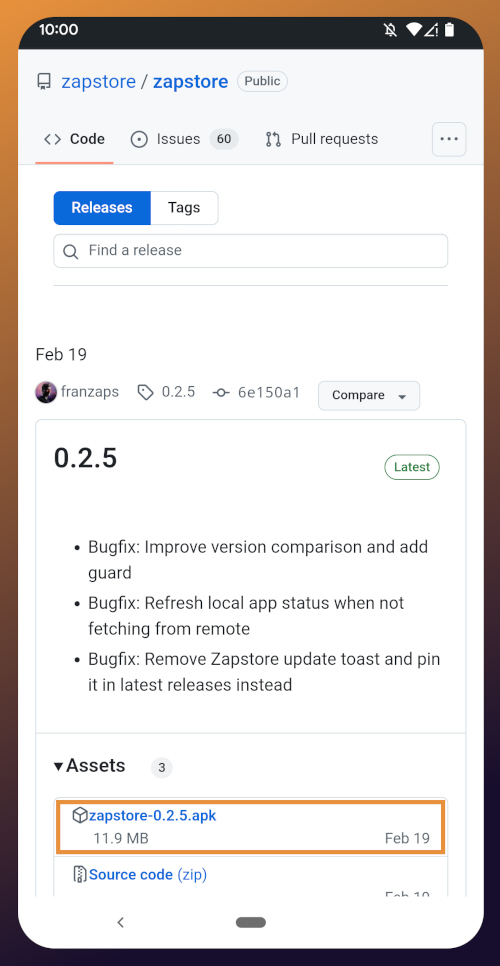
Tap the .apk to download it, and you should get a notification when the download has completed, with a prompt to open the file.
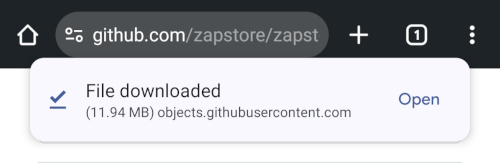
You will likely be presented with a prompt warning you that your phone currently isn't allowed to install applications from "unknown sources." Anywhere other than the Play Store is considered an "unknown source" by default. However, you can manually allow installation from unknown sources in the settings, which the prompt gives you the option to do.
In the settings page that opens, toggle it to allow installation from this source, and you should be prompted to install the application. If you aren't, simply go to your web browser's downloads and tap on the .apk file again, or go into your file browser app and you should find the .apk in your Downloads folder.
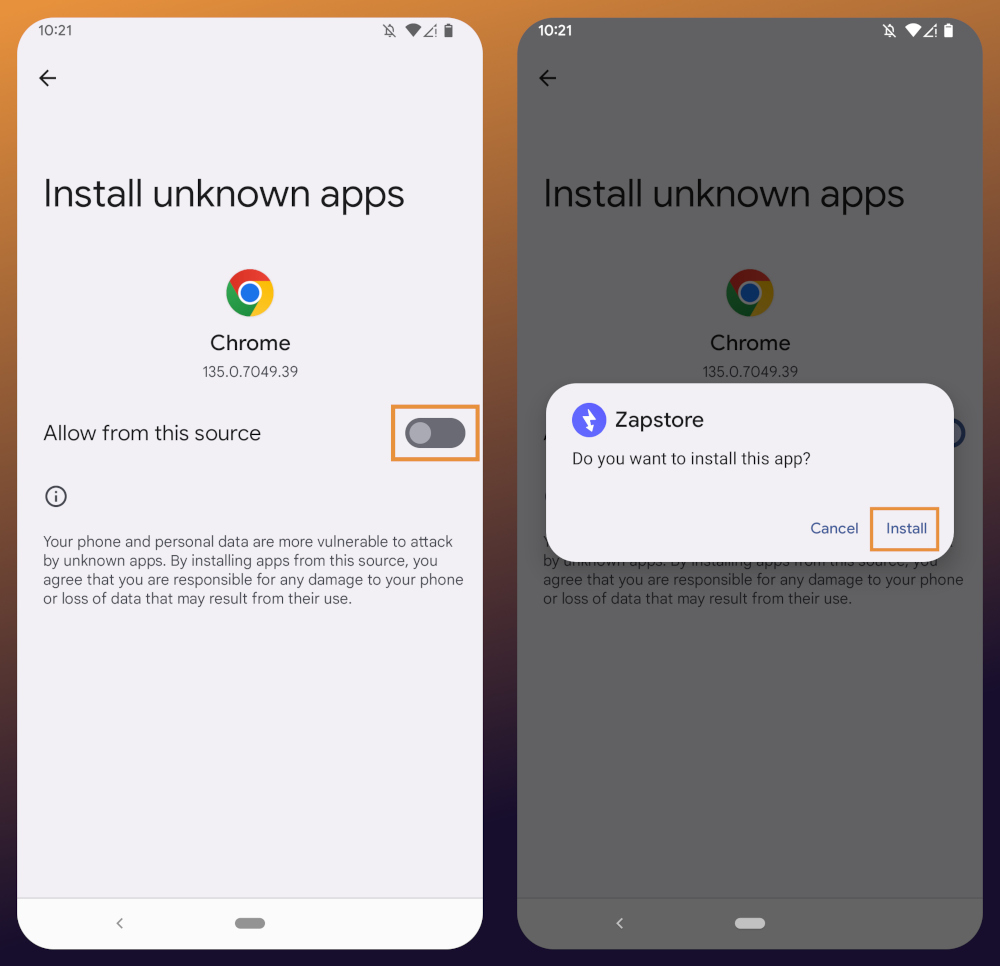
If the application doesn't open automatically after install, you will find it in your app drawer.
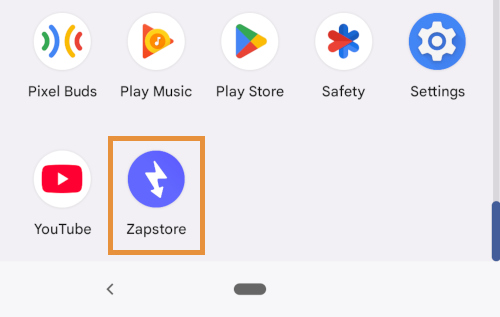
Home Page
Right at the top of the home page in the Zapstore is the search bar. You can use it to find a specific app you know is available in the Zapstore.

There are quite a lot of open source apps available, and more being added all the time. Most are added by the Zapstore developer, nostr:npub1wf4pufsucer5va8g9p0rj5dnhvfeh6d8w0g6eayaep5dhps6rsgs43dgh9, but some are added by the app developers themselves, especially Nostr apps. All of the applications we will be installing through the Zapstore have been added by their developers and are cryptographically signed, so you know that what you download is what the developer actually released.
The next section is for app discovery. There are curated app collections to peruse for ideas about what you may want to install. As you can see, all of the other apps we will be installing are listed in nostr:npub1wf4pufsucer5va8g9p0rj5dnhvfeh6d8w0g6eayaep5dhps6rsgs43dgh9's "Nostr" collection.
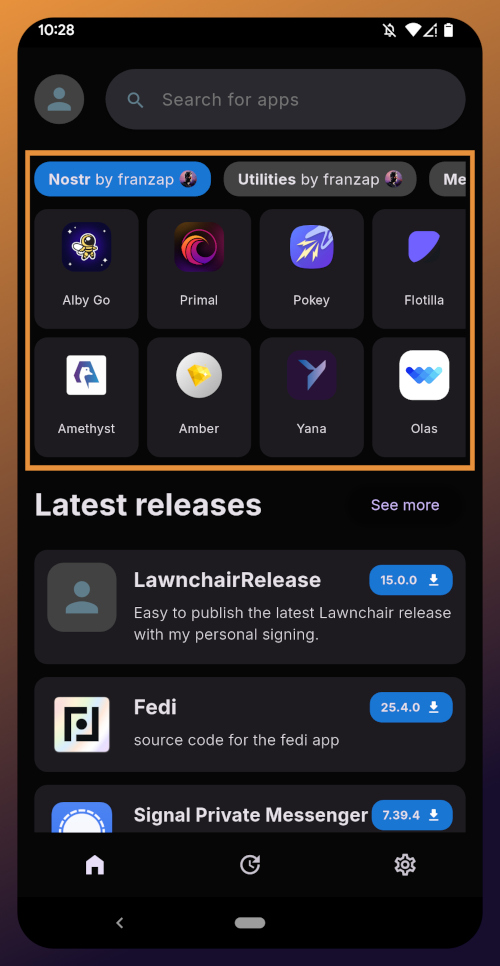
In future releases of the Zapstore, users will be able to create their own app collections.
The last section of the home page is a chronological list of the latest releases. This includes both new apps added to the Zapstore and recently updated apps. The list of recent releases on its own can be a great resource for discovering apps you may not have heard of before.
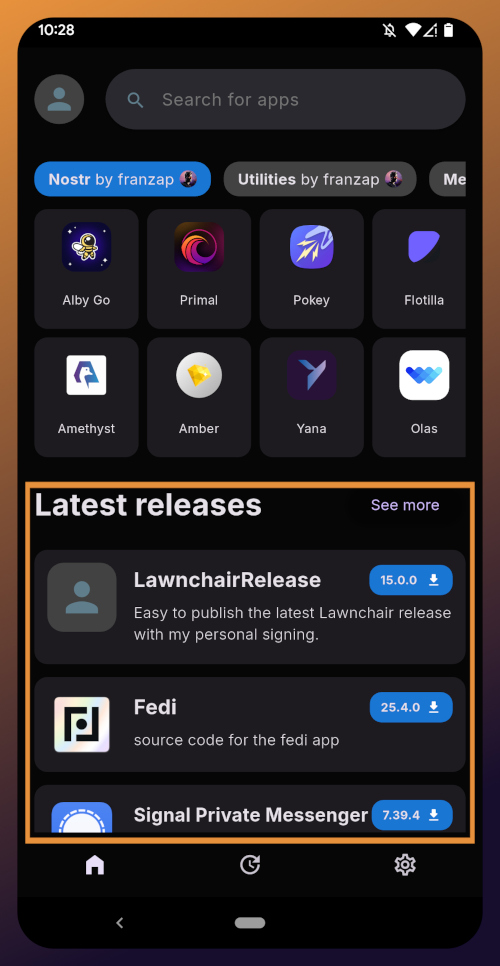
Installed Apps
The next page of the app, accessed by the icon in the bottom-center of the screen that looks like a clock with an arrow circling it, shows all apps you have installed that are available in the Zapstore. It's also where you will find apps you have previously installed that are ready to be updated. This page is pretty sparse on my test profile, since I only have the Zapstore itself installed, so here is a look at it on my main profile:
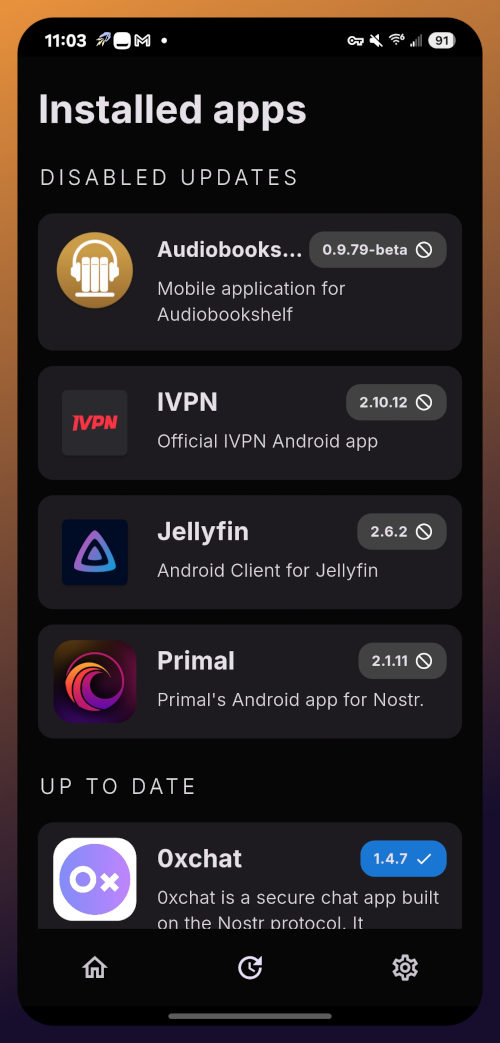
The "Disabled Apps" at the top are usually applications that were installed via the Play Store or some other means, but are also available in the Zapstore. You may be surprised to see that some of the apps you already have installed on your device are also available on the Zapstore. However, to manage their updates though the Zapstore, you would need to uninstall the app and reinstall it from the Zapstore instead. I only recommend doing this for applications that are added to the Zapstore by their developers, or you may encounter a significant delay between a new update being released for the app and when that update is available on the Zapstore.
Tap on one of your apps in the list to see whether the app is added by the developer, or by the Zapstore. This takes you to the application's page, and you may see a warning at the top if the app was not installed through the Zapstore.
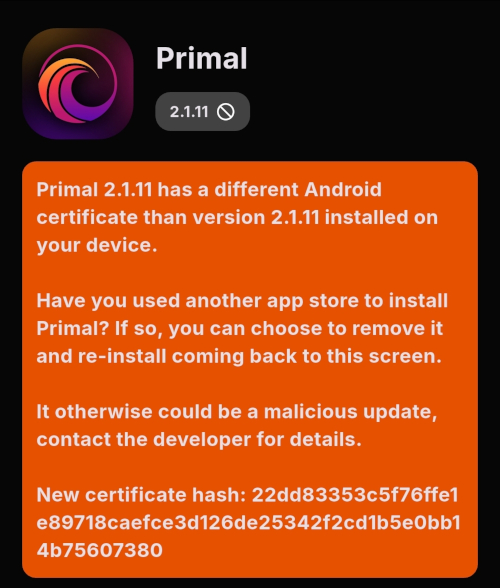
Scroll down the page a bit and you will see who signed the release that is available on the Zapstore.

In the case of Primal, even though the developer is on Nostr, they are not signing their own releases to the Zapstore yet. This means there will likely be a delay between Primal releasing an update and that update being available on the Zapstore.
Settings
The last page of the app is the settings page, found by tapping the cog at the bottom right.
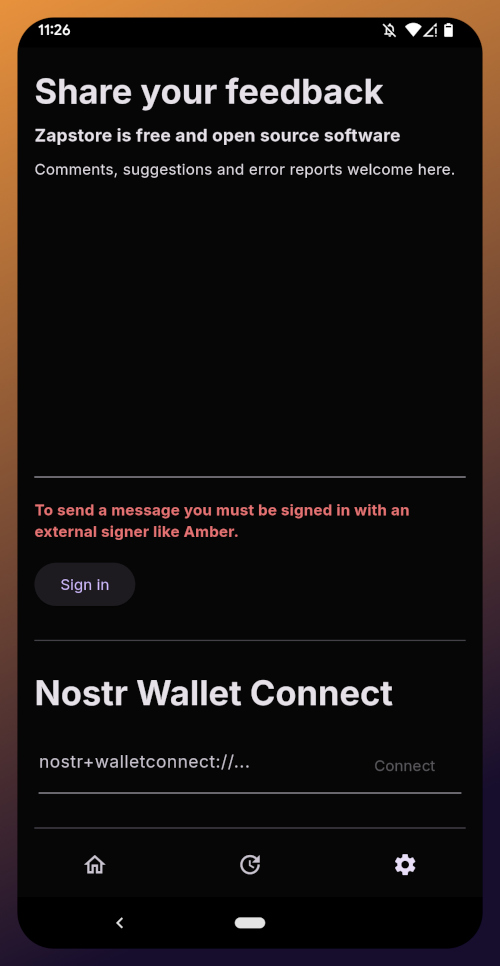
Here you can send the Zapstore developer feedback directly (if you are logged in), connect a Lightning wallet using Nostr Wallet Connect, delete your local cache, and view some system information.
We will be adding a connection to our nostr:npub1h2qfjpnxau9k7ja9qkf50043xfpfy8j5v60xsqryef64y44puwnq28w8ch wallet in part 5 of this tutorial series.
For the time being, we are all set with the Zapstore and ready for the next stage of our journey.
Continue to Part 3: Amber Signer. Nostr link: nostr:naddr1qqxnzde5xuengdeexcmnvv3eqgstwf6d9r37nqalwgxmfd9p9gclt3l0yc3jp5zuyhkfqjy6extz3jcrqsqqqa28qy2hwumn8ghj7un9d3shjtnyv9kh2uewd9hj7qg6waehxw309aex2mrp0yhxyunfva58gcn0d36zumn9wss80nug
-
 @ b7274d28:c99628cb
2025-05-28 00:59:49
@ b7274d28:c99628cb
2025-05-28 00:59:49Your identity is important to you, right? While impersonation can be seen in some senses as a form of flattery, we all would prefer to be the only person capable of representing ourselves online, unless we intentionally delegate that privilege to someone else and maintain the ability to revoke it.
Amber does all of that for you in the context of #Nostr. It minimizes the possibility of your private key being compromized by acting as the only app with access to it, while all other Nostr apps send requests to Amber when they need something signed. This even allows you to give someone temporary authority to post as you without giving them your private key, and you retain the authority to revoke their permissions at any time.
nostr:npub1w4uswmv6lu9yel005l3qgheysmr7tk9uvwluddznju3nuxalevvs2d0jr5 has provided Android users with an incredibly powerful tool in Amber, and he continues to improve its functionality and ease of use. Indeed, there is not currently a comparative app available for iOS users. For the time being, this superpower is exclusive to Android.
Installation
Open up the Zapstore app that you installed in the previous stage of this tutorial series.
Very likely, Amber will be listed in the app collection section of the home page. If it is not, just search for "Amber" in the search bar.

Opening the app's page in the Zapstore shows that the release is signed by the developer. You can also see who has added this app to one of their collections and who has supported this app with sats by zapping the release.
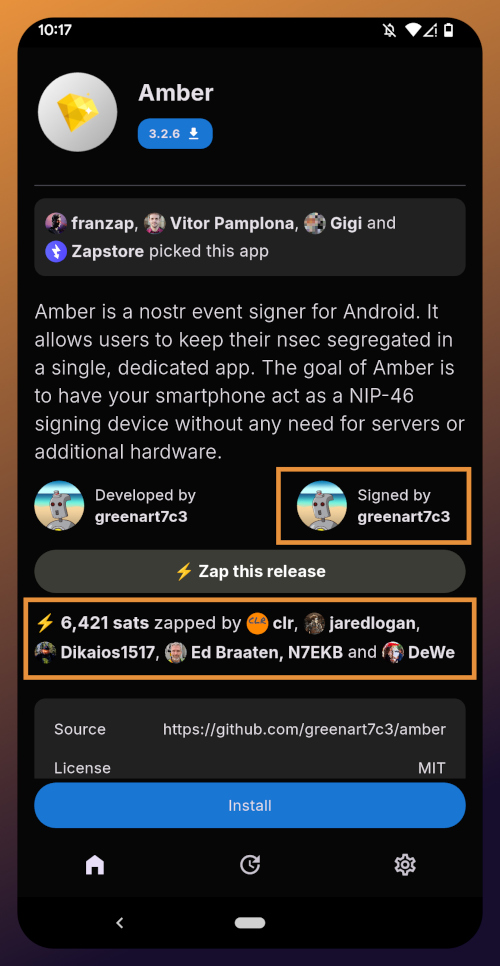
Tap "Install" and you will be prompted to confirm you are sure you want to install Amber.
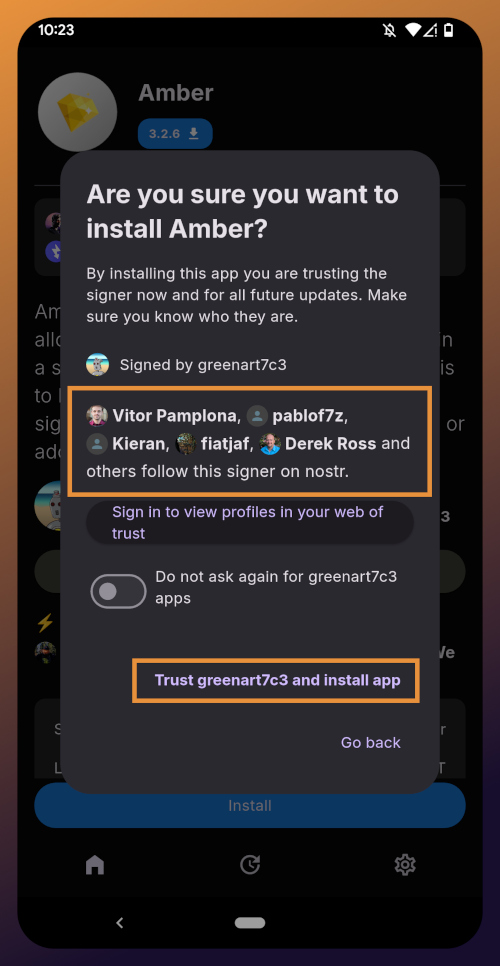
Helpfully, you are informed that several other users follow this developer on Nostr. If you have been on Nostr a while, you will likely recognize these gentlemen as other Nostr developers, one of them being the original creator of the protocol.
You can choose to never have Zapstore ask for confirmation again with apps developed by nostr:npub1w4uswmv6lu9yel005l3qgheysmr7tk9uvwluddznju3nuxalevvs2d0jr5, and since we have another of his apps to install later in this tutorial series, I recommend you toggle this on. Then tap on "Trust greenart7c3 and install app."
Just like when you installed the Zapstore from their GitHub, you will be prompted to allow the Zapstore to install apps, since Android considers it an "unknown source."
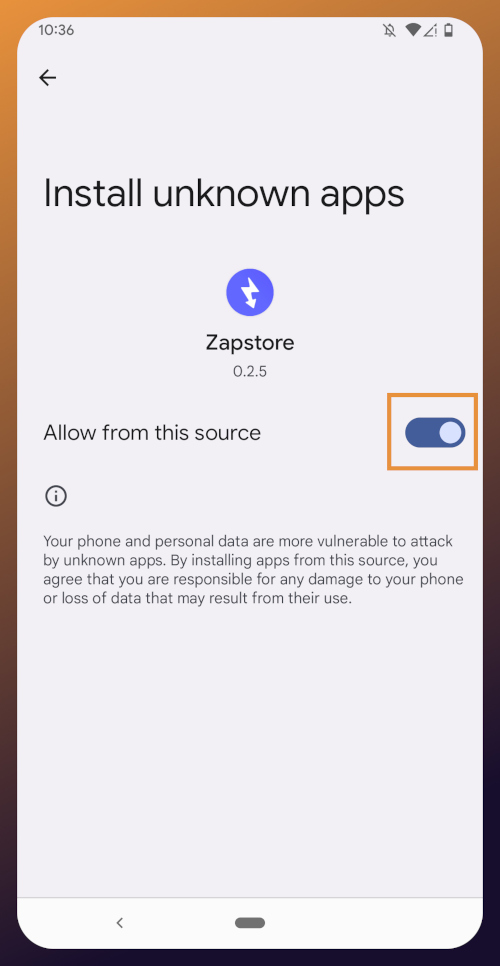
Once you toggle this on and use the back button to get back to the Zapstore, Amber will begin downloading and then present a prompt to install the app. Once installed, you will see a prompt that installation was a success and you can now open the app.

From here, how you proceed will depend on whether you need to set up a new Nostr identity or use Amber with an existing private key you already have set up. The next section will cover setting up a new Nostr identity with Amber. Skip to the section titled "Existing Nostrich" if you already have an nsec that you would like to use with Amber.
New Nostrich
Upon opening the application, you will be presented with the option to use an existing private key or create a new Nostr account. Nostr doesn't really have "accounts" in the traditional sense of the term. Accounts are a relic of permissioned systems. What you have on Nostr are keys, but Amber uses the "account" term because it is a more familiar concept, though it is technically inaccurate.

Choose "Create a new Nostr account" and you will be presented with a screen telling you that your Nostr account is ready. Yes, it was really that easy. No email, no real name, no date of birth, and no annoying capcha. Just "Create a new account" and you're done.
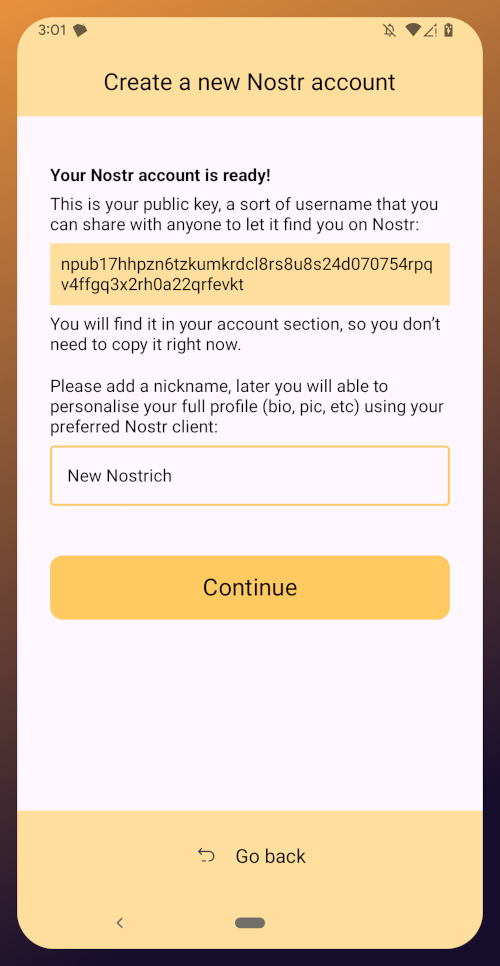
The app presents you with your public key. This is like an address that can be used to find your posts on Nostr. It is 100% unique to you, and no one else can post a note that lists this npub as the author, because they won't have the corresponding private key. You don't need to remember your npub, though. You'll be able to readily copy it from any Nostr app you use whenever you need it.
You will also be prompted to add a nickname. This is just for use within Amber, since you can set up multiple profiles within the app. You can use anything you want here, as it is just so you can tell which profile is which when switching between them in Amber.
Once you've set your nickname, tap on "Continue."
The next screen will ask you what Amber's default signing policy should be.
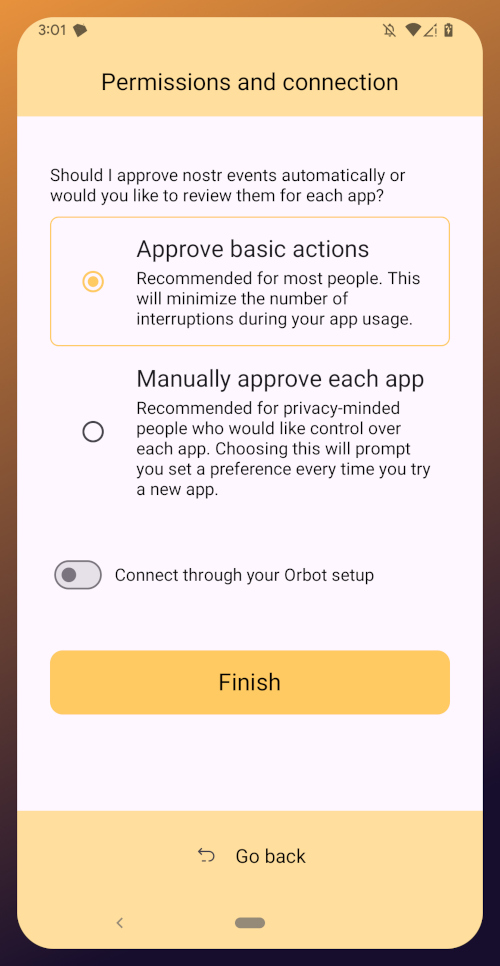
The default is to approve basic actions, referring to things that are common for Nostr clients to request a signature for, like following another user, liking a post, making a new post, or replying. If you are more concerned about what Amber might be signing for on your behalf, you can tell it to require manual approval for each app.
Once you've made your decision, tap "Finish." You will also be able to change this selection in the app settings at any time.
With this setup out of the way, you are now presented with the main "Applications" page of the app.
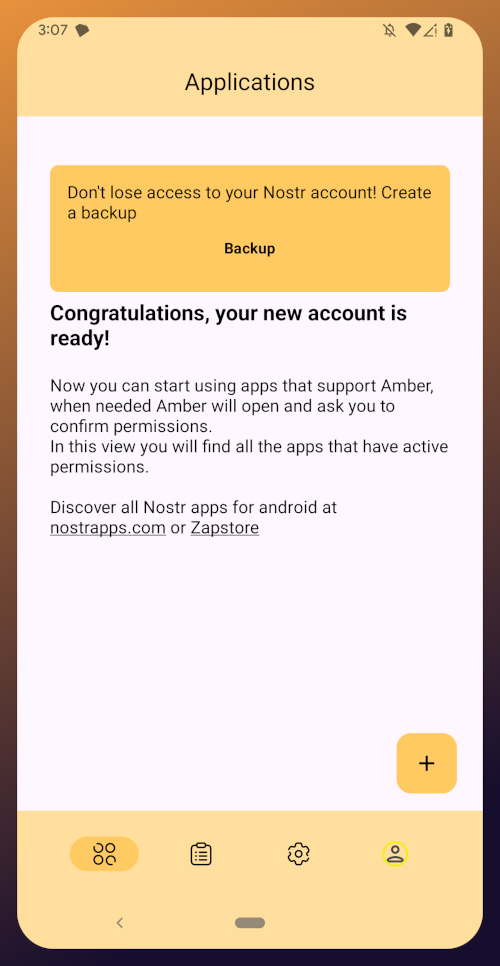
At the top, you have a notification encouraging you to create a backup. Let's get that taken care of now by tapping on the notification and skipping down to the heading titled "Backing Up Your Identity" in this tutorial.
Existing Nostrich
Upon opening the application, you will be presented with the option to use your private key or create a new Nostr account. Choose the former.
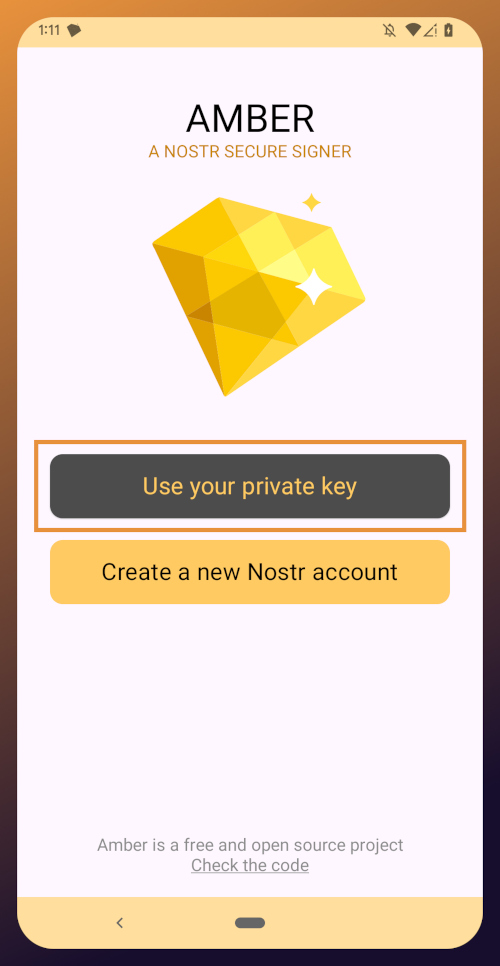
The next screen will require you to paste your private key.
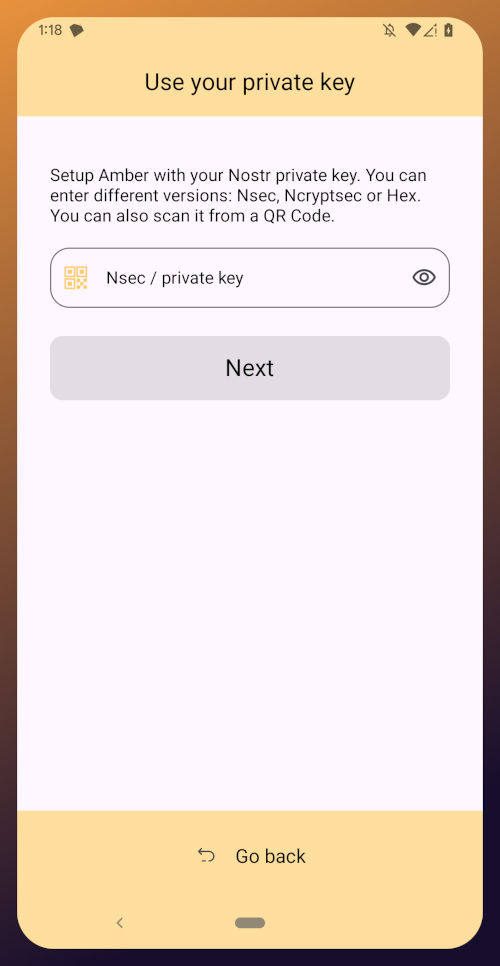
You will need to obtain this from whatever Nostr app you used to create your profile, or any other Nostr app that you pasted your nsec into in the past. Typically you can find it in the app settings and there will be a section mentioning your keys where you can copy your nsec. For instance, in Primal go to Settings > Keys > Copy private key, and on Amethyst open the side panel by tapping on your profile picture in the top-left, then Backup Keys > Copy my secret key.
After pasting your nsec into Amber, tap "Next."

Amber will give you a couple options for a default signing policy. The default is to approve basic actions, referring to things that are common for Nostr clients to request a signature for, like following another user, liking a post, making a new post, or replying. If you are more concerned about what Amber might be signing for on your behalf, you can tell it to require manual approval for each app.
Once you've made your decision, tap "Finish." You will also be able to change this selection in the app settings at any time.
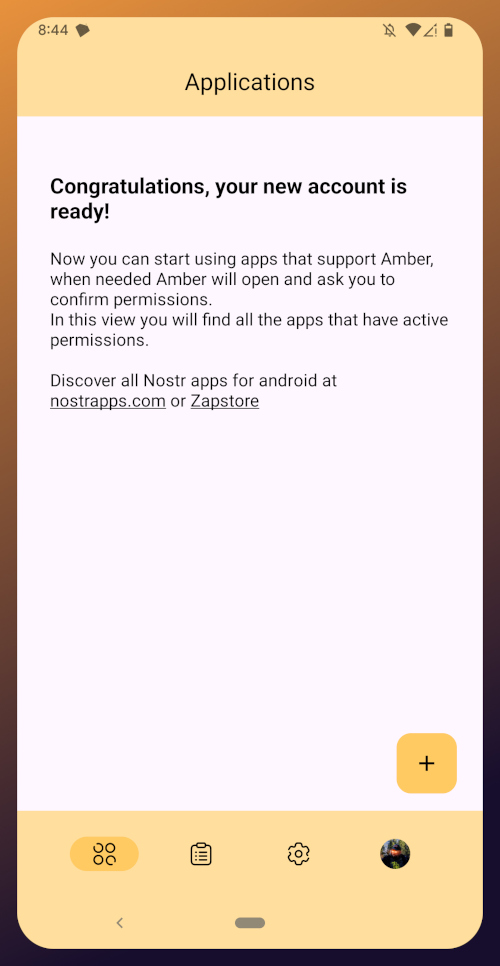
With this setup out of the way, you are now presented with the main "Applications" page of the app. You have nothing here yet, since you haven't used Amber to log into any Nostr apps, but this will be where all of the apps you have connected with Amber will be listed, in the order of the most recently used at the top.
Before we go and use Amber to log into an app, though, let's make sure we've created a backup of our private key. You pasted your nsec into Amber, so you could just save that somewhere safe, but Amber gives you a few other options as well. To find them, you'll need to tap the cog icon at the bottom of the screen to access the settings, then select "Backup Keys."
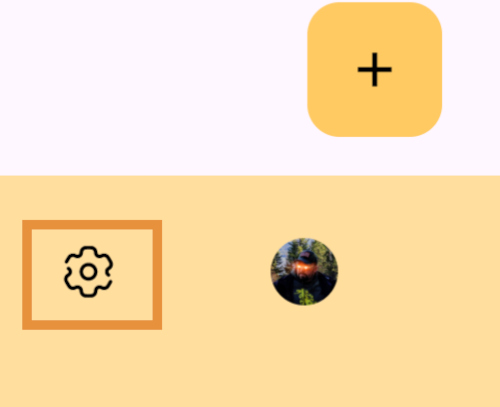
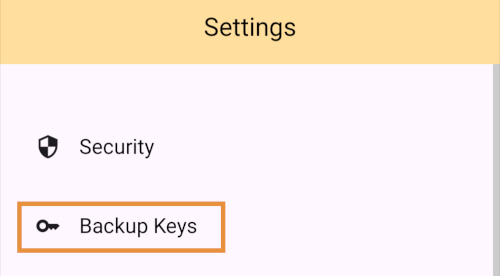
Backing Up Your Identity
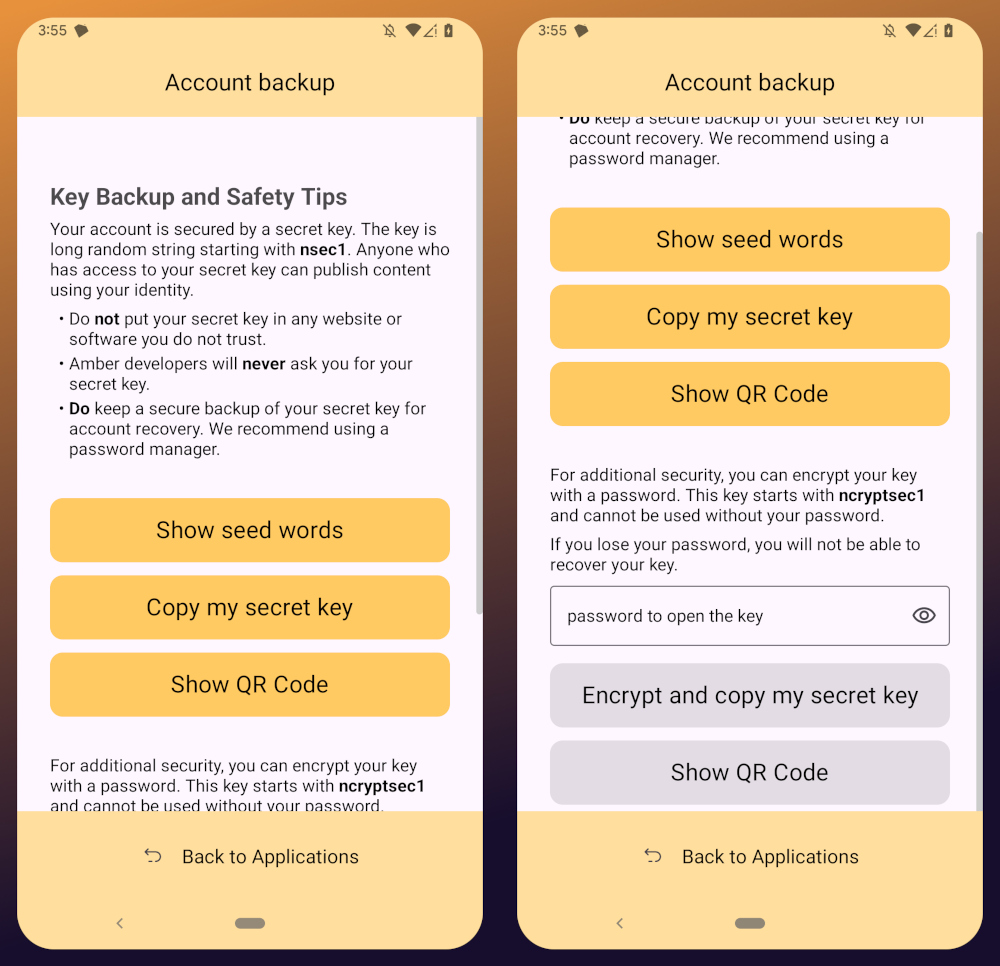
You'll notice that Amber has a few different options for backing up your private key that it can generate.
First, it can give you seed words, just like a Bitcoin seed. If you choose that option, you'll be presented with 12 words you can record somewhere safe. To recover your Nostr private key, you just have to type those words into a compatible application, such as Amber.
The next option is to just copy the secret/private key in its standard form as an "nsec." This is the least secure way to store it, but is also the most convenient, since it is simple to paste into another signer application. If you want to be able to log in on a desktop web app, the browser extension Nostr signers won't necessarily support entering your 12 word seed phrase, but they absolutely will support pasting in your nsec.
You can also display a QR code of your private key. This can be scanned by Amber signer on another device for easily transferring your private key to other devices you want to use it on. Say you have an Android tablet in addition to your phone, for instance. Just make sure you only use this function where you can be certain that no one will be able to get a photograph of that QR code. Once someone else has your nsec, there is no way to recover it. You have to start all over on Nostr. Not a big deal at this point in your journey if you just created a Nostr account, but if you have been using Nostr for a while and have built up a decent amount of reputation, it could be much more costly to start over again.
The next options are a bit more secure, because they require a password that will be used to encrypt your private key. This has some distinct advantages, and a couple disadvantages to be aware of. Using a password to encrypt your private key will give you what is called an ncryptsec, and if this is leaked somehow, whoever has it will not necessarily have access to post as you on Nostr, the way they would if your nsec had been leaked. At least, not so long as they don't also have your password. This means you can store your ncryptsec in multiple locations without much fear that it will be compromised, so long as the password you used to encrypt it was a strong and unique one, and it isn't stored in the same location. Some Nostr apps support an ncryptsec for login directly, meaning that you have the option to paste in your ncryptsec and then just log in with the password you used to encrypt it from there on out. However, now you will need to keep track of both your ncryptsec and your password, storing both of them safely and separately. Additionally, most Nostr clients and signer applications do not support using an ncryptsec, so you will need to convert it back to a standard nsec (or copy the nsec from Amber) to use those apps.
The QR option using an ncryptsec is actually quite useful, though, and I would go this route when trying to set up Amber on additional devices, since anyone possibly getting a picture of the QR code is still not going to be able to do anything with it, unless they also get the password you used to encrypt it.
All of the above options will require you to enter the PIN you set up for your device, or biometric authentication, just as an additional precaution before displaying your private key to you.
As for what "store it in a safe place" looks like, I highly recommend a self-hosted password manager, such as Vaultwarden+Bitwarden or KeePass. If you really want to get wild, you can store it on a hardware signing device, or on a steel seed plate.
Additional Settings
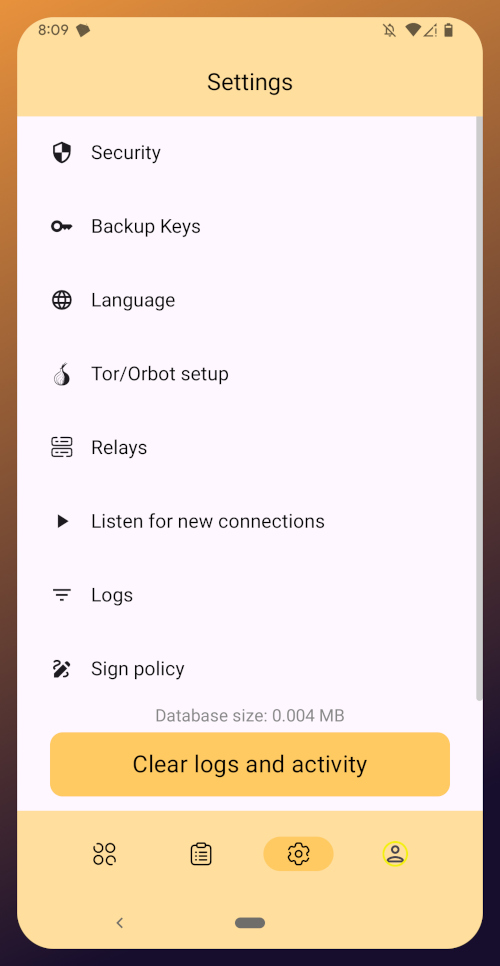
Amber has some additional settings you may want to take advantage of. First off, if you don't want just anyone who has access to your phone to be able to approve signing requests, you can go into the Security settings add a PIN or enable biometrics for signing requests. If you enable the PIN, it will be separate from the PIN you use to access your phone, so you can let someone else use your phone, like your child who is always begging to play a mobile game you have installed, without worrying that they might have access to your Nostr key to post on Amethyst.
Amber also has some relay settings. First are the "Active relays" which are used for signing requests sent to Amber remotely from Nostr web apps. This is what enables you to use Amber on your phone to log into Nostr applications on your desktop web browser, such as Jumble.social, Coracle.social, or Nostrudel.ninja, eliminating your need to use any other application to store your nsec whatsoever. You can leave this relay as the default, or you can add other relays you want to use for signing requests. Just be aware, not all relays will accept the notes that are used for Nostr signing requests, so make sure that the relay you want to use does so. In fact, Amber will make sure of this for you when you type in the relay address.
The next type of relays that you can configure in Amber are the "Default profile relays." These are used for reading your profile information. If you already had a Nostr identity that you imported to Amber, you probably noticed it loaded your profile picture and display name, setting the latter as your nickname in Amber. These relays are where Amber got that information from. The defaults are relay.nostr.band and purplepag.es. The reason for this is because they are aggregators that look for Nostr profiles that have been saved to other relays on the network and pull them in. Therefore, no matter what other relay you may save your profile to, Amber will likely be able to find it on one of those two relays as well. If you have a relay you know you will be saving your Nostr profiles to, you may want to add it to this list.
You can also set up Amber to be paired with Orbot for signing over Tor using relays that are only accessible via the Tor network. That is an advanced feature, though, and well beyond the scope of this tutorial.
Finally, you can update the default signing policy. Maybe after using Amber for a while, you've decided that the choice you made before was too strict or too lenient. You can change it to suit your needs.
Zapstore Login
Now that you are all set up with Amber, let's get you signed into your first Nostr app by going back to the Zapstore.
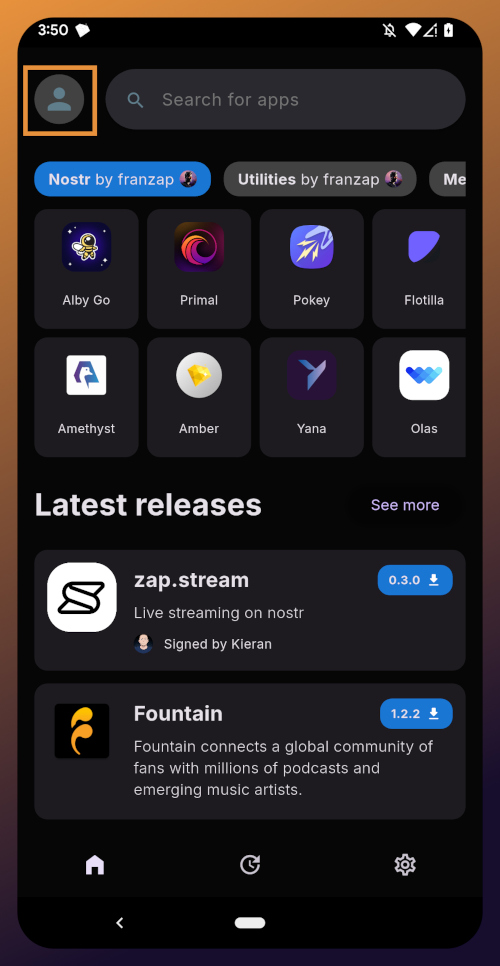
From the app's home screen, tap on the user icon in the upper left of the screen. This will open a side panel with not much on it except the option to "sign in." Go ahead and tap on it.
You will be presented with the option to either sign in with Amber, or to paste your npub. However, if you do the latter, you will only have read access, meaning you cannot zap any of the app releases. There are other features planned for the Zapstore that may also require you to be signed in with write access, so go ahead and choose to log in with Amber.
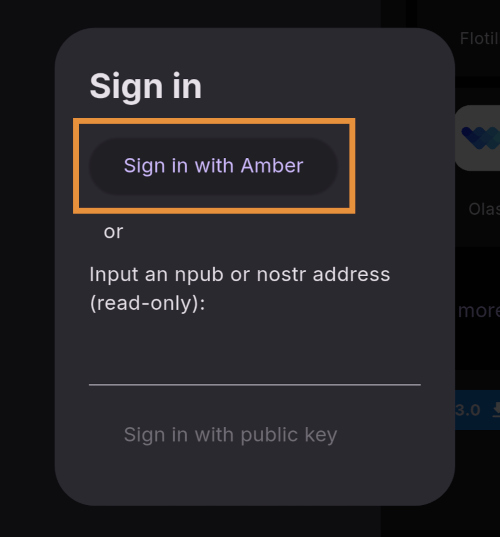
Your phone should automatically switch to Amber to approve the sign-in request.
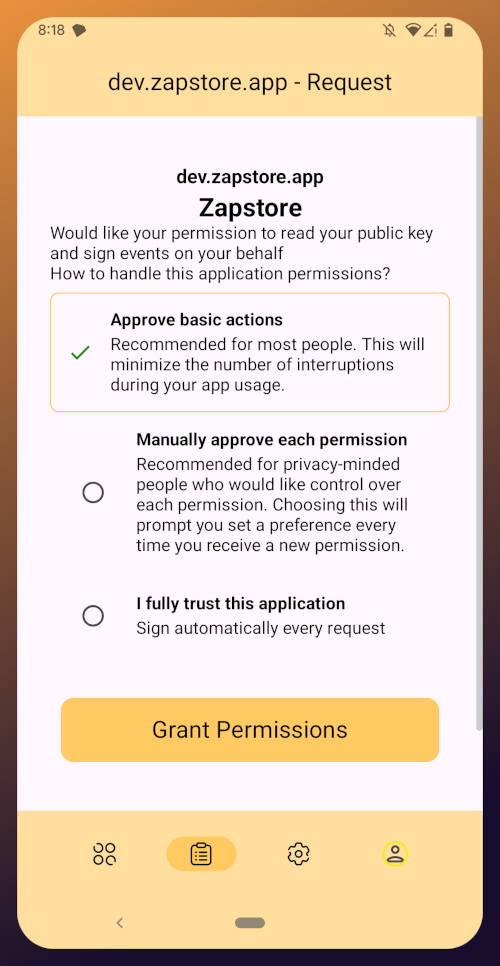
You can choose to only approve basic actions for Zapstore, require it to manually approve every time, or you can tell it that you "fully trust this application." Only choose the latter option with apps you have used for a while and they have never asked you to sign for anything suspicious. For the time being, I suggest you use the "Approve basic actions" option and tap "Grant Permissions."
Your phone will switch back to the Zapstore and will show that you are now signed in. Congratulations! From here on out, logging into most Nostr applications will be as easy as tapping on "Log in with Amber" and approving the request.
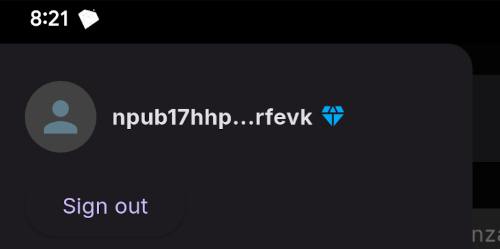
If you set up a new profile, it will just show a truncated version of your npub rather than the nickname you set up earlier. That's fine. You'll have an opportunity to update your Nostr profile in the next tutorial in this series and ensure that it is spread far and wide in the network, so the Zapstore will easily find it.
That concludes the tutorial for Amber. While we have not covered using Amber to log into Nostr web apps, that is outside the scope of this series, and I will cover it in an upcoming tutorial regarding using Amber's remote signer options in detail.
Since you're already hanging out in the Zapstore, you may as well stick around, because we will be using it right out the gate in the next part of this series: Amethyst Installation and Setup. (Coming Soon)
-
 @ 491afeba:8b64834e
2025-05-27 23:57:01
@ 491afeba:8b64834e
2025-05-27 23:57:01Quando adolescente eu acreditava na coerência da teoria de "amor líquido" do polonês, sociólogo, Zygmunt Bauman, apresentada no livro "Amor Líquido: Sobre a Fragilidade dos Laços Humanos", qual no meu amadurecimento em estudos, sejam eles no meio acadêmico ou fora, percebo como uma das formas mais rasas de explicar as mudanças e transformações dos padrões de relações sócio-afetivas dos humanos. A seguir colocar-me-ei na minha juventude não tanto recente, direi então que nós, se adolescentes e conservadores, ou mesmo jovens adultos mais conservadores, costumamos levar como dogma uma óptica decadentista generalizada de todos os avanços de eras dos homens, universalizamos por nos ser comum a indistinção entre humanidade e humanidades, ou mesmo "humanity" e "humankind" ("humanidade" como espécime e "humanidade" como um universal), compreendemos toda "essas" como "essa" e indistinguimos as sociedades para com os homens, ou seja, a incapacidade de definir os seres dentro de suas respectivas singularidades e especificidades nos leva ao decadentismo generalista (a crença de que de forma geral, e universal, a "civilização universal" decai moralmente, éticamente, materialmente e espiritualmente), que aparente à nós determinadas mudanças nas relações humanas quanto ao caráter sócio-afetivo, por falta de profundidade e critérios ainda sobre questões alinhadas aos métodos e coerências, ou incoerências, lógicas, nós se jovens e conservadores somos levados ao engodo de concordar com a teoria do amor líquido de Bauman, que devo cá explicar de antemão: trata ela, a teoria, o padrão de "amor" dos tempos presentes como frágil, de prazo (curto e médio) e diferente em grau comparativamente ao amor comum das eras passadas.
Aos jovens mais progressistas opera uma compreensão dialética sobre as eras dos homens nos seu tempo presente, na qual ao tempo que o ser progride ele também regride simultaneamente, ou seja, a medida que aparecem contradições advindas de transformações materiais da realidade humana o ser supera essas contradições e progride em meio as transformações, ainda fazendo parte da lógica dessa indissociavelmente, assim constantemente progredindo e regredindo, havendo para esses dois vetores de distinção: o primeiro é o que releva questões espirituais como ao caráter do pensamento "new age", o segundo ignora essas questões por negar a existência da alma, seguem ao materialismo. Cedem em crer na teoria baumaninana como dogma, pois não encontram outros meios para explicar as transformações da sociedade na esfera sócio-afetiva sem que haja confrontamento direto com determinadas premissas assim pertinemente presentes, ou por não conciliarem com análises relativamente superiores, como a de Anthony Giddens sobre a "relação pura" em "A Transformação da Intimidade" e de François de Singly apresentada em "Sociologie du Couple".
https://i.pinimg.com/736x/6f/b4/9e/6fb49eda2c8cf6dc837a0abfc7e108e6.jpg
Há um problema quando uma teoria deixa de assim ser para vir a tornar-se mais um elemento desconexo da ciência, agora dentro da cultura pop, se assim podemos dizer, ou da cultura de massa, ou se preferirem mesmo "anticultura", esse problema é a sua deformização teórica, tornando-se essa rasa para sua palatabilidade massiva, somada a incapacidade de partes da sociedade civil em compreender as falhas daquilo que já foi massificado. Tive surpresa ao entender que muitos outros compartilham da mesma opinião, a exemplo, possuo um amigo na faculdade, marxista, que ao falarmos sobre nossos projetos de pesquisa, citou ele o projeto de um de nossos colegas, no qual esse referido um de nossos colegas faria seu projeto com base na teoria do amor líquido de Bauman, então alí demos risada disso, ora, para nós a teoria baumaniana é furada, passamos a falar sobre Bauman e o motivo pelo qual não gostávamos, lá fiquei até surpreso em saber que mais gente além de mim não gostava da teoria de Bauman, pois ao que eu via na internet era rede de enaltecimentos à figura e à sua teoria, tal como fosse uma revelação partindo de alguma divindade da Idade do Bronze. Pouco tempo depois tive em aula de teoria política uma citação de Bauman partindo do professor que ministrava a disciplina, no entanto, ao citar o nome de Bauman o mesmo fez uma feição na qual aparentava segurar risada, provavelmente ele também não levava Bauman à sério. Não devo negar que todas as vezes que vejo o sociólogo sendo citado em alguma nota no X, no Instagram ou qualquer outra rede social, tal como fosse um referencial teórico bom, sinto uma vergonha alheia pois alí tenho uma impressão de que a pessoa não leu Bauman e usa o referencial teórico como um fato já assim provado e comprovado.
Há pontos positivos na teoria baumaniana, como a capacidade de perceber o problema e correlacioná-lo à modernidade, assim como sucitar a influência do que há de material no fenômeno, porém os erros são pertinentes: o primeiro problema é de categoria. Não há, por parte de Bauman noção alguma entre as dissociações dos amores, não há atenção sobre o amor como estrutura ou ele como um sentimento, todo ele é compreendido uniformemente como "amor", partindo do pressuposto que todas as relações, todas elas, são firmadas com base no amor. Essa crença tem uma origem: Hegel. Nos Escritos Teológicos Hegel partia da crença que o amor ligava os seres relacionalmente como uma força de superação e alienação, mas há de compreendermos que esse Friedrich Hegel é o jovem ainda pouco maduro em suas ideias e seu sistema de pensamento, mais a frente, em "Fenomenologia do Espírito e na Filosofia do Direito", Hegel compreende a institucionalidade do direito no amor e a institucionalização dessa força, assim aproxima-se da realidade a respeito da inserção do amor nas esferas práticas do humano, porém essa ideia, apesar de imperfeita, pois ao que sabemos não é o amor que consolida a relação, mas sim a Verdade (Alétheia), conforme apontado por Heidegger em "Ser e Tempo", essa ideia do amor como a fundamento das relações humanas influenciou, e até hoje influencia, qualquer análise sobre as relações humanas fora da esfera materialista, fora dessa pois, melhormente explicado em exemplo, os marxistas (em exemplo), assim como Marx, consideram como base primordial das relações as condições materiais.
Por certo, não é de todo amor a base para a solidificação, ora, erram aqueles que creem que somente essa força, assim apontada por Hegel, constituiam todos os relacionamentos formais como pilares fundamentais, pois em prática as famílias eram até a fiduciarização dessas, por mais paradoxal que seja, compreendidas melhor como instituições orgânicas de caráter legal do que conluios de afetividades. A família outrora tinha consigo aparelhos de hierarquia bem estabelicidos, quais prezavam pela ordem interna e externa, que acima dessa instituição estava somente a Igreja (outra instituição), com sua fiduciarização [da família] após o movimento tomado pelos Estados nacionais em aplicação do casamento civil mudou-se a lógica das partes que a compõe, findou-se o princípio da subsidiariedade (não intervenção de determinadas instituições nas decisões quais podem ser exercidas em resuluções de problemas nas competências de quaisquer instituições), foi-se então, contudo, também a autoridade, e nisso revela-se um outro problema não apontado na teoria de Bauman: qual o padrão do amor "sólido"? Pois, ora, sociedades tradicionais não abdicavam do relevar dos amores para tornar seus filhos em ativos nas práticas de trocas (dádivas)? É notório que esse padrão se dissocia do padrão de sentimento apontado por Bauman, encontramos esse fato em estudo nos trabalhos "Ensaio Sobre a Dádiva", do Marcel Mauss, e "As Estruturas Elementares do Parentesco", do Claude Levi-Strauss, quais expõem que nas sociedades "sólidas", tradicionais, relevava-se mais questões institucionais que as sentimentais para a formação de laços (teoria da aliança). Muitas das relações passadas não eram baseadas no amor, não significando assim que as de hoje, em oposição, sejam, mas que permanecem-se semelhantes em base, diferentemente em grau e forma.
https://substackcdn.com/image/fetch/f_auto,q_auto:good,fl_progressive:steep/https%3A%2F%2Fsubstack-post-media.s3.amazonaws.com%2Fpublic%2Fimages%2F748b94c3-f882-45db-8333-09260ef15cfe_615x413.jpeg
Ora, ainda existem casamentos motivados pela política, pelo status, pelo prestígio, pelos bens, pelo poder, pela influência familiar e assim sucetivamente, tal como no passado, ocorre que essa prática tornou-se oculta, não mais explícita e aparente, devo dizer ainda que em partes, pois prepondera em nosso tempo uma epidemia de adultérios, fornicações, práticas lascivas e demais práticas libertinosas explicitamente, em contraposição às práticas ocultas em vergonhas de sociedades sem declínio moral e espiritual, o que nos leva a questionar o método comparativo em dicotomia temporal "presente x passado" aplicado por Bauman, no qual segue-se da seguinte forma:
Transformação Passado = *sólido* | Presente = *líquido* Categorias Padrão de amor: tradicional (*sólido*) moderno (*líquido*) *Sólido* = estável, prazo (médio-grande), profundo, determinado. *Líquido* = instável, prazo (curto-médio), raso, indeterminado.O que penso é: Zygmunt Bauman buscou uma explicação material e laical para desviar ao fato de que há uma notória correlação entre espiritualização da sociedade, se voltada à Verdade, com a estabilidade das instituições, o que é já reduzido à moral religiosa, somente, não à mística, como por pensadores da linha de Tocqueville, ou em abordagens também mais laical (positivista) porém ainda relevantes, como Émile Durkheim em "As Formas Elementares da Vida Religiosa" e Max Weber em "A Ética Protestante e o Espírito do Capitalismo", contrapondo uma abordage mais voltada, de fato, a espiritualidade, como Christopher Dawnson, que defende essa teoria em "Religião e o Surgimento da Cultura Ocidental", e Eric Voegelin, principalmente nas obras "A Nova Ciência da Política" e "Ordem e História".
Encerrando, minha cosmovisão é a católica, o sistema de crença e religião qual sigo é do Deus que se fez homem por amor aos seus filhos, não posso negar ou mesmo omitir o fato de que, por trás de toda a minha crítica estão meus pensamentos e minhas convicções alinhadas àquilo que mais tenho amor em toda minha vida: a Verdade, e a Verdade é Deus, pois Cristo é a Verdade, o Caminho e a Vida, ninguém vai ao Pai se não por Ele, e pois bem, seria incoerência de minha parte não relevar o fato de crença como um dos motivos pelos quais eu rejeito a teoria do amor líquido de Zygmunt Bauman, pois os amores são todos eles praticados por formas, existem por diferentes formas e assim são desde sua tradicionalidade até o predomínio das distorções de declínio espiritual das eras presentes (e também antigas pré-Era Axial), estão esses preservados pelo alinhamento à verdade, assim são indistorcíveis, imutáveis, ou seja, amor é amor, não releva-se o falso amor como um, simplesmente não o é, assim o interesse, a sanha por bens, o egoísmo e a egolatria ("cupiditas", para Santo Agostinho de Hipona, em oposição ao que o santo e filósofo trata por "caritas") não são formas do amor, são autoenganos, não bons, se não são bons logo não são de Deus, ora, se Deus é amor, se ele nos ama, determino como amor (e suas formas) o que está de acordo com a Verdade. Aprofundando, a Teologia do Corpo, do Papa São João Paulo II, rejeita a "liquidez" apresentada por Bauman, pois o amor é, em suma, sacríficio, parte da entrega total de si ao próximo, e se não há logo não é amor. A Teologia do Corpo rejeita não os fundamentos de mentira no "líquido", mas também no "sólido", pois a tradicionalidade não é sinônimo de bom e pleno acordo com o amor que Deus pede de nós, não são as coerções, as violências, as imposições e demais vontades em oposição às de Deus que determinam os amores -- fatos em oposição ao ideário romanticizado. Claro, nem todas as coerções são por si inválidas do amor, ou mesmo as escolhas em trocas racionalizadas, a exemplo do autruísmo em vista da chance da família ter êxito e sucesso, ou seja, pelo bem dos próximos haver a necessidade de submissão a, em exemplo, um casamento forjado, ou algo do gênero, reconhece-se o amor no ato se feito por bem da família, porém o amor incutido, nesse caso, explicita o caráter sacrificial, no qual uma vontade e um amor genuinamente potencial em prazeres e alegrias são anulados, ou seja, mesmo nesse modelo tradicional na "solidez" há possibilidade do amor, não nas formas romanticizadas em critérios, como "estabilidade" e "durabilidade", mas no caráter do sacríficio exercido. Conforme nos ensina São Tomás de Aquino, o amor não é uma "força", tal como ensina Hegel, mas sim uma virtude teologal conforme na "Suma Teológica" (II-II Q. 26-28), não devemos reduzir o amor e os amores em análises simplórias (não simples) de falsa complexidade extraídas em métodos questionáveis e pouco competentes à real diensão de crise espiritual das eras, por esse motivo não concordo com a teoria do amor líquido de Zygmunt Bauman.
-
 @ bf47c19e:c3d2573b
2025-05-27 21:19:32
@ bf47c19e:c3d2573b
2025-05-27 21:19:32Originalni tekst na bitcoin-balkan.com.
Pregled sadržaja
- Procena vrednosti
- Većina Bitcoin-ovih pozitivnih strana opstaje
- Broj ljudi koji su prihvatili Bitcoin
- Zaključak
Prošlo je trinaest godina od nastanka Bitcoina i lako je poverovati da je većina njegovog rasta iza njega. Deo ovoga je rezultat predrasude koju svi delimo i što nas navodi da zamislimo trenutno stanje stvari kao završni stepen njegovog razvoja. Svaki bitcoiner je nekad mislio da je prekasan sa Bitcoin-om. Međutim, kada primenjujemo kritičko razmišljanje da bismo procenili gde je Bitcoin u svojoj putanji rasta, otkrivamo da je suprotno u stvari tačno: još uvek je vrlo, vrlo rano.
Postoje dva načina da razmišljate o tome koliko je rano za Bitcoin kao zalihu vrednosti neke imovine:
-
Procena vrednosti kao procenat od njegovog punog potencijala
-
Prihvatanje kao procenat od njegovog punog potencijala (na čemu je fokus u ovom članku).
Procena vrednosti
Prvi i najčešći način da se proceni koliko je rano za Bitcoin je da se pogleda njegova ukupna vrednost (trenutno oko 900B USD) i uporedi sa njegovim punim potencijalom. Izazov sa ovim je očigledno da je puni potencijal Bitcoin-a stvar nagađanja. Oni koji duboko razumeju Bitcoin imaju tendenciju da njegov potencijal posmatraju barem kao potencijal zlata (oko 13T USD), ali teoretski više poput 200T USD (oko polovine ukupne vrednosti sveta).
Za brzi pregled ovog potencijala od 200T USD, pogledajmo ukupno raspoloživo tržište Bitcoin-a. Radi jednostavnosti, samo ćemo razmotriti njegovu ulogu zalihe vrednosti i zanemariti njegov potencijal da pojede tržišni udeo od oko 100T USD ukupne vrednosti u različitim svetskim valutama. Uzimajući u obzir različite zalihe vrednosne imovine i grubom procenom koliki bi % Bitcoin mogao da uzme od njih, dobili smo ovakav rezultat:

Iako put do 200T USD nije veliko rastezanje, u stvarnoj vrednosti čini se previše dobrim da bi bio istinit. Sa obzirom da je bez presedana da zaliha vrednosti neke robe postigne vrednost veću od zlata, to jednostavno predstavlja neistraženu teritoriju. Ali čak i ako se jednostavno pridržavamo targetiranja niže ciljne vrednosti zlata od 13T USD, Bitcoin još uvek tendenciju velikog porasta svoje cene u budućnosti.
Većina Bitcoin-ovih pozitivnih strana opstaje
Svako ko razmišlja da nešto svog teško zarađenog novca uskladišti u Bitcoin pita se „da li sam poranio ili zakasnio?“ Nepisano je pravilo da se svako oseća kao da je zakasnio kad stigne. Brojni su primeri ljudi koji žale kako su zakasnili 2011. ili 2013. ili 2016. godine, kada je cena Bitcoin-a bila 5, 100, odnosno 600 USD.
Kao i u bilo kojoj zajednici koja se razvija i raste i u kojoj ima manjka nekretninama, pridošlice zavide ljudima koji su već obezbedili sebi nekretninu, ne sluteći da će njima zavideti ljudi koji tek treba da dođu. Ovaj fenomen je primenjiv i na velikom broju drugih primera. Na primer, zakasneli u Kalifornijskoj zlatnoj groznici bili su razočarani kada su došli, a bogata zlatna polja su već bila iscrpljena, i umesto toga su se naseliti na nekoliko stotina hektara zemljišta, a koje sada vrede bogatstvo.
U srcu ovog osećanja je strah da više nema uspona, da više nema novca koji se može zaraditi uzimajući ono što je još uvek ostalo dostupno. Da li smo dostigli tu tačku sa Bitcoin-om?
Pa ne. Čini se da je zapravo suprotno. Na osnovu punog potencijalnog opsega procene koji smo utvrdili gore, čak i u ishodu niskog nivoa (13T USD), velika većina bogatstva koje će steći vlasnici Bitcoin-a, tek treba da se stekne (96%). Da bi parirao proceni zlata, Bitcoin i dalje mora da poraste 26 puta.
A ako se desi vrhunski ishod, punih 99,7% ukupnog stvaranja bogatstva Bitcoin-a ostaje pred nama. To bi značilo da Bitcoin još uvek treba da poraste 400 puta, zanemarujući pariranje zlatu.
Stavljanjem trenutne vrednosti Bitcoin-a u perspektivu, postaje jasno da je za Bitcoin još uvek vrlo rano.
Iako ova analiza sugeriše da za Bitcoin-u ostaje od 26x do 400x rasta, korisno je proveriti ovaj zaključak kroz drugo razumno objašnjenje, a tamo gde je poznat puni potencijal…
Broj ljudi koji su prihvatili Bitcoin
Procene broja vlasnika Bitcoin-a širom sveta se veoma razlikuju. To je dovelo do prilične količine dvosmislenosti i nesigurnosti u vezi sa stvarnim brojevima i određenog stepena odustajanja i mišljenja da je taj broj jednostavno preteško precizno proceniti. Iako je teško utvrditi konačan broj, glavni razlog za odstupanje u procenama je nedostatak standardizovanih definicija šta znači prihvatanje Bitcoin-a.
Istina je da postoje različiti nivoi prihvatanja Bitcoin-a. Podelom na segmente prihvatanja Bitcoin-a lakše je uvideti ne samo zašto postoji širok opseg procena, već i još važnije, koliko je još uvek rano za prihvatanje Bitcoin-a kao preferirane zalihe vrednosti.
U ove svrhe, hajde da podelimo u segmente prihvatanje Bitcoin-a na četiri različita „nivoa“:
1. Kežual amateri (prstom u vodi)
2. Alokatori 1% (stopalima u vodi)
3. Značajni vernici (do pojasa u vodi)
4. Bitcoin maximalisti (u vodi preko glave)
Pre nego što počnemo, potreban nam je imenilac. Mogli bismo da koristimo globalno stanovništvo, ali po mom mišljenju ovo daje loše rezultate. Ono što mi zaista procenjujemo je koji procenat sveta koji poseduje odredjeno bogatstvo za skladištenje u Bitcoin-u, je to i učinio. Prema podacima sa sajta Statista, 2,2 biliona ljudi na svetu poseduje najmanje 10k USD u neto vrednosti, što se čini kao razumna granica za zalihu koju žele da uskladište. Činjenica je da će siromašne zajednice takođe koristiti Bitcoin kao zalihu vrednosti i verovatno će iz njega izvući veću korist kao rezultat marginalnog pristupa tradicionalnoj bankarskoj infrastrukturi kao klijenti banaka sa „niskom vrednošću“. Međutim, u naše svrhe, jednostavno gledamo koliko je ljudi usvojilo Bitcoin među grupama sa značajnim bogatstvom za skladištenje, tako da će 2.2 biliona služiti kao naša puna potencijalna veličina tržišta.
1. Kežual amateri
Ovaj segment ljudi koji su prihvatili Bitcoin uključuje sve one koji imaju bilo koju količinu Bitcoin-a – vašeg prijatelja sa 20 USD BTC-a negde u nekom novčaniku ili vašu tetku koja se ne seća svoje Coinbase lozinke iz 2017. Po mom mišljenju, najveća zabuna oko broja ljudi koji su prihvatili Bitcoin nastaje zbog poistovećivanja „kežual amatera“ sa ljudima koji su u potpunosti prihvatili Bitcoin. Realnost je takva da ljudi ovog segmenta uglavnom samo eksperimentišu, bilo da bi stekli osećaj za ono o čemu svi pričaju, ili samo uložu nekoliko dolara u Bitcoin u nadi da će možda dobiti džekpot, kao što je slučaj sa greb-greb nagradnim igrama.
Zbog toga, „kežual amateri“ su razlog dovodjenja u zabludu pravog broja ljudi koji su u potpunosti prihvatili Bitcoin. Njihovo ponašanje zapravo ne predstavlja prihvatanje u pravom smislu te reči i stoga se ne bi trebalo smatrati ljudima koji su u potpunosti prihvatili Bitcoin. Istina je da, kada kežual amateri shvate da je Bitcoin najbolja zaliha vrednosti neke imovine u istoriji, neće ostati na samo 20 USD u Bitcoin-ima. Umesto toga, oni će svoju štednju prebaciti u mnogo većim iznosima.
Što se tiče odredjivanja veličine ovog segmenta, Willy Woo je sastavio razumno iscrpnu i sveobuhvatnu procenu od oko 187 miliona ljudi koji su prihvatili Bitcoin, što znači da su oni u najmanju ruku „kežual amateri“.
Koristeći ovaj i naš puni potencijal od 2,2 biliona ljudi kao imenioca, 8,5% potencijalnih ljudi koji su prihvatili Bitcoin-e dostiglo je nivo „kežual amatera“. Ovo je prilično velik broj i potpuno obmanjuje stvarni obim potpunog prihvatanja, a što će pokazati sledeći segmenti.
2. Alokatori 1%
Za preostale potkategorije, tačni podaci su manje dostupni. Kao takvi, sve što možemo je da smislimo razumne procene putem triangulacije.
Po mom mišljenju, „alokatori 1%“ se mogu okarakterisati kao ljudi koji su prihvatili Bitcoin, i koji žele da imaju mali, ali ne i zanemarljivi deo u Bitcoin-u. Za naše svrhu, mislim da je pristojan prag za ovu grupu svako ko ima najmanje 0,1 Bitcoin, i može se smatrati da imaju malu, ali ne i zanemarljivu poziciju u Bitcoin-u.
Gledajući Bitcoin blockchain, postoji oko 3 miliona adresa koje imaju najmanje 0,1 BTC. Pored ovih brojeva na blockchain-u, moramo da uzmemo u obzir i znatan broj ljudi koji imaju ovaj iznos na berzi ili GBTC-u. Kombinovanjem, mislim da je razumno proceniti da je 10 miliona ljudi dostiglo nivo „alokatora 1%“ ili veći.
Na osnovu ovih brojeva, samo 1⁄17 „kežual amatera“ dostiglo je nivo prihvatanja „alokatora 1%“, što znači da je ovaj nivo prihvatanja Bitcoin-a do danas postigao samo 0,5% penetracije. Ovaj strmi pad je razlog zašto je došlo do zablude da veliki broj „kežual amatera“ bude označeno kao grupa koja je u potpunosti prihvatila Bitcoin.
3. Značajni vernici
U ovu kategoriju spada svako ko je dostigao nivo razumevanja Bitcoin-a da alokacija od 1% ili čak 5% više ne izgleda dovoljna.
Uopšteno govoreći, ova grupa se kreće u rasponu od 5 – 50%. Išao bih toliko daleko da bih rekao da je većina ljudi koji sebe smatraju vernicima u Bitcoin-e, uključujući većinu Bitcoin Twitter-a, negde u ovoj grupi.
Procena veličine ove grupe postaje mnogo nejasnija, ali možemo se osloniti na podatke iz blockchain-a da bismo došli do razumne procene.
Za početak, hajde da utvrdimo da je većina ljudi koji su dostigli ovaj nivo verovanja i razumevanja Bitcoin-a, izborila da poseduje najmanje 1 Bitcoin. Pored toga, ovaj nivo ljudi koji su prihvatili Bitcoin je verovatno osigurao svoj Bitcoin u chain-u novčanika kojim oni upravljaju. Gledajući podatke na chain-u, oko 820k adresa ima najmanje 1 Bitcoin. Kao grubu pretpostavku, uzmimo da 500k od toga poseduju ljudi koji su dostigli nivo prihvatanja „značajnog vernika“.
Ako potom generički zaokružimo akaunte za ljude koji nisu postigli status wholecoiner-a (eng. osoba koja poseduje barem 1 BTC), ili koji svoja sredstva drže na berzi, dolazimo do grube procene od 2 miliona „značajnih vernika“.
4. Bitcoin maximalisti
Za našu svrhu, recimo da ova grupa uključuje svakoga ko je dovoljno duboko ušao u Bitcoin da je zaključio da bi više od 50% njihove neto vrednosti trebalo da bude uskladišteno u Bitcoin-u.
Procena veličine ove grupe je gotovo nemoguća, zato ćemo morati da budemo kreativni.
-
Prodaja „Bitcoin Standard“
-
Hajde da konzervativno procenimo da je samo 20% maximalističara kupilo Bitcoin Standard, i da je 50% tih ljudi koji su ga razumeli, postali maksimalisti. Na osnovu knjige Amazon US rank (6,681), onlajn kalkulatori procenjuju da je prodato oko 15k primeraka.
- Hajde da budemo velikodušni i da zaokružimo taj broj od oko 15k na 50k, uzimajući u obzir međunarodnu prodaju i kupovinu izvan Amazona.
Ovo nas dovodi do procene broja od 125k maximalista. Da ne bismo pogrešili, bićemo oprezni, i udvostručimo taj broj i rećićemo da ih ima 250k.
- Kvalitativna triangulacija
Čisto subjektivno, ali čini mi se da na Twitter-u, primarnom domu za komunikaciju maximalista, postoji možda 10k aktivno angažovanih Bitcoin maximalista. Da budemo vrlo konzervativni, recimo da ovo predstavlja oko 5% maximalista (od ukupno 200k).
Uz to, kao procenu od vrha nadole, čini se opravdanim da je oko 10% ljudi koji su dostigli 5 – 50% alokacije Bitcoin-a napravilo skok ka maximalizmu.
Sve u svemu, cifra od oko 250k Bitcoin maximalista čini se konzervativnom, ako ne i velikodušnom pretpostavkom.
To nas dovodi do 0,01% penetracije.
Zaključak
Kako god gledali brojke, još uvek je rano za Bitcoin. Posmatrajući procenu vrednosti Bitcoin-a kao procenat njegovog punog potencijala, vidimo da je trenutna vrednost Bitcoin-a negde između 0,2% i 3% njegovog krajnjeg stanja, što znači da ostaje 30x do 500x rasta. Gledajući napredak prihvatanja Bitcoin-a, vidimo da je trenutna penetracija Bitcoin-a negde između 0,01% i 8,5%, u zavisnosti od toga koji prag prihvatanja gledate.
Ako verujete, kao što ja verujem, da je Bitcoin na putu da postane dominantna zaliha vrednosti i preferirani novac za ceo svet, na kraju će norma biti više od 50% posedovanja neto vrednosti u Bitcoin-u. Budući da naša analiza ovde sugeriše da samo 0,01% sveta zadovoljava ove standarde, opravdano je zaključiti da 99,99% sveta ostaje da sledi njihov primer.
Sve u svemu, dok svi koji se pojave na Bitcoin-u neizbežno osećaju žaljenje zbog toga što nisu ranije investirali i pitaju se da li su u potpunosti propustili brod, jasno je da većina rasta Bitcoin-a ostaje pred nama. Da stavimo ovo u neki kontekst, obzirom da može postojati samo 21 milion Bitcoin-a, prosečna osoba na zemlji (od 8 biliona ljudi) imaće samo 0,0025 Bitcoin-a. Još je toliko rano, da ukupna neto vrednost te prosečne osobe u Bitcoin-u može da se kupi za samo 90 USD.
I ako mislite da je kasno, zapravo je veoma rano, zato vam čestitam i uživajte u skupljanju sats-ova dok su još uvek ovako jeftini!
-
 @ 6be5cc06:5259daf0
2025-05-27 20:37:22
@ 6be5cc06:5259daf0
2025-05-27 20:37:22At
até uma ferramenta de agendamento de tarefas em Linux usada para executar comandos únicos em um horário e data específicos. Diferente docron, que serve para tarefas recorrentes, oatexecuta uma única vez.Como usar o
at1. Verifique se o
atestá instaladobash which atSe não estiver instalado:
bash sudo apt install atE inicie o serviço (caso necessário):
bash sudo systemctl enable --now atd2. Agendar um comando
bash at 10:00 AM tomorrowVocê será levado a um prompt interativo. Digite o comando desejado e finalize com
Ctrl + D.Exemplo 1:
bash at 09:00 AM next Monday(Entrada do usuário no prompt do
at)echo "Relatório pronto" >> ~/relatorio.txt Ctrl + DResultado: O trecho "relatório pronto" será incluído no documento relatorio.txt.
Exemplo 2:
bash at 21:00 Apr 15Entrada no prompt:
notify-send "Hora de fazer backup!" Ctrl + DResultado: Às 21h do dia 15 de abril, o sistema exibirá uma notificação.
Formatos de Data e Hora Válidos
-
now + 1 minute -
midnight -
tomorrow -
5pm -
08:30 -
7:00am next friday -
noon + 2 days
Visualizar tarefas agendadas
bash atqRemover uma tarefa agendada
bash atrm <número_da_tarefa>Você encontra o número da tarefa com
atq.
cron
O
croné um utilitário de agendamento de tarefas baseado no tempo. Permite executar comandos ou scripts automaticamente em horários específicos. Ele depende do daemoncrond, que deve estar ativo e em execução contínua no sistema.Arquivo de configuração:
-
Cada usuário pode editar seu próprio agendador com:
bash crontab -e -
O formato padrão de uma linha no crontab:
m h dom mon dow comando
|Campo|Descrição|Valores possíveis| |---|---|---| |m|Minuto|0–59| |h|Hora|0–23| |dom|Dia do mês|1–31| |mon|Mês|1–12| |dow|Dia da semana|0–6 (0 = Domingo)| |comando|Comando a executar|Qualquer comando shell válido|
Exemplos:
-
Executar um script a cada minuto:
bash * * * * * /usr/local/bin/execute/this/script.sh -
Fazer backup no dia 10 de junho às 08:30:
bash 30 08 10 06 * /home/sysadmin/full-backup -
Backup todo domingo às 5h da manhã:
bash 0 5 * * 0 tar -zcf /var/backups/home.tgz /home/
Limitações:
Tarefas agendadas com
cronnão são executadas se o computador estiver desligado ou suspenso no horário programado. O comando é simplesmente ignorado. Usecronpara tarefas com data/hora exatas.
anacron
O
anacroné uma alternativa aocronvoltada para sistemas que não ficam ligados o tempo todo, como notebooks e desktops. Ele garante a execução de tarefas periódicas (diárias, semanais, mensais) assim que possível após o sistema ser ligado, caso tenham sido perdidas. Useanacronpara tarefas periódicas tolerantes a atrasos.Verificação da instalação:
bash anacron -VInstalação (caso necessário):
bash sudo apt update sudo apt install anacronArquivo de configuração:
/etc/anacrontabAcessado com:
sudo nano /etc/anacrontabFormato de cada linha:
PERIOD DELAY IDENT COMMAND| Campo | Descrição | | ------- | ------------------------------------------- | | PERIOD | Intervalo em dias (1 = diário, 7 = semanal) | | DELAY | Minutos a esperar após o boot | | IDENT | Nome identificador da tarefa | | COMMAND | Comando ou script a ser executado |
Exemplo:
bash 1 3 limpeza-temporarios /home/usuario/scripts/limpar_tmp.shExecuta o script uma vez por dia, 3 minutos após o sistema ser ligado.
Nota: Não é necessário usar
run-partsnemcron.dailypara tarefas personalizadas. Basta apontar diretamente para o script desejado. Orun-partssó deve ser usado quando se deseja executar todos os scripts de um diretório.Ativação do serviço:
bash sudo systemctl enable --now anacronVerificação de status:
bash systemctl status anacronLogs de execução:
bash grep anacron /var/log/syslog/etc/anacrontab: Arquivo de Configuração doanacronO arquivo
/etc/anacrontabdefine tarefas periódicas a serem executadas peloanacron, garantindo que comandos sejam executados mesmo que o computador esteja desligado no horário originalmente programado.Cabeçalho Padrão
bash SHELL=/bin/sh HOME=/root LOGNAME=root-
SHELL: Shell padrão utilizado para executar os comandos. -
HOME: Diretório home usado durante a execução. -
LOGNAME: Usuário associado à execução das tarefas.
Entradas Padrão do Sistema
bash 1 5 cron.daily run-parts --report /etc/cron.daily 7 10 cron.weekly run-parts --report /etc/cron.weekly @monthly 15 cron.monthly run-parts --report /etc/cron.monthly|Campo|Significado| |---|---| |
1|Executa a tarefa diariamente (a cada 1 dia)| |5|Espera 5 minutos após o boot| |cron.daily|Identificador da tarefa (usado nos logs)| |run-parts|Executa todos os scripts dentro do diretório|Diretórios utilizados:
-
/etc/cron.daily: scripts executados uma vez por dia -
/etc/cron.weekly: scripts semanais -
/etc/cron.monthly: scripts mensais
O comando
run-partsexecuta automaticamente todos os scripts executáveis localizados nesses diretórios.Personalização
Para adicionar tarefas personalizadas ao
anacron, basta adicionar novas linhas com o formato:PERIOD DELAY IDENT COMMANDExemplo:
bash 1 3 limpeza-temporarios /home/usuario/scripts/limpar_tmp.shExecuta o script
limpar_tmp.shdiariamente, com 3 minutos de atraso após o boot.Importante: Não é necessário — nem recomendado — usar
run-partsquando a intenção é executar um script individual. Orun-partsespera um diretório e ignora arquivos individuais. Usarrun-partscom um script individual causará falha na execução. -
-
 @ bf47c19e:c3d2573b
2025-05-27 20:23:48
@ bf47c19e:c3d2573b
2025-05-27 20:23:48Originalni tekst na bitcoin-balkan.com.
Pregled sadržaja
- Šta je Bitcoin?
- Šta Bitcoin može da učini za vas?
- Zašto ljudi kupuju Bitcoin?
- Da li je vaš novac siguran u dolarima, kućama, akcijama ili zlatu?
- Šta je bolje za štednju od dolara, kuća i akcija?
- Po čemu se Bitcoin razlikuje od ostalih valuta?
- kako Bitcoin spašava svet?
- Kako mogu da saznam više o Bitcoin-u?
Bitcoin čini da štednja novca bude kul – i praktična – ponovo. Ovaj članak objašnjava kako i zašto.
Šta je Bitcoin?
Bitcoin se naziva digitalno zlato, mašina za istinu, blockchain, peer to peer mreža čvorova, energetski ponor i još mnogo toga. Bitcoin je, u stvari, sve ovo. Međutim, ova objašnjenja su često toliko tehnička i suvoparna, da bi većina ljudi radije gledala kako trava raste. Što je najvažnije, ova objašnjenja ne pokazuju kako Bitcoin ima bilo kakve koristi za vas.
iPod nije postao kulturološka senzacija jer ga je Apple nazvao „prenosnim digitalnim medijskim uređajem“. Postao je senzacija jer su ga zvali “1,000 pesama u vašem džepu.”
Ne zanima vas šta je Bitcoin. Vas zanima šta on može da učini za vas.
Baš kao i Internet, vaš auto, vaš telefon, kao i mnogi drugi uređaji i sistemi koje svakodnevno koristite, vi ne treba da znate šta je Bitcoin ili kako to funkcioniše da biste razumeli šta on može da učini za vas.
Šta Bitcoin može da učini za vas?
Bitcoin može da sačuva vaš teško zarađeni novac.
Bitcoin je stekao veliku pažnju u 2017. i 2018. godini zbog svoje spekulativne upotrebe. Mnogi ljudi su ga kupili nadajući se da će se obogatiti. Cena je naglo porasla, a zatim se srušila. Ovo nije bio prvi put da je Bitcoin uradio to. Međutim, niko nikada nije izgubio novac držeći bitcoin duže od 3,5 godine – ćak i ako je kupio na apsolutnim vrhovima.
Zašto Bitcoin konstantno raste? Ljudi počinju da shvataju koliko je Bitcoin moćan, kao način uštede novca u svetu u kojem je ’novac’ poput dolara, eura i drugih nacionalnih valuta dizajniran da gubi vrednost.
Ovo čini Bitcoin odličnom opcijom za štednju novca na nekoliko godina ili više. Bitcoin je bolji od štednje novca u dolarima, akcijama, nekretninama, pa čak i u zlatu.
Zato pokušajte da zaboravite na trenutak na razumevanje blockchaina, digitalne valute, kriptografije, seed fraza, novčanika, rudarstva i svih ostalih nerazumljivih termina. Za sada, razgovarajmo o tome zašto ljudi kupuju Bitcoin: razlog je prostiji nego što vi mislite.
Zašto ljudi kupuju Bitcoin?
Naravno, svako ima svoj razlog za kupovinu Bitcoin-a. Jedan od razloga, koji verovatno često čujete, je taj što mu vrednost raste. Ljudi žele da se obogate. Uskoče kao spekulanti, krenu u vožnju i najverovatnije ih prodaju ubrzo nakon kupovine.
Međutim, čak i kada cena krene naglo prema gore i strmoglavo padne nazad, mnogi ljudi ostanu i nakon tog pada. Otkud mi to znamo? Broj aktivnih novčanika dnevno, koji je otprilike sličan broju korisnika Bitcoin-a, nastavlja da raste. Takođe, nakon svakog balona u istoriji Bitcoin-a, cena se nikada ne vraća na svoju cenu pre balona. Uvek ostane malo višlja. Bitcoin se penje, a svaka masovna spekulativna serija dovodi sve više i više ljudi.
Broj aktivnih Bitcoin novčanika neprekidno raste
„Aktivna adresa“ znači da je neko tog dana poslao Bitcoin transakciju. Donji grafikon je na logaritamskoj skali.
 Izvor: Glassnode
Izvor: GlassnodeCena Bitcoina se neprestano penje
Kroz istoriju Bitcoin-a možemo videti divlje kolebanje cena, ali nakon svakog balona, cena se ostaje višlja nego pre. Ovo je cena Bitcoin-a na logaritamskoj skali.
 Izvor: Glassnode
Izvor: GlassnodeTo pokazuje da se ljudi zadržavaju: potražnja za Bitcoin-om se povećava. Da je svaki masovni rast cena bio samo balon koji su iscenirali prevaranti koji žele brzo da se obogate, cena bi se vratila na nivo pre balona. To se dogodilo sa lalama, ali ne i sa Bitcoin-om.
I zašto se onda cena Bitcoin-a stalno povećava? Sve veći broj ljudi čuva Bitcoin dugoročno – oni razumeju šta Bitcoin može učiniti za njihovu štednju.
Zašto ljudi štede svoj novac u Bitcoin-u umesto na štednim računima, kućama, deonicama ili zlatu? Hajde da pogledajmo sve te metode štednje, i zatim da ih uporedimo sa Bitcoin-om.
Da li je vaš novac siguran u dolarima, kućama, akcijama ili zlatu?
Tokom mnogo godina, to su bile pristojne opcije za štednju. Međutim, sistem koji podržava vrednost svega ovoga je u krizi.
Dolari, Euri, Dinari
Dolari i sve ostale „tradicionalne“ valute koje proizvode vlade, stvorene su da izgube vrednost kroz inflaciju. Banke i tradicionalni monetarni sistem uzrokuju inflaciju stalnim stvaranjem i distribucijom novog novca. Kada Američke Federalne Rezerve objave ciljanu stopu od 2% inflacije, to znači da žele da vaš novac svake godine izgubi 2% od svoje vrednosti. Čak i sa inflacijom od samo 2%, vaša štednja u dolarima izgubiće polovinu vrednosti tokom 40-godišnjeg radnog veka.
Izveštena inflacija se danas opasno povečava, uprkos rastućem „buretu sa barutom“ koji bi mogao da explodira i dovede do masivne hiperinflacije. Što je više valute u opticaju, to je više baruta u buretu.
Naše vlade su ekonomiju napunile valutama da bankarski sistem ne bi propao nakon finansijske krize koja se dogodila 2008. godine. Od tada je većina glavnih centralnih banaka postavila vrlo niske kamatne stope, što pojedincima i korporacijama omogućava dobijanje jeftinijih kredita. To znači da mnogi pojedinci i korporacije podižu ogromne kredite i koriste ih za kupovinu druge imovine poput deonica, umetničkih dela i nekretnina. Sve ovo pozajmljivanje znači da stvaramo tone novog novca i stavljamo ga u opticaj.
Računi za podsticaje (stimulus bills) COVID-19 za 2020. godinu unose trilione u sistem. Ovoliko stvaranje valuta na kraju dovodi do inflacije – velikog gubitka u vrednosti valute.
 Količina američkog dolara u opticaju gotovo se udvostručila od marta 2020. godine. Izvor
Količina američkog dolara u opticaju gotovo se udvostručila od marta 2020. godine. IzvorRačuni za podsticaje su bez presedana, toliko da je neko izmislio meme da opiše ovu situaciju.

Resurs koji vlade mogu da naprave u većem broju da bi platile svoje račune? Ne zvuči kao dobro mesto za štednju novca.
Kuće
Kuće su tokom prošlog veka bile pristojan način štednje novca. Međutim, pad cena nekretnina 2007. godine doveo je do toga da su mnogi vlasnici kuća izgubili svu ušteđevinu.
Danas su kuće gotovo nepristupačne za prosečnog čoveka. Jedan od načina da se ovo izmeri je koliko godišnjih zarada treba prosečnom čoveku da zaradi ekvivalent vrednosti prosečne kuće. Prema CityLab-u, publikaciji Bloomberg-a koja pokriva gradove, porodica može da priuštiti određenu kuću ako košta manje od 2,6 godišnjih prihoda domaćinstva te porodice.
Međutim, prema RZS (Republički zavod za statistiku) prosečan prihod porodičnog domaćinstva u Srbiji iznosi oko 570 EUR mesečno ili otprilike 7.000 EUR godišnje. Nažalost, samo najjeftinija područja van gradova imaju srednje cene kuća od oko 2,6 prosečnih godišnjih prihoda domaćinstva. U većim gradovima poput Beograda i Novog Sada srednja cena kuće je veća od 10 prosečnih godišnjih prihoda jednog domaćinstva.
Ako nekako možete sebi da priuštite kuću, ona bi mogla biti pristojna zaliha vrednosti. Dokle god ne doživimo još jedan krah i izvršitelji zaplene ovu imovinu mnogim vlasnicima kuća.
Akcije
Berza je u prošlosti takođe dobro poslovala. Međutim, sporo i stabilno povećanje tržišta događa se u dosadnom, predvidljivom svetu. Svakog dana vidimo sve manje toga. Nakon ubrzanja korona virusa, videli smo smo najbrži pad američke berze u istoriji od 25% – brži od Velike depresije.
Neki se odlučuju za ulaganje u obveznice i drugu finansijsku imovinu, ali ’prinosi’ za tu imovinu – procenat kamate zarađene na imovinu iz godine u godinu – stalno opada. Sve veći broj odredjenih imovina ima čak i negativne prinose, što znači da posedovanje te imovine košta! Ovo je veliki problem za sve koji se oslanjaju na penziju. Plus, s obzirom na to da su akcije denominovane u tradicionalnim valutama poput dolara i evra, inflacija pojede prinos koji investitor dobije.
Najgore od svega je to što ti isti ekonomski krahovi koji uzrokuju masovna otpuštanja i teško tržište rada takođe znače i nagli pad cena akcija. Čuvanje ušteđevine u akcijama može značiti i gubitak štednje i gubitak posla zbog recesije. Teška vremena mogu da vas prisile da svoje akcije prodate po vrlo malim cenama samo da biste platili svoje račune.
A to nije baš siguran način štednje novca.
Zlato
Vrednost zlata neprekidno se povećavala tokom 5000 godina, obično padajući onda kada berza obećava jače prinose.
Evidencija vrednosti zlata je solidna. Međutim, zlato nosi i druge rizike. Većina ljudi poseduje zlato na papiru. Oni fizički ne poseduju zlato, već ga njihova banka čuva za njih. Zbog toga je zlato veoma podložno konfiskaciji od strane vlade.
Zašto bi vlada konfiskovala nečije zlato, a kamoli u demokratskoj zemlji u „slobodnom svetu“? Ali to se dešavalo i ranije. 1933. godine Izvršnom Naredbom 6102, predsednik Roosevelt naredio je svim Amerikancima da prodaju svoje zlato vladi u zamenu za papirne dolare. Vlada je iskoristila pretnju zatvorom za prikupljanje zlata u fizičkom obliku. Znali su da se zlato više poštuje kao zaliha vrednosti širom sveta od papirnih dolara.
Ako posedujete svoje zlato na nekoj od aplikacija za trgovanje akcijama, možete se kladiti da će vam ga država oduzeti ako joj zatreba. Čak i ako posedujete fizičko zlato, onda ga izlažete mogućnosti krađe – od strane kriminalca ili vaše vlade.
Vaša uštedjevina nije bezbedna.
Rast cena svih gore navedenih sredstava zavisi od našeg trenutnog političkog i ekonomskog sistema koji se nastavlja kao i tokom proteklih 100 godina. Međutim, danas vidimo ogromne pukotine u ovom sistemu.
Sistem ne funkcioniše dobro za većinu ljudi.
Od 1971. plate većine američkih radnika nisu rasle. S druge strane, bogatstvo koje imaju najbogatiji u društvu nalazi se na nivoima koji nisu viđeni više od 80 godina. U međuvremenu, ljudi sve manje i manje veruju institucijama poput banaka i vlada.
 CBPP Nejednakost Bogatstva Tokom Vremena
CBPP Nejednakost Bogatstva Tokom VremenaŠirom sveta možemo videti dokaze o slamanju sistema kroz politički ekstremizam: izbor Trampa i drugih ekstremističkih desničarskih kandidata, Bregzit, pokret Occupy, popularizacija koncepta univerzalnog osnovnog dohotka, povratak pojma „socijalizam“ nazad u modu. Ljudi na svim delovima političkog i društvenog spektra osećaju problematična vremena i posežu za sve radikalnijim rešenjima.
Šta je bolje za štednju od dolara, kuća i akcija?
Pa kako ljudi mogu da štede novac u ovim teškim vremenima? Ili ne koriste tradicionalne valute, ili kupuju sredstva koja će zadržati vrednost u teškim vremenima.
Bitcoin ima najviše potencijala da zadrži vrednost kroz politička i ekonomska previranja od bilo koje druge imovine. Na tom putu će biti rupa na kojima će se rušiti ili pumpati, međutim, njegova svojstva čine ga takvim da će verovatno preživeti previranja kada druga imovina ne bude to mogla.
Šta Bitcoin čini drugačijim?
Bitcoini su retki.
Proces ‘rudarenja’ bitcoin-a, proizvodnju bitcoin-a čini veoma skupom, a Bitcoin protokol ograničava ukupan broj bitcoin-a na 21 milion novčića. To čini Bitcoin imunim na nagle poraste ponude. Ovo se veoma razlikuje od tradicionalnih valuta, koje vlade mogu da štampaju sve više kad god one to požele. Zapamtite, povećanje ponude vrši veliki pritisak na vrednost valute.
Bitcoini nemaju drugu ugovornu stranu.
Bitcoin se takođe razlikuje od imovine kao što su obveznice, akcije i kuće, jer mu nedostaje druga ugovorna strana. Druge ugovorne strane su drugi subjekti uključeni u vrednost sredstva, koji to sredstvo mogu obezvrediti ili vam ga uzeti. Ako imate hipoteku na svojoj kući, banka je druga ugovorna strana. Kada sledeći put dođe do velikog finansijskog kraha, banka vam može oduzeti kuću. Kompanije su kvazi-ugovorne strane akcijama i obveznicama, jer mogu da počnu da donose loše odluke koje utiču na njihovu cenu akcija ili na „neizvršenje“ duga (da ga ne vraćaju vama ili drugim poveriocima). Bitcoin nema ovih problema.
Bitcoin je pristupačan.
Svako sa 5 eura i mobilnim telefonom može da kupi i poseduje mali deo bitcoin-a. Važno je da znate da ne morate da kupite ceo bitcoin. Bitcoin-i su deljivi do 100-milionite jedinice, tako da možete da kupite Bitcoin u vrednosti od samo nekoliko eura. Neuporedivo lakše nego kupovina kuće, zlata ili akcija!
Bitcoin se ne može konfiskovati.
Banke drže većinu vaših eura, zlata i akcija za vas. Većina ljudi u razvijenom svetu veruje bankama, jer većina ljudi koji žive u današnje vreme nikada nije doživela konfiskaciju imovine ili ’šišanje’ od strane banaka ili vlada. Nažalost, postoji presedan za konfiskaciju imovine čak i u demokratskim zemljama sa snažnom vladavinom prava.
Kada vlada konfiskuje imovinu, ona obično ubedi javnost da će je menjati za imovinu jednake vrednosti. U SAD-u 1930-ih, vlada je davala dolare vlasnicima zlata. Vlada je znala da uvek može da odštampa još više dolara, ali da ne može da napravi više zlata. Na Kipru 2012. godine, jedna propala banka je svojim klijentima dala deonice banke da pokrije dolare klijenata koje je banka trebala da ima. I dolari i deonice su strmoglavo opali u odnosu na imovinu koja je uzeta od ovih ljudi.
Doći do bitcoin-a koji ljudi poseduju, biće mnogo teže jer se bitcoin-i mogu čuvati u novčaniku koji ne poseduje neka treća strana, a vi možete čak i da zapamtite privatne ključeve do vašeg bitcoin-a u glavi.
Bitcoin je za štednju.
Bitcoin se polako pokazuje kao najbolja opcija za dugoročnu štednju novca, posebno s obzirom na današnju ekonomsku klimu. Posedovanje čak i malog dela, je polisa osiguranja koja se isplati ako svet i dalje nastavi da ludi. Cena Bitcoin-a u dolarima može divlje da varira u roku od godinu ili dve, ali tokom 3+ godine skoro svi vide slične ili više cene od trenutka kada su ga kupili. U stvari, doslovno niko nije izgubio novac čuvajući Bitcoin duže od 3,5 godine – čak i ako je kupio BTC na apsolutnim vrhovima tržišta.

Imajte na umu da nakon ove tačke ti ljudi više nikada nisu videli rizik od gubitka. Cena se nikada nije smanjila niže od najviše cene u prethodnom ciklusu.
Po čemu se Bitcoin razlikuje od ostalih valuta?
Bitcoin funkcioniše tako dobro kao način štednje zbog svog neobičnog dizajna, koji ga čini drugačijim od bilo kog drugog oblika novca koji je postojao pre njega. Bitcoin je digitalna valuta, prvi i verovatno jedini primer valute koja ima ograničenu ponudu dok radi na otvorenom, decentralizovanom sistemu. Vlade strogo kontrolišu valute koje danas koristimo, poput dolara i eura, i proizvode ih za finansiranje ratova i dugova. Korisnici Bitcoin-a – poput vas – kontrolišu Bitcoin protokol.
Evo šta Bitcoin razlikuje od dolara, eura i drugih valuta:
Bitcoin je otvoren sistem.
Svako može da odluči da se pridruži Bitcoin mreži i primeni pravila softverskog protokola, što je dovelo do vrlo decentralizovanog sistema u kojem nijedan pojedinac ili entitet ne može da blokira transakciju, zamrzne sredstva ili da ukrade od druge osobe.Današnji savremeni bankarski sistem se uveliko razlikuje. Nekoliko banaka je dobilo poverenje da gotovo sve valute, akcije i druge vredne predmete čuvaju na “sigurnom” za svoje klijente. Da biste postali banka, potrebni su vam milioni dolara i neverovatne količine političkog uticaja. Da biste pokrenuli Bitcoin čvor i postali „svoja banka“, potrebno vam je nekoliko stotina dolara i jedno slobodno popodne.
 Tako izgleda Bitcoin čvor – Node
MyNode čvor vam omogućava da postanete svoja banka za samo nekoliko minuta.
Tako izgleda Bitcoin čvor – Node
MyNode čvor vam omogućava da postanete svoja banka za samo nekoliko minuta.Bitcoin ima ograničenu ponudu.
Softverski protokol otvorenog koda koji upravlja Bitcoin sistemom ograničava broj novih bitcoin-a koji se mogu stvoriti tokom vremena, sa ograničenjem od ukupno 21.000.000 bitcoin-a. S druge strane, valute koje danas koristimo imaju neograničenu ponudu. Istorija i sadašnje odluke centralnih banaka govore nam da će vlade uvek štampati sve više i više valuta, sve dok valuta ne bude bezvredna. Sve ovo štampanje uzrokuje inflaciju, što pravi štetu običnim radnim ljudima i štedišama.
Tradicionalne valute su dizajnirane tako da opadaju vremenom. Svaki put kada centralna banka kaže da cilja određenu stopu inflacije, oni ustvari kažu da žele da vaš novac svake godine izgubi određeni procenat svoje vrednosti.
Bitcoin-ova ograničena ponuda znači da je on tako dizajniran da raste vremenom kako se potražnja za njim povećava.

Bitcoin putuje oko sveta za nekoliko minuta.
Svako može da pošalje bitcoin-e za nekoliko minuta širom sveta, bez obzira na granice, banke i vlade. Potrebno je manje od minuta da se transakcija pojavi na novčaniku primaoca i oko 60 minuta da se transakcija u potpunosti „obračuna“, tako da primaoc može da bude siguran da su primljeni bitcoin-i sada njegovi (6 konfirmacija bloka). Slanje drugih valuta širom sveta traje danima ili čak mesecima ako se šalju milionski iznosi, a podrazumeva i visoke naknade.
Neke vlade i novinari tvrde da ova sloboda putovanja koju pruža Bitcoin pomaže kriminalcima i teroristima. Međutim, transakciju Bitcoin-a je lakše pratiti nego većinu transakcija u dolarima ili eurima.
Bitcoin se može čuvati na “USB-u”.
Dizajn Bitcoin-a je takav da vam treba samo da čuvate privatni ključ do svojih ‘bitcoin’ adresa (poput lozinke do bankovnih računa) da biste pristupili svojim bitcoin-ima odakle god poželite. Ovaj privatni ključ možete da sačuvate na disku ili na papiru u obliku 12 ili 24 reči na engleskom jeziku. Kao rezultat toga, možete da držite Bitcoin-e vredne milione dolara u svojoj šaci.
Sve ostale valute danas možete ili da strpate u svoj dušek ili da ih poverite banci na čuvanje. Za većinu ljudi koji žive u razvijenom svetu, i koji ne osporavaju autoritet i poverenje u banku, ovo deluje sasvim dobro. Međutim, oni kojima je potrebno da pobegnu od ugnjetavačke vlade ili koji naljute pogrešne ljude, ne mogu verovati bankama. Za njih je sposobnost da nose svoju ušteđevinu bez potrebe za ogromnim koferom neprocenjiva. Čak i ako ne živite na mestu poput ovog, cena Bitcoin-a se i dalje povećava kada ih neko kome oni trebaju kupi.
Kako Bitcoin spašava svet?
Bitcoin, kao ultimativni način štednje, je cakum pakum, ali da li on pomaže u poboljšanju sveta u celini?
Kao što ćete početi da shvatate, ulazeći sve dublje i u druge sadržaje na ovoj stranici, mnogi temeljni delovi našeg današnjeg monetarnog sistema i ekonomije su duboko slomljeni. Međutim, oni koji upravljaju imaju korist od ovakvih sistema, pa se on verovatno neće promeniti bez revolucije ili mirnog svrgavanja od strane naroda. Bitcoin predstavlja novi sistem, sa nekoliko glavnih prednosti:
- Bitcoin popravlja novac, koji je milenijumima služio kao važan alat za rast i poboljšanje društva.
- Bitcoin vraća zdrav razum pozajmljivanju, uklanjanjem apsurdnih situacija poput negativnih kamatnih stopa (gde zajmitelj plaća da bi se zadužio).
- Bitcoin pokreće ulaganja u obnovljive izvore energije i poboljšava energetsku efikasnost u mreži, služeći kao „krajnji kupac“ za sve vrste energije.
Kako mogu da saznam više o Bitcoin-u?
Ovaj članak vam je dao osnovno razumevanje zašto biste trebali razmišljati o Bitcoin-u. Ako želite da saznate više, preporučujem ove resurse:
- Film "Bitcoin: Kraj Novca Kakav Poznajemo"
- Još uvek je rano za Bitcoin
- Zasto baš Bitcoin?
- Šta je to Bitcoin?
- The Bitcoin Whitepaper ← objavljen 2008. godine, ovo je izložio dizajn za Bitcoin.
-
 @ 6be5cc06:5259daf0
2025-05-27 20:22:09
@ 6be5cc06:5259daf0
2025-05-27 20:22:09A posição do libertário que rejeita o cristianismo padece de sérias incoerências lógicas, históricas e filosóficas. Ao renegar as bases espirituais e culturais que tornaram possível o próprio ideal libertário, tal posição demonstra ser, ao mesmo tempo, autofágica e irracional. É o caso de alguém que se gloria dos frutos de uma árvore que corta pela raiz.
I. Fundamento histórico: a civilização da liberdade é cristã
Não foi o secularismo moderno, nem o paganismo antigo, que ergueram as instituições que protegem a dignidade da pessoa humana e os limites ao poder. Desde os primeiros séculos, a Igreja resistiu ao culto estatal romano, afirmando a soberania de Deus sobre os Césares — "Mais importa obedecer a Deus que aos homens" (Atos 5,29).
Foi o cristianismo que:
-
Fundou universidades livres, onde o saber era buscado sob o primado da verdade;
-
Defendeu a lei natural como fundamento do direito — uma doutrina que protege o indivíduo contra tiranias;
-
Resgatou e aprofundou o conceito de pessoa, dotada de razão e livre-arbítrio, imagem de Deus, e, portanto, inalienavelmente digna e responsável.
Em momentos-chave da história, como nas disputas entre papado e império, nas resistências contra absolutismos, e na fundação do direito internacional por Francisco de Vitoria e a Escola de Salamanca, foi o cristianismo quem freou o poder estatal em nome de princípios superiores. A tradição cristã foi frequentemente o principal obstáculo à tirania, não seu aliado.
Negar isso é amputar a própria genealogia da liberdade ocidental.
Uma das chaves do cristianismo para a construção dessa civilização da liberdade foi a exaltação do individualismo. Ao afirmar que o ser humano é feito à imagem de Deus e que sua salvação é uma escolha pessoal, o cristianismo colocou o indivíduo no centro da moralidade e da liberdade. Diferente dos gregos, cuja ética era voltada para a polis e a cidade-estado, o cristianismo reafirma a suprema importância do indivíduo, com sua capacidade de escolha moral, responsabilidade pessoal e dignidade intrínseca. Esse princípio, mais do que qualquer outra religião, foi o alicerce do desenvolvimento da liberdade individual e da autonomia, valores que sustentam a civilização ocidental.
A ética grega, na melhor das hipóteses, descreve a ordem natural — mas não consegue justificar por que essa ordem deveria obrigar a vontade humana. Um Logos impessoal não tem autoridade moral. Uma ordem cósmica sem um Legislador é apenas um dado de fato, não uma norma vinculante. A vontade pode rebelar-se contra o telos — e sem um Deus justo, que ordena a natureza à perfeição, não há razão última para não o fazer.
A cultura grega teve uma influência indiscutível sobre o desenvolvimento da civilização ocidental, mas o cristianismo não só absorveu o que havia de bom na cultura grega, como também elevou e completou esses aspectos. O cristianismo, ao afirmar que todos os homens são feitos à imagem e semelhança de Deus e têm dignidade intrínseca, levou a uma noção de igualdade moral e liberdade que transcende as limitações da pólis grega.
II. Falsa dicotomia: fé e liberdade não são opostas
Com frequência equiparam a religião à coerção e à obediência cega. Mas isso é um equívoco: o cristianismo não se impõe pela força, mas apela à consciência. O próprio Deus, em sua relação com a criatura racional, respeita sua liberdade. Como ensina a Escritura:
"Se alguém quiser vir após mim..." (Mt 16,24);
"Eis que estou à porta e bato. Se alguém ouvir a minha voz e abrir a porta, entrarei em sua casa e cearei com ele." (Ap 3,20);
"Assim falai, e assim procedei, como devendo ser julgados pela lei da liberdade." (Tiago 2,12).A adesão à fé deve ser livre, voluntária e racional, pois sem liberdade não há verdadeiro mérito, nem amor genuíno. Isso é mais compatível com o princípio de não agressão do que qualquer utopia secular. Ora, o núcleo do evangelho é voluntarista: salvação pessoal, conversão interior, caridade.
Ninguém deve ser forçado, contra sua vontade, a abraçar a fé, pois o ato de fé é por sua natureza voluntário (Dignitatis Humanae; CDC, cân. 748,2)
Se algum Estado usa da força para impor o cristianismo, afirmar que o cristianismo causou as coerções é tão equivocado quanto dizer que a propriedade privada causa o comunismo; é uma inversão da realidade, pois o comunismo surge precisamente da violação da propriedade. Portanto, a fé forçada é inválida em si mesma, pois viola a natureza do ato de crer, que deve ser livre.
III. Fundamento moral: sem transcendência, o libertarianismo flutua no vácuo
O libertário anticristão busca defender princípios objetivos — como a inviolabilidade do indivíduo e a ilegitimidade da agressão — sem um fundamento transcendente que lhes dê validade universal. Por que a agressão é errada? Por que alguém tem direito à vida, à liberdade, à propriedade? Sem uma explicação transcendental, as respostas para tais perguntas se tornam apenas opiniões ou convenções, não obrigações morais vinculantes. Se a moralidade é puramente humana, então os direitos podem ser modificados ou ignorados conforme a vontade da sociedade. O conceito de direitos naturais, tão caro ao libertarianismo, precisa de um solo metafísico que justifique sua universalidade e imutabilidade. Caso contrário, eles podem ser tratados apenas como acordos utilitários temporários ou preferências culturais, sem qualquer obrigatoriedade para todos os seres humanos em todas as circunstâncias.
Pensadores libertários seculares, como Ayn Rand e Murray Rothbard, tentaram ancorar os direitos naturais na razão humana ou na natureza do homem. Rand baseia sua ética no egoísmo racional, enquanto Rothbard apela à lei natural. Embora essas abordagens busquem objetividade, elas carecem de uma resposta definitiva para por que a razão ou a natureza humana obrigam moralmente todos os indivíduos. Sem um fundamento transcendente, suas concepções permanecem vulneráveis a interpretações subjetivas ou a cálculos utilitários.
Aqui, o cristianismo oferece uma explicação sólida e transcendental que fundamenta os direitos naturais. A visão cristã de que o ser humano foi criado à imagem e semelhança de Deus confere à pessoa uma dignidade intrínseca, imutável e universal. Essa dignidade não depende de fatores externos, como consenso social ou poder político, mas é uma característica inerente ao ser humano pela sua criação divina. A partir dessa perspectiva teológica, torna-se possível afirmar com base sólida que os direitos naturais são dados por Deus e, portanto, são universais e vinculantes.
O cristianismo também é a base de um sistema moral que distingue claramente justiça de legalidade. O Estado pode criar leis, mas isso não significa que essas leis sejam justas. A justiça, sob a ótica cristã, é uma expressão da ordem moral objetiva, algo que transcende as leis humanas e é definido pela vontade divina. Por isso, o libertarianismo cristão vê a agressão como uma violação de uma ordem moral objetiva, e não apenas uma violação de uma convenção social ou de um acordo utilitário.
Se a moralidade e os direitos naturais não forem fundamentados em um Logos criador e legislador, o que acontece é que o conceito de direito natural degenera para algo mais frágil, como um simples acordo utilitário. Nesse cenário, os direitos do indivíduo se tornam algo acordado entre os membros de uma sociedade, em vez de princípios imutáveis e universais. Os direitos podem ser negociados, alterados ou ignorados conforme o interesse do momento.
IV. Fundamento científico: a racionalidade moderna é filha da fé cristã
A ciência moderna só foi possível no contexto cultural cristão. Nenhuma outra civilização — nem a grega, nem a islâmica, nem a chinesa — produziu o método científico como o Ocidente cristão o fez.
Isso se deve a quatro premissas teológicas:
-
Criação racional: O mundo é ordenado por um Deus racional.
-
Distinção entre Criador e criatura: A natureza não é divina e pode ser estudada sem sacrilégio.
-
Valor do trabalho e da observação empírica, herdado do monaquismo.
-
Autonomia institucional, presente nas universidades medievais.
A doutrina cristã da Criação ex nihilo ensina que o mundo foi criado por um Deus racional, sábio e pessoal. Portanto, o cosmos é ordenado, possui leis, e pode ser compreendido pela razão humana — que é imagem do Criador. Isso contrasta fortemente com as cosmovisões panteístas ou mitológicas, onde o mundo é cíclico, arbitrário ou habitado por forças caprichosas.
Sem essa fé no Logos criador, não há razão para crer que a natureza tenha uma ordem inteligível universal e constante, que pode ser descoberta por observação e dedução. A ciência moderna só é possível porque, antes de investigar a natureza, pressupôs-se que ela era investigável — e isso foi uma herança direta do pensamento cristão.
Homens como Bacon, Newton, Kepler e Galileu viam na ciência um modo de glorificar o Criador. O ateísmo cientificista é, portanto, parasitário da teologia cristã, pois toma seus frutos e rejeita suas raízes. A ciência moderna nasceu como filha legítima da fé cristã. E os que hoje a usam contra sua mãe, ou são ingratos, ou ignorantes.
V. O cristianismo como barreira à revolução cultural
O cristianismo é a barreira mais sólida contra a infiltração revolucionária. A chamada "marcha gramsciana", que visa corroer os fundamentos morais da sociedade para subjugar o indivíduo ao coletivo, encontra sua resistência mais firme nos princípios cristãos. A fé cristã, ao proclamar a existência de uma verdade objetiva, de uma lei moral imutável e de uma dignidade humana que transcende o Estado e o consenso social, imuniza a civilização contra o relativismo e o igualitarismo nivelador do marxismo cultural.
Além disso, o cristianismo é uma tradição milenar, profundamente enraizada no cotidiano das pessoas, não sendo uma novidade a ser imposta ou implementada, mas uma força presente há séculos, que permeia a estrutura social, moral e cultural da sociedade. Sua presença constante nas comunidades, desde os tempos mais antigos, oferece uma resistência robusta contra qualquer tentativa de subverter a ordem natural e moral estabelecida.
Não por acaso, tanto Karl Marx quanto Antonio Gramsci identificaram no cristianismo o principal obstáculo à realização de seus projetos revolucionários. Marx chamou a religião de "ópio do povo" porque sabia que uma alma ancorada em Deus não se submete facilmente ao poder terreno; Gramsci, mais sutil, propôs a destruição da cultura cristã como pré-condição para o triunfo do socialismo. Sem essa âncora transcendente, a sociedade torna-se presa fácil das engenharias sociais que pretendem redefinir arbitrariamente o homem, a família e a liberdade.
Conclusão
O libertário anticristão, consciente ou não, nega as fundações mesmas do edifício que habita. Ao rejeitar o cristianismo, cava o abismo sob os próprios pés, privando o ideal libertário de sua base moral, cultural e racional. Ele defende a ética voluntária, a liberdade individual e a ordem espontânea, mas sem o solo metafísico e histórico que torna esses princípios inteligíveis e possíveis. É um erro tentar preservar a liberdade em termos absolutos sem reconhecer as raízes cristãs que a sustentam, pois o cristianismo é a única tradição que a legitima e a viabiliza.
Negar o cristianismo é racionalmente insustentável. A liberdade, como a conhecemos, é filha da fé cristã, que oferece a base moral e metafísica que torna a liberdade tanto desejável quanto possível. Mesmo que ateu, o libertário que ama a liberdade deveria, no mínimo, respeitar — e, idealmente, redescobrir — essas raízes cristãs. Pois sem fé, restam apenas o niilismo e o relativismo, que, eventualmente, desaguam na servidão.
Como nos ensina a tradição: Ubi fides ibi libertas — onde há fé, há liberdade.
-
-
 @ 5391098c:74403a0e
2025-05-27 18:20:42
@ 5391098c:74403a0e
2025-05-27 18:20:42Você trabalha 5 meses do ano somente para pagar impostos. Ou seja, 42% da sua renda serve para bancar serviços públicos de péssima qualidade. Mesmo que você tivesse a liberdade de usar esses 42% da sua renda para contratar serviços privados de qualidade (saúde, segurança e ensino), ainda assim você seria um escravo porque você recebe dinheiro em troca do seu trabalho, e o dinheiro perde cerca de 10% do valor a cada ano. Em outras palavras todo seu dinheiro que sobra depois de comprar comida, vestuário e moradia perde 100% do valor a cada 10 anos. Isso acontece porque o Estado imprime dinheiro do nada e joga na economia de propósito para gerar INFLAÇÃO e manter todos nós escravizados. Você pode deixar seu dinheiro investido em qualquer aplicação que imaginar e ainda assim nunca terá uma rentabilidade superior a inflação real. No final, acaba perdendo tudo do mesmo jeito. Caso você se ache esperto por investir o que sobra da sua renda em bens duráveis como imóveis ou veículos, sabia que esses bens também não são seus, porque se deixar de pagar os impostos desses bens (iptu, itr, ipva) você também perde tudo. Além disso, o custo de manutenção desses bens deve ser levado em consideração na conta das novas dívidas que você assumiu. No caso dos imóveis urbanos é impossível alugá-lo por mais de 0,38% do seu valor mensalmente. Em outras palavras, a cada ano você recebe menos de 5% do que investiu, tem que pagar o custo de manutenção, mais impostos e a valorização do bem nunca será superior a inflação real, também fazendo você perder quase tudo em cerca de 15 anos. A situação é ainda pior com os imóveis rurais e veículos, basta fazer as contas. Caso o dinheiro que você receba em troca do seu trabalho seja suficiente apenas para comprar comida, vestuário e moradia, você já sabe que é um escravo né?… Precisamos entender que a escravidão não acabou, apenas foi democratizada. Hoje a escravidão é financeira, nós somos os castiços e os donos do dinheiro são o senhorio. Os donos do dinheiro são os Globalistas e os Estados seus fantoches. O esquema é simples: fazer todo mundo trabalhar em troca de algo que perde 100% do valor a cada 10 anos, ou seja o dinheiro. Se você pudesse trabalhar em troca de algo que aumentasse de valor acima da inflação real a cada 10 anos você finalmente conquistaria sua liberdade financeira e deixaria de ser escravo. Pois bem, isso já é possível, e não se trata de ouro ou imóveis e sim sobre o Bitcoin, que sobe de valor mais de 100% a cada 10 anos, com a vantagem de ser inconfiscável e de fácil transferência para seus herdeiros quando você morrer, através de uma simples transação LockTime feita em vida. Portanto, mesmo que você não tenha dinheiro para comprar Bitcoin, passar a aceitar Bitcoin em troca de seus produtos e serviços é a única forma de se libertar da escravidão financeira. A carta de alforria financeira proporcionada pelo Bitcoin não é imediata, pois a velocidade da sua libertação depende do quanto você está disposto a aprender sobre o assunto. Eu estou aqui para te ajudar, caso queira. No futuro o Bitcoin estará tão presente na sua vida quanto o pix e o cartão de crédito, você querendo ou não. Assim como o cartão de crédito foi a evolução do cheque pós-datado e o pix a evolução do cartão, o Bitcoin e outras criptomoedas serão a evolução de todos esses meios de pagamento. O que te ofereço é a oportunidade de abolição da sua escravatura antes dos demais escravos acordarem para a realidade, afinal a história sempre se repete: desde o ano de 1300 a.c. a escravidão era defendida pelos próprios escravos, que mais cedo ou mais tarde, foram libertados por Moisés em êxodo 11 da Bíblia Sagrada e hoje o povo de israel se tornou a nação mais rica do mundo. A mesma história se repetiu na Roma Antiga: com o pão e circo. Da mesma forma todo esse império escravocrata ruiu porque mais cedo ou mais tarde os escravos se revoltam, bastam as coisas piorarem bastante. O atual regime de escravidão teve início com a queda do padrão-ouro para impressão do dinheiro no ano de 1944. A escravidão apenas ficou mais sofisticada, pois em vez de pagar os escravos com cerveja como no Egito Antigo ou com pão e circo como na Roma Antiga, passou-se a pagar os escravos com dinheiro sem lastro, ou seja dinheiro inventado, criado do nada, sem qualquer representação com a riqueza real da economia. Mesmo sendo a escravidão atual mais sofisticada, que deixou de ser física para ser financeira, o que torna a mentira mais bem contada, mais cedo ou mais tarde os escravos modernos irão acordar, basta as coisas piorarem mais ou perceberem que todos os bens e serviços do mundo não representam nem 1% de todo o dinheiro que impresso sem lastro. Em outras palavras, se os donos de todo o dinheiro do mundo resolvessem utilizá-lo para comprar tudo o que existe à venda, o preço do quilo do café subiria para R$ 297.306,00 e o preço médio dos imóveis subiria para um número tão grande que sequer caberia nesta folha de papel. Hoje, o dinheiro não vale nada, seus donos sabem disso e optam por entregar o dinheiro aos poucos para os escravos em troca do seu trabalho, para manter o atual regime o máximo de tempo possível. Mesmo assim, o atual regime de escravidão financeira está com os dias contados e depende de você se posicionar antes do efeito manada. Nunca é tarde para entrar no Bitcoin, mesmo ele tendo uma quantidade de emissão limitada, seu valor subirá infinitamente. A menor unidade do Bitcoin é o satoshi, cuja abreviação é sats. Diferente do centavo, cada sat vale um centésimo milionésimo de bitcoin. Hoje (25/05/25), cada unidade de Bitcoin equivale a setecentos mil reais. Logo, cada R$ 0,01 equivale à 0,007 sats. Lembrando que o centavo é um real dividido por cem e o sat é um bitcoin dividido por cem milhões, por isso ainda não existe a paridade entre 1 centavo de real e 1 sat. Essa paridade será alcançada quando um Bitcoin passar a valer um milhão de reais. Com a velocidade que nosso dinheiro está perdendo valor isso não irá demorar muito. Utilizando dados econômicos avançados, prevejo que cada unidade de Bitcoin passará a valer hum milhão de reais até o ano de 2029, assim equiparando 1 sat para cada R$ 0,01. Nesse momento, certamente muitos empresários, comerciantes e profissionais liberais passarão a aceitar o Bitcoin como forma de pagamento pelos seus produtos e serviços, assim como o cheque foi substituído pelo cartão de crédito e o cartão pelo pix. Sabendo disso, você pode entrar na onda de transição no futuro junto com a manada e perder essa alta valorização, ou passar a aceitar Bitcoin agora pelos seus produtos e serviços, assinando assim, a própria carta de alforria da sua escravidão financeira. É importante dizer que os próprios globalistas e governos estão trocando dinheiro por Bitcoin como nunca na história e mesmo que eles adquiram todos os bitcoins disponíveis, ainda assim não será mais possível manter seu regime de escravidão financeira funcionando porque a emissão de Bitcoin é limitada, sendo impossível criar Bitcoin sem lastro, como é feito com o dinheiro hoje. Com o presente artigo, te ofereço a oportunidade de conquistar seus primeiros sats agora, de forma segura e independente, sem precisar de corretoras, bancos, intermediários ou terceiros, basta você querer pois toda a informação necessária está disponível na internet gratuitamente. Se ainda assim você quiser continuar sendo escravo financeiro, depois não adiantar se arrepender quando as janelas de oportunidade se fecharem, o Drex for implantado, papel moeda restringido e sua vida piorar bastante. Importante mencionar que a Lei Brasileira ainda permite a movimentação de até R$ 30.000,00 em Bitcoin por mês sem a necessidade de declaração à Receita Federal e que esse direito pode deixar de existir a qualquer momento, e que quando o Drex for implantado você perderá diversos outros direitos, dentre ele a liberdade de gastar seu dinheiro como quiser e o sigilo. Ofereço ainda, a oportunidade de você baixar uma carteira de Bitcoin gratuita e segura no seu aparelho de celular que funciona de forma semelhante a um banco digital como Nubank e Pagseguro por exemplo, para poder começar à receber Bitcoin pelos seus produtos e serviços agora, de forma fácil e gratuita. Utilizando o qrcode abaixo você ainda ganha alguns sats de graça, promoção válida até o dia 29/05/25 e patrocinada pela Corretora Blink de El Salvador, onde o Bitcoin já é moeda oficial do país, basta acessar o link e instalar o aplicativo: https://get.blink.sv/btcvale
Aviso: disponibilizei o link da carteira de Bitcoin da Corretora Blink apenas como exemplo de como é fácil aceitar Bitcoin como forma de pagamento pelos seus produtos e serviços. Não recomento depender de qualquer corretora para guardar seus valores em Bitcoin. A melhor forma de fazer isso é mantendo dois computadores ou notebook em casa, um conectado à internet com memória em disco disponível de 1 terabyte ou mais para armazenar e visualizar suas transações e outro computador ou notebook desconectado da internet para armazenar suas senhas e chaves privadas para assinar as transações via pendrive. Somente assim você estará 100% livre e seguro. Importante ainda fazer backup em vários CDs com criptografia do seu computador ou notebook que assina as transações, assim também ficando 100% livre e seguro para restaurar sua carteira em qualquer outro computador caso necessário. Todas as instruções de como fazer isso já estão disponíveis gratuitamente na internet. Caso deseje contratar uma consultoria pessoal que inclui aulas particulares por vídeo conferência, onde você aprenderá:
→ Tudo o que precisa saber sobre Bitcoin e demais criptomoedas; → Sistema operacional Linux; → Como instalar sua carteira de Bitcoin em dois computadores para assinaturas air gapped; → Se manter 100% livre e seguro. → Com carga horária à combinar conforme sua disponibilidade.
O custo do investimento pelo meu serviço individual para esse tipo de consultoria é de 204.000 sats (R$ 1.543,46 na cotação atual) valor válido até 31/07/25, interessados entrar em contato por aqui ou através da Matrix: @davipinheiro:matrix.org https://davipinheiro.com/voce-e-escravo-e-nem-sabe-eu-vou-te-provar-agora/
-
 @ 5391098c:74403a0e
2025-05-27 18:15:38
@ 5391098c:74403a0e
2025-05-27 18:15:38Você trabalha 5 meses do ano somente para pagar impostos. Ou seja, 42% da sua renda serve para bancar serviços públicos de péssima qualidade. Mesmo que você tivesse a liberdade de usar esses 42% da sua renda para contratar serviços privados de qualidade (saúde, segurança e ensino), ainda assim você seria um escravo porque você recebe dinheiro em troca do seu trabalho, e o dinheiro perde cerca de 10% do valor a cada ano. Em outras palavras todo seu dinheiro que sobra depois de comprar comida, vestuário e moradia perde 100% do valor a cada 10 anos. Isso acontece porque o Estado imprime dinheiro do nada e joga na economia de propósito para gerar INFLAÇÃO e manter todos nós escravizados. Você pode deixar seu dinheiro investido em qualquer aplicação que imaginar e ainda assim nunca terá uma rentabilidade superior a inflação real. No final, acaba perdendo tudo do mesmo jeito. Caso você se ache esperto por investir o que sobra da sua renda em bens duráveis como imóveis ou veículos, sabia que esses bens também não são seus, porque se deixar de pagar os impostos desses bens (iptu, itr, ipva) você também perde tudo. Além disso, o custo de manutenção desses bens deve ser levado em consideração na conta das novas dívidas que você assumiu. No caso dos imóveis urbanos é impossível alugá-lo por mais de 0,38% do seu valor mensalmente. Em outras palavras, a cada ano você recebe menos de 5% do que investiu, tem que pagar o custo de manutenção, mais impostos e a valorização do bem nunca será superior a inflação real, também fazendo você perder quase tudo em cerca de 15 anos. A situação é ainda pior com os imóveis rurais e veículos, basta fazer as contas. Caso o dinheiro que você receba em troca do seu trabalho seja suficiente apenas para comprar comida, vestuário e moradia, você já sabe que é um escravo né?… Precisamos entender que a escravidão não acabou, apenas foi democratizada. Hoje a escravidão é financeira, nós somos os castiços e os donos do dinheiro são o senhorio. Os donos do dinheiro são os Globalistas e os Estados seus fantoches. O esquema é simples: fazer todo mundo trabalhar em troca de algo que perde 100% do valor a cada 10 anos, ou seja o dinheiro. Se você pudesse trabalhar em troca de algo que aumentasse de valor acima da inflação real a cada 10 anos você finalmente conquistaria sua liberdade financeira e deixaria de ser escravo. Pois bem, isso já é possível, e não se trata de ouro ou imóveis e sim sobre o Bitcoin, que sobe de valor mais de 100% a cada 10 anos, com a vantagem de ser inconfiscável e de fácil transferência para seus herdeiros quando você morrer, através de uma simples transação LockTime feita em vida. Portanto, mesmo que você não tenha dinheiro para comprar Bitcoin, passar a aceitar Bitcoin em troca de seus produtos e serviços é a única forma de se libertar da escravidão financeira. A carta de alforria financeira proporcionada pelo Bitcoin não é imediata, pois a velocidade da sua libertação depende do quanto você está disposto a aprender sobre o assunto. Eu estou aqui para te ajudar, caso queira. No futuro o Bitcoin estará tão presente na sua vida quanto o pix e o cartão de crédito, você querendo ou não. Assim como o cartão de crédito foi a evolução do cheque pós-datado e o pix a evolução do cartão, o Bitcoin e outras criptomoedas serão a evolução de todos esses meios de pagamento. O que te ofereço é a oportunidade de abolição da sua escravatura antes dos demais escravos acordarem para a realidade, afinal a história sempre se repete: desde o ano de 1300 a.c. a escravidão era defendida pelos próprios escravos, que mais cedo ou mais tarde, foram libertados por Moisés em êxodo 11 da Bíblia Sagrada e hoje o povo de israel se tornou a nação mais rica do mundo. A mesma história se repetiu na Roma Antiga: com o pão e circo. Da mesma forma todo esse império escravocrata ruiu porque mais cedo ou mais tarde os escravos se revoltam, bastam as coisas piorarem bastante. O atual regime de escravidão teve início com a queda do padrão-ouro para impressão do dinheiro no ano de 1944. A escravidão apenas ficou mais sofisticada, pois em vez de pagar os escravos com cerveja como no Egito Antigo ou com pão e circo como na Roma Antiga, passou-se a pagar os escravos com dinheiro sem lastro, ou seja dinheiro inventado, criado do nada, sem qualquer representação com a riqueza real da economia. Mesmo sendo a escravidão atual mais sofisticada, que deixou de ser física para ser financeira, o que torna a mentira mais bem contada, mais cedo ou mais tarde os escravos modernos irão acordar, basta as coisas piorarem mais ou perceberem que todos os bens e serviços do mundo não representam nem 1% de todo o dinheiro que impresso sem lastro. Em outras palavras, se os donos de todo o dinheiro do mundo resolvessem utilizá-lo para comprar tudo o que existe à venda, o preço do quilo do café subiria para R$ 297.306,00 e o preço médio dos imóveis subiria para um número tão grande que sequer caberia nesta folha de papel. Hoje, o dinheiro não vale nada, seus donos sabem disso e optam por entregar o dinheiro aos poucos para os escravos em troca do seu trabalho, para manter o atual regime o máximo de tempo possível. Mesmo assim, o atual regime de escravidão financeira está com os dias contados e depende de você se posicionar antes do efeito manada. Nunca é tarde para entrar no Bitcoin, mesmo ele tendo uma quantidade de emissão limitada, seu valor subirá infinitamente. A menor unidade do Bitcoin é o satoshi, cuja abreviação é sats. Diferente do centavo, cada sat vale um centésimo milionésimo de bitcoin. Hoje (25/05/25), cada unidade de Bitcoin equivale a setecentos mil reais. Logo, cada R$ 0,01 equivale à 0,007 sats. Lembrando que o centavo é um real dividido por cem e o sat é um bitcoin dividido por cem milhões, por isso ainda não existe a paridade entre 1 centavo de real e 1 sat. Essa paridade será alcançada quando um Bitcoin passar a valer um milhão de reais. Com a velocidade que nosso dinheiro está perdendo valor isso não irá demorar muito. Utilizando dados econômicos avançados, prevejo que cada unidade de Bitcoin passará a valer hum milhão de reais até o ano de 2029, assim equiparando 1 sat para cada R$ 0,01. Nesse momento, certamente muitos empresários, comerciantes e profissionais liberais passarão a aceitar o Bitcoin como forma de pagamento pelos seus produtos e serviços, assim como o cheque foi substituído pelo cartão de crédito e o cartão pelo pix. Sabendo disso, você pode entrar na onda de transição no futuro junto com a manada e perder essa alta valorização, ou passar a aceitar Bitcoin agora pelos seus produtos e serviços, assinando assim, a própria carta de alforria da sua escravidão financeira. É importante dizer que os próprios globalistas e governos estão trocando dinheiro por Bitcoin como nunca na história e mesmo que eles adquiram todos os bitcoins disponíveis, ainda assim não será mais possível manter seu regime de escravidão financeira funcionando porque a emissão de Bitcoin é limitada, sendo impossível criar Bitcoin sem lastro, como é feito com o dinheiro hoje. Com o presente artigo, te ofereço a oportunidade de conquistar seus primeiros sats agora, de forma segura e independente, sem precisar de corretoras, bancos, intermediários ou terceiros, basta você querer pois toda a informação necessária está disponível na internet gratuitamente. Se ainda assim você quiser continuar sendo escravo financeiro, depois não adiantar se arrepender quando as janelas de oportunidade se fecharem, o Drex for implantado, papel moeda restringido e sua vida piorar bastante. Importante mencionar que a Lei Brasileira ainda permite a movimentação de até R$ 30.000,00 em Bitcoin por mês sem a necessidade de declaração à Receita Federal e que esse direito pode deixar de existir a qualquer momento, e que quando o Drex for implantado você perderá diversos outros direitos, dentre ele a liberdade de gastar seu dinheiro como quiser e o sigilo. Ofereço ainda, a oportunidade de você baixar uma carteira de Bitcoin gratuita e segura no seu aparelho de celular que funciona de forma semelhante a um banco digital como Nubank e Pagseguro por exemplo, para poder começar à receber Bitcoin pelos seus produtos e serviços agora, de forma fácil e gratuita. Utilizando o qrcode abaixo você ainda ganha alguns sats de graça, promoção válida até o dia 29/05/25 e patrocinada pela Corretora Blink de El Salvador, onde o Bitcoin já é moeda oficial do país, basta acessar o link e instalar o aplicativo: https://get.blink.sv/btcvale
Aviso: disponibilizei o link da carteira de Bitcoin da Corretora Blink apenas como exemplo de como é fácil aceitar Bitcoin como forma de pagamento pelos seus produtos e serviços. Não recomento depender de qualquer corretora para guardar seus valores em Bitcoin. A melhor forma de fazer isso é mantendo dois computadores ou notebook em casa, um conectado à internet com memória em disco disponível de 1 terabyte ou mais para armazenar e visualizar suas transações e outro computador ou notebook desconectado da internet para armazenar suas senhas e chaves privadas para assinar as transações via pendrive. Somente assim você estará 100% livre e seguro. Importante ainda fazer backup em vários CDs com criptografia do seu computador ou notebook que assina as transações, assim também ficando 100% livre e seguro para restaurar sua carteira em qualquer outro computador caso necessário. Todas as instruções de como fazer isso já estão disponíveis gratuitamente na internet. Caso deseje contratar uma consultoria pessoal que inclui aulas particulares por vídeo conferência, onde você aprenderá:
→ Tudo o que precisa saber sobre Bitcoin e demais criptomoedas; → Sistema operacional Linux; → Como instalar sua carteira de Bitcoin em dois computadores para assinaturas air gapped; → Se manter 100% livre e seguro. → Com carga horária à combinar conforme sua disponibilidade.
O custo do investimento pelo meu serviço individual para esse tipo de consultoria é de 204.000 sats (R$ 1.543,46 na cotação atual) valor válido até 31/07/25, interessados entrar em contato por aqui ou através da Matrix: @davipinheiro:matrix.org https://davipinheiro.com/voce-e-escravo-e-nem-sabe-eu-vou-te-provar-agora/
-
 @ f0fcbea6:7e059469
2025-05-27 18:08:04
@ f0fcbea6:7e059469
2025-05-27 18:08:04Muita gente, hoje em dia, acha que a leitura já não é tão necessária quanto foi no passado. O rádio e a televisão acabaram assumindo as funções que outrora pertenciam à mídia impressa, da mesma maneira que a fotografia assumiu as funções que outrora pertenciam à pintura e às artes gráficas. Temos de reconhecer - é verdade - que a televisão cumpre algumas dessas funções muito bem; a comunicação visual dos telejornais, por exemplo, tem impacto enorme. A capacidade do rádio em transmitir informações enquanto estamos ocupados - dirigindo um carro, por exemplo - é algo extraordinário, além de nos poupar muito tempo. No entanto, é necessário questionar se as comunicações modernas realmente aumentam o conhecimento sobre o mundo à nossa volta.
Talvez hoje saibamos mais sobre o mundo do que no passado. Dado que o conhecimento é pré-requisito para o entendimento, trata-se de algo bom. Mas o conhecimento não é um pré-requisito tão importante ao entendimento quanto normalmente se supõe. Não precisamos saber tudo sobre determinada coisa para que possamos entendê-la. Uma montanha de fatos pode provocar o efeito contrário, isto é, pode servir de obstáculo ao entendimento. Há uma sensação, hoje em dia, de que temos acesso a muitos fatos, mas não necessariamente ao entendimento desses fatos.
Uma das causas dessa situação é que a própria mídia é projetada para tornar o pensamento algo desnecessário - embora, é claro, isso seja apenas mera impressão. O ato de empacotar ideias e opiniões intelectuais é uma atividade à qual algumas das mentes mais brilhantes se dedicam com grande diligência. O telespectador, o ouvinte, o leitor de revistas - todos eles se defrontam com um amálgama de elementos complexos, desde discursos retóricos minuciosamente planejados até dados estatísticos cuidadosamente selecionados, cujo objetivo é facilitar o ato de "formar a opinião" das pessoas com esforço e dificuldade mínimos. Por vezes, no entanto, o empacotamento é feito de maneira tão eficiente, tão condensada, que o telespectador, o ouvinte ou o leitor não conseguem formar sua opinião. Em vez disso, a opinião empacotada é introjetada em sua mente mais ou menos como uma gravação é inserida no aparelho de som. No momento apropriado, aperta-se o play e a opinião é "tocada". Eles reproduzem a opinião sem terem pensado a respeito.
-
 @ c1e9ab3a:9cb56b43
2025-05-27 16:19:06
@ c1e9ab3a:9cb56b43
2025-05-27 16:19:06Star Wars is often viewed as a myth of rebellion, freedom, and resistance to tyranny. The iconography—scrappy rebels, totalitarian stormtroopers, lone smugglers—suggests a deep anti-authoritarian ethos. Yet, beneath the surface, the narrative arc of Star Wars consistently affirms the necessity, even sanctity, of central authority. This blog entry introduces the question: Is Star Wars fundamentally a celebration of statism?
Rebellion as Restoration, Not Revolution
The Rebel Alliance’s mission is not to dismantle centralized power, but to restore the Galactic Republic—a bureaucratic, centrally governed institution. Characters like Mon Mothma and Bail Organa are high-ranking senators, not populist revolutionaries. The goal is to remove the corrupt Empire and reinstall a previous central authority, presumed to be just.
- Rebels are loyalists to a prior state structure.
- Power is not questioned, only who wields it.
Jedi as Centralized Moral Elites
The Jedi, often idealized as protectors of peace, are unelected, extra-legal enforcers of moral and military order. Their authority stems from esoteric metaphysical abilities rather than democratic legitimacy.
- They answer only to their internal Council.
- They are deployed by the Senate, but act independently of civil law.
- Their collapse is depicted as tragic not because they were unaccountable, but because they were betrayed.
This positions them as a theocratic elite, not spiritual anarchists.
Chaos and the Frontier: The Case of the Cantina
The Mos Eisley cantina, often viewed as a symbol of frontier freedom, reveals something darker. It is: - Lawless - Violent - Culturally fragmented
Conflict resolution occurs through murder, not mediation. Obi-Wan slices off a limb; Han shoots first—both without legal consequence. There is no evidence of property rights, dispute resolution, or voluntary order.
This is not libertarian pluralism—it’s moral entropy. The message: without centralized governance, barbarism reigns.
The Mythic Arc: Restoration of the Just State
Every trilogy in the saga returns to a single theme: the fall and redemption of legitimate authority.
- Prequels: Republic collapses into tyranny.
- Originals: Rebels fight to restore legitimate order.
- Sequels: Weak governance leads to resurgence of authoritarianism; heroes must reestablish moral centralism.
The story is not anti-state—it’s anti-bad state. The solution is never decentralization; it’s the return of the right ruler or order.
Conclusion: The Hidden Statism of a Rebel Myth
Star Wars wears the costume of rebellion, but tells the story of centralized salvation. It: - Validates elite moral authority (Jedi) - Romanticizes restoration of fallen governments (Republic) - Portrays decentralized zones as corrupt and savage (outer rim worlds)
It is not an anarchist parable, nor a libertarian fable. It is a statist mythology, clothed in the spectacle of rebellion. Its core message is not that power should be abolished, but that power belongs to the virtuous few.
Question to Consider:
If the Star Wars universe consistently affirms the need for centralized moral and political authority, should we continue to see it as a myth of freedom? Or is it time to recognize it as a narrative of benevolent empire? -
 @ d360efec:14907b5f
2025-05-27 15:46:26
@ d360efec:14907b5f
2025-05-27 15:46:26 -
 @ bf47c19e:c3d2573b
2025-05-27 14:57:56
@ bf47c19e:c3d2573b
2025-05-27 14:57:56Srpski prevod knjige "The Little Bitcoin Book"
Zašto je Bitkoin bitan za vašu slobodu, finansije i budućnost?
Verovatno ste čuli za Bitkoin u vestima ili da o njemu raspravljaju vaši prijatelji ili kolege. Kako to da se cena stalno menja? Da li je Bitkoin dobra investicija? Kako to uopšte ima vrednost? Zašto ljudi stalno govore o tome kao da će promeniti svet?
"Mala knjiga o Bitkoinu" govori o tome šta nije u redu sa današnjim novcem i zašto je Bitkoin izmišljen da obezbedi alternativu trenutnom sistemu. Jednostavnim rečima opisuje šta je Bitkoin, kako funkcioniše, zašto je vredan i kako utiče na individualnu slobodu i mogućnosti ljudi svuda - od Nigerije preko Filipina do Venecuele do Sjedinjenih Država. Ova knjiga takođe uključuje odeljak "Pitanja i odgovori" sa nekim od najčešće postavljanih pitanja o Bitkoinu.
Ako želite da saznate više o ovom novom obliku novca koji i dalje izaziva interesovanje i usvajanje širom sveta, onda je ova knjiga za vas.
-
 @ bf47c19e:c3d2573b
2025-05-27 14:54:03
@ bf47c19e:c3d2573b
2025-05-27 14:54:03Originalni tekst na bitcoin-balkan.com.
Pregled sadržaja
- 5 Razloga Zašto je Novac Važan za Vas, Individualno
- 3 Razloga Zašto je Novac Važan za Društvo u Celini
- Zašto ljudi mrze novac?

Novac vs trenuci – da li oni treba da budu u sukobu? Kakva je uloga novca?
Novac je nepredvidiva zver modernog društva – neki ga veličaju sa stalnom željom da steknu više, dok ga drugi demonizuju i kažu da je pohlepa srž društvenih problema. Tokom mnogih godina svog života, ja sam često prelazio sa jednog na drugo gledište, i naučio mnogo toga upoznajući druge ljude koji žive na oba kraja ovog spektra. Kao i kod mnogih složenih tema, istina leži negde u sredini.
Novac je važan zato što on može da pomogne u uklanjanju materijalnih želja i patnji – omogućavanjem da preuzmete kontrolu nad svojim životom i da brinete o voljenima. Novac podiže životni standard društva omogućavanjem trgovine, a pritom minimalizuje potrebu za poverenjem.
Na novac možemo gledati kao na način da svoj uloženi trud sačuvamo u odredjenom obliku, i da ga vremenom prenesemo, tako da možemo da uživamo u plodovima svog rada. Novac kao alat je jedna od najvažnijih stvari za rast civilizacije. Na nesreću, mnogi su vremenom zlostavljali novac, ali sa dobrim razlogom: način na koji naš novac danas funkcioniše dovodi do duboko podeljenog društva – što ću i objasniti.
5 Razloga Zašto je Novac Važan za Vas, Individualno
Novac je važan za rast bogatstva, što je malo drugačije od toga da imamo veliku platu ili jednostavno zarađivati velike količine novca. Bogatstvo je otklanjanje želja, kako bi mogli da obratimo više pažnje na neke korisnije stvari u životu, od pukog preživljavanja i osnovnih udobnosti.
Bogata osoba je ona koja zaradi više novca nego što potroši, i koja ga čuva – ona čuva svoj rad tokom vremena. Uporedite ovo sa visoko plaćenim lekarom koji živi u velikoj vili sa hipotekom i sa Mercedesom na lizing. Iako ova osoba ima visoke prihode, ona takođe ima velike rashode u vidu obaveze plaćanja te hipoteke i lizinga. Te obaveze sprečavaju ovu osobu da uživa u istinskim blagodetima novca i bogatstva koje one predstavljaju:
1. Sloboda od potrebe za radom
Bez bogatstva, vi morate da radite da biste preživeli. Dostizanjem bogatstva i odredjenom imovinom koja vam donosi novac bez potrebe da vi trošite svoje vreme, vi možete da oslobodite svoj raspored. Više ne zavisite od posla koji mrzite, i nemorate da provodite 40 sati nedeljno odvojeni od porodice, samo da biste se pobrinuli za svoje osnovne potrebe. Dobijanje otkaza u padu ekonomije neće vas dovesti do finansijske propasti ili nečeg goreg.
2. Kontrola nad time kako vi trošite svoje vreme
Kada steknete bogatstvo, vi možete da odlučite kako želite da provodite svoje vreme. Kada se nalazimo u trci pacova i radimo 40+ sati nedeljno, često se naviknemo da novac trošimo onda kada imamo slobodnog vremena. Idemo na lepe večere ili idemo na skupe odmore. Međutim, sa više vremena, a možda čak i sa manje novca, mi možemo da imamo isto ili više uživanja živeći usporenije.
Razmislite o ovome – ukoliko imate samo 1 nedelju slobodno od posla, vi onda morate da kupite onaj mnogo skuplji let u Petak uveče koji se vraća u sledeću Nedelju, kako biste maksimalno iskoristili svoje vreme na nekom egzotičnom mestu za odmor. Međutim, ukoliko ste u mogućnosti da izdržavate sebe bez potrebe da mnogo vremena provodite na poslu, vi onda možete u Utorak da krenete jeftinijim letom i vratite se u sledeću Sredu. Takođe nećete osećati toliki pritisak da se opustite u uživanju tokom vaše nedelje u inostranstvu – možda ćete čak moći i da ostanete duže i da istražujete više, bez plaćanja skupih turističkih agencija i hotela kako bi organizovali vaše kraće putovanje.
3. Sposobnost da pomažete vašim prijateljima i porodici
Onda kada novca imate na pretek, možete poboljšati svoje odnose sa prijateljima i porodicom ne samo kroz dodatno slobodno vreme koje provodite sa njima, već i sa samim novcem. Ako je vašem prijatelju potrebna hitna operacija, vi možete da mu izadjete u susret i pomognete mu da stane na svoje noge. Ukoliko vam je tetka bolesna, vi možete da provedete vreme pored nje, umesto da je pozovete na kratko dok putujete prema kući vraćajući se nakon celog dana provedenog u kancelariji.
4. Smanjen finansijski stres
Stres je sveobuhvatno i opasno stanje modernog doba, sa kojim gotovo svi mi živimo u nekoj odredjenoj meri. Povezan je sa lošim zdravljem, sa preko 43% svih odraslih koji kažu da pate od odredjenih zdravstvenih problema uzrokovanih stresom. Stres zbog posla pogađa 83% zaposlenih.
Pravo bogatstvo – koje znači eliminaciju želja i potreba – može da ukloni ovaj stres i njegove negativne uticaje na druge delove života. Ovo bi čak moglo da ukloni većinu stresa u vašem životu, uzimajući u obzir da je uzrok stresa broj 1 upravo novac.
5. Bolje možete da pomognete vašoj zajednici
Mnogi od nas žele da volontiraju u svojim zajednicama i pomognu onima koja je pomoć preko potrebna, ali nisu u stanju da pronađu slobodnog vremena i energije zbog svog posla, porodice i društvenih aktivnosti koje nas mentalno i fizički čine srećnima, zdravima i hranjenima. Sa bogatstvom, mi možemo da posvetimo vreme koje nam je potrebno za razumevanje i doprinos drugima – a ne samo da sa vremena na vreme pomognemo slanjem humanitarnog SMS-a.
Novac, koji se pametno koristi, je moćno sredstvo za poboljšanje vašeg života i života vaših najmilijih i zajednice. Međutim, novac je takođe moćno sredstvo za poboljšanje društva u celini – ukoliko je dobro strukturiran.
3 Razloga Zašto je Novac Važan za Društvo u Celini
Novac poboljšava sposobnost ljudi da trguju jedni s drugima, što podstiče određene specijalizacije. Ako je imanje vašeg komšije odlično za proizvodnju vina, a vaše je pogodno za žito, obojica možete da profitirate trgovinom. Sad oboje imate i hleb i vino, umesto jednog pijanog vlasnika vinograda i jednog proizvodjača žita kome je dosadno!
Novac poboljšava društvo na nekoliko načina:
1. Omogućava specijalizaciju
Kao u primeru vlasnika vinograda i proizvodjača žita, novac omogućava povećanu specijalizaciju poboljšavajući sposobnost trgovine. Svaka razmena dobara ima problem sa ‘sticajima potreba’ – oba partnera u trgovini moraju da žele ono što druga osoba ima da bi pristala na trgovinu.
Možemo da mislimo o novcu kao o dobru koje žele gotovo svi. Ovo trgovinu čini mnogo jednostavnijom – da biste stekli odredjeno dobro, sve što vam je potrebno je novac, a ne neka slučajna stvar koju prodavac tog dobra takođe želi u tom trenutku. Vremenom je upotreba novca omogućila specijalizaciju, što je povećalo kvalitet i složenost roba i usluga.
Zamislite da sami pokušate da napravite svoj telefon – a bili su potrebni milioni stručnjaka i specijalizovana oprema da bi proizveli taj uređaj. Svi ti stručnjaci i kompanije plaćaju jedni drugima u novcu, omogućavajući složenom plesu globalnih proizvođača i lanaca snabdevanja da taj telefon isporuče na dlan vaše ruke. Čak i nešto tako jednostavno kao flaša za vodu uključuje naftna polja i proizvodne pogone koji su možda hiljadama kilometara od vaše kuće.
Kada ljudi mogu da se specijalizuju, kvalitet robe i usluga može da se poveća.
2. Omogućava korisnu trgovinu uz smanjeno poverenje
Mala društva mogu mirno i produktivno da posluju bez novca koristeći usluge, “dodjem ti” i uzajamno razumevanje. Međutim, kako se društva uvećavaju, svima brzo postaje nemoguće da održavaju lične odnose i isti stepen poverenja sa svima ostalima. Sistem trgovine uslugama i međusobnog poverenja ne funkcioniše previše dobro sa putnikom koji se nalazi na proputovanju kroz grad, i provede samo 15 minuta svog života u vašoj prodavnici.
Novac minimizira poverenje potrebno za trgovinu u većim društvima. Sada više ne moram da verujem da ćete mi pomoći kasnije kada mi zatreba – mogu samo da prihvatim uplatu od vas i da to koristim da bih sebi pomogao kasnije. Jedan od mojih omiljenih mislilaca, Nick Szabo, ovo naziva ‘društvena prilagodljivost’.
3. Smanjuje upotrebu sile
Kada društvo teži upotrebi određenog oblika novca za olakšavanje trgovine, može u velikoj meri da smanji nasilje u tom društvu. Kako to može biti tako? Zar ljudi ne bi i dalje želeli da kradu jedni od drugih ili da se svete?
Ukoliko razmišljamo van uobičajnih okvira, možemo da počnemo da razumemo kako novac može da smanji nasilje. Ako ti i ja živimo u susednim zemljama i želimo nešto što druga zemlja ima, imamo dva načina da to dobijemo: uzimanjem na silu ili menjanjem nečeg našeg za to. Kao što je ranije rečeno, novac znatno olakšava trgovinu – pa ćemo postojanjem zajedničkog monetarnog sistema verovatnije radje izvršiti trgovinu nego napad na zemlju. Zašto bismo rizikovali svoje živote kad možemo samo mirno da trgujemo jedni sa drugima?
Zašto ljudi mrze novac?
Pa ako novac ima toliko koristi za nas lično i za društvo u celini, zašto toliko ljudi mrzi novac? Zašto je demonizovan, zajedno sa onima koji ga imaju puno?
Za deo ovoga može biti okrivljen problem u jednakosti mogućnosti – to da je nekima teže da izadju iz nemaštine i postanu bogati. Bez sumnje, neki mali deo potiče od ljudi koji jednostavno ne žele da se trude ili preduzmu neophodne rizike da bi postali bogati.
Međutim, oba ova problema imaju više veze sa problemima kako naš novac danas funkcioniše, nego sa bilo kojim problemom u samom konceptu novca. Novčani sistem treba da nagrađuje ljude koji proizvode vredne stvari i trguju njima sa drugima. Verujem da većina ljudi danas misli da novac tako funkcioniše, i to ne bi smelo da bude daleko od istine.
Naš trenutni monetarni sistem, na žalost, nagrađuje ’finansijalizaciju’ – pretvarajući sve u imovinu, čija vrednost može da se napumpava ili spušta stvaranjem dobre priče i navođenjem drugih da veruju u nju. Razuzdani dug pogonjen stalnim omalovažavanjem svih glavnih valuta dodat je ovom blatu finansijalizacije. Sada je isplativije podići ogroman kredit i koristiti ga za brzo okretanje imovine radi zarade nego izgraditi posao koji društvu nudi korisne robe i usluge.
Tradicionalni monetarni sistem dodatno nagradjuje predatore, partnere u zločinu i neradnike.
Propast našeg novca razvila se tokom proteklih pola veka, počevši od toga kada su naše valute postale ništa više od parčeta papira, podržanog sa verom i kreditima naših vlada. Da biste bolje razumeli ovu promenu, pogledajte moj post o svrsi i istoriji novca.
Ako vam se sviđa moj rad, molim vas da ga podelite sa svojim prijateljima i porodicom. Cilj mi je da svima pružim pogled u ekonomiju i na to kako ona utiče na njihov život.
-
 @ 45d6c2bf:56915a25
2025-05-27 14:23:39
@ 45d6c2bf:56915a25
2025-05-27 14:23:39published without nostr installed
-
 @ 43baaf0c:d193e34c
2025-05-27 14:08:02
@ 43baaf0c:d193e34c
2025-05-27 14:08:02During the incredible Bitcoin Filmfest, I attended a community session where a discussion emerged about zapping and why I believe zaps are important. The person leading the Nostr session who is also developing an app that’s partially connected to Nostr mentioned they wouldn’t be implementing the zap mechanism directly. This sparked a brief but meaningful debate, which is why I’d like to share my perspective as an artist and content creator on why zaps truly matter.
Let me start by saying that I see everything from the perspective of an artist and creator, not so much from a developer’s point of view. In 2023, I started using Nostr after spending a few years exploring the world of ‘shitcoins’ and NFTs, beginning in 2018. Even though I became a Bitcoin maximalist around 2023, those earlier years taught me an important lesson: it is possible to earn money with my art.
Whether you love or hate them, NFTs opened my eyes to the idea that I could finally take my art to the next level. Before that, for over 15 years, I ran a travel stock video content company called @traveltelly. You can read the full story about my journey in travel and content here: https://yakihonne.com/article/traveltelly@primal.net/vZc1c8aXrc-3hniN6IMdK
When I truly understood what Bitcoin meant to me, I left all other coins behind. Some would call that becoming a Bitcoin maximalist.
The first time I used Nostr, I discovered the magic of zapping. It amazed me that someone who appreciates your art or content could reward you—not just with a like, but with real value: Bitcoin, the hardest money on earth. Zaps are small amounts of Bitcoin sent as a sign of support or appreciation. (Each Bitcoin is divisible into 100 million units called Satoshis, or Sats for short—making a Satoshi the smallest unit of Bitcoin recorded on the blockchain.)
 The Energy of Zaps
The Energy of ZapsIf you’re building an app on Nostr—or even just connecting to it—but choose not to include zaps, why should artists and content creators share their work there? Why would they leave platforms like Instagram or Facebook, which already benefit from massive network effects?
Yes, the ability to own your own data is one of Nostr’s greatest strengths. That alone is a powerful reason to embrace the protocol. No one can ban you. You control your content. And the ability to post once and have it appear across multiple Nostr clients is an amazing feature.
But for creators, energy matters. Engagement isn’t just about numbers—it’s about value. Zaps create a feedback loop powered by real appreciation and real value, in the form of Bitcoin. They’re a signal that your content matters. And that energy is what makes creating on Nostr so special.
But beyond those key elements, I also look at this from a commercial perspective. The truth is, we still can’t pay for groceries with kisses :)—we still need money as a medium of exchange. Being financially rewarded for sharing your content gives creators a real incentive to keep creating and sharing. That’s where zaps come in—they add economic value to engagement.
A Protocol for Emerging Artists and Creators
I believe Nostr offers a great starting point for emerging artists and content creators. If you’re just beginning and don’t already have a large following on traditional social media platforms, Nostr provides a space where your work can be appreciated and directly supported with Bitcoin, even by a small but engaged community.
On the other hand, creators who already have a big audience and steady income on platforms like Instagram or YouTube may not feel the urgency to switch. This is similar to how wealthier countries are often slower to understand or adopt Bitcoin—because they don’t need it yet. In contrast, people in unbanked regions or countries facing high inflation are more motivated to learn how money really works.
In the same way, emerging creators—those still finding their audience and looking for sustainable ways to grow—are often more open to exploring new ecosystems like Nostr, where innovation and financial empowerment go hand in hand.
The same goes for Nostr. After using it for the past two years, I can honestly say: without Nostr, I wouldn’t be the artist I am today.
Nostr motivates me to create and share every single day. A like is nice but receiving a zap, even just 21 sats, is something entirely different. Once you truly understand that someone is willing to pay you for what you share, it’s no longer about the amount. It’s about the magic behind it. That simple gesture creates a powerful, positive energy that keeps you going.
Even with Nostr’s still relatively small user base, I’ve already been able to create projects that simply wouldn’t have been possible elsewhere.
Zaps do more than just reward—they inspire. They encourage you to keep building your community. That inspiration often leads to new projects. Sometimes, the people who zap you become directly involved in your work, or even ask you to create something specifically for them.
That’s the real value of zaps: not just micro-payments, but micro-connections sparks that lead to creativity, collaboration, and growth.
Proof of Work (PoW)
Over the past two years, I’ve experienced firsthand how small zaps can evolve into full art projects and even lead to real sales. Here are two examples that started with zaps and turned into something much bigger:
Halving 2024 Artwork
When I started the Halving 2024 project, I invited people on Nostr to be part of it. 70 people zapped me 2,100 sats each, and in return, I included their Npubs in the final artwork. That piece was later auctioned and sold to Jurjen de Vries for 225,128 Sats.
Magic Internet Money
For the Magic Internet Money artwork, I again invited people to zap 2,100 sats to be included. Fifty people participated, and their contributions became part of the final art frame. The completed piece was eventually sold to Filip for 480,000 sats.
These examples show the power of zaps: a simple, small act of appreciation can turn into larger engagement, deeper connection, and even the sale of original art. Zaps aren’t just tips—they’re a form of collaboration and support that fuel creative energy.
I hope this article gives developers a glimpse into the perspective of an artist using Nostr. Of course, this is just one artist’s view, and it doesn’t claim to speak for everyone. But I felt it was important to share my Proof of Work and perspective.
For me, Zaps matter.
Thank you to all the developers who are building these amazing apps on Nostr. Your work empowers artists like me to share, grow, and be supported through the value-for-value model.
-
 @ c1e9ab3a:9cb56b43
2025-05-27 13:19:53
@ c1e9ab3a:9cb56b43
2025-05-27 13:19:53I. Introduction: Money as a Function of Efficiency and Preference
Money is not defined by law, but by power over productivity. In any open economy, the most economically efficient actors—those who control the most valuable goods, services, and knowledge—ultimately dictate the medium of exchange. Their preferences signal to the broader market what form of money is required to access the highest-value goods, from durable commodities to intangibles like intellectual property and skilled labor.
Whatever money these actors prefer becomes the de facto unit of account and store of value, regardless of its legal status. This emergent behavior is natural and reflects a hierarchy of monetary utility.
II. Classical Gresham’s Law: A Product of Market Distortion
Gresham’s Law, famously stated as:
"Bad money drives out good"
is only valid under coercive monetary conditions, specifically: - Legal tender laws that force the acceptance of inferior money at par with superior money. - Fixed exchange rates imposed by decree, not market valuation. - Governments or central banks backing elastic fiduciary media with promises of redemption. - Institutional structures that mandate debt and tax payments in the favored currency.
Under these conditions, superior money (hard money) is hoarded, while inferior money (soft, elastic, inflationary) circulates. This is not an expression of free market behavior—it is the result of suppressed price discovery and legal coercion.
Gresham’s Law, therefore, is not a natural law of money, but a law of distortion under forced parity and artificial elasticity.
III. The Collapse of Coercion: Inversion of Gresham’s Law
When coercive structures weaken or are bypassed—through technological exit, jurisdictional arbitrage, monetary breakdown, or political disintegration—Gresham’s Law inverts:
Good money drives out bad.
This occurs because: - Market actors regain the freedom to select money based on utility, scarcity, and credibility. - Legal parity collapses, exposing the true economic hierarchy of monetary forms. - Trustless systems (e.g., Bitcoin) or superior digital instruments (e.g., stablecoins) offer better settlement, security, and durability. - Elastic fiduciary media become undesirable as counterparty risk and inflation rise.
The inversion marks a return to monetary natural selection—not a breakdown of Gresham’s Law, but the collapse of its preconditions.
IV. Elasticity and Control
Elastic fiduciary media (like fiat currency) are not intrinsically evil. They are tools of state finance and debt management, enabling rapid expansion of credit and liquidity. However, when their issuance is unconstrained, and legal tender laws force their use, they become weapons of economic coercion.
Banks issue credit unconstrained by real savings, and governments enforce the use of inflated media through taxation and courts. This distorts capital allocation, devalues productive labor, and ultimately hollows out monetary confidence.
V. Monetary Reversion: The Return of Hard Money
When the coercion ends—whether gradually or suddenly—the monetary system reverts. The preferences of the productive and wealthy reassert themselves:
- Superior money is not just saved—it begins to circulate.
- Weaker currencies are rejected not just for savings, but for daily exchange.
- The hoarded form becomes the traded form, and Gresham’s Law inverts completely.
Bitcoin, gold, and even highly credible stable instruments begin to function as true money, not just stores of value. The natural monetary order returns, and the State becomes a late participant, not the originator of monetary reality.
VI. Conclusion
Gresham’s Law operates only under distortion. Its inversion is not an anomaly—it is a signal of the collapse of coercion. The monetary system then reorganizes around productive preference, technological efficiency, and economic sovereignty.
The most efficient market will always dictate the form of hard money. The State can delay this reckoning through legal force, but it cannot prevent it indefinitely. Once free choice returns, bad money dies, and good money lives again.
-
 @ a0e937b7:50db609a
2025-05-27 13:06:38
@ a0e937b7:50db609a
2025-05-27 13:06:38Because we are not merely addicted to #Narrativium: It is our drive, imbued into our very essence. And it is so much easier to absorb our daily dose from the billions of trickles provided by everyone else as a substitute drug #Gossipium, or temporarily saturate our unquenchable thirst by just giving in to the temptation by the incessable stream of Movies and Series providing #Fictionium than it is to find a properly satisfying Source Of Narrativium (acronymize that 😉), let alone create our own Narrativium that might even be worthy of sharing. And yet, there is so much more fulfilment possible by letting one's creativity work instead of merely using a "share" button - which briefly seems to trick the human brain into believing that one has actually participated in providing one's peers with proper Narrativium, possibly as part of an implicit social contract: "I give you all some Narrativium I found, now give me more in return". It is such a trivial action to take, even more effortless than gossiping. But let's be honest, it often just feels hollow. And even when we write something, it is again tempting to just create #Rantium instead of something actually useful.
 Gossypium herbaceum, the cotton plant (Photo by H. Zell from Wikipedia)
Gossypium herbaceum, the cotton plant (Photo by H. Zell from Wikipedia)Originally I merely wanted to post a witty quote from https://wiki.lspace.org/mediawiki/Narrativium about Narrativium on Facebook:
"Humans add narrativium to their world. They insist on interpreting the universe as if it's telling a story. This leads them to focus on facts that fit the story, while ignoring those that don't." - T. Pratchett, I. Steward, J. Cohen, The Science of Discworld I
Maybe even subtly allude to how that might explain quite a lot about the everyday insanity that seems to surround us, especially these days.
"We are not Homo sapiens, Wise Man. We are the third chimpanzee. [...] We are Pan narrans, the storytelling ape. [...] if you understand the power of story, and learn to detect abuses of it, you might actually deserve the appellation Homo sapiens." - T. Pratchett, I. Steward, J. Cohen, The Science of Discworld II
Really. I was just going to quote a bit and go on about my day with some meaningless procrastination. Why already bother with housework when I can delay that until tomorrow or the day after and just watch some series in the Arrowverse now? But after ten minutes of a Legends of Tomorrow episode called "Lucha de Apuestas", curiosity got the better of me. What is it with Luchadores and their masks, I mockingly wondered. So I read Wikipedia on it. Lots of culture, history and, most importantly to me, Narrativium. I probably couldn't care less for to guys bumping fists on a stage, I don't really care about watching any sports either. But there's a certain fascination to stories, isn't there? So I felt like sharing about Narrativium, and here we are.
—
That's it for now, I might keep writing on this. One day. Just as I keep continuing writing everything else I start. Not. Well, motivate me.
-
 @ 9cb3545c:2ff47bca
2025-05-27 12:58:56
@ 9cb3545c:2ff47bca
2025-05-27 12:58:56Introduction
Public companies that hold Bitcoin on behalf of investors (often issuing securities backed by those Bitcoin holdings) have faced growing pressure to demonstrate proof of reserves – evidence that they genuinely hold the cryptocurrency they claim. One approach is to publish the company’s Bitcoin wallet addresses so that anyone can verify the balances on the blockchain. This practice gained momentum after high-profile crypto collapses (e.g. FTX in 2022) eroded trust, leading major exchanges and fund issuers like Binance, Kraken, OKX, and Bitwise to publicize wallet addresses as proof of assets . The goal is transparency and reassurance for investors. However, making wallet addresses public comes with significant security and privacy risks. This report examines those risks – from cybersecurity threats and blockchain tracing to regulatory and reputational implications – and weighs them against the transparency benefits of on-chain proof of reserves.
Proof of Reserves via Public Wallet Addresses
In the cryptocurrency ethos of “don’t trust – verify,” on-chain proof of reserves is seen as a powerful tool. By disclosing wallet addresses (or cryptographic attestations of balances), a company lets investors and analysts independently verify that the Bitcoin reserves exist on-chain. For example, some firms have dashboards showing their addresses and balances in real time . In theory, this transparency builds trust by proving assets are not being misreported or misused. Shareholders gain confidence that the company’s Bitcoin holdings are intact, potentially preventing fraud or mismanagement.
Yet this approach essentially sacrifices the pseudonymity of blockchain transactions. Publishing a wallet address ties a large, known institution to specific on-chain funds. While Bitcoin addresses are public by design, most companies treat their specific addresses as sensitive information. Public proof-of-reserve disclosures break that anonymity, raising several concerns as detailed below.
Cybersecurity Threats from Visible Wallet Balances
Revealing a wallet address with a large balance can make a company a prime target for hackers and cybercriminals. Knowing exactly where significant reserves are held gives attackers a clear blueprint. As Bitcoin advocate (and MicroStrategy Executive Chairman) Michael Saylor warned in 2025, “publicly known wallet addresses become prime targets for malicious actors. Knowing where significant reserves are held provides hackers with a clear target, potentially increasing the risk of sophisticated attacks” . In other words, publishing the address increases the attack surface – attackers might intensify phishing campaigns, malware deployment, or insider bribery aimed at obtaining the keys or access to those wallets.
Even if the wallets are secured in cold storage, a public address advertisement may encourage attempts to penetrate the organization’s security. Custodians and partners could also be targeted. Saylor noted that this exposure isn’t just risky for the company holding the Bitcoin; it can indirectly put their custodial providers and related exchanges at risk as well . For instance, if a third-party custodian manages the wallets, hackers might attempt to breach that custodian knowing the reward (the company’s Bitcoin) is great.
Companies themselves have acknowledged these dangers. Grayscale Investments, which runs the large Grayscale Bitcoin Trust (GBTC), pointedly refused to publish its wallet addresses in late 2022, citing “security concerns” and complex custody arrangements that have “kept our investors’ assets safe for years” . Grayscale implied that revealing on-chain addresses could undermine those security measures, and it chose not to “circumvent complex security arrangements” just to appease public demand . This highlights a key point: corporate treasury security protocols often assume wallet details remain confidential. Publicizing them could invalidate certain assumptions (for example, if an address was meant to be operationally secret, it can no longer serve that role once exposed).
Additionally, a publicly known trove of cryptocurrency might invite physical security threats. While not a purely “cyber” issue, if criminals know a particular company or facility controls a wallet with, say, thousands of Bitcoin, it could lead to threats against personnel (extortion or coercion to obtain keys). This is a less common scenario for large institutions (which typically have robust physical security), but smaller companies or key individuals could face elevated personal risk by being associated with huge visible crypto reserves.
In summary, cybersecurity experts consider public proof-of-reserve addresses a double-edged sword: transparency comes at the cost of advertising exactly where a fortune is held. As Saylor bluntly put it, “the conventional way of issuing proof of reserves today is actually insecure… This method undermines the security of the issuer, the custodian, the exchanges and the investors. This is not a good idea”  . From a pure security standpoint, broadcasting your wallets is akin to drawing a bullseye on them.
Privacy Risks: Address Clustering and Blockchain Tracing
Blockchain data is public, so publishing addresses opens the door to unwanted analytics and loss of privacy for the business. Even without knowing the private keys, analysts can scrutinize every transaction in and out of those addresses. This enables address clustering – linking together addresses that interact – and other forms of blockchain forensics that can reveal sensitive information about the company’s activities.
One immediate risk is that observers can track the company’s transaction patterns. For example, if the company moves Bitcoin from its reserve address to an exchange or to another address, that move is visible in real time. Competitors, investors, or even attackers could deduce strategic information: perhaps the company is planning to sell (if coins go to an exchange wallet) or is reallocating funds. A known institution’s on-chain movements can thus “reveal strategic movements or holdings”, eroding the company’s operational privacy . In a volatile market, advance knowledge of a large buy or sell by a major player could even be exploited by others (front-running the market, etc.).
Publishing one or a few static addresses also violates a basic privacy principle of Bitcoin: address reuse. Best practice in Bitcoin is to use a fresh address for each transaction to avoid linking them  . If a company continuously uses the same “proof of reserve” address, all counterparties sending funds to or receiving funds from that address become visible. Observers could map out the company’s business relationships or vendors by analyzing counterparties. A Reddit user commenting on an ETF that published a single address noted that “reusing a single address for this makes me question their risk management… There are much better and more privacy-preserving ways to prove reserves… without throwing everything in a single public address” . In other words, a naive implementation of proof-of-reserve (one big address) maximizes privacy leakage.
Even if multiple addresses are used, if they are all disclosed, one can perform clustering analysis to find connections. This happened in the Grayscale case: although Grayscale would not confirm any addresses, community analysts traced and identified 432 addresses likely belonging to GBTC’s custodial holdings by following on-chain traces from known intermediary accounts . They managed to attribute roughly 317,705 BTC (about half of GBTC’s holdings) to those addresses . This demonstrates that even partial information can enable clustering – and if the company directly published addresses, the task becomes even easier to map the entirety of its on-chain asset base.
Another threat vector is “dusting” attacks, which become more feasible when an address is publicly known. In a dusting attack, an adversary sends a tiny amount of cryptocurrency (dust) to a target address. The dust itself is harmless, but if the target address ever spends that dust together with other funds, it can cryptographically link the target address to other addresses in the same wallet. Blockchain security researchers note that “with UTXO-based assets, an attacker could distribute dust to an address to reveal the owner’s other addresses by tracking the dust’s movement… If the owner unknowingly combines this dust with their funds in a transaction, the attacker can… link multiple addresses to a single owner”, compromising privacy . A company that publishes a list of reserve addresses could be systematically dusted by malicious actors attempting to map out all addresses under the company’s control. This could unmask cold wallet addresses that the company never intended to publicize, further eroding its privacy and security.
Investor confidentiality is another subtle concern. If the business model involves individual investor accounts or contributions (for instance, a trust where investors can deposit or withdraw Bitcoin), public addresses might expose those movements. An outside observer might not know which investor corresponds to a transaction, but unusual inflows/outflows could signal actions by big clients. In extreme cases, if an investor’s own wallet is known (say a large investor announces their involvement), one might link that to transactions in the company’s reserve addresses. This could inadvertently reveal an investor’s activities or holdings, breaching expectations of confidentiality. Even absent direct identification, some investors might simply be uncomfortable with their transactions being part of a publicly traceable ledger tied to the company.
In summary, publishing reserve addresses facilitates blockchain tracing that can pierce the veil of business privacy. It hands analysts the keys to observe how funds move, potentially exposing operational strategies, counterparties, and internal processes. As one industry publication noted, linking a large known institution to specific addresses can compromise privacy and reveal more than intended . Companies must consider whether they are ready for that level of transparency into their every on-chain move.
Regulatory and Compliance Implications
From a regulatory perspective, wallet address disclosure lies in uncharted territory, but it raises several flags. First and foremost is the issue of incomplete information: A wallet address only shows assets, not the company’s liabilities or other obligations. Regulators worry that touting on-chain holdings could give a false sense of security. The U.S. Securities and Exchange Commission (SEC) has cautioned investors to “not place too much confidence in the mere fact a company says it’s got a proof-of-reserves”, noting that such reports “lack sufficient information” for stakeholders to ascertain if liabilities can be met . In other words, a public company might show a big Bitcoin address balance, but if it has debts or customer liabilities of equal or greater value, the proof-of-reserve alone is “not necessarily an indicator that the company is in a good financial position” .
This regulatory stance implies that address disclosure, if done, must be paired with proper context. A public company would likely need to clarify in its financial statements or investor communications that on-chain reserves are unencumbered (not pledged as loan collateral, not already sold forward, etc.) and that total liabilities are accounted for. Otherwise, there’s a risk of misleading investors, which could have legal consequences. For example, if investors interpret the on-chain balance as proof of solvency but the company actually had leveraged those bitcoins for loans, lawsuits or regulatory enforcement could follow for misrepresentation.
There’s also a compliance burden associated with revealing addresses. Once an address is known to be the company’s, that company effectively must monitor all transactions related to it. If someone sends funds to that address (even without permission), the company might receive tainted coins (from hacked sources or sanctioned entities). This could trigger anti-money laundering (AML) red flags. Normally, compliance teams can ignore random deposits to unknown wallets, but they cannot ignore something sent into their publicly identified corporate wallet. Even a tiny dust amount sent from a blacklisted address could complicate compliance – for instance, the company would need to prove it has no relation to the sender and perhaps even avoid moving those tainted outputs. Being in the open increases such exposure. Threat actors might even exploit this by “poisoning” a company’s address with unwanted transactions, just to create regulatory headaches or reputational smears.
Another consideration is that custodial agreements and internal risk controls might forbid public disclosure of addresses. Many public companies use third-party custodians for their Bitcoin (for example, Coinbase Custody, BitGo, etc.). These custodians often treat wallet details as confidential for security. Grayscale noted that its Bitcoin are custodied on Coinbase and implied that revealing on-chain info would interfere with security arrangements  . It’s possible that some custodians would object to their clients broadcasting addresses, or might require additional assurances. A company going against such advice might be seen as negligent if something went wrong.
Regulators have so far not mandated on-chain proofs for public companies – in fact, recent laws have exempted public companies from proof-of-reserve mandates on the assumption they are already subject to rigorous SEC reporting. For example, a Texas bill in 2023 required crypto exchanges and custodians to provide quarterly proof-of-reserves to the state, but it “specifically carved out public reporting companies” since they already file audited financials with the SEC . The rationale was that between SEC filings and audits, public companies have oversight that private crypto firms lack . However, this also highlights a gap: even audited financials might not verify 100% of crypto assets (auditors often sample balances). Some observers noted that standard audits “may not ever include the 100% custodial asset testing contemplated by proof of reserves”, especially since quarterly SEC filings (10-Q) are often not audited . This puts public companies in a nuanced position – they are trusted to use traditional audits and internal controls, but the onus is on them if they choose to add extra transparency like on-chain proofs.
Finally, securities regulators focus on fair disclosure and accuracy. If a company publicly posts addresses, those essentially become investor disclosures subject to anti-fraud rules. The firm must keep them up to date and accurate. Any mistake (such as publishing a wrong address or failing to mention that some coins are locked up or lent out) could attract regulatory scrutiny for being misleading. In contrast, a formal audit or certification from a third-party comes with standards and disclaimers that are better understood by regulators. A self-published wallet list is an unprecedented form of disclosure that regulators haven’t fully vetted – meaning the company bears the risk if something is misinterpreted.
In summary, wallet address disclosure as proof-of-reserve must be handled very carefully to avoid regulatory pitfalls. The SEC and others have warned that on-chain assets alone don’t tell the whole story . Public companies would need to integrate such proofs with their official reporting in a responsible way – otherwise they risk confusion or even regulatory backlash for giving a false sense of security.
Reputational and Operational Risks
While transparency is meant to enhance reputation, in practice public wallet disclosures can create new reputational vulnerabilities. Once an address is public, a company’s every on-chain action is under the microscope of the crypto community and media. Any anomaly or perceived misstep can snowball into public relations problems.
One vivid example occurred with Crypto.com in late 2022. After the exchange published its cold wallet addresses to prove reserves (a move prompted by the FTX collapse), on-chain analysts quickly noticed a “suspicious transfer of 320,000 ETH” – about 82% of Crypto.com’s Ether reserves – moving from their cold wallet to another exchange (Gate.io)  . This large, unexpected transfer sparked immediate panic and FUD (fear, uncertainty, and doubt) on social media. Observers speculated that Crypto.com might be insolvent or was manipulating snapshots of reserves by borrowing funds. The CEO had to publicly respond, admitting it was an operational error – the ETH was supposed to go to a new cold storage address but ended up at a whitelisted external address by mistake . The funds were eventually returned, but not before reputational damage was done: the incident made headlines about mishandled funds and rattled user confidence  . This case illustrates how full public visibility can turn an internal slip-up into a highly public crisis. If the addresses had not been public, the mistake might have been quietly corrected; with on-chain transparency, there was nowhere to hide and no way to control the narrative before the public drew worst-case conclusions.
Even routine operations can be misinterpreted. Blockchain data lacks context – analysts may jump to conclusions that hurt a company’s reputation even if nothing is actually wrong. For instance, Binance (the world’s largest crypto exchange) encountered scrutiny when on-chain observers noted that one of its reserve wallets (labeled “Binance 8”) contained far more assets than it should have. This wallet was meant to hold collateral for Binance’s issued tokens, but held an excess balance, suggesting possible commingling of customer funds with collateral  . Bloomberg and others reported a ~$12.7 billion discrepancy visible on-chain . Binance had to acknowledge the issue as a “clerical error” and quickly separate the funds, all under the glare of public attention  . While Binance maintained that user assets were fully backed and the mistake was purely operational, the episode raised public concern over Binance’s practices, feeding a narrative that even the largest exchange had internal control lapses. The key point is that public proof-of-reserves made the lapse obvious to everyone, forcing a reactive explanation. The reputational hit (even if temporary) was an operational risk of being so transparent.
Additionally, strategic confidentiality is lost. If a company holding Bitcoin as a reserve asset decides to make a major move (say, reallocating to a different wallet, or using some Bitcoin for a strategic investment or loan), doing so with known addresses broadcasts that strategy. Competitors or market analysts can infer things like “Company X is moving 10% of its BTC — why? Are they selling? Hedging? Using it as collateral?” This can erode any competitive advantage of keeping financial strategies discreet. It might even affect the company’s stock price if investors interpret moves negatively. For example, if a blockchain analysis shows the company’s reserves dropping, shareholders might fear the company sold Bitcoin (perhaps due to financial distress), even if the reality is benign (like moving funds to a new custodian). The company would be forced into continuous public explanation of on-chain actions to prevent misunderstanding.
There’s also a risk of exposing business partnerships. Suppose the company uses certain exchanges or OTC desks to rebalance its holdings – transactions with those service providers will be visible and could link the company to them. If one of those partners has issues (say a hacked exchange or a sanctioned entity inadvertently), the company could be reputationally contaminated by association through the blockchain trail.
Finally, not all publicity is good publicity in the crypto world. A public proof-of-reserve might invite armchair auditors to scrutinize and criticize every aspect of the company’s crypto management. Minor issues could be blown out of proportion. On the flip side, if a company chooses not to publish addresses, it could face reputational risk from a different angle: skeptics might question why it isn’t being transparent. (Indeed, Grayscale’s refusal to disclose wallet addresses led to social media chatter about whether they truly held all the Bitcoin they claimed, contributing to investor nervousness and a steep discount on GBTC shares .) Thus, companies are in a delicate spot: share too much and every move invites scrutiny; share too little and you breed distrust.
Balancing Transparency Benefits vs. Risks
The central question is whether the benefit of proving reserve holdings to investors outweighs these security and privacy risks. It’s a classic risk-reward calculation, and opinions in the industry are divided.
On the side of transparency, many argue that the credibility and trust gained by proof-of-reserves is invaluable. Advocates note that Bitcoin was designed for open verification – “on-chain auditability and permissionless transparency” are core features . By embracing this, companies demonstrate they are good stewards of a “trustless” asset. In fact, some believe public companies have a duty to be extra transparent. A recent Nasdaq report contended that “when a publicly traded company holds Bitcoin but offers no visibility into how that Bitcoin is held or verified, it exposes itself to multiple levels of risk: legal, reputational, operational, and strategic”, undermining trust . In that view, opacity is riskier in the long run – a lack of proof could weaken investor confidence or invite regulatory suspicion. Shareholders and analysts may actually penalize a company that refuses to provide verifiable proof of its crypto assets .
Transparency done right can also differentiate a firm as a leader in governance. Publishing reserve data (whether via addresses or through third-party attestations) can be seen as a commitment to high standards. For example, Metaplanet, an investment firm, publicly discloses its BTC reserve addresses and even provides a live dashboard for anyone to verify balances . This proactive openness signals confidence and has been touted as an industry best practice in some quarters. By proving its reserves, a company can potentially avoid the fate of those that lost public trust (as happened with opaque crypto firms in 2022). It’s also a means to preempt false rumors – if data is out in the open, misinformation has less room to grow.
However, the pro-transparency camp increasingly acknowledges that there are smarter ways to achieve trust without courting all the risks. One compromise is using cryptographic proofs or audits instead of plain address dumps. For instance, exchanges like Kraken have implemented Merkle tree proof-of-reserves: an independent auditor verifies all customer balances on-chain and provides a cryptographic report, and customers can individually verify their account is included without the exchange revealing every address publicly. This method proves solvency to those who need to know without handing over a complete roadmap to attackers. Another emerging solution is zero-knowledge proofs, where a company can prove knowledge or ownership of certain assets without revealing the addresses or amounts to the public. These technologies are still maturing, but they aim to deliver the best of both worlds: transparency and privacy.
On the side of caution, many experts believe the risks of full public disclosure outweigh the incremental gain in transparency, especially for regulated public companies. Michael Saylor encapsulates this viewpoint: he calls on-chain proof-of-reserve “a bad idea” for institutions, arguing that it “offers one-way transparency” (assets only) and “leaves organizations open to cyberattacks” . He stresses that no serious security expert would advise a Fortune 500 company to list all its wallet addresses, as it essentially compromises corporate security over time . Saylor and others also point out the pointlessness of an assets-only proof: unless you also prove liabilities, showing off reserves might even be dangerous because it could lull investors into a false sense of security .
Regulators and traditional auditors echo this: proof-of-reserves, while a useful tool, “is not enough by itself” to guarantee financial health . They advocate for holistic transparency – audits that consider internal controls, liabilities, and legal obligations, not just a snapshot of a blockchain address  . From this perspective, a public company can satisfy transparency demands through rigorous third-party audits and disclosures rather than raw on-chain data. Indeed, public companies are legally bound to extensive reporting; adding public crypto addresses on top may be seen as redundant and risky.
There is also an implicit cost-benefit analysis: A successful attack resulting from over-sharing could be catastrophic (loss of funds, legal liability, reputational ruin), whereas the benefit of public proof is somewhat intangible (improved investor sentiment, which might be achieved via other assurance methods anyway). Given that trade-off, many firms err on the side of caution. As evidence, few if any U.S.-listed companies that hold Bitcoin have published their wallet addresses. Instead, they reference independent custodians and audits for assurance. Even crypto-native companies have pulled back on full transparency after realizing the downsides – for example, some auditing firms halted issuing proof-of-reserves reports due to concerns about how they were interpreted and the liability involved  .
Industry best practices are still evolving. A prudent approach gaining favor is to prove reserves without leaking sensitive details. This can involve disclosing total balances and having an auditor or blockchain oracle confirm the assets exist, but without listing every address publicly. Companies are also encouraged to disclose encumbrances (whether any of the reserves are collateralized or lent out) in tandem, to address the liabilities issue . By doing so, they aim to achieve transparency and maintain security.
In evaluating whether to publish wallet addresses, a company must ask: Will this level of openness meaningfully increase stakeholder trust, or would a more controlled disclosure achieve the same goal with less risk? For many public companies, the answer has been to avoid public addresses. The risks – from attracting hackers to revealing strategic moves – tend to outweigh the marginal transparency benefit in their judgment. The collapse of unregulated exchanges has certainly proven the value of reserve verification, but public companies operate in a different context with audits and legal accountability. Thus, the optimal solution may be a middle ground: proving reserves through vetted processes (auditor attestations, cryptographic proofs) that satisfy investor needs without blatantly exposing the company’s financial backend to the world.
Conclusion
Publishing Bitcoin wallet addresses as proof of reserves is a bold transparency measure – one that speaks to crypto’s ideals of open verification – but it comes with a laundry list of security considerations. Public companies weighing this approach must contend with the heightened cybersecurity threat of advertising their treasure troves to hackers, the loss of privacy and confidentiality as on-chain sleuths dissect their every transaction, and potential regulatory complications if such disclosures are misunderstood or incomplete. Real-world incidents illustrate the downsides: firms that revealed addresses have seen how quickly online communities flag (and sometimes misinterpret) their blockchain moves, causing reputational turbulence and forcing rapid damage control  .
On the other hand, proving reserves to investors is important – it can prevent fraud and bolster trust. The question is how to achieve it without incurring unacceptable risk. Many experts and industry leaders lean towards the view that simply publishing wallet addresses is too risky a method, especially for public companies with much to lose  . The risks often do outweigh the direct benefits in such cases. Transparency remains crucial, but it can be provided in safer ways – through regular audits, cryptographic proofs that don’t expose all wallet details, and comprehensive disclosures that include liabilities and controls.
In conclusion, while on-chain proof of reserves via public addresses offers a tantalizing level of openness, it must be approached with extreme caution. For most public companies, the smart strategy is to balance transparency with security: verify and show investors that assets exist and are sufficient, but do so in a controlled manner that doesn’t compromise the very assets you’re trying to protect. As the industry matures, we can expect more refined proof-of-reserve practices that satisfy the demand for honesty and solvency verification without unduly endangering the enterprise. Until then, companies will continue to tread carefully, mindful that transparency is only truly valuable when it doesn’t come at the price of security and trust.
Sources:
• Grayscale statement on refusal to share on-chain proof-of-reserves  • Community analysis identifying Grayscale’s wallet addresses  • Cointelegraph – Crypto.com’s mistaken 320k ETH transfer spotted via on-chain proof-of-reserves   • Axios – Binance wallet “commingling” error observed on-chain   • Michael Saylor’s remarks on security risks of publishing wallet addresses    • SEC Acting Chief Accountant on limitations of proof-of-reserves reports  • Nasdaq (Bitcoin for Corporations) – argument for corporate transparency & proof-of-reserves    • 1inch Security Blog – explanation of dusting attacks and privacy loss via address linking  -
 @ 90c656ff:9383fd4e
2025-05-27 11:27:26
@ 90c656ff:9383fd4e
2025-05-27 11:27:26Since its creation, Bitcoin has been a revolutionary asset, challenging the traditional financial system and proposing a new form of decentralized money. However, its future remains uncertain and the subject of intense debate. Among the possible outcomes, two extreme scenarios stand out: hyperbitcoinization-where Bitcoin becomes the dominant currency in the global economy—and obsolescence, where the network loses relevance and is replaced by other solutions.
- Hyperbitcoinization: The World Adopts Bitcoin as a Monetary Standard
01 - Loss of trust in fiat currencies: Due to excessive money printing by central banks, many economies face rampant inflation. Bitcoin, with its fixed supply of 21 million units, emerges as a more trustworthy alternative.
02 - Growing adoption by companies and governments: Some countries have already begun integrating Bitcoin into their economies, accepting it for payments and as a store of value. If this trend continues, Bitcoin’s legitimacy as a global currency will grow.
03 - Ease of global transactions: Bitcoin enables fast and low-cost international transfers, removing the need for financial intermediaries and reducing operational costs.
04 - Technological advancements: Scalability improvements, such as the Lightning Network, can make Bitcoin more efficient for daily use, encouraging mass adoption.
If hyperbitcoinization becomes reality, the world may witness a radical shift in the financial system—with greater decentralization, censorship resistance, and an economy based on sound, predictable money.
- Obsolescence: Bitcoin Loses Relevance and Is Replaced
01 - Restrictive government regulations: If major economic powers enforce strict regulations on Bitcoin, adoption could slow, reducing its utility.
02 - Technological shortcomings or lack of innovation: Despite its security and decentralization, Bitcoin may struggle to scale effectively. If superior solutions emerge and gain acceptance, Bitcoin could lose its leading position.
03 - Competition from faster, more user-friendly alternatives: Other forms of digital money may surpass Bitcoin in scalability and usability, potentially leading to a decline in Bitcoin adoption.
04 - Decreasing miner incentives: As new Bitcoin issuance halves every four years, miners will rely increasingly on transaction fees. If those fees are insufficient to sustain network security, long-term viability could be at risk.
In summary, Bitcoin’s future could unfold along multiple paths, depending on factors like innovation, global adoption, and resilience to external challenges. Hyperbitcoinization would represent an economic revolution—ushering in a decentralized, inflation-resistant monetary system. Yet, obsolescence remains a risk if the network fails to adapt to future demands. Regardless of the outcome, Bitcoin has already made its mark on financial history, paving the way for a new era of digital money and economic freedom.
Thank you very much for reading this far. I hope everything is well with you, and sending a big hug from your favorite Bitcoiner maximalist from Madeira. Long live freedom!
-
 @ 90c656ff:9383fd4e
2025-05-27 11:22:10
@ 90c656ff:9383fd4e
2025-05-27 11:22:10Since its creation, Bitcoin has been much more than just an alternative to traditional money. With the ongoing digitalization of the global economy, Bitcoin has emerged as a foundational pillar for new forms of transactions, commerce, and value storage. Its decentralization, transparency, and censorship resistance make it a solid base for digital economies, where financial interactions occur without the need for traditional intermediaries.
- Bitcoin’s role in the digital economy
01 - Global, borderless transactions: Anyone with internet access can send and receive Bitcoin without needing a bank or government authorization.
02 - Limited and predictable supply: Unlike fiat currencies that can be inflated by central banks, Bitcoin has a fixed cap of 21 million units, making it a scarce and reliable asset.
03 - Security and transparency: The Bitcoin blockchain or timechain publicly records all transactions, ensuring a secure and auditable system.
04 - Censorship resistance: No government or institution can block Bitcoin transactions, enabling a freer and more accessible digital economy.
With these characteristics, Bitcoin is already transforming various economic sectors and driving new forms of commerce and investment.
- Bitcoin in digital commerce and the global economy
01 - E-commerce: Businesses and consumers can use Bitcoin for fast international transactions without exorbitant fees.
02 - International remittances: Workers sending money to their home countries can avoid high fees and long delays by using Bitcoin.
03 - Emerging economies: In countries with unstable currencies and unreliable banking systems, Bitcoin serves as a secure and decentralized alternative for storing wealth and conducting daily transactions.
Additionally, Bitcoin is being adopted by companies and even governments as a store of value, reinforcing its role as a foundation for the digital economy of the future.
- Challenges and adapting to the new economy
01 - Price volatility: Bitcoin’s fluctuating value can make it difficult to use as a daily medium of exchange.
02 - Regulations and governmental resistance: Some countries attempt to restrict or regulate Bitcoin to maintain control over the traditional financial system.
03 - Education and adoption: Many people still lack the knowledge to use Bitcoin safely and effectively.
In summary, Bitcoin is transforming the way the world interacts with money, offering a decentralized and transparent alternative for digital economies. As more individuals and businesses adopt Bitcoin for payments, savings, and global commerce, its impact becomes increasingly clear. Despite the challenges, Bitcoin continues to solidify its place as the foundation of a new economic paradigm—where financial freedom and technological innovation go hand in hand.
Thank you very much for reading this far. I hope everything is well with you, and sending a big hug from your favorite Bitcoiner maximalist from Madeira. Long live freedom!
-
 @ 866e0139:6a9334e5
2025-05-27 10:15:17
@ 866e0139:6a9334e5
2025-05-27 10:15:17Autor: Milosz Matuschek. Dieser Beitrag wurde mit dem Pareto-Client geschrieben. Sie finden alle Texte der Friedenstaube und weitere Texte zum Thema Frieden hier. Die neuesten Pareto-Artikel finden Sie auch in unserem Telegram-Kanal.
Die neuesten Artikel der Friedenstaube gibt es jetzt auch im eigenen Friedenstaube-Telegram-Kanal.
Der Schweizer Historiker Daniele Ganser startet eine Plakataktion. Auf Facebook schreibt er:
"Dieses Plakat habe ich ab heute an sechs Bahnhöfen in der Schweiz aufhängen lassen: Die Schweiz muss die Neutralität bewahren. Keine Zusammenarbeit mit der NATO!
Die Aktion läuft eine Woche. Das Plakat hängt in Basel (Gleis 5 und 7), Zürich (Gleis 9 und 12), Bern (Gleis 3 und 11), Luzern (Gleis 7 und 11), St. Gallen (Gleis 1 und 2) und Chur (Gleis 4 und Arosabahn).
Wenn jemand ein Plakat sieht und fotografiert und es mir per Email schickt freut mich das!
https://globalbridge.ch/die-schweiz-muss-die.../
Daniele Ganser kann man über folgende Seite kontaktieren.

LASSEN SIE DER FRIEDENSTAUBE FLÜGEL WACHSEN!
Hier können Sie die Friedenstaube abonnieren und bekommen die Artikel zugesandt.
Schon jetzt können Sie uns unterstützen:
- Für 50 CHF/EURO bekommen Sie ein Jahresabo der Friedenstaube.
- Für 120 CHF/EURO bekommen Sie ein Jahresabo und ein T-Shirt/Hoodie mit der Friedenstaube.
- Für 500 CHF/EURO werden Sie Förderer und bekommen ein lebenslanges Abo sowie ein T-Shirt/Hoodie mit der Friedenstaube.
- Ab 1000 CHF werden Sie Genossenschafter der Friedenstaube mit Stimmrecht (und bekommen lebenslanges Abo, T-Shirt/Hoodie).
Für Einzahlungen in CHF (Betreff: Friedenstaube):

Für Einzahlungen in Euro:
Milosz Matuschek
IBAN DE 53710520500000814137
BYLADEM1TST
Sparkasse Traunstein-Trostberg
Betreff: Friedenstaube
Wenn Sie auf anderem Wege beitragen wollen, schreiben Sie die Friedenstaube an: friedenstaube@pareto.space
Sie sind noch nicht auf Nostr and wollen die volle Erfahrung machen (liken, kommentieren etc.)? Zappen können Sie den Autor auch ohne Nostr-Profil! Erstellen Sie sich einen Account auf Start. Weitere Onboarding-Leitfäden gibt es im Pareto-Wiki.
-
 @ 39cc53c9:27168656
2025-05-27 09:21:53
@ 39cc53c9:27168656
2025-05-27 09:21:53The new website is finally live! I put in a lot of hard work over the past months on it. I'm proud to say that it's out now and it looks pretty cool, at least to me!
Why rewrite it all?
The old kycnot.me site was built using Python with Flask about two years ago. Since then, I've gained a lot more experience with Golang and coding in general. Trying to update that old codebase, which had a lot of design flaws, would have been a bad idea. It would have been like building on an unstable foundation.
That's why I made the decision to rewrite the entire application. Initially, I chose to use SvelteKit with JavaScript. I did manage to create a stable site that looked similar to the new one, but it required Jav aScript to work. As I kept coding, I started feeling like I was repeating "the Python mistake". I was writing the app in a language I wasn't very familiar with (just like when I was learning Python at that mom ent), and I wasn't happy with the code. It felt like spaghetti code all the time.
So, I made a complete U-turn and started over, this time using Golang. While I'm not as proficient in Golang as I am in Python now, I find it to be a very enjoyable language to code with. Most aof my recent pr ojects have been written in Golang, and I'm getting the hang of it. I tried to make the best decisions I could and structure the code as well as possible. Of course, there's still room for improvement, which I'll address in future updates.
Now I have a more maintainable website that can scale much better. It uses a real database instead of a JSON file like the old site, and I can add many more features. Since I chose to go with Golang, I mad e the "tradeoff" of not using JavaScript at all, so all the rendering load falls on the server. But I believe it's a tradeoff that's worth it.
What's new
- UI/UX - I've designed a new logo and color palette for kycnot.me. I think it looks pretty cool and cypherpunk. I am not a graphic designer, but I think I did a decent work and I put a lot of thinking on it to make it pleasant!
- Point system - The new point system provides more detailed information about the listings, and can be expanded to cover additional features across all services. Anyone can request a new point!
- ToS Scrapper: I've implemented a powerful automated terms-of-service scrapper that collects all the ToS pages from the listings. It saves you from the hassle of reading the ToS by listing the lines that are suspiciously related to KYC/AML practices. This is still in development and it will improve for sure, but it works pretty fine right now!
- Search bar - The new search bar allows you to easily filter services. It performs a full-text search on the Title, Description, Category, and Tags of all the services. Looking for VPN services? Just search for "vpn"!
- Transparency - To be more transparent, all discussions about services now take place publicly on GitLab. I won't be answering any e-mails (an auto-reply will prompt to write to the corresponding Gitlab issue). This ensures that all service-related matters are publicly accessible and recorded. Additionally, there's a real-time audits page that displays database changes.
- Listing Requests - I have upgraded the request system. The new form allows you to directly request services or points without any extra steps. In the future, I plan to enable requests for specific changes to parts of the website.
- Lightweight and fast - The new site is lighter and faster than its predecessor!
- Tor and I2P - At last! kycnot.me is now officially on Tor and I2P!
How?
This rewrite has been a labor of love, in the end, I've been working on this for more than 3 months now. I don't have a team, so I work by myself on my free time, but I find great joy in helping people on their private journey with cryptocurrencies. Making it easier for individuals to use cryptocurrencies without KYC is a goal I am proud of!
If you appreciate my work, you can support me through the methods listed here. Alternatively, feel free to send me an email with a kind message!
Technical details
All the code is written in Golang, the website makes use of the chi router for the routing part. I also make use of BigCache for caching database requests. There is 0 JavaScript, so all the rendering load falls on the server, this means it needed to be efficient enough to not drawn with a few users since the old site was reporting about 2M requests per month on average (note that this are not unique users).
The database is running with mariadb, using gorm as the ORM. This is more than enough for this project. I started working with an
sqlitedatabase, but I ended up migrating to mariadb since it works better with JSON.The scraper is using chromedp combined with a series of keywords, regex and other logic. It runs every 24h and scraps all the services. You can find the scraper code here.
The frontend is written using Golang Templates for the HTML, and TailwindCSS plus DaisyUI for the CSS classes framework. I also use some plain CSS, but it's minimal.
The requests forms is the only part of the project that requires JavaScript to be enabled. It is needed for parsing some from fields that are a bit complex and for the "captcha", which is a simple Proof of Work that runs on your browser, destinated to avoid spam. For this, I use mCaptcha.
-
 @ 39cc53c9:27168656
2025-05-27 09:21:51
@ 39cc53c9:27168656
2025-05-27 09:21:51Know Your Customer is a regulation that requires companies of all sizes to verify the identity, suitability, and risks involved with maintaining a business relationship with a customer. Such procedures fit within the broader scope of anti-money laundering (AML) and counterterrorism financing (CTF) regulations.
Banks, exchanges, online business, mail providers, domain registrars... Everyone wants to know who you are before you can even opt for their service. Your personal information is flowing around the internet in the hands of "god-knows-who" and secured by "trust-me-bro military-grade encryption". Once your account is linked to your personal (and verified) identity, tracking you is just as easy as keeping logs on all these platforms.
Rights for Illusions
KYC processes aim to combat terrorist financing, money laundering, and other illicit activities. On the surface, KYC seems like a commendable initiative. I mean, who wouldn't want to halt terrorists and criminals in their tracks?
The logic behind KYC is: "If we mandate every financial service provider to identify their users, it becomes easier to pinpoint and apprehend the malicious actors."
However, terrorists and criminals are not precisely lining up to be identified. They're crafty. They may adopt false identities or find alternative strategies to continue their operations. Far from being outwitted, many times they're several steps ahead of regulations. Realistically, KYC might deter a small fraction – let's say about 1% ^1 – of these malefactors. Yet, the cost? All of us are saddled with the inconvenient process of identification just to use a service.
Under the rhetoric of "ensuring our safety", governments and institutions enact regulations that seem more out of a dystopian novel, gradually taking away our right to privacy.
To illustrate, consider a city where the mayor has rolled out facial recognition cameras in every nook and cranny. A band of criminals, intent on robbing a local store, rolls in with a stolen car, their faces obscured by masks and their bodies cloaked in all-black clothes. Once they've committed the crime and exited the city's boundaries, they switch vehicles and clothes out of the cameras' watchful eyes. The high-tech surveillance? It didn’t manage to identify or trace them. Yet, for every law-abiding citizen who merely wants to drive through the city or do some shopping, their movements and identities are constantly logged. The irony? This invasive tracking impacts all of us, just to catch the 1% ^1 of less-than-careful criminals.
KYC? Not you.
KYC creates barriers to participation in normal economic activity, to supposedly stop criminals. ^2
KYC puts barriers between many users and businesses. One of these comes from the fact that the process often requires multiple forms of identification, proof of address, and sometimes even financial records. For individuals in areas with poor record-keeping, non-recognized legal documents, or those who are unbanked, homeless or transient, obtaining these documents can be challenging, if not impossible.
For people who are not skilled with technology or just don't have access to it, there's also a barrier since KYC procedures are mostly online, leaving them inadvertently excluded.
Another barrier goes for the casual or one-time user, where they might not see the value in undergoing a rigorous KYC process, and these requirements can deter them from using the service altogether.
It also wipes some businesses out of the equation, since for smaller businesses, the costs associated with complying with KYC norms—from the actual process of gathering and submitting documents to potential delays in operations—can be prohibitive in economical and/or technical terms.
You're not welcome
Imagine a swanky new club in town with a strict "members only" sign. You hear the music, you see the lights, and you want in. You step up, ready to join, but suddenly there's a long list of criteria you must meet. After some time, you are finally checking all the boxes. But then the club rejects your membership with no clear reason why. You just weren't accepted. Frustrating, right?
This club scenario isn't too different from the fact that KYC is being used by many businesses as a convenient gatekeeping tool. A perfect excuse based on a "legal" procedure they are obliged to.
Even some exchanges may randomly use this to freeze and block funds from users, claiming these were "flagged" by a cryptic system that inspects the transactions. You are left hostage to their arbitrary decision to let you successfully pass the KYC procedure. If you choose to sidestep their invasive process, they might just hold onto your funds indefinitely.
Your identity has been stolen
KYC data has been found to be for sale on many dark net markets^3. Exchanges may have leaks or hacks, and such leaks contain very sensitive data. We're talking about the full monty: passport or ID scans, proof of address, and even those awkward selfies where you're holding up your ID next to your face. All this data is being left to the mercy of the (mostly) "trust-me-bro" security systems of such companies. Quite scary, isn't it?
As cheap as $10 for 100 documents, with discounts applying for those who buy in bulk, the personal identities of innocent users who passed KYC procedures are for sale. ^3
In short, if you have ever passed the KYC/AML process of a crypto exchange, your privacy is at risk of being compromised, or it might even have already been compromised.
(they) Know Your Coins
You may already know that Bitcoin and most cryptocurrencies have a transparent public blockchain, meaning that all data is shown unencrypted for everyone to see and recorded forever. If you link an address you own to your identity through KYC, for example, by sending an amount from a KYC exchange to it, your Bitcoin is no longer pseudonymous and can then be traced.
If, for instance, you send Bitcoin from such an identified address to another KYC'ed address (say, from a friend), everyone having access to that address-identity link information (exchanges, governments, hackers, etc.) will be able to associate that transaction and know who you are transacting with.
Conclusions
To sum up, KYC does not protect individuals; rather, it's a threat to our privacy, freedom, security and integrity. Sensible information flowing through the internet is thrown into chaos by dubious security measures. It puts borders between many potential customers and businesses, and it helps governments and companies track innocent users. That's the chaos KYC has stirred.
The criminals are using stolen identities from companies that gathered them thanks to these very same regulations that were supposed to combat them. Criminals always know how to circumvent such regulations. In the end, normal people are the most affected by these policies.
The threat that KYC poses to individuals in terms of privacy, security and freedom is not to be neglected. And if we don’t start challenging these systems and questioning their efficacy, we are just one step closer to the dystopian future that is now foreseeable.
Edited 20/03/2024 * Add reference to the 1% statement on Rights for Illusions section to an article where Chainalysis found that only 0.34% of the transaction volume with cryptocurrencies in 2023 was attributable to criminal activity ^1
-
 @ 39cc53c9:27168656
2025-05-27 09:21:50
@ 39cc53c9:27168656
2025-05-27 09:21:50Over the past few months, I've dedicated my time to a complete rewrite of the kycnot.me website. The technology stack remains unchanged; Golang paired with TailwindCSS. However, I've made some design choices in this iteration that I believe significantly enhance the site. Particularly to backend code.
UI Improvements
You'll notice a refreshed UI that retains the original concept but has some notable enhancements. The service list view is now more visually engaging, it displays additional information in a more aesthetically pleasing manner. Both filtering and searching functionalities have been optimized for speed and user experience.
Service pages have been also redesigned to highlight key information at the top, with the KYC Level box always accessible. The display of service attributes is now more visually intuitive.
The request form, especially the Captcha, has undergone substantial improvements. The new self-made Captcha is robust, addressing the reliability issues encountered with the previous version.
Terms of Service Summarizer
A significant upgrade is the Terms of Service summarizer/reviewer, now powered by AI (GPT-4-turbo). It efficiently condenses each service's ToS, extracting and presenting critical points, including any warnings. Summaries are updated monthly, processing over 40 ToS pages via the OpenAI API using a self-crafted and thoroughly tested prompt.
Nostr Comments
I've integrated a comment section for each service using Nostr. For guidance on using this feature, visit the dedicated how-to page.
Database
The backend database has transitioned to pocketbase, an open-source Golang backend that has been a pleasure to work with. I maintain an updated fork of the Golang SDK for pocketbase at pluja/pocketbase.
Scoring
The scoring algorithm has also been refined to be more fair. Despite I had considered its removal due to the complexity it adds (it is very difficult to design a fair scoring system), some users highlighted its value, so I kept it. The updated algorithm is available open source.
Listings
Each listing has been re-evaluated, and the ones that were no longer operational were removed. New additions are included, and the backlog of pending services will be addressed progressively, since I still have access to the old database.
API
The API now offers more comprehensive data. For more details, check here.
About Page
The About page has been restructured for brevity and clarity.
Other Changes
Extensive changes have been implemented in the server-side logic, since the whole code base was re-written from the ground up. I may discuss these in a future post, but for now, I consider the current version to be just a bit beyond beta, and additional updates are planned in the coming weeks.
-
 @ 39cc53c9:27168656
2025-05-27 09:21:48
@ 39cc53c9:27168656
2025-05-27 09:21:48I'm launching a new service review section on this blog in collaboration with OrangeFren. These reviews are sponsored, yet the sponsorship does not influence the outcome of the evaluations. Reviews are done in advance, then, the service provider has the discretion to approve publication without modifications.
Sponsored reviews are independent from the kycnot.me list, being only part of the blog. The reviews have no impact on the scores of the listings or their continued presence on the list. Should any issues arise, I will not hesitate to remove any listing.
The review
WizardSwap is an instant exchange centred around privacy coins. It was launched in 2020 making it old enough to have weathered the 2021 bull run and the subsequent bearish year.
| Pros | Cons | |------|------| | Tor-friendly | Limited liquidity | | Guarantee of no KYC | Overly simplistic design | | Earn by providing liquidity | |
Rating: ★★★★★ Service Website: wizardswap.io
Liquidity
Right off the bat, we'll start off by pointing out that WizardSwap relies on its own liquidity reserves, meaning they aren't just a reseller of Binance or another exchange. They're also committed to a no-KYC policy, when asking them, they even promised they would rather refund a user their original coins, than force them to undergo any sort of verification.
On the one hand, full control over all their infrastructure gives users the most privacy and conviction about the KYC policies remaining in place.
On the other hand, this means the liquidity available for swapping isn't huge. At the time of testing we could only purchase at most about 0.73 BTC with XMR.
It's clear the team behind WizardSwap is aware of this shortfall and so they've come up with a solution unique among instant exchanges. They let you, the user, deposit any of the currencies they support into your account and earn a profit on the trades made using your liquidity.
Trading
Fees on WizardSwap are middle-of-the-pack. The normal fee is 2.2%. That's more than some exchanges that reserve the right to suddenly demand you undergo verification, yet less than half the fees on some other privacy-first exchanges. However as we mentioned in the section above you can earn almost all of that fee (2%) if you provide liquidity to WizardSwap.
It's good that with the current Bitcoin fee market their fees are constant regardless of how much, or how little, you send. This is in stark contrast with some of the alternative swap providers that will charge you a massive premium when attempting to swap small amounts of BTC away.
Test trades
Test trades are always performed without previous notice to the service provider.
During our testing we performed a few test trades and found that every single time WizardSwap immediately detected the incoming transaction and the amount we received was exactly what was quoted before depositing. The fees were inline with what WizardSwap advertises.

- Monero payment proof
- Bitcoin received
- Wizardswap TX link - it's possible that this link may cease to be valid at some point in the future.
ToS and KYC
WizardSwap does not have a Terms of Service or a Privacy Policy page, at least none that can be found by users. Instead, they offer a FAQ section where they addresses some basic questions.
The site does not mention any KYC or AML practices. It also does not specify how refunds are handled in case of failure. However, based on the FAQ section "What if I send funds after the offer expires?" it can be inferred that contacting support is necessary and network fees will be deducted from any refund.
UI & Tor
WizardSwap can be visited both via your usual browser and Tor Browser. Should you decide on the latter you'll find that the website works even with the most strict settings available in the Tor Browser (meaning no JavaScript).
However, when disabling Javascript you'll miss the live support chat, as well as automatic refreshing of the trade page. The lack of the first means that you will have no way to contact support from the trade page if anything goes wrong during your swap, although you can do so by mail.
One important thing to have in mind is that if you were to accidentally close the browser during the swap, and you did not save the swap ID or your browser history is disabled, you'll have no easy way to return to the trade. For this reason we suggest when you begin a trade to copy the url or ID to someplace safe, before sending any coins to WizardSwap.
The UI you'll be greeted by is simple, minimalist, and easy to navigate. It works well not just across browsers, but also across devices. You won't have any issues using this exchange on your phone.
Getting in touch
The team behind WizardSwap appears to be most active on X (formerly Twitter): https://twitter.com/WizardSwap_io
If you have any comments or suggestions about the exchange make sure to reach out to them. In the past they've been very receptive to user feedback, for instance a few months back WizardSwap was planning on removing DeepOnion, but the community behind that project got together ^1 and after reaching out WizardSwap reversed their decision ^2.
You can also contact them via email at:
support @ wizardswap . ioDisclaimer
None of the above should be understood as investment or financial advice. The views are our own only and constitute a faithful representation of our experience in using and investigating this exchange. This review is not a guarantee of any kind on the services rendered by the exchange. Do your own research before using any service.
-
 @ 39cc53c9:27168656
2025-05-27 09:21:46
@ 39cc53c9:27168656
2025-05-27 09:21:46Bitcoin enthusiasts frequently and correctly remark how much value it adds to Bitcoin not to have a face, a leader, or a central authority behind it. This particularity means there isn't a single person to exert control over, or a single human point of failure who could become corrupt or harmful to the project.
Because of this, it is said that no other coin can be equally valuable as Bitcoin in terms of decentralization and trustworthiness. Bitcoin is unique not just for being first, but also because of how the events behind its inception developed. This implies that, from Bitcoin onwards, any coin created would have been created by someone, consequently having an authority behind it. For this and some other reasons, some people refer to Bitcoin as "The Immaculate Conception".
While other coins may have their own unique features and advantages, they may not be able to replicate Bitcoin's community-driven nature. However, one other cryptocurrency shares a similar story of mystery behind its creation: Monero.
History of Monero
Bytecoin and CryptoNote
In March 2014, a Bitcointalk thread titled "Bytecoin. Secure, private, untraceable since 2012" was initiated by a user under the nickname "DStrange"^1^. DStrange presented Bytecoin (BCN) as a unique cryptocurrency, in operation since July 2012. Unlike Bitcoin, it employed a new algorithm known as CryptoNote.
DStrange apparently stumbled upon the Bytecoin website by chance while mining a dying bitcoin fork, and decided to create a thread on Bitcointalk^1^. This sparked curiosity among some users, who wondered how could Bytecoin remain unnoticed since its alleged launch in 2012 until then^2^.
Some time after, a user brought up the "CryptoNote v2.0" whitepaper for the first time, underlining its innovative features^4^. Authored by the pseudonymous Nicolas van Saberhagen in October 2013, the CryptoNote v2 whitepaper^5^ highlighted the traceability and privacy problems in Bitcoin. Saberhagen argued that these flaws could not be quickly fixed, suggesting it would be more efficient to start a new project rather than trying to patch the original^5^, an statement simmilar to the one from Satoshi Nakamoto^6^.
Checking with Saberhagen's digital signature, the release date of the whitepaper seemed correct, which would mean that Cryptonote (v1) was created in 2012^7^, although there's an important detail: "Signing time is from the clock on the signer's computer" ^9^.
Moreover, the whitepaper v1 contains a footnote link to a Bitcointalk post dated May 5, 2013^10^, making it impossible for the whitepaper to have been signed and released on December 12, 2012.
As the narrative developed, users discovered that a significant 80% portion of Bytecoin had been pre-mined^11^ and blockchain dates seemed to be faked to make it look like it had been operating since 2012, leading to controversy surrounding the project.
The origins of CryptoNote and Bytecoin remain mysterious, leaving suspicions of a possible scam attempt, although the whitepaper had a good amount of work and thought on it.
The fork
In April 2014, the Bitcointalk user
thankful_for_today, who had also participated in the Bytecoin thread^12^, announced plans to launch a Bytecoin fork named Bitmonero^13^.The primary motivation behind this fork was "Because there is a number of technical and marketing issues I wanted to do differently. And also because I like ideas and technology and I want it to succeed"^14^. This time Bitmonero did things different from Bytecoin: there was no premine or instamine, and no portion of the block reward went to development.
However, thankful_for_today proposed controversial changes that the community disagreed with. Johnny Mnemonic relates the events surrounding Bitmonero and thankful_for_today in a Bitcointalk comment^15^:
When thankful_for_today launched BitMonero [...] he ignored everything that was discussed and just did what he wanted. The block reward was considerably steeper than what everyone was expecting. He also moved forward with 1-minute block times despite everyone's concerns about the increase of orphan blocks. He also didn't address the tail emission concern that should've (in my opinion) been in the code at launch time. Basically, he messed everything up. Then, he disappeared.
After disappearing for a while, thankful_for_today returned to find that the community had taken over the project. Johnny Mnemonic continues:
I, and others, started working on new forks that were closer to what everyone else was hoping for. [...] it was decided that the BitMonero project should just be taken over. There were like 9 or 10 interested parties at the time if my memory is correct. We voted on IRC to drop the "bit" from BitMonero and move forward with the project. Thankful_for_today suddenly resurfaced, and wasn't happy to learn the community had assumed control of the coin. He attempted to maintain his own fork (still calling it "BitMonero") for a while, but that quickly fell into obscurity.
The unfolding of these events show us the roots of Monero. Much like Satoshi Nakamoto, the creators behind CryptoNote/Bytecoin and thankful_for_today remain a mystery^17^, having disappeared without a trace. This enigma only adds to Monero's value.
Since community took over development, believing in the project's potential and its ability to be guided in a better direction, Monero was given one of Bitcoin's most important qualities: a leaderless nature. With no single face or entity directing its path, Monero is safe from potential corruption or harm from a "central authority".
The community continued developing Monero until today. Since then, Monero has undergone a lot of technological improvements, migrations and achievements such as RingCT and RandomX. It also has developed its own Community Crowdfundinc System, conferences such as MoneroKon and Monerotopia are taking place every year, and has a very active community around it.
Monero continues to develop with goals of privacy and security first, ease of use and efficiency second. ^16^
This stands as a testament to the power of a dedicated community operating without a central figure of authority. This decentralized approach aligns with the original ethos of cryptocurrency, making Monero a prime example of community-driven innovation. For this, I thank all the people involved in Monero, that lead it to where it is today.
If you find any information that seems incorrect, unclear or any missing important events, please contact me and I will make the necessary changes.
Sources of interest
- https://forum.getmonero.org/20/general-discussion/211/history-of-monero
- https://monero.stackexchange.com/questions/852/what-is-the-origin-of-monero-and-its-relationship-to-bytecoin
- https://en.wikipedia.org/wiki/Monero
- https://bitcointalk.org/index.php?topic=583449.0
- https://bitcointalk.org/index.php?topic=563821.0
- https://bitcointalk.org/index.php?action=profile;u=233561
- https://bitcointalk.org/index.php?topic=512747.0
- https://bitcointalk.org/index.php?topic=740112.0
- https://monero.stackexchange.com/a/1024
- https://inspec2t-project.eu/cryptocurrency-with-a-focus-on-anonymity-these-facts-are-known-about-monero/
- https://medium.com/coin-story/coin-perspective-13-riccardo-spagni-69ef82907bd1
- https://www.getmonero.org/resources/about/
- https://www.wired.com/2017/01/monero-drug-dealers-cryptocurrency-choice-fire/
- https://www.monero.how/why-monero-vs-bitcoin
- https://old.reddit.com/r/Monero/comments/u8e5yr/satoshi_nakamoto_talked_about_privacy_features/
-
 @ 39cc53c9:27168656
2025-05-27 09:21:40
@ 39cc53c9:27168656
2025-05-27 09:21:40“The future is there... staring back at us. Trying to make sense of the fiction we will have become.” — William Gibson.
This month is the 4th anniversary of kycnot.me. Thank you for being here.
Fifteen years ago, Satoshi Nakamoto introduced Bitcoin, a peer-to-peer electronic cash system: a decentralized currency free from government and institutional control. Nakamoto's whitepaper showed a vision for a financial system based on trustless transactions, secured by cryptography. Some time forward and KYC (Know Your Customer), AML (Anti-Money Laundering), and CTF (Counter-Terrorism Financing) regulations started to come into play.
What a paradox: to engage with a system designed for decentralization, privacy, and independence, we are forced to give away our personal details. Using Bitcoin in the economy requires revealing your identity, not just to the party you interact with, but also to third parties who must track and report the interaction. You are forced to give sensitive data to entities you don't, can't, and shouldn't trust. Information can never be kept 100% safe; there's always a risk. Information is power, who knows about you has control over you.
Information asymmetry creates imbalances of power. When entities have detailed knowledge about individuals, they can manipulate, influence, or exploit this information to their advantage. The accumulation of personal data by corporations and governments enables extensive surveillances.
Such practices, moreover, exclude individuals from traditional economic systems if their documentation doesn't meet arbitrary standards, reinforcing a dystopian divide. Small businesses are similarly burdened by the costs of implementing these regulations, hindering free market competition^1:
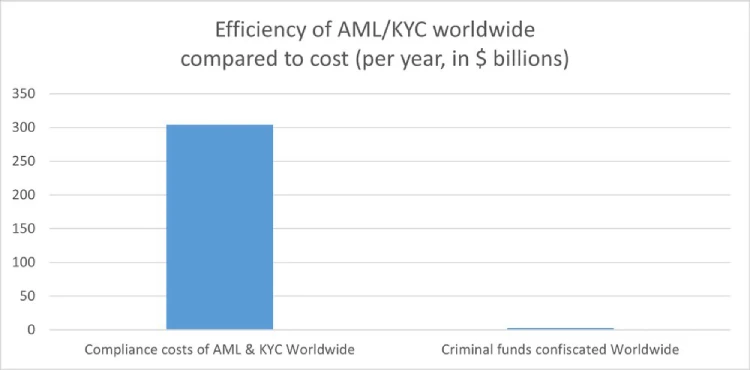
How will they keep this information safe? Why do they need my identity? Why do they force businesses to enforce such regulations? It's always for your safety, to protect you from the "bad". Your life is perpetually in danger: terrorists, money launderers, villains... so the government steps in to save us.
‟Hush now, baby, baby, don't you cry Mamma's gonna make all of your nightmares come true Mamma's gonna put all of her fears into you Mamma's gonna keep you right here, under her wing She won't let you fly, but she might let you sing Mamma's gonna keep baby cosy and warm” — Mother, Pink Floyd
We must resist any attack on our privacy and freedom. To do this, we must collaborate.
If you have a service, refuse to ask for KYC; find a way. Accept cryptocurrencies like Bitcoin and Monero. Commit to circular economies. Remove the need to go through the FIAT system. People need fiat money to use most services, but we can change that.
If you're a user, donate to and prefer using services that accept such currencies. Encourage your friends to accept cryptocurrencies as well. Boycott FIAT system to the greatest extent you possibly can.
This may sound utopian, but it can be achieved. This movement can't be stopped. Go kick the hornet's nest.
“We must defend our own privacy if we expect to have any. We must come together and create systems which allow anonymous transactions to take place. People have been defending their own privacy for centuries with whispers, darkness, envelopes, closed doors, secret handshakes, and couriers. The technologies of the past did not allow for strong privacy, but electronic technologies do.” — Eric Hughes, A Cypherpunk's Manifesto
The anniversary
Four years ago, I began exploring ways to use crypto without KYC. I bookmarked a few favorite services and thought sharing them to the world might be useful. That was the first version of kycnot.me — a simple list of about 15 services. Since then, I've added services, rewritten it three times, and improved it to what it is now.
kycnot.me has remained 100% independent and 100% open source^2 all these years. I've received offers to buy the site, all of which I have declined and will continue to decline. It has been DDoS attacked many times, but we made it through. I have also rewritten the whole site almost once per year (three times in four years).
The code and scoring algorithm are open source (contributions are welcome) and I can't arbitrarly change a service's score without adding or removing attributes, making any arbitrary alterations obvious if they were fake. You can even see the score summary for any service's score.
I'm a one-person team, dedicating my free time to this project. I hope to keep doing so for many more years. Again, thank you for being part of this.
-
 @ 39cc53c9:27168656
2025-05-27 09:21:37
@ 39cc53c9:27168656
2025-05-27 09:21:37After almost 3 months of work, we've completed the redesign of kycnot.me. More modern and with many new features.
Privacy remains the foundation - everything still works with JavaScript disabled. If you enable JS, you will get some nice-to-have features like lazy loading and smoother page transitions, but nothing essential requires it.
User Accounts
We've introduced user accounts that require zero personal information:
- Secret user tokens - no email, no phone number, no personal data
- Randomly generated usernames for default privacy and fairness
- Karma system that rewards contributions and unlocks features: custom display names, profile pictures, and more.
Reviews and Community Discussions
On the previous sites, I was using third party open source tools for the comments and discussions. This time, I've built my own from scratch, fully integrated into the site, without JavaScript requirements.
Everyone can share their experiences and help others make informed decisions:
- Ratings: Comments can have a 1-5 star rating attached. You can have one rating per service and it will affect the overall user score.
- Discussions: These are normal comments, you can add them on any listed service.
Comment Moderation
I was strugling to keep up with moderation on the old site. For this, we've implemented an AI-powered moderation system that:
- Auto-approves legitimate comments instantly
- Flags suspicious content for human review
- Keeps discussions valuable by minimizing spam
The AI still can mark comments for human review, but most comments will get approved automatically by this system. The AI also makes summaries of the comments to help you understand the overall sentiment of the community.
Powerful Search & Filtering
Finding exactly what you need is now easier:
- Advanced filtering system with many parameters. You can even filter by attributes to pinpoint services with specific features.
The results are dynamic and shuffle services with identical scores for fairness.
See all listings
Listings are now added as 'Community Contributed' by default. This means that you can still find them in the search results, but they will be clearly marked as such.
Updated Scoring System
New dual-score approach provides more nuanced service evaluations:
- Privacy Score: Measures how well a service protects your personal information and data
-
Trust Score: Assesses reliability, security, and overall reputation
-
Combined into a weighted Overall Score for quick comparisons
- Completely transparent and open source calculation algorithm. No manual tweaking or hidden factors.
AI-Powered Terms of Service Analysis
Basically, a TLDR summary for Terms of Service:
- Automated system extracts the most important points from complex ToS documents
- Clear summaries
- Updated monthly to catch any changes
The ToS document is hashed and only will be updated if there are any changes.
Service Events and Timelines
Track the complete history of any service, on each service page you can see the timeline of events. There are two types of events:
- Automatic events: Created by the system whenever something about a service changes, like its description, supported currencies, attributes, verification status…
- Manual events: Added by admins when there’s important news, such as a service going offline, being hacked, acquired, shut down, or other major updates.
There is also a global timeline view available at /events
Notification System
Since we now have user accounts, we built a notifiaction system so you can stay informed about anything:
- Notifications for comment replies and status changes
- Watch any comment to get notified for new replies.
- Subscribe to services to monitor events and updates
- Notification customization.
Coming soon: Third-party privacy-preserving notifications integration with Telegram, Ntfy.sh, webhooks...
Service Suggestions
Anyone with an account can suggest a new service via the suggestion form. After submitting, you'll receive a tracking page where you can follow the status of your suggestion and communicate directly with admins.
All new suggestions start as "unlisted" — they won't appear in search results until reviewed. Our team checks each submission to ensure it's not spam or inappropriate. If similar services already exist, you'll be shown possible duplicates and can choose to submit your suggestion as an edit instead.
You can always check the progress of your suggestion, respond to moderator questions, and see when it goes live, everything will also be notified to your account. This process ensures high-quality listings and a collaborative approach to building the directory.
These are some of the main features we already have, but there are many more small changes and improvements that you will find when using the site.
What's Next?
This is just the beginning. We will be constantly working to improve KYCnot.me and add more features that help you preserve your privacy.
Remember: True financial freedom requires the right to privacy. Stay KYC-free!
-
 @ 5ea46480:450da5bd
2025-05-27 08:23:58
@ 5ea46480:450da5bd
2025-05-27 08:23:58Understanding or grasping Nostr can be deceptively difficult. At the very least it is non-trivial. At first glance, looking at NIP-01, the protocol is rather straight forward. But those are just the basics; yes the beauty of Nostr is its ‘simplicity’, but that does not mean the system that results from it is not complex. Conway's Game of Life only has a hand full of rules, yet you can, in theory at least, create any complex system imaginable. And this is where the deception lies; the less you define from the outset, the more you imply on what follows.
It appears that as it stands, Nostr suffers from this deceptiveness. You can reason through all these implications, but that is still an exercise that has to be performed and where mistakes can be made. Worse, this exercise has been a group effort from the start that is still in progress. Currently there is no clear cut ‘authoritative’ example of all the implications that have been ‘discovered’ thus far.
A good example of the implications following Nostr’s primitives is what we now refer to as the ‘outbox model’. The reason we ‘now’ refer to it as such, is because initially it was called the ‘Gossip model’ derived from the client that first implemented the idea. Outbox is fundamental to Nostr, but it was never explicitly stated in the initial protocol description. The result is that roughly five years into this Nostr endeavor, it is still not universally implemented; worse yet, some developers appear to be in no rush to do so. Now the reason they will give you is probably one based on priority, yet I can’t shake the feeling that they apparently don’t ‘get it’.
My point here is not to play some blame game or hold anyone to account. I am just concluding they don’t actually get the new paradigm that we have all stumbled into. To expand on this specific outbox example, its significance only becomes really apparent further along in the ‘reasoning through all the implications’ exercise. In relation to one aspect, but there are more: The point is not ‘just’ censorship-resistance for users, but the freedom for relays that comes with it to apply whatever policy on what they store and make available; it is this discrimination or curation that can add value by making finding relevant information easier in a straightforward manner. But it relies on outbox to avoid isolation; something that only becomes apparent once you are reasoning through all the implications on how we discover and consume content.
To be clear, this piece is not supposed to a crusade on the outbox model, my point here is that there is an inherent logic to Nostr stemming from putting cryptography front and center. It is a logic that has to be applied and will subsequently carry you through all the challenges we face in reconstructing the entirety of the web. This is not to say there is only one obvious path, and different schools of thought are bound to emerge. But it behooves us all, faced with this new paradigm, to continuously reflect on the mental image we have cultivated of what Nostr is; actively re-performing that exercise of exploring the implications this simple set of protocol rules creates.
Unfortunately I can not escape my own folly. After all, I am just an armchair asshole that never wrote a single line of code in his life. Obviously this minds-eye bullshit is not even half the story, the bulk of the effort is translating it into software, the tangible, the real. It is in that effort ultimately the real exploration of this paradigm occurs. All I can do is build castles in the sky.
-
 @ b7274d28:c99628cb
2025-05-27 07:07:33
@ b7274d28:c99628cb
2025-05-27 07:07:33A few months ago, a nostrich was switching from iOS to Android and asked for suggestions for #Nostr apps to try out. nostr:npub18ams6ewn5aj2n3wt2qawzglx9mr4nzksxhvrdc4gzrecw7n5tvjqctp424 offered the following as his response:
nostr:nevent1qvzqqqqqqypzq0mhp4ja8fmy48zuk5p6uy37vtk8tx9dqdwcxm32sy8nsaa8gkeyqydhwumn8ghj7un9d3shjtnwdaehgunsd3jkyuewvdhk6tcpz4mhxue69uhhyetvv9ujuerpd46hxtnfduhszythwden5te0dehhxarj9emkjmn99uqzpwwts6n28eyvjpcwvu5akkwu85eg92dpvgw7cgmpe4czdadqvnv984rl0z
Yes. #Android users are fortunate to have some powerful Nostr apps and tools at our disposal that simply have no comparison over on the iOS side. However, a tool is only as good as the knowledge of the user, who must have an understanding of how best to wield it for maximum effect. This fact was immediately evidenced by replies to Derek asking, "What is the use case for Citrine?" and "This is the first time I'm hearing about Citrine and Pokey. Can you give me links for those?"
Well, consider this tutorial your Nostr starter-kit for Android. We'll go over installing and setting up Amber, Amethyst, Citrine, and Pokey, and as a bonus we'll be throwing in the Zapstore and Coinos to boot. We will assume no previous experience with any of the above, so if you already know all about one or more of these apps, you can feel free to skip that tutorial.
So many apps...
You may be wondering, "Why do I need so many apps to use Nostr?" That's perfectly valid, and the honest answer is, you don't. You can absolutely just install a Nostr client from the Play Store, have it generate your Nostr identity for you, and stick with the default relays already set up in that app. You don't even need to connect a wallet, if you don't want to. However, you won't experience all that Nostr has to offer if that is as far as you go, any more than you would experience all that Italian cuisine has to offer if you only ever try spaghetti.
Nostr is not just one app that does one thing, like Facebook, Twitter, or TikTok. It is an entire ecosystem of applications that are all built on top of a protocol that allows them to be interoperable. This set of tools will help you make the most out of that interoperability, which you will never get from any of the big-tech social platforms. It will provide a solid foundation for you to build upon as you explore more and more of what Nostr has to offer.
So what do these apps do?

Fundamental to everything you do on Nostr is the need to cryptographically sign with your private key. If you aren't sure what that means, just imagine that you had to enter your password every time you hit the "like" button on Facebook, or every time you commented on the latest dank meme. That would get old really fast, right? That's effectively what Nostr requires, but on steroids.
To keep this from being something you manually have to do every 5 seconds when you post a note, react to someone else's note, or add a comment, Nostr apps can store your private key and use it to sign behind the scenes for you. This is very convenient, but it means you are trusting that app to not do anything with your private key that you don't want it to. You are also trusting it to not leak your private key, because anyone who gets their hands on it will be able to post as you, see your private messages, and effectively be you on Nostr. The more apps you give your private key to, the greater your risk that it will eventually be compromised.
Enter #Amber, an application that will store your private key in only one app, and all other compatible Nostr apps can communicate with it to request a signature, without giving any of those other apps access to your private key.
Most Nostr apps for Android now support logging in and signing with Amber, and you can even use it to log into apps on other devices, such as some of the web apps you use on your PC. It's an incredible tool given to us by nostr:npub1w4uswmv6lu9yel005l3qgheysmr7tk9uvwluddznju3nuxalevvs2d0jr5, and only available for Android users. Those on iPhone are incredibly jealous that they don't have anything comparable, yet.

Speaking of nostr:npub1w4uswmv6lu9yel005l3qgheysmr7tk9uvwluddznju3nuxalevvs2d0jr5, the next app is also one of his making.
All Nostr data is stored on relays, which are very simple servers that Nostr apps read notes from and write notes to. In most forms of social media, it can be a pain to get your own data out to keep a backup. That's not the case on Nostr. Anyone can run their own relay, either for the sake of backing up their personal notes, or for others to post their notes to, as well.
Since Nostr notes take up very little space, you can actually run a relay on your phone. I have been on Nostr for almost 2 and a half years, and I have 25,000+ notes of various kinds on my relay, and a backup of that full database is just 24MB on my phone's storage.
Having that backup can save your bacon if you try out a new Nostr client and it doesn't find your existing follow list for some reason, so it writes a new one and you suddenly lose all of the people you were following. Just pop into your #Citrine relay, confirm it still has your correct follow list or import it from a recent backup, then have Citrine restore it. Done.
Additionally, there are things you may want to only save to a relay you control, such as draft messages that you aren't ready to post publicly, or eCash tokens, which can actually be saved to Nostr relays now. Citrine can also be used with Amber for signing into certain Nostr applications that use a relay to communicate with Amber.
If you are really adventurous, you can also expose Citrine over Tor to be used as an outbox relay, or used for peer-to-peer private messaging, but that is far more involved than the scope of this tutorial series.

You can't get far in Nostr without a solid and reliable client to interact with. #Amethyst is the client we will be using for this tutorial because there simply isn't another Android client that comes close, so far. Moreover, it can be a great client for new users to get started on, and yet it has a ton of features for power-users to take advantage of as well.
There are plenty of other good clients to check out over time, such as Coracle, YakiHonne, Voyage, Olas, Flotilla and others, but I keep coming back to Amethyst, and by the time you finish this tutorial, I think you'll see why. nostr:npub1gcxzte5zlkncx26j68ez60fzkvtkm9e0vrwdcvsjakxf9mu9qewqlfnj5z and others who have contributed to Amethyst have really built something special in this client, and it just keeps improving with every update that's shipped.

Most social media apps have some form of push notifications, and some Nostr apps do, too. Where the issue comes in is that Nostr apps are all interoperable. If you have more than one application, you're going to have both of them notifying you. Nostr users are known for having five or more Nostr apps that they use regularly. If all of them had notifications turned on, it would be a nightmare. So maybe you limit it to only one of your Nostr apps having notifications turned on, but then you are pretty well locked-in to opening that particular app when you tap on the notification.
Pokey, by nostr:npub1v3tgrwwsv7c6xckyhm5dmluc05jxd4yeqhpxew87chn0kua0tjzqc6yvjh, solves this issue, allowing you to turn notifications off for all of your Nostr apps, and have Pokey handle them all for you. Then, when you tap on a Pokey notification, you can choose which Nostr app to open it in.
Pokey also gives you control over the types of things you want to be notified about. Maybe you don't care about reactions, and you just want to know about zaps, comments, and direct messages. Pokey has you covered. It even supports multiple accounts, so you can get notifications for all the npubs you control.

One of the most unique and incredibly fun aspects of Nostr is the ability to send and receive #zaps. Instead of merely giving someone a 👍️ when you like something they said, you can actually send them real value in the form of sats, small portions of a Bitcoin. There is nothing quite like the experience of receiving your first zap and realizing that someone valued what you said enough to send you a small amount (and sometimes not so small) of #Bitcoin, the best money mankind has ever known.
To be able to have that experience, though, you are going to need a wallet that can send and receive zaps, and preferably one that is easy to connect to Nostr applications. My current preference for that is Alby Hub, but not everyone wants to deal with all that comes along with running a #Lightning node. That being the case, I have opted to use nostr:npub1h2qfjpnxau9k7ja9qkf50043xfpfy8j5v60xsqryef64y44puwnq28w8ch for this tutorial, because they offer one of the easiest wallets to set up, and it connects to most Nostr apps by just copy/pasting a connection string from the settings in the wallet into the settings in your Nostr app of choice.
Additionally, even though #Coinos is a custodial wallet, you can have it automatically transfer any #sats over a specified threshold to a separate wallet, allowing you to mitigate the custodial risk without needing to keep an eye on your balance and make the transfer manually.

Most of us on Android are used to getting all of our mobile apps from one souce: the Google Play Store. That's not possible for this tutorial series. Only one of the apps mentioned above is available in Google's permissioned playground. However, on Android we have the advantage of being able to install whatever we want on our device, just by popping into our settings and flipping a toggle. Indeed, thumbing our noses at big-tech is at the heart of the Nostr ethos, so why would we make ourselves beholden to Google for installing Nostr apps?
The nostr:npub10r8xl2njyepcw2zwv3a6dyufj4e4ajx86hz6v4ehu4gnpupxxp7stjt2p8 is an alternative app store made by nostr:npub1wf4pufsucer5va8g9p0rj5dnhvfeh6d8w0g6eayaep5dhps6rsgs43dgh9 as a resource for all sorts of open-source apps, but especially Nostr apps. What is more, you can log in with Amber, connect a wallet like Coinos, and support the developers of your favorite Nostr apps directly within the #Zapstore by zapping their app releases.
One of the biggest features of the Zapstore is the fact that developers can cryptographically sign their app releases using their Nostr keys, so you know that the app you are downloading is the one they actually released and hasn't been altered in any way. The Zapstore will warn you and won't let you install the app if the signature is invalid.
Getting Started
Since the Zapstore will be the source we use for installing most of the other apps mentioned, we will start with installing the Zapstore.
We will then use the Zapstore to install Amber and set it up with our Nostr account, either by creating a new private key, or by importing one we already have. We'll also use it to log into the Zapstore.
Next, we will install Amethyst from the Zapstore and log into it via Amber.
After this, we will install Citrine from the Zapstore and add it as a local relay on Amethyst.
Because we want to be able to send and receive zaps, we will set up a wallet with CoinOS and connect it to Amethyst and the Zapstore using Nostr Wallet Connect.
Finally, we will install Pokey using the Zapstore, log into it using Amber, and set up the notifications we want to receive.
By the time you are done with this series, you will have a great head-start on your Nostr journey compared to muddling through it all on your own. Moreover, you will have developed a familiarity with how things generally work on Nostr that can be applied to other apps you try out in the future.
Continue to Part 2: The Zapstore. Nostr Link: nostr:naddr1qvzqqqr4gupzpde8f55w86vrhaeqmd955y4rraw8aunzxgxstsj7eyzgntyev2xtqydhwumn8ghj7un9d3shjtnzwf5kw6r5vfhkcapwdejhgtcqp5cnwdphxv6rwwp3xvmnzvqgty5au
-
 @ 7f6db517:a4931eda
2025-05-27 05:01:34
@ 7f6db517:a4931eda
2025-05-27 05:01:34
There must be a limit to how much data is transferred across the bitcoin network in order to keep the ability to run and use your own node accessible. A node is required to interact with the global bitcoin network - if you do not use your own node then you must trust someone else's node. If nodes become inaccessible to run then the network will centralize around the remaining entities that operate them - threatening the censorship resistance at the core of bitcoin's value prop. The bitcoin protocol uses three main mechanisms to keep node operation costs low - a fixed limit on the amount of data in each block, an automatic difficulty adjustment that regulates how many blocks are produced based on current mining hash rate, and a robust dynamic transaction fee market.
Bitcoin transaction fees limit network abuse by making usage expensive. There is a cost to every transaction, set by a dynamic free market based on demand for scarce block space. It is an incredibly robust way to prevent spam without relying on centralized entities that can be corrupted or pressured.
After the 2017 bitcoin fee spike we had six years of relative quiet to build tools that would be robust in a sustained high fee market. Fortunately our tools are significantly better now but many still need improvement. Most of the pain points we see today will be mitigated.
The reality is we were never going to be fully prepared - pressure is needed to show the pain points and provide strong incentives to mitigate them.
It will be incredibly interesting to watch how projects adapt under pressure. Optimistic we see great innovation here.
_If you are willing to wait for your transaction to confirm you can pay significantly lower fees. Learn best practices for reducing your fee burden here.
My guide for running and using your own bitcoin node can be found here._
If you found this post helpful support my work with bitcoin.

-
 @ 7f6db517:a4931eda
2025-05-27 05:01:34
@ 7f6db517:a4931eda
2025-05-27 05:01:34
I often hear "bitcoin doesn't interest me, I'm not a finance person."
Ironically, the beauty of sound money is you don't have to be. In the current system you're expected to manage a diversified investment portfolio or pay someone to do it. Bitcoin will make that optional.
— ODELL (@ODELL) September 16, 2018
At first glance bitcoin often appears overwhelming to newcomers. It is incredibly easy to get bogged down in the details of how it works or different ways to use it. Enthusiasts, such as myself, often enjoy going down the deep rabbit hole of the potential of bitcoin, possible pitfalls and theoretical scenarios, power user techniques, and the developer ecosystem. If your first touch point with bitcoin is that type of content then it is only natural to be overwhelmed. While it is important that we have a thriving community of bitcoiners dedicated to these complicated tasks - the true beauty of bitcoin lies in its simplicity. Bitcoin is simply better money. It is the best money we have ever had.
Life is complicated. Life is hard. Life is full of responsibility and surprises. Bitcoin allows us to focus on our lives while relying on a money that is simple. A money that is not controlled by any individual, company, or government. A money that cannot be easily seized or blocked. A money that cannot be devalued at will by a handful of corrupt bureaucrat who live hundreds of miles from us. A money that can be easily saved and should increase in purchasing power over time without having to learn how to "build a diversified stock portfolio" or hire someone to do it for us.
Bitcoin enables all of us to focus on our lives - our friends and family - doing what we love with the short time we have on this earth. Time is scarce. Life is complicated. Bitcoin is the most simple aspect of our complicated lives. If we spend our scarce time working then we should be able to easily save that accrued value for future generations without watching the news or understanding complicated financial markets. Bitcoin makes this possible for anyone.
Yesterday was Mother's Day. Raising a human is complicated. It is hard, it requires immense personal responsibility, it requires critical thinking, but mothers figure it out, because it is worth it. Using and saving bitcoin is simple - simply install an app on your phone. Every mother can do it. Every person can do it.
Life is complicated. Life is beautiful. Bitcoin is simple.
If you found this post helpful support my work with bitcoin.

-
 @ 7f6db517:a4931eda
2025-05-27 05:01:33
@ 7f6db517:a4931eda
2025-05-27 05:01:33Will not live in a pod.
Will not eat the bugs.
Will not get the chip.
Will not get a blue check.
Will not use CBDCs.Live Free or Die.

Why did Elon buy twitter for $44 Billion? What value does he see in it besides the greater influence that undoubtedly comes with controlling one of the largest social platforms in the world? We do not need to speculate - he made his intentions incredibly clear in his first meeting with twitter employees after his takeover - WeChat of the West.
To those that do not appreciate freedom, the value prop is clear - WeChat is incredibly powerful and successful in China.
To those that do appreciate freedom, the concern is clear - WeChat has essentially become required to live in China, has surveillance and censorship integrated at its core, and if you are banned from the app your entire livelihood is at risk. Employment, housing, payments, travel, communication, and more become extremely difficult if WeChat censors determine you have acted out of line.

The blue check is the first step in Elon's plan to bring the chinese social credit score system to the west. Users who verify their identity are rewarded with more reach and better tools than those that do not. Verified users are the main product of Elon's twitter - an extensive database of individuals and complete control of the tools he will slowly get them to rely on - it is easier to monetize cattle than free men.

If you cannot resist the temptation of the blue check in its current form you have already lost - what comes next will be much darker. If you realize the need to resist - freedom tech provides us options.
If you found this post helpful support my work with bitcoin.

-
 @ 7f6db517:a4931eda
2025-05-27 05:01:33
@ 7f6db517:a4931eda
2025-05-27 05:01:33
Nostr is an open communication protocol that can be used to send messages across a distributed set of relays in a censorship resistant and robust way.
If you missed my nostr introduction post you can find it here. My nostr account can be found here.
We are nearly at the point that if something interesting is posted on a centralized social platform it will usually be posted by someone to nostr.
We are nearly at the point that if something interesting is posted exclusively to nostr it is cross posted by someone to various centralized social platforms.
We are nearly at the point that you can recommend a cross platform app that users can install and easily onboard without additional guides or resources.
As companies continue to build walls around their centralized platforms nostr posts will be the easiest to cross reference and verify - as companies continue to censor their users nostr is the best censorship resistant alternative - gradually then suddenly nostr will become the standard. 🫡
Current Nostr Stats
If you found this post helpful support my work with bitcoin.

-
 @ 7f6db517:a4931eda
2025-05-27 05:01:33
@ 7f6db517:a4931eda
2025-05-27 05:01:33
Influencers would have you believe there is an ongoing binance bank run but bitcoin wallet data says otherwise.
- binance wallets are near all time highs
- bitfinex wallets are also trending up
- gemini and coinbase are being hit with massive withdrawals thoughYou should not trust custodians, they can rug you without warning. It is incredibly important you learn how to hold bitcoin yourself, but also consider not blindly trusting influencers with a ref link to shill you.




If you found this post helpful support my work with bitcoin.

-
 @ 7f6db517:a4931eda
2025-05-27 05:01:33
@ 7f6db517:a4931eda
2025-05-27 05:01:33
For years American bitcoin miners have argued for more efficient and free energy markets. It benefits everyone if our energy infrastructure is as efficient and robust as possible. Unfortunately, broken incentives have led to increased regulation throughout the sector, incentivizing less efficient energy sources such as solar and wind at the detriment of more efficient alternatives.
The result has been less reliable energy infrastructure for all Americans and increased energy costs across the board. This naturally has a direct impact on bitcoin miners: increased energy costs make them less competitive globally.
Bitcoin mining represents a global energy market that does not require permission to participate. Anyone can plug a mining computer into power and internet to get paid the current dynamic market price for their work in bitcoin. Using cellphone or satellite internet, these mines can be located anywhere in the world, sourcing the cheapest power available.
Absent of regulation, bitcoin mining naturally incentivizes the build out of highly efficient and robust energy infrastructure. Unfortunately that world does not exist and burdensome regulations remain the biggest threat for US based mining businesses. Jurisdictional arbitrage gives miners the option of moving to a friendlier country but that naturally comes with its own costs.
Enter AI. With the rapid development and release of AI tools comes the requirement of running massive datacenters for their models. Major tech companies are scrambling to secure machines, rack space, and cheap energy to run full suites of AI enabled tools and services. The most valuable and powerful tech companies in America have stumbled into an accidental alliance with bitcoin miners: THE NEED FOR CHEAP AND RELIABLE ENERGY.
Our government is corrupt. Money talks. These companies will push for energy freedom and it will greatly benefit us all.
Microsoft Cloud hiring to "implement global small modular reactor and microreactor" strategy to power data centers: https://www.datacenterdynamics.com/en/news/microsoft-cloud-hiring-to-implement-global-small-modular-reactor-and-microreactor-strategy-to-power-data-centers/
If you found this post helpful support my work with bitcoin.

-
 @ 7f6db517:a4931eda
2025-05-27 05:01:32
@ 7f6db517:a4931eda
2025-05-27 05:01:32
Humanity's Natural State Is Chaos
Without order there is chaos. Humans competing with each other for scarce resources naturally leads to conflict until one group achieves significant power and instates a "monopoly on violence."Power Brings Stability
Power has always been the key means to achieve stability in societies. Centralized power can be incredibly effective in addressing issues such as crime, poverty, and social unrest efficiently. Unfortunately this power is often abused and corrupted.Centralized Power Breeds Tyranny
Centralized power often leads to tyrannical rule. When a select few individuals hold control over a society, they tend to become corrupted. Centralized power structures often lack accountability and transparency, and rely too heavily on trust.Distributed Power Cultivates Freedom
New technology that empowers individuals provide us the ability to rebuild societies from the bottom up. Strong individuals that can defend and provide for themselves will help build strong local communities on a similar foundation. The result is power being distributed throughout society rather than held by a select few.In the short term, relying on trust and centralized power is an easy answer to mitigating chaos, but freedom tech tools provide us the ability to build on top of much stronger distributed foundations that provide stability while also cultivating individual freedom.
The solution starts with us. Empower yourself. Empower others. A grassroots freedom tech movement scaling one person at a time.
If you found this post helpful support my work with bitcoin.

-
 @ 7f6db517:a4931eda
2025-05-27 04:01:32
@ 7f6db517:a4931eda
2025-05-27 04:01:32
What is KYC/AML?
- The acronym stands for Know Your Customer / Anti Money Laundering.
- In practice it stands for the surveillance measures companies are often compelled to take against their customers by financial regulators.
- Methods differ but often include: Passport Scans, Driver License Uploads, Social Security Numbers, Home Address, Phone Number, Face Scans.
- Bitcoin companies will also store all withdrawal and deposit addresses which can then be used to track bitcoin transactions on the bitcoin block chain.
- This data is then stored and shared. Regulations often require companies to hold this information for a set number of years but in practice users should assume this data will be held indefinitely. Data is often stored insecurely, which results in frequent hacks and leaks.
- KYC/AML data collection puts all honest users at risk of theft, extortion, and persecution while being ineffective at stopping crime. Criminals often use counterfeit, bought, or stolen credentials to get around the requirements. Criminals can buy "verified" accounts for as little as $200. Furthermore, billions of people are excluded from financial services as a result of KYC/AML requirements.
During the early days of bitcoin most services did not require this sensitive user data, but as adoption increased so did the surveillance measures. At this point, most large bitcoin companies are collecting and storing massive lists of bitcoiners, our sensitive personal information, and our transaction history.
Lists of Bitcoiners
KYC/AML policies are a direct attack on bitcoiners. Lists of bitcoiners and our transaction history will inevitably be used against us.
Once you are on a list with your bitcoin transaction history that record will always exist. Generally speaking, tracking bitcoin is based on probability analysis of ownership change. Surveillance firms use various heuristics to determine if you are sending bitcoin to yourself or if ownership is actually changing hands. You can obtain better privacy going forward by using collaborative transactions such as coinjoin to break this probability analysis.
Fortunately, you can buy bitcoin without providing intimate personal information. Tools such as peach, hodlhodl, robosats, azteco and bisq help; mining is also a solid option: anyone can plug a miner into power and internet and earn bitcoin by mining privately.
You can also earn bitcoin by providing goods and/or services that can be purchased with bitcoin. Long term, circular economies will mitigate this threat: most people will not buy bitcoin - they will earn bitcoin - most people will not sell bitcoin - they will spend bitcoin.
There is no such thing as KYC or No KYC bitcoin, there are bitcoiners on lists and those that are not on lists.
If you found this post helpful support my work with bitcoin.

